Billion Electric BIL-MX1200 Gigabit Multi-Service Broadband Router User Manual Product Overview
Billion Electric Co., Ltd. Gigabit Multi-Service Broadband Router Product Overview
Users Manual
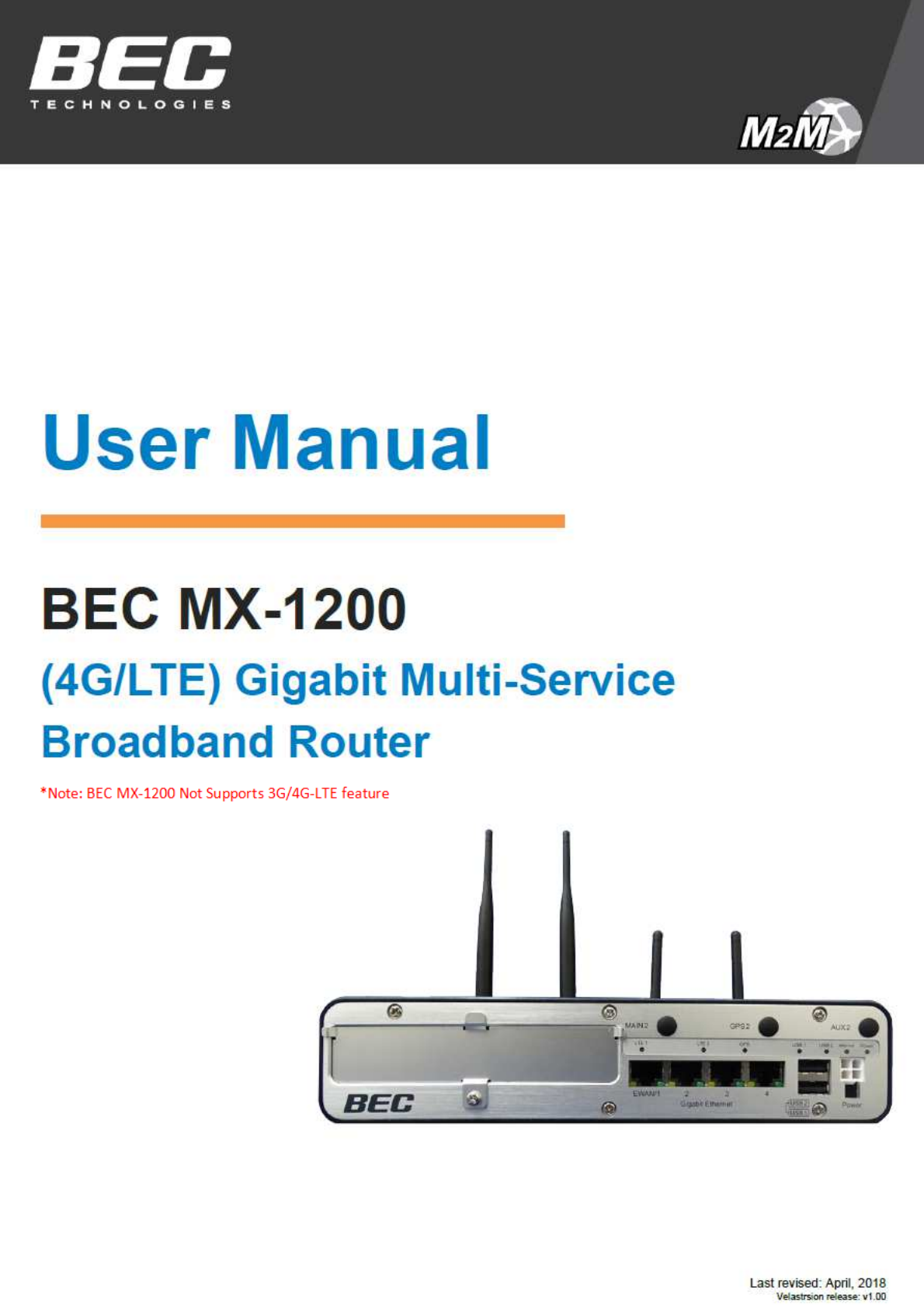

Copyright Notice
Copyright@ 2017 BEC Technologies Inc. All rights reserved.
BEC Technologies reserves the right to change and make improvement to this manual at any time
without prior notice.
No part of this document may be reproduced, copied, transmitted in any form or by any means without
prior written permission from BEC Technologies, Inc.
Support Contact Information
Contact Support: http://bectechnologies.net/support/.
Telephone: +1 972 422 0877
TABLE OF CONTENTS
COPYRIGHT NOTICE ....................................... 1
CHAPTER 1: INTRODUCTION ......................... 1
INTRODUCTION TO YOUR ROUTER .............................................................. 1
FEATURES & SPECIFICATIONS .................................................................... 3
HARDWARE SPECIFICATIONS ..................................................................... 6
CHAPTER 2: PRODUCT OVERVIEW ............... 7
IMPORTANT NOTE FOR USING THIS ROUTER ................................................ 7
PACKAGE CONTENTS ............................................................................... 7
DEVICE DESCRIPTION (FRONT) .................................................................. 8
DEVICE DESCRIPTION (BACK) .................................................................. 10
SYSTEM RECOVERY PROCEDURES ............................................................. 11
CABLING ............................................................................................ 11
CHAPTER 3: BASIC INSTALLATION ............ 12
NETWORK CONFIGURATION – IPV4 ......................................................... 13
Configuring PC in Windows 10 (IPv4) .............................................................. 13
Configuring PC in Windows 7/8 (IPv4) ............................................................. 15
Configuring PC in Windows Vista (IPv4) .......................................................... 17
NETWORK CONFIGURATION – IPV6 ......................................................... 19
Configuring PC in Windows 10 (IPv6) .............................................................. 19
Configuring PC in Windows 7/8 (IPv6) ............................................................. 21
Configuring PC in Windows Vista (IPv6) .......................................................... 23
DEFAULT SETTINGS ............................................................................... 25
CHAPTER 4: DEVICE CONFIGURATION ...... 26
LOGIN TO YOUR DEVICE ......................................................................... 26
STATUS .............................................................................................. 28
Device Info ...................................................................................................... 28
System Log ...................................................................................................... 30
System Status .................................................................................................. 30
3G/4G-LTE Status............................................................................................. 31
GPS Status ....................................................................................................... 33
Hardware Monitor .......................................................................................... 33
Hotspot Status ................................................................................................. 34
Statistics .......................................................................................................... 35
DHCP Table ...................................................................................................... 39
Disk Status ....................................................................................................... 39
ARP Table ........................................................................................................ 39
VRRP Status ..................................................................................................... 40
QUICK START ...................................................................................... 41
CONFIGURATION .................................................................................. 44
Interface Setup ................................................................................................ 44
Internet ........................................................................................................................ 44
LAN ............................................................................................................................... 52
Wireless ........................................................................................................................ 57
Wireless MAC Filter ...................................................................................................... 68
Dual WAN ........................................................................................................ 69
General Setting ............................................................................................................. 69
Outbound Load Balance ............................................................................................... 74
Protocol Binding ........................................................................................................... 75
Hotspot ........................................................................................................... 76
General Setting ............................................................................................................. 76
Built-in User Account .................................................................................................... 79
Authorized of Client ...................................................................................................... 80
Walled Garden ............................................................................................................. 81
Advertisement .............................................................................................................. 82
Session Log ................................................................................................................... 83
Customization ............................................................................................................... 84
Advanced Setup .............................................................................................. 86
Firewall ......................................................................................................................... 86
Routing ......................................................................................................................... 87
NAT ............................................................................................................................... 88
Static DNS ..................................................................................................................... 93
Time Schedule .............................................................................................................. 94
Mail Alert ..................................................................................................................... 95
Access Management ....................................................................................... 96
Device Management .................................................................................................... 96
SNMP ........................................................................................................................... 97
Syslog ........................................................................................................................... 99
Universal Plug & Play ................................................................................................. 100
Dynamic DNS (DDNS) ................................................................................................. 101
Access Control ............................................................................................................ 103
Packet Filter ................................................................................................................ 105
CWMP (TR-069) .......................................................................................................... 110
Parental Control ......................................................................................................... 112
SAMBA & FTP Server .................................................................................................. 113
BECentral Management ............................................................................................. 116
Maintenance ................................................................................................. 117
User Management ..................................................................................................... 117
Time Zone ................................................................................................................... 121
Firmware & Configuration .......................................................................................... 122
System Restart ............................................................................................................ 123
Auto Reboot ............................................................................................................... 124
Diagnostics Tool .......................................................................................................... 125
Ignition Sensing .......................................................................................................... 127
CHAPTER 5: TROUBLESHOOTING ............ 128
Problems with the Router ............................................................................. 128
Problem with LAN Interface .......................................................................... 128
Recovery Procedures ..................................................................................... 129
APPENDIX: PRODUCT SUPPORT & CONTACT
....................................................................... 130

Introduction
1
BEC MX-1200 Series User Manual
CHAPTER 1: INTRODUCTION
Introduction to your Router
The BEC MX-1200 is a high-performance, versatile, feature-rich platform for organizations that are
eager to deploy a reliable, high-performing, secure, and scalable wireless network. Retail, SMB,
Enterprise and other business can now accelerate deployments of applications such as business
continuity, Point-of-Sales, SD-WAN services and much more.
The MX-1200 supports immediate mobile network expansion via its modular interface and the MX-
100U LTE modem. The MX-100U is certified across all major carriers giving customers the ability to
select the best carrier for their given location. It integrates Category 6 LTE-A with carrier aggregation,
dual-SIM, multi-carrier auto selection and active GPS into an IP-50 hardened enclosure. Future
models will support a migration path to higher data rates and LTE Categories.
Vehicle Tracking System
MX-1200 is embedded with a GNSS receiver for GPS or GLONASS. To co-work with On-Board
Diagnostics(OBD) system, it eases the central control of geographically-dispersed fleets by
presenting individual vehicles' detailed information, including remaining fuel levels, rapid
accelerations, and locations.
Mobile and Fixed Broadband Services Ready
MX-1200 platform supports two (2) SIMs for carrier redundancy or seamless failover (with MX-100U)
between carrier networks and is equipped up to two (2) versatile Gigabit Ethernet LANs/WANs for
wireline connection such as Fiber(FTTH), Cable or DSL with speeds up to 1000Mbps. Using BEC
WAN Management in the Web GUI to manage and ensure uninterrupted Internet services by assigning
failover to specific WAN interfaces, setting up WAN load balance to smoother traffic to ensure no
drops on latency-sensitive application and data.
Maximized Wi-Fi Speed and Coverage
With the next wireless generation, 802.11ac, integrated in the MX-1200, the router delivers fast Wi-Fi
speeds of up to 1200Mbps. The MX-1200 supports a link rate up to 300Mbps in 2.4GHz frequency
range & 867Mbps in 5GHz range and is also backward
compatible with existing 802.11 a / b / g / n wireless equipment in the network. The Wireless Protected
Access (WPA-PSK/WPA2-PSK) and Wireless Encryption Protocol (WEP) features enhance the level
of transmission security and access control over Wireless LAN. MX-1200 also supports the Wi-Fi
Protected Setup (WPS) standard for easy and secure establishment of a wireless home network. If
the user’s network requires wider coverage, the built-in Wireless Distribution System (WDS) repeater
function expands the wireless network without needing any external wires or cables.

Introduction
2
BEC MX-1200 Series User Manual
Wi-Fi Hotspot with Captive Portal
MX-1200 offers Wi-Fi hotspot to share the Internet connection via mobile (3G/LTE) or a wired
connection, an existing FTTH, cable, DSL network or modem, with any wireless-enabled devices
which is completed separate from the private Wi-Fi network. The captive portal enables highly secure
connectivity with multiple authentication options and extensive controls for access and bandwidth
management. Customization options allow for operator logos, branding or advertisement placement.
IPv6 Supported
Internet Protocol version 6 (IPv6) is a version of the Internet Protocol that is designed to succeed
IPv4. IPv6 has a vastly larger address space than IPv4. The router is already supporting IPv6, you
can use it in IPv6 environment no need to change device. The dual-stack protocol implementation in
an operating system is a fundamental IPv4-to-IPv6 transition technology. It implements IPv4 and
IPv6 protocol stacks either independently or in a hybrid form. The hybrid form is commonly
implemented in modern operating systems supporting IPv6.
Quick Start Wizard
Support a WEB GUI page to install this device quickly. With this wizard, simple steps will get you
connected to the Internet immediately.
Firmware Upgradeable
Device can be upgraded to the latest firmware through the WEB based GUI.

Introduction
Features & Specifications
3
BEC MX-1200 Series User Manual
Features & Specifications
• Compatible with MX-100U for immediate mobile network expansion
•Dual 4G LTE broadband connectivity (with MX-100U)
• Dual-WAN 4G LTE and Gigabit Ethernet WAN interface for network expandability and reliable
connectivity
• High performance antenna for increased coverage, signal reception and efficiency
• Embedded GNSS engine for real-time asset tracking and location data-based applications (with
MX-100U)
• Enterprise level routing functionality (Service Key is required)
• Gigabit Ethernet WAN (GbE WAN) for Cable/Fiber/xDSL high WAN throughput
•Gigabit Ethernet LAN
• IPv6 ready (IPv4/IPv6 dual stack)
•Multiple wireless SSIDs with wireless guest access and client isolation
• IEEE 802.11 b/g/n/a/ac compliant Wireless Access Point with Wi-Fi Protected Setup (WPS)
•Wi-Fi Protected Access (WPA-PSK/ WPA2-PSK) and Wired Equivalent Privacy (WEP)
• Wi-Fi Hotspot with captive portal
•Firewall Security with DoS Preventing and Packet Filtering
•Quality of Service Control for traffic prioritization management
•Universal Plug and Play (UPnP) Compliance
• Ease of Use with Quick Installation Wizard
•USB port for NAS (FTP/ SAMBA server)
• Global Navigation Satellite System (GNSS)
•Small form factor with multiple mounting options, easily installed by a single person
•Power ignition control option when mounted within vehicles
•Hardened enclosure with Industrial-graded components
High-speed Mobile Wireless Communication (Optional)
• Embedded single or dual 4G/LTE module (MX-1200U or MX-1200X)
• High performance external antennas
Global Navigation Satellite System (GNSS) (Optional)
• Embedded GNSS receiver for GPS or GLONASS
• Active external antenna (Sold Separately)

Introduction
Features & Specifications
4
BEC MX-1200 Series User Manual
Network Protocols and Features
•IPv4, IPv6 or IPv4 / IPv6 Dual Stack
•NAT, static (v4/v6) routing and RIP-1 / 2
•DHCPv4 / v6
•Universal Plug and Play (UPnP) Compliant
•Dynamic Domain Name System (DDNS)
•Virtual Server and DMZ
•SNTP, DNS proxy
•IGMP snooping and IGMP proxy
•MLD snooping and MLD proxy
Firewall
•Built-in NAT Firewall
•Stateful Packet Inspection (SPI)
• DoS attack prevention including Land Attack, Ping of Death, etc.
•Access control
•IP&MAC filter, URL Content Filter
•Password protection for system management
•VPN pass-through
Quality of Service Control
• Traffic prioritization management based-on Protocol, Port Number and IP Address (IPv4/ IPv6)
Wireless LAN
•Wi-Fi: four (4) Female RP-SMA Connectors
• Compliant with IEEE 802.11 a/b/g/n/ac standards
• 2.4GHz & 5GHz frequency range
• 20/40-MHz channel bandwidth
• Up to 300Mbps (2.4GHz) & 867Mbps (5GHz) wireless data rate
• 64/128 bits WEP supported for encryption
• Wireless security with WPA-PSK, WPA2-PSK, Mixed WPA/WAP2-PSK, (TKIP/AES),
802.1x/Radius

Introduction
Features & Specifications
5
BEC MX-1200 Series User Manual
• Multiple SSID (4 SSIDs), BSSID
• Wireless Client Isolation
•Wi-Fi Hotspot with captive portal
• Radius or integrated account database
• Wall Garden support
USB Application Server
•Storage/NAS: SAMBA Server, FTP Server
Intelligent Ignition Sensing
• For In-vehicle connectivity installations
Management
•Quick Installation wizard
•Web-based GUI for remote and local management (IPv4/IPv6)
•Firmware upgrades and configuration data upload and download via web-based GUI
•Supports DHCP server / client / relay
• Supports SNMP v1, v2, v3, MIB-I and MIB-II
•TR-069 supports remote management
•BECentral® Cloud Management
• Supports SNMP
• Syslog monitoring

Introduction
Hardware Specifications
6
BEC MX-1200 Series User Manual
Hardware Specifications
Physical interface
•Wi-Fi: four (4) Female RP-SMA Connectors
• 3G/4G LTE (MX-100U Plug-In): two (2) SMA Female Connectors
• (Optional) GPS (MX-100U Plug-In): one (1) SMA Female Connector
• WAN: 3G/4G LTE and/or ETH WAN
• USB 2.0 Host: two (2) ports
• Ethernet LAN: 4-port 10/100/1000Mbps auto-crossover (MDI/ MDI-X) switch
• SIM Card (MX-100U Plug-In): two (2) slots
• Reset Button
• Power Jack
• LED Indicators
Physical Specifications
• Dimensions (W*H*D): 8.86" x 1.97" x 6.97" (225mm x 50mm x 172.4mm)
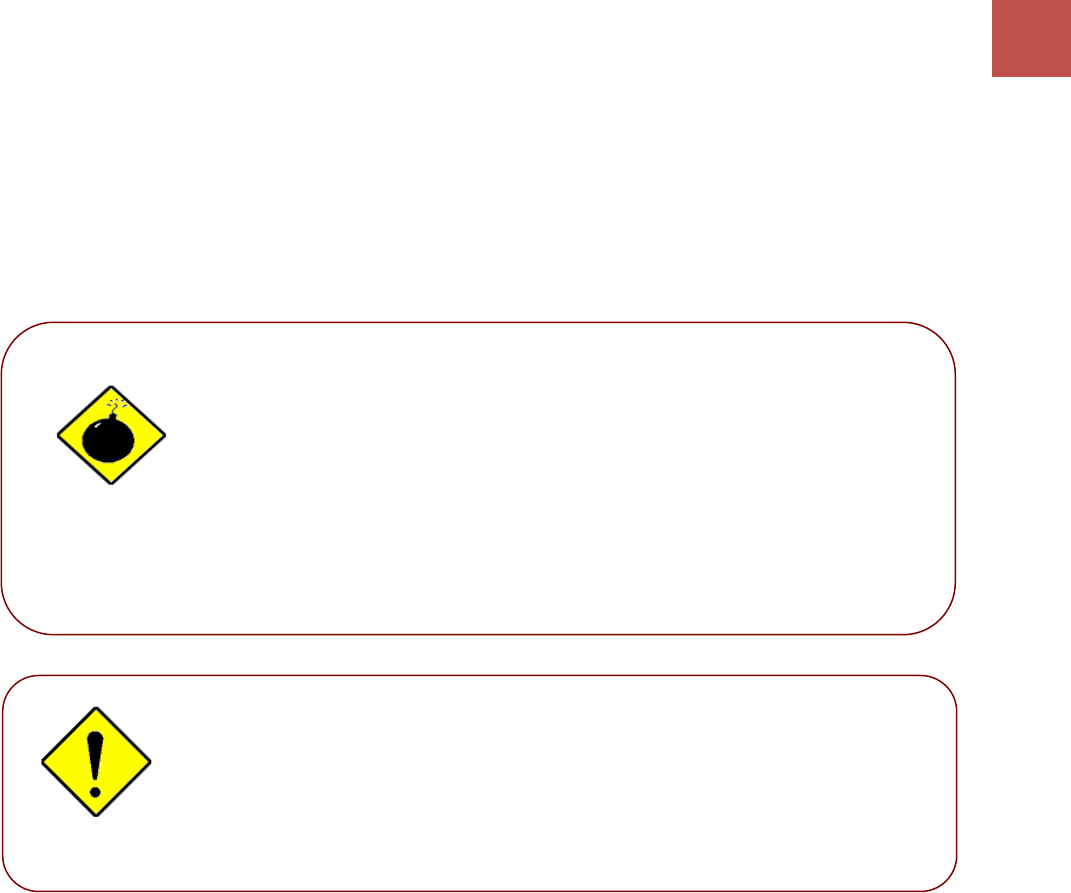
Product Overview
7
BEC MX-1200 Series User Manual
CHAPTER 2: PRODUCT OVERVIEW
Important Note for Using This Router
Package Contents
✓BEC MX-1200 M2M Router * 1
✓Quick Installation Guide * 1
✓RJ-45 Ethernet Cable x 1
✓2.4GHz Wi-Fi Antennas (Short) x 2
✓5GHz Wi-Fi Antennas (Long) x 2
✓MiniFit to DC Jack Power Cable * 1
✓DC Power Adapter x 1
(Optional Accessories)
✓3G/4G Antennas
✓Active GPS Antenna
✓MiniFit Vehicle Power Cable
✓Do not use the router in high humidity or high temperature.
✓Do not use the same power source for the MX-1200 on other
equipment.
✓Do not open or repair the case yourself. If the device becomes
too hot, turn off the power immediately and have it repaired at
a qualified service center.
✓Avoid using this product and all accessories outdoors.
Warning
✓Place the router on a stable surface.
✓Only use the power adapter that comes with the package. Using
a different voltage rating power adapter may damage the router.
Attention
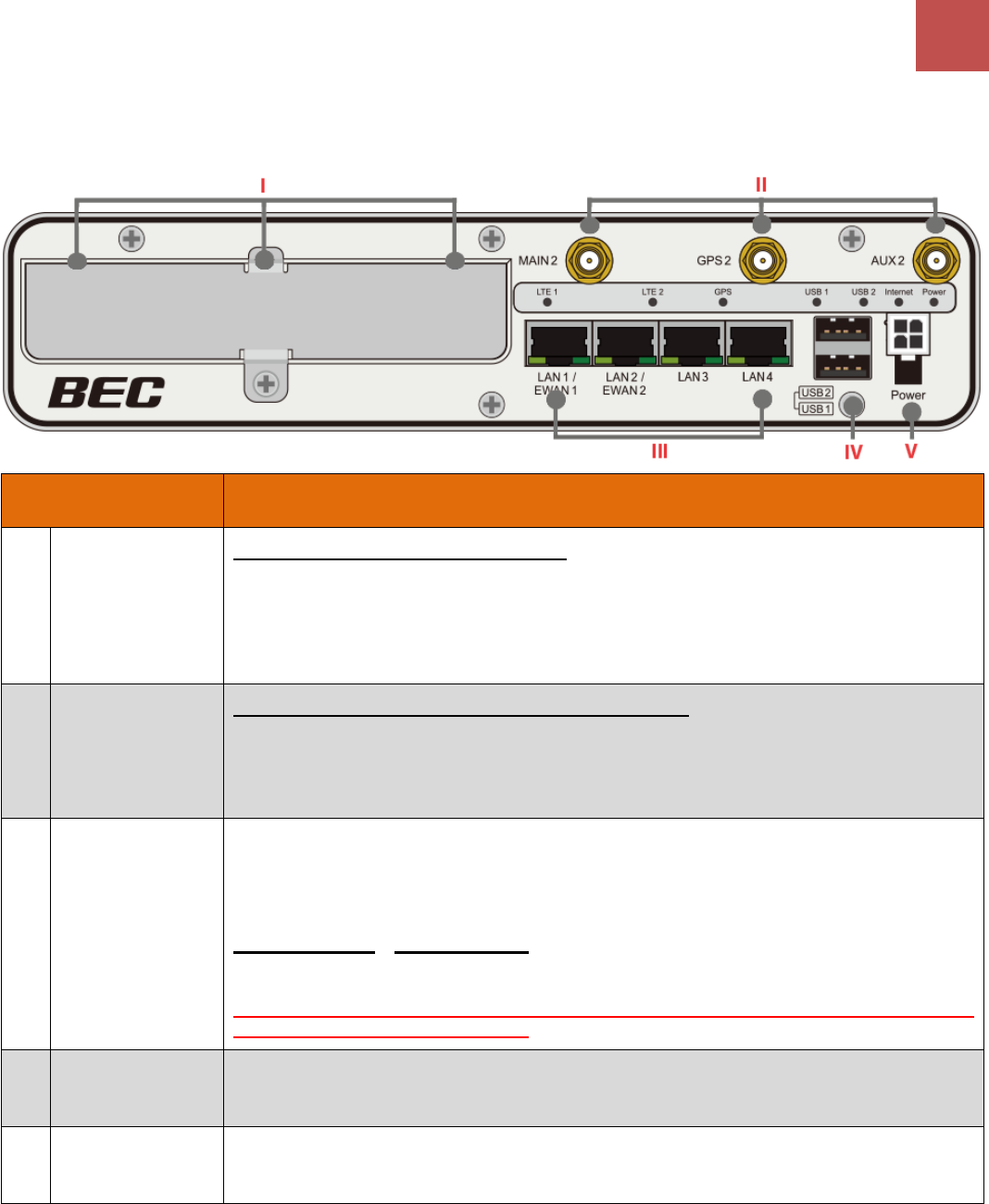
Product Overview
Device Description (Front)
8
BEC MX-1200 Series User Manual
Device Description (Front)
PORTS
MEANING
I
(Optional)
WAN1
(Main/GPS/Aux)
Antenna
Connectors
MX-100U as Primary LTE Connectivity
SMA female connectors.
Manually screw the 3G/4G and/or GPS antennas tight to the female connectors for
Cellular Module 1
II
(Optional)
WAN2 (Main/Aux)
Antenna
Connectors
MX-1200 Embedded as Secondary LTE Connectivity
SMA female connectors.
Manually screw the 3G/4G and/or GPS antennas tight to the female connectors for Cellular
Module 2
III
Gigabit
LAN Ethernet
(1 - 4)
Connect a UTP Ethernet cable (Cat-5 or Cat-5e) to one of the four LAN ports when
connecting to a PC or an office/home network of 10Mbps /100Mbps /1000Mbps
*LAN 1/EWAN 1 & LAN 2/EWAN 2
Connect to Fiber/ Cable/ xDSL Modem with a RJ-45 cable, for broadband connectivity.
Note: LAN1 and/or LAN2 automatically becomes an EWAN port when EWAN internet interface
is configured in the management GUI
IV
USB Ports
The USB can support setup for storage/file sharing. Connect an external USB dongle / hard
drive for storage
V
Power
Connect the supplied Power cable to this jack port
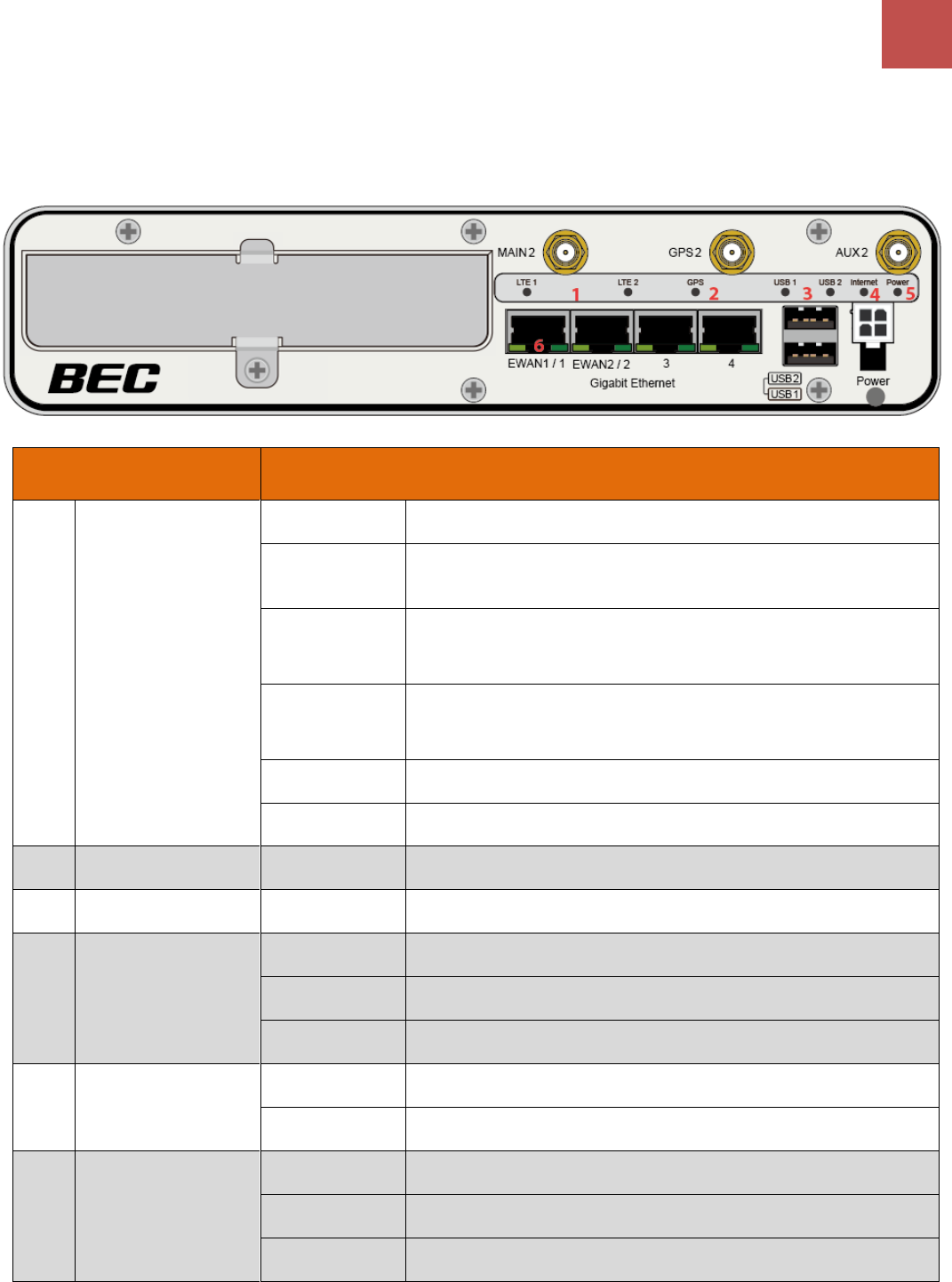
Product Overview
Device Description (Front)
9
BEC MX-1200 Series User Manual
LEDS
MEANING
1
LTE 1 / LTE 2
(Received Signal
Strength Indicator)
Green
RSSI greater than -69 dBm. Excellent signal condition
Green Flashing
quickly
RSSI from -81 to -69 dBm. Good signal condition
Red Flashing
quickly
RSSI from -99 to -81 dBm. Fair signal condition
Red Flashing
slowly
RSSI less than -99 dBm. Poor signal condition
Red
No signal and the 4G LTE module is in service
Off
No LTE module or LTE module fails
2
GPS LED
Green
GPS is up and ready to use
3
USB 1 / USB 2
Green
Connecting to a USB dongle or a hard drive
4
Internet
Green
Internet is connected, and traffic is passing through the device
Red
IP request failed
Off
Either in bridged mode or WAN connection is not present
5
Power
Green
System is up and ready
Red
Boot failure
6
Gigabit Ethernet
(LAN 1 - 4)
Green
Transmission speed is at Gigabit speed (1000Mbps)
Orange
Transmission speed is at 10/100Mbps
Blinking
Data being transmitted/received
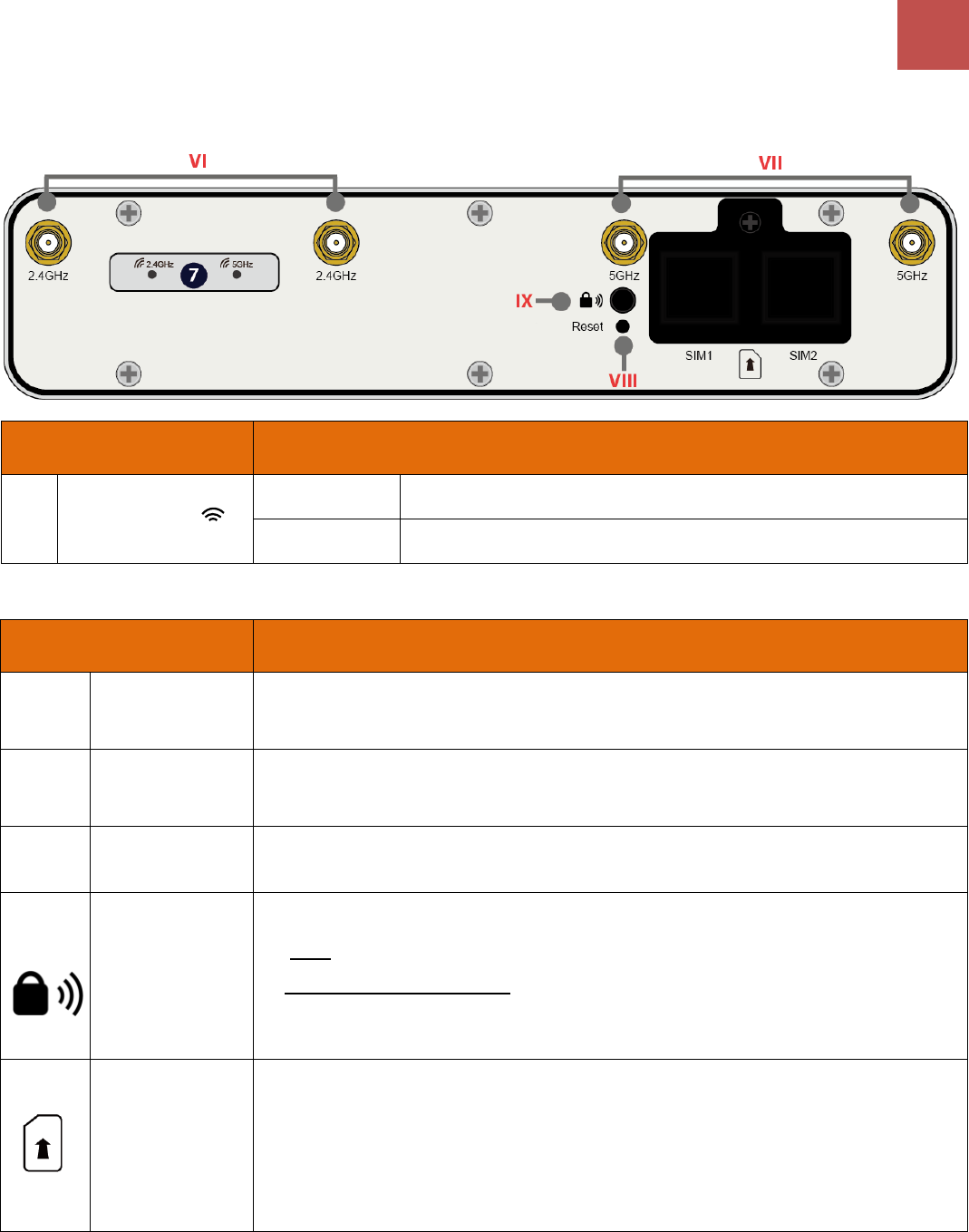
Product Overview
Device Description (Back)
10
BEC MX-1200 Series User Manual
Device Description (Back)
LEDS
MEANING
7
Wi-Fi 2.4G / 5G
Green
Wireless connection to 2.4G or/and 5G network is established
Blinking
Data being transmitted / received
PORTS
MEANING
VI
2.4GHz
Wi-Fi Antenna
Find two (2) short 2.4GHz Wi-Fi antennas and screw them onto the antenna connectors
VII
5GHz
Wi-Fi Antenna
Find two (2) long 5GHz Wi-Fi antennas and screw them onto the antenna connectors
VIII
Reset
After the device is powered on, press it 6 seconds or above: to restore to factory default
settings (this is used when you cannot login to the router, e.g. forgot your password)
IX
WPS &
Wireless On/Off
By controlling the pressing time, users can achieve two different effects:
(1) WPS*: Press &hold the button for less than 6 seconds to trigger WPS function.
(2) Wireless ON/OFF button: Press & hold the button for more than 6 seconds to
enable or disable the wireless.
* Refer to the WPS section in the User Manual for more details.
SIM 1 / SIM 2
Card Slots
Primary: SIM 1. Secondary: SIM 2
If only have one SIM card, insert it to SIM 1.
Insert the mini SIM card (2FF) with the gold contact facing down.
Push the mini SIM card (2FF) inwards to eject it
* Power off the MX-1200 before inserting or removing the SIM card(s)

Product Overview
System Recovery Procedure & Cabling
11
BEC MX-1200 Series User Manual
System Recovery Procedures
The purpose is to allow users to restore the MX-1200 to its initial stage when the device is outage,
upgraded to a wrong / broken firmware, cannot access to the GUI with wrong username and/or
password, etc.
Step 1 – Configure your PC Network IP Address
Before performing the system recovery, assign this IP address and Netmask to your PC,
192.168.1.100 and 255.255.255.0 respectively.
Step 2 – Reset your MX-1200 Device
2.1 Power off your MX-1200
2.2 Power on the MX-1200 while pushing the RESET button with a small pointed object (such as
paper clip, needle, toothpick, etc.).
2.3 When the POWER LED turns RED, keep holding and pushing the RESET button until the
INTERNET LED flashes in GREEN
Step 3 – Restore your MX-1200 Device
With INTERNET light flashes green, MX-1200 is in recovery mode and ready for a new Firmware.
3.1 Open a web browser and type the IP address, 192.168.1.1, to access to the recovery page.
NOTE: In the recovery mode, MX-1200 will not respond to any PING or other requests.
3.2 Browse to the new Firmware image file then click Upload to start the upgrade process.
3.3 INTERNET LED turns red means the Firmware upgrade is in process.
DO NOT power off or reboot the device, it would permanently damage your MX-1200.
3.4 INTERNET LED turns green after the Firmware upgrade completed
3.5 Power cycle on & off to regain access to the MX-1200.
Cabling
One of the most common causes of problems is bad cabling. Make sure that all connected devices
are turned on. On the front panel of the product is a bank of LEDs. Verify that the LAN Link and LEDs
are lit. If they are not, verify that you are using the proper cables.

Basic Installation
12
BEC MX-1200 Series User Manual
CHAPTER 3: BASIC INSTALLATION
The router can be configured with your web browser. A web browser is included as a standard
application in the following operating systems: Windows XP / Vista / 7 / 8/10, Linux, Mac OS, and etc.
The product provides an easy and user-friendly interface for configuration.
PCs must have an Ethernet interface installed properly and be connected to the router either directly
or through an external repeater hub, and have TCP/IP installed or configured to obtain an IP address
through a DHCP server or a fixed IP address that must be in the same subnet as the router. The
default IP address of the router is 192.168.1.254 and the subnet mask is 255.255.255.0 (i.e. any
attached PC must be in the same subnet, and have an IP address in the range of 192.168.1.1 to
192.168.1.253). The best and easiest way is to configure the PC to get an IP address automatically
from the router using DHCP. If you encounter any problems accessing the router’s web interface it
may also be advisable to uninstall any kind of software firewall on your PCs, as they can cause
problems accessing the 192.168.1.254 IP address of the router. Users should make their own
decisions on how to best protect their network.
Please follow the steps below for your PC’s network environment installation. First of all, please check
your PC’s network components. The TCP/IP protocol stack and Ethernet network adapter must be
installed. If not, please refer to your Windows-related or other operating system manuals.
Any TCP/IP capable workstation can be used to communicate with
or through the MX-1200. To configure other types of workstations,
please consult the manufacturer’s documentation.
Attention
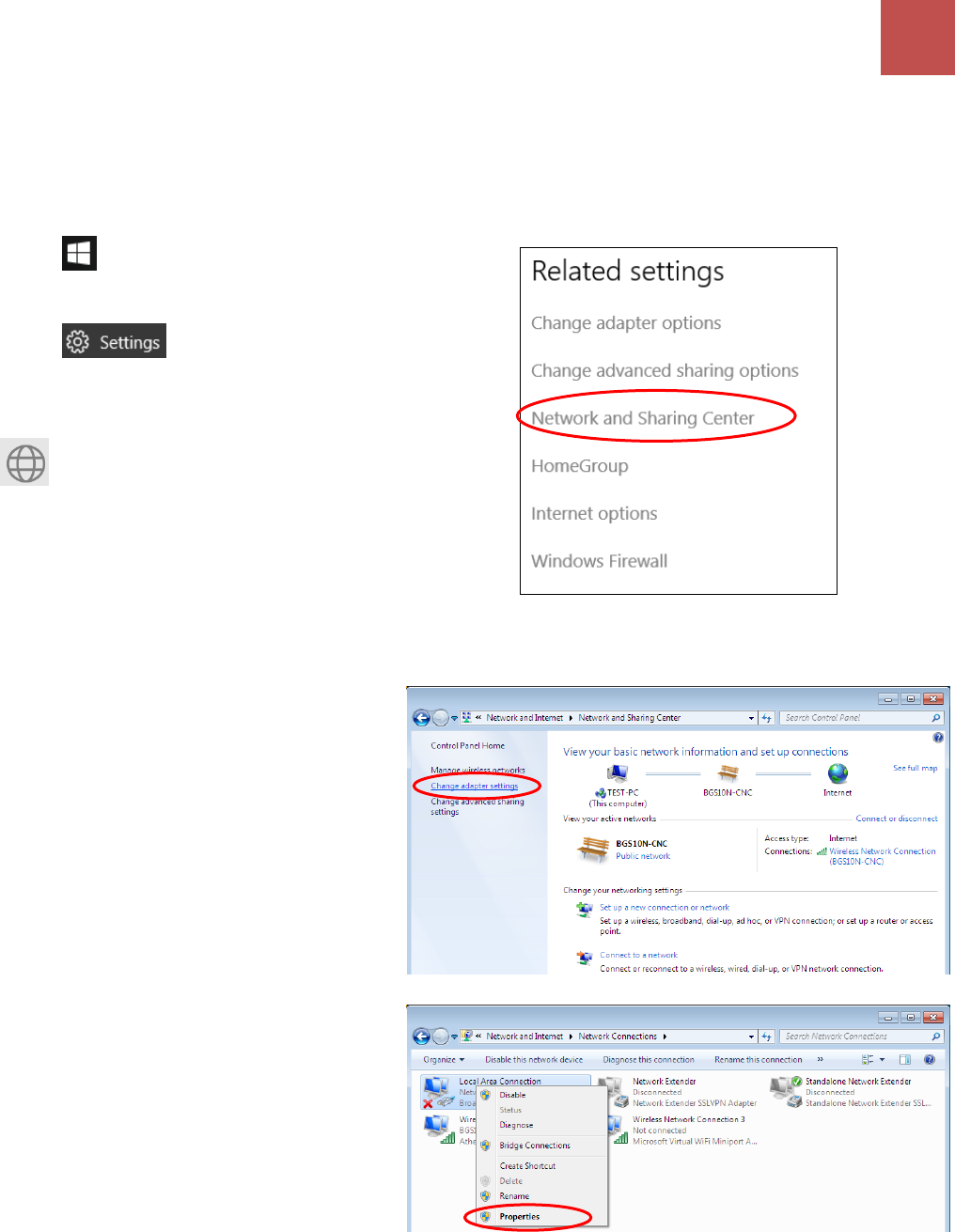
Basic Installation
Network Configuration – Windows 10 (IPv4)
13
BEC MX-1200 Series User Manual
Network Configuration – IPv4
Configuring PC in Windows 10 (IPv4)
1. Click .
2. Click
3. Then click on Network and Internet.
4. Under Related settings, select
Network and Sharing Center
5. When the Network and Sharing
Center window pops up, select and
click on Change adapter settings on
the left window panel.
6. Select the Local Area Connection,
and right click the icon to select
Properties.
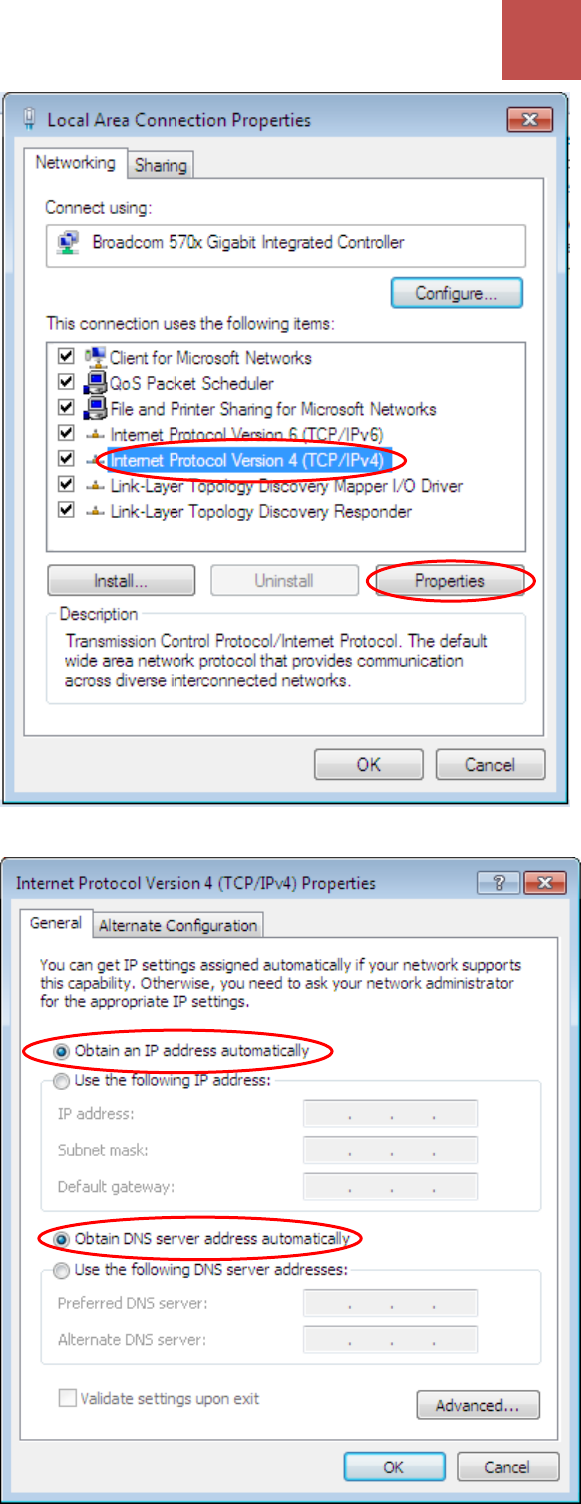
Basic Installation
Network Configuration – Windows 10 (IPv4)
14
BEC MX-1200 Series User Manual
7. Select Internet Protocol Version 4
(TCP/IPv4) then click Properties.
8. In the TCP/IPv4 properties window,
select the Obtain an IP address
automatically and Obtain DNS
Server address automatically radio
buttons. Then click OK to exit the
setting.
9. Click OK again in the Local Area
Connection Properties window to
apply the new configuration.
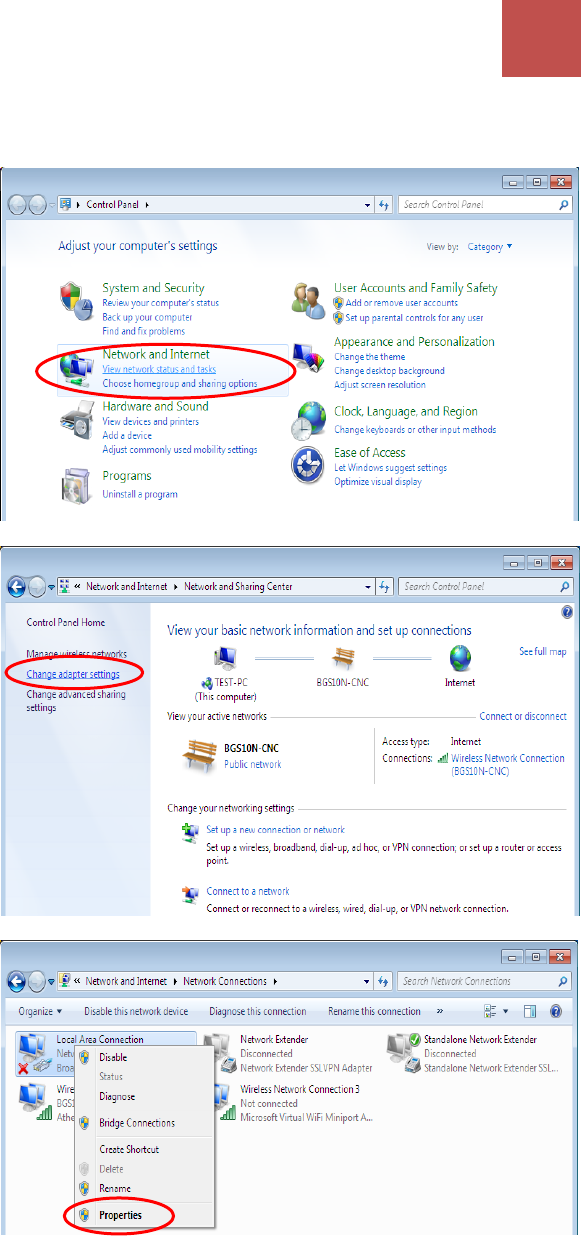
Basic Installation
Network Configuration – Windows 7/8 (IPv4)
15
BEC MX-1200 Series User Manual
Configuring PC in Windows 7/8 (IPv4)
1. Go to Start. Click on Control Panel.
2. Then click on Network and Internet.
3. When the Network and Sharing
Center window pops up, select and
click on Change adapter settings on
the left window panel.
4. Select the Local Area Connection,
and right click the icon to select
Properties.
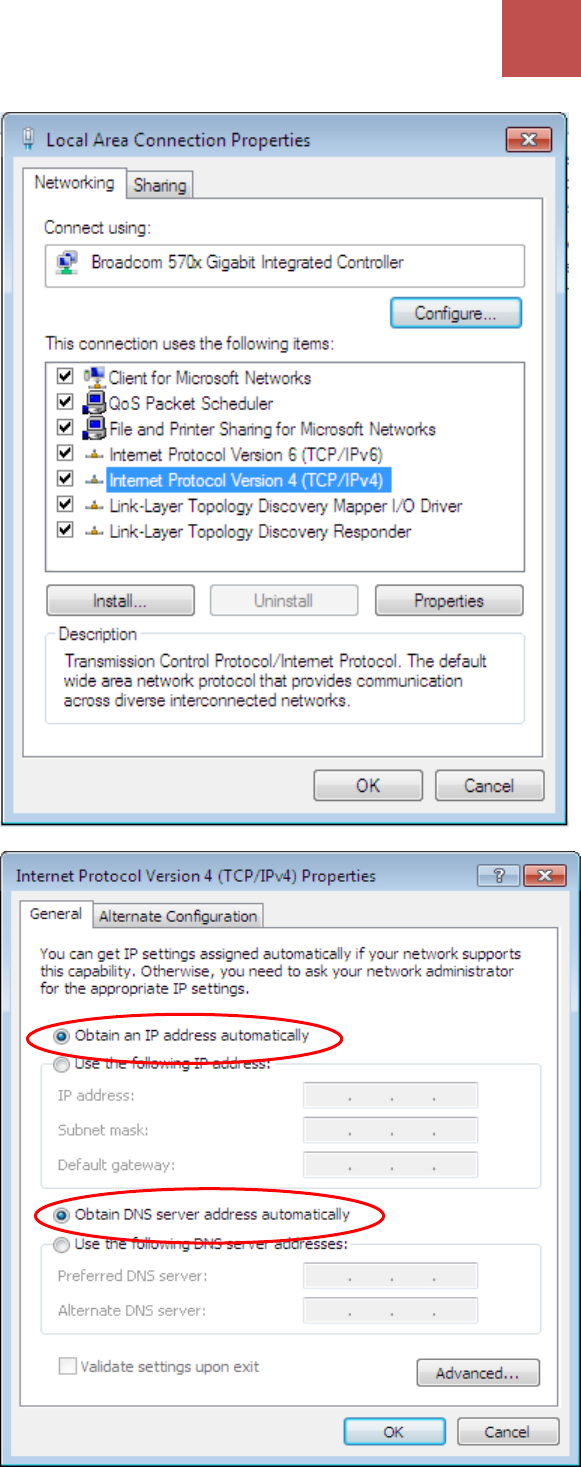
Basic Installation
Network Configuration – Windows 7/8 (IPv4)
16
BEC MX-1200 Series User Manual
5. Select Internet Protocol Version 4
(TCP/IPv4) then click Properties.
6. In the TCP/IPv4 properties window,
select the Obtain an IP address
automatically and Obtain DNS
Server address automatically radio
buttons. Then click OK to exit the
setting.
7. Click OK again in the Local Area
Connection Properties window to
apply the new configuration.
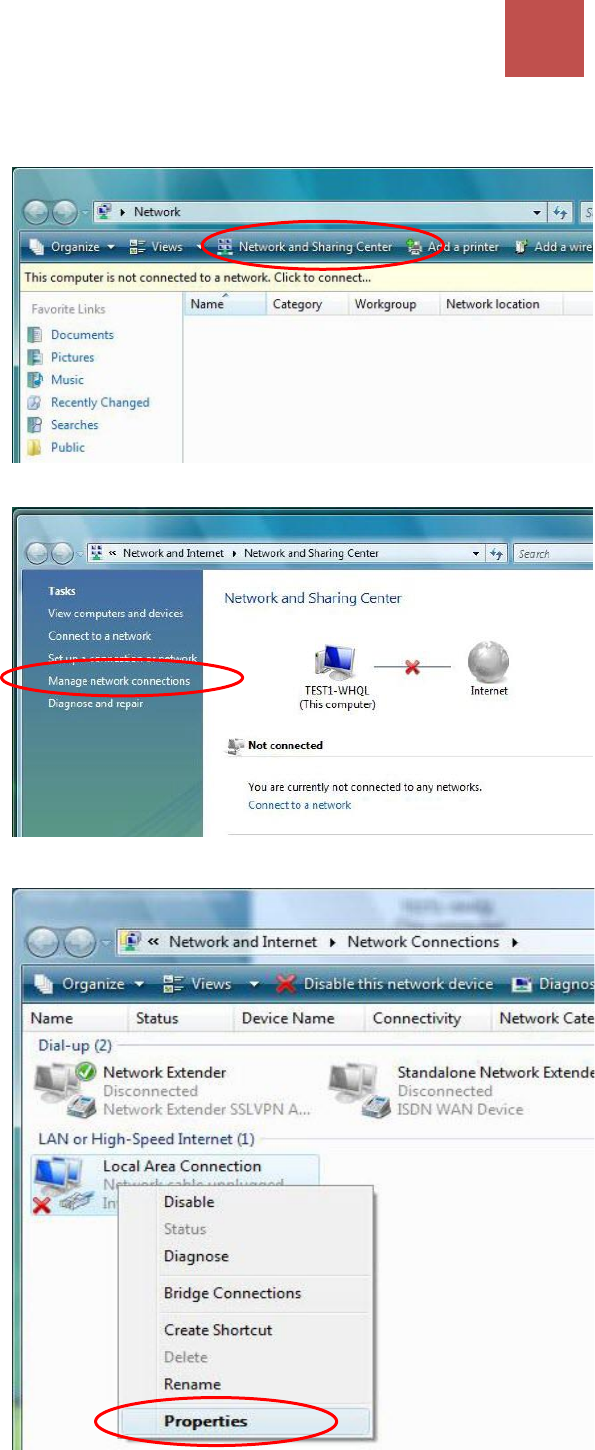
Basic Installation
Network Configuration – Windows Vista (IPv4)
17
BEC MX-1200 Series User Manual
Configuring PC in Windows Vista (IPv4)
1. Go to Start. Click on Network.
2. Then click on Network and Sharing
Center at the top bar.
3. When the Network and Sharing
Center window pops up, select and click
on Manage network connections on
the left window pane.
4. Select the Local Area Connection, and
right click the icon to select Properties.
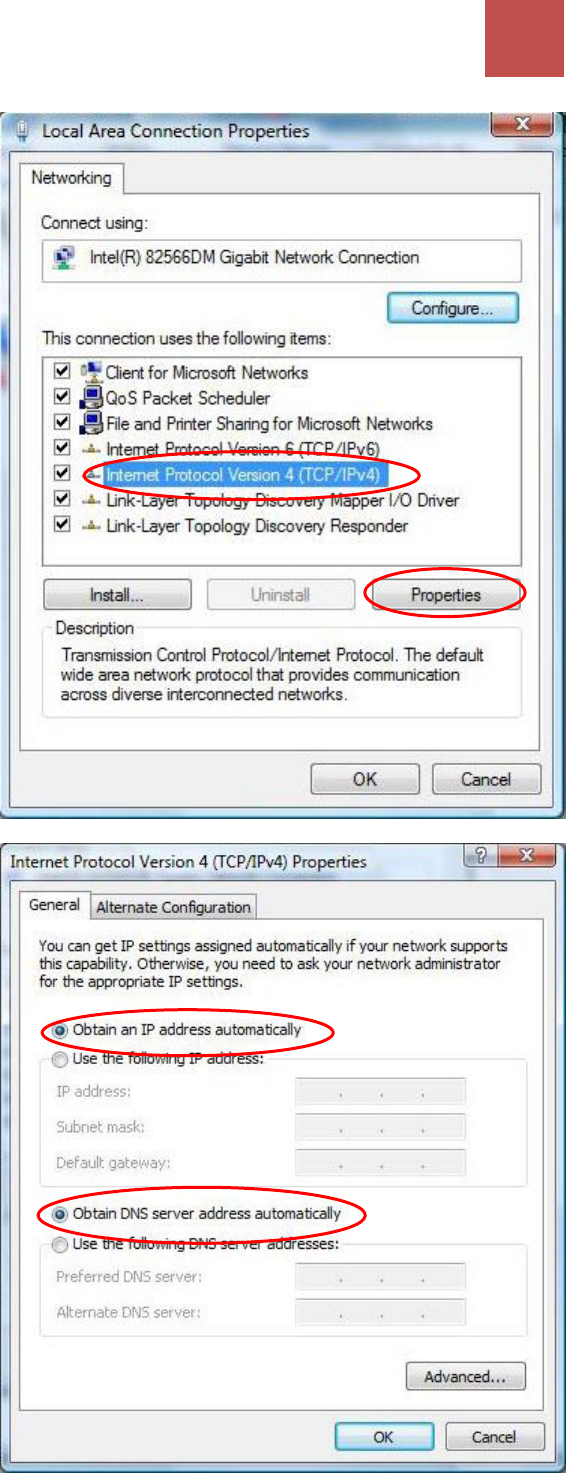
Basic Installation
Network Configuration – Windows Vista (IPv4)
18
BEC MX-1200 Series User Manual
5. Select Internet Protocol Version 4
(TCP/IPv4) then click Properties.
6. In the TCP/IPv4 properties window,
select the Obtain an IP address
automatically and Obtain DNS Server
address automatically radio buttons.
Then click OK to exit the setting.
7. Click OK again in the Local Area
Connection Properties window to
apply the new configuration.
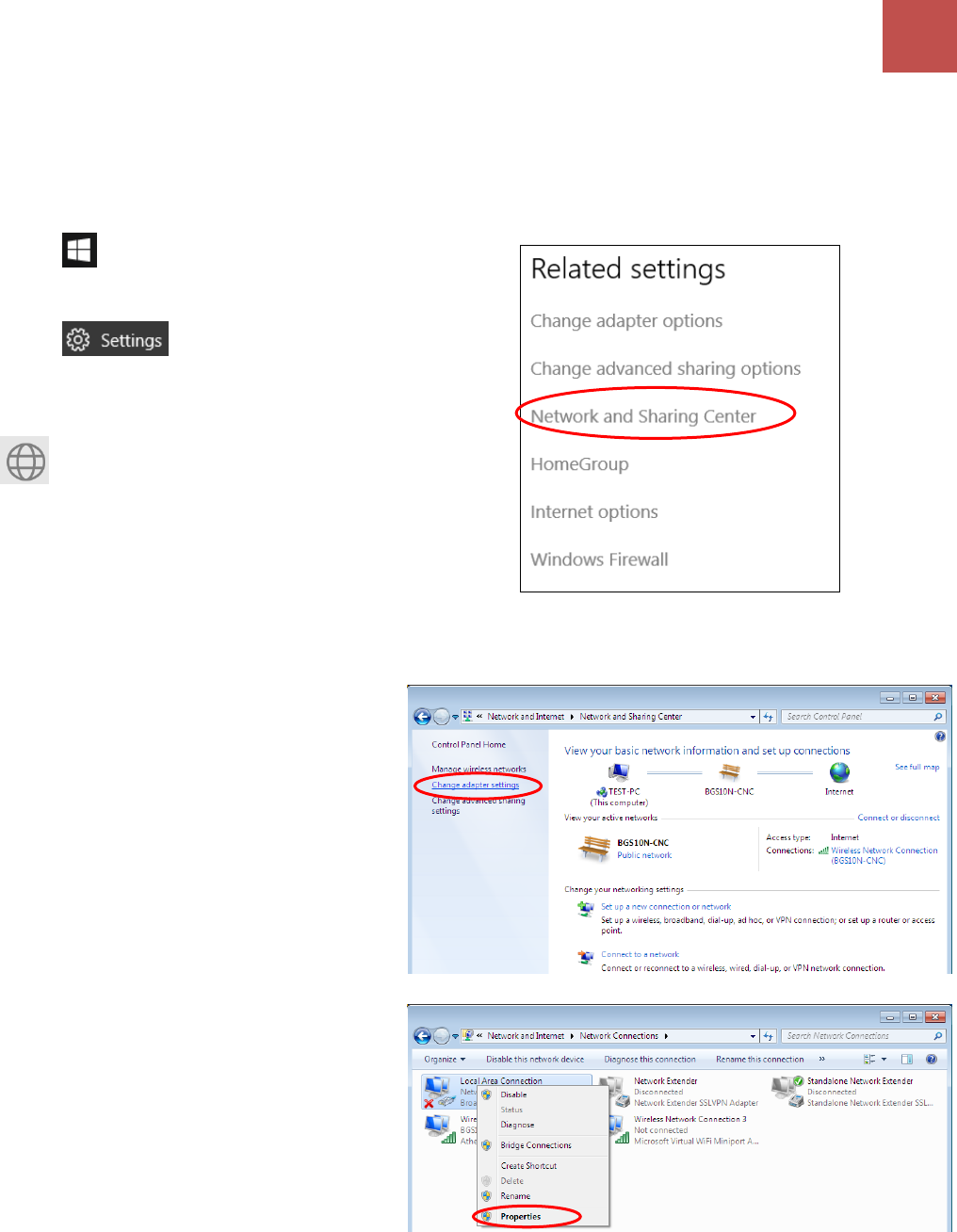
Basic Installation
Network Configuration – Windows 10 (IPv6)
19
BEC MX-1200 Series User Manual
Network Configuration – IPv6
Configuring PC in Windows 10 (IPv6)
1. Click .
2. Click
3. Then click on Network and Internet.
4. Under Related settings, select
Network and Sharing Center
5. When the Network and Sharing
Center window pops up, select and
click on Change adapter settings on
the left window panel.
6. Select the Local Area Connection,
and right click the icon to select
Properties.
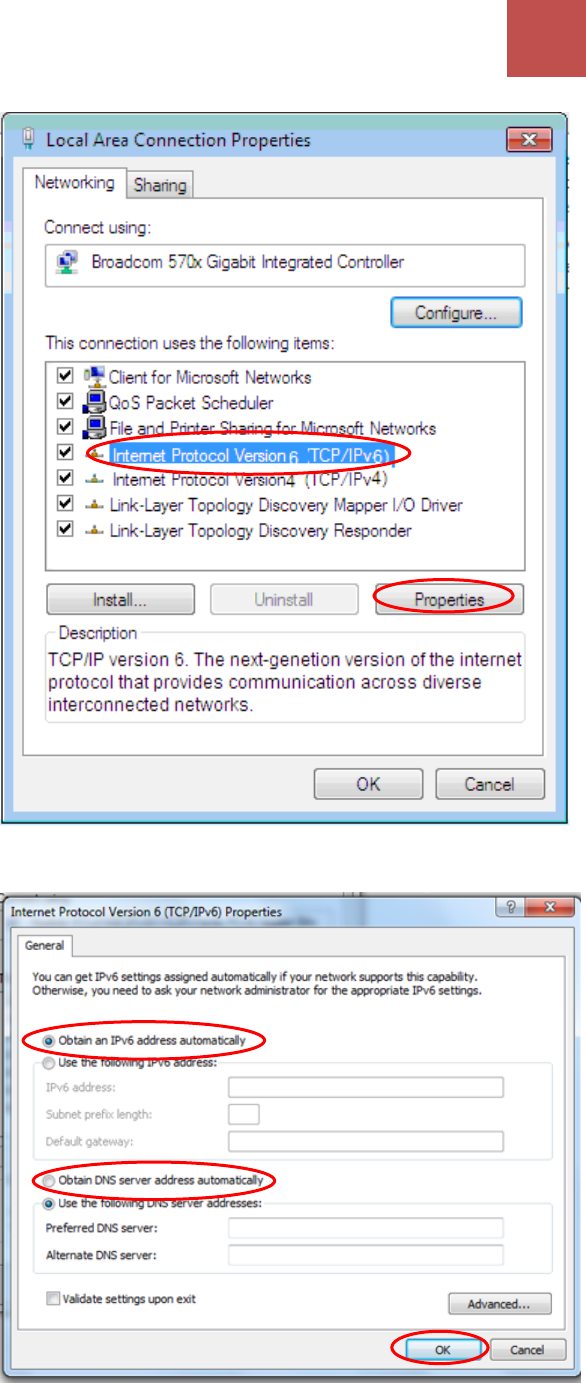
Basic Installation
Network Configuration – Windows 10 (IPv6)
20
BEC MX-1200 Series User Manual
7. Select Internet Protocol Version 6
(TCP/IPv6) then click Properties.
8. In the TCP/IPv6 properties window,
select the Obtain an IPv6 address
automatically and Obtain DNS
Server address automatically radio
buttons. Then click OK to exit the
setting.
9. Click OK again in the Local Area
Connection Properties window to
apply the new configuration.
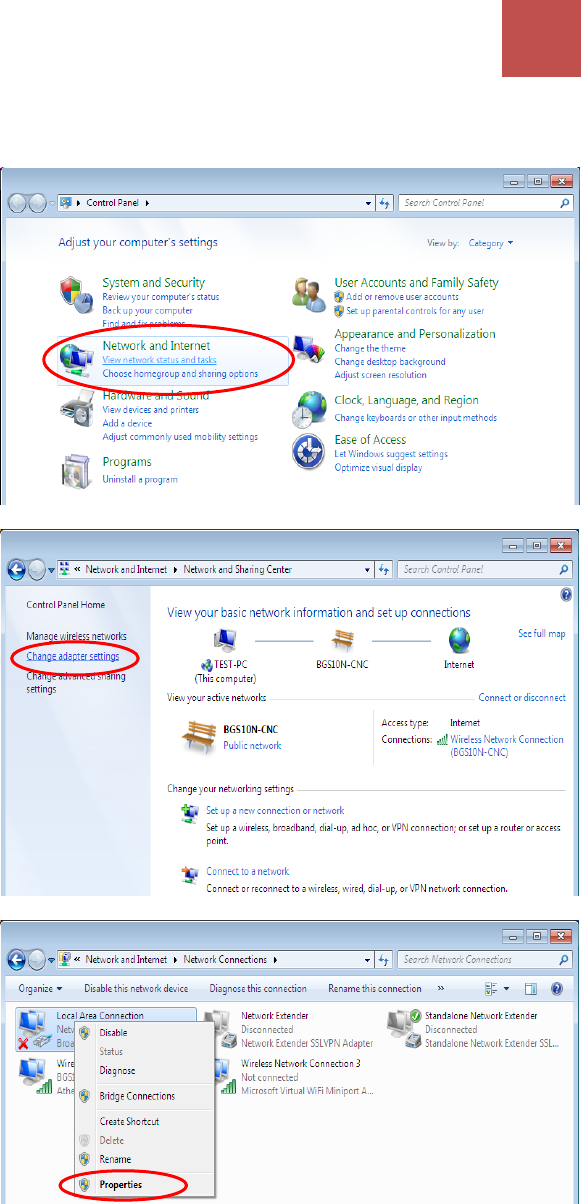
Basic Installation
Network Configuration – Windows 7/8 (IPv6)
21
BEC MX-1200 Series User Manual
Configuring PC in Windows 7/8 (IPv6)
1. Go to Start. Click on Control Panel.
2. Then click on Network and Internet.
3. When the Network and Sharing
Center window pops up, select and
click on Change adapter settings on
the left window panel.
4. Select the Local Area Connection,
and right click the icon to select
Properties.
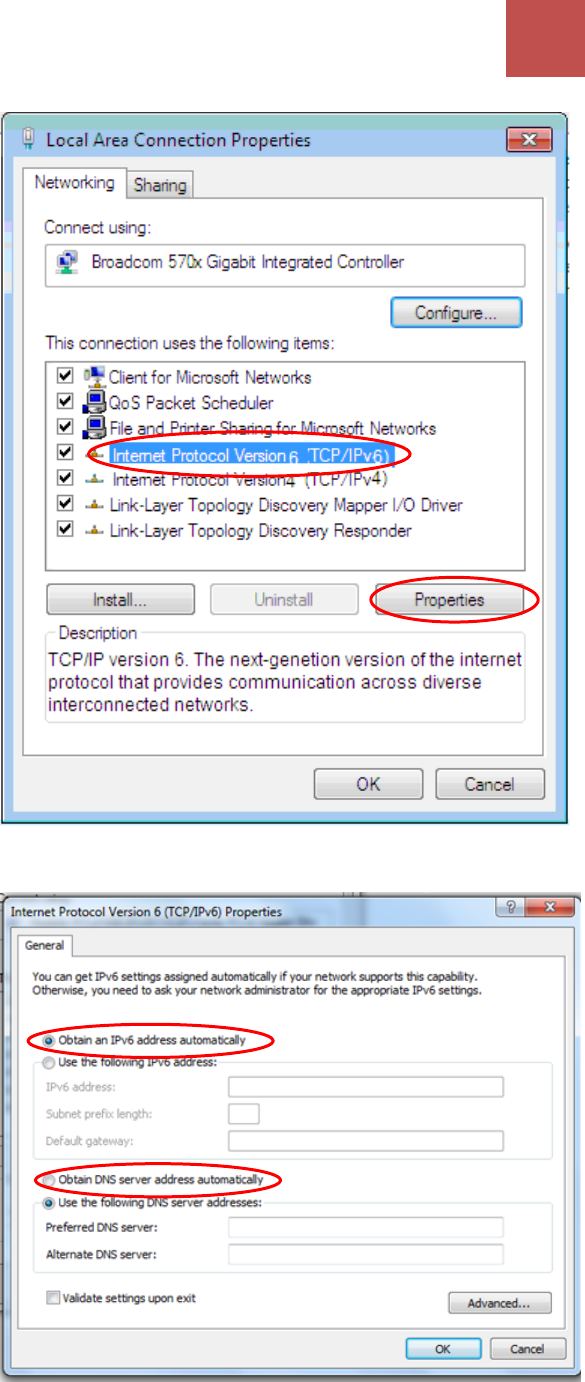
Basic Installation
Network Configuration – Windows 7/8 (IPv6)
22
BEC MX-1200 Series User Manual
5. Select Internet Protocol Version 6
(TCP/IPv6) then click Properties.
6. In the TCP/IPv6 properties window,
select the Obtain an IPv6 address
automatically and Obtain DNS
Server address automatically radio
buttons. Then click OK to exit the
setting.
7. Click OK again in the Local Area
Connection Properties window to
apply the new configuration.
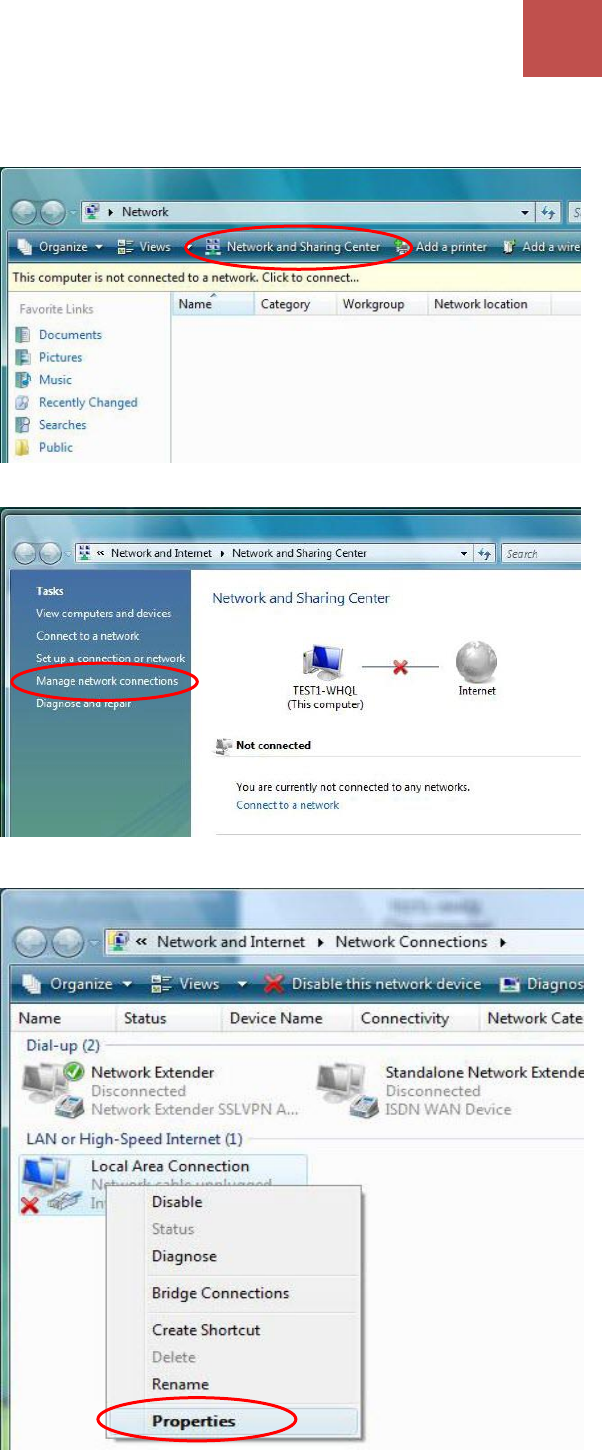
Basic Installation
Network Configuration – Windows Vista (IPv6)
23
BEC MX-1200 Series User Manual
Configuring PC in Windows Vista (IPv6)
1. Go to Start. Click on Network.
2. Then click on Network and Sharing
Center at the top bar.
3. When the Network and Sharing
Center window pops up, select and
click on Manage network
connections on the left window
pane.
4. Select the Local Area Connection,
and right click the icon to select
Properties.
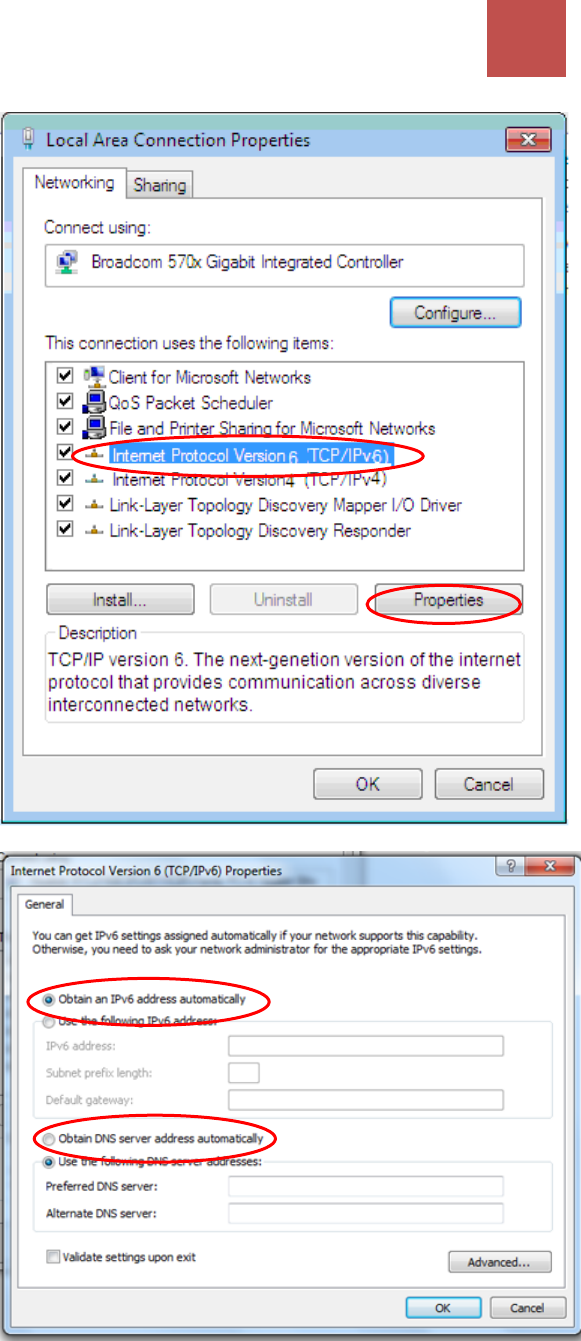
Basic Installation
Network Configuration – Windows Vista (IPv6)
24
BEC MX-1200 Series User Manual
5. Select Internet Protocol Version 6
(TCP/IPv6) then click Properties.
6. In the TCP/IPv6 properties window,
select the Obtain an IP address
automatically and Obtain DNS Server
address automatically radio buttons.
Then click OK to exit the setting.
7. Click OK again in the Local Area
Connection Properties window to
apply the new configuration.
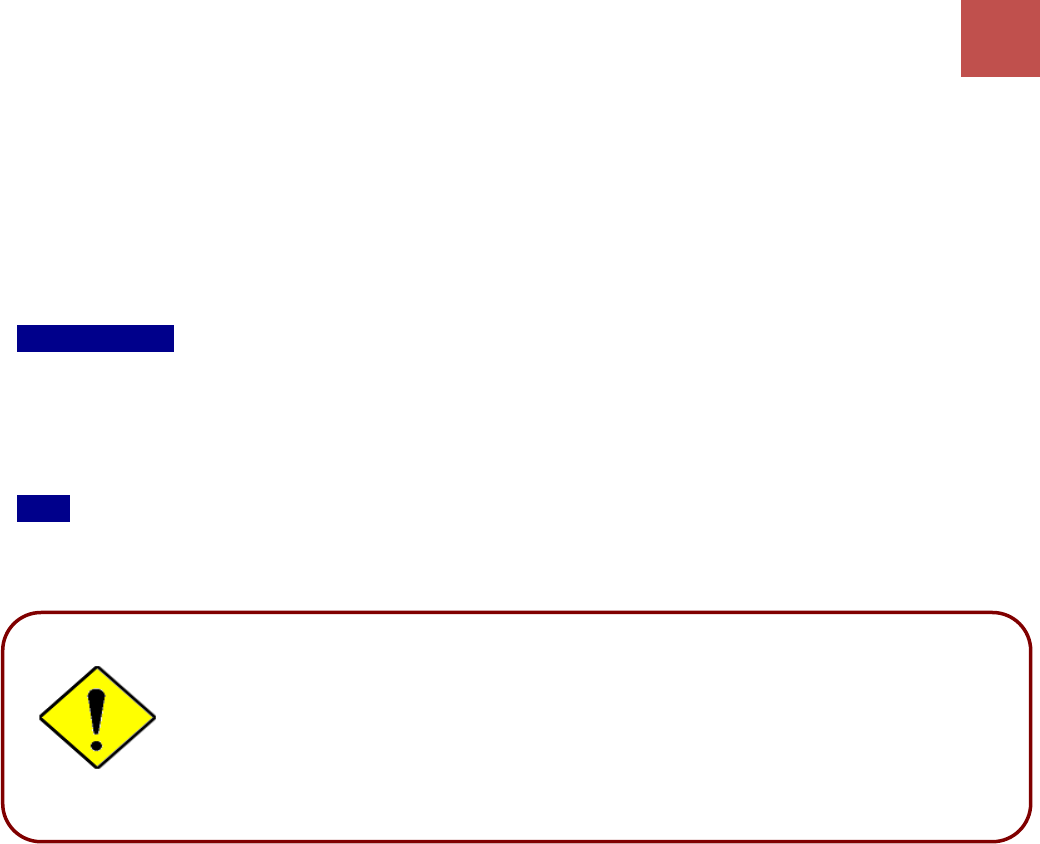
Basic Installation
Default Settings
25
BEC MX-1200 Series User Manual
Default Settings
Before configuring the router, you need to know the following default settings.
Web Interface: (Username and Password)
Administrator
• Username: admin
• Password: admin or a unique 12-digit password can be found on the device label.
User
• Username: user
• Password: user
Device LAN IP Settings
• IP Address: 192.168.1.254
• Subnet Mask: 255.255.255.0
DHCP Server:
• DHCP server is enabled.
• Start IP Address: 192.168.1.100
• IP pool counts: 100
If you ever forget the username/password to login to the router, you may
press the RESET button up to 6 seconds then release it to restore the
factory default settings.
Caution: After pressing the RESET button for more than 6 seconds then
release it, to be sure you power cycle the device again.
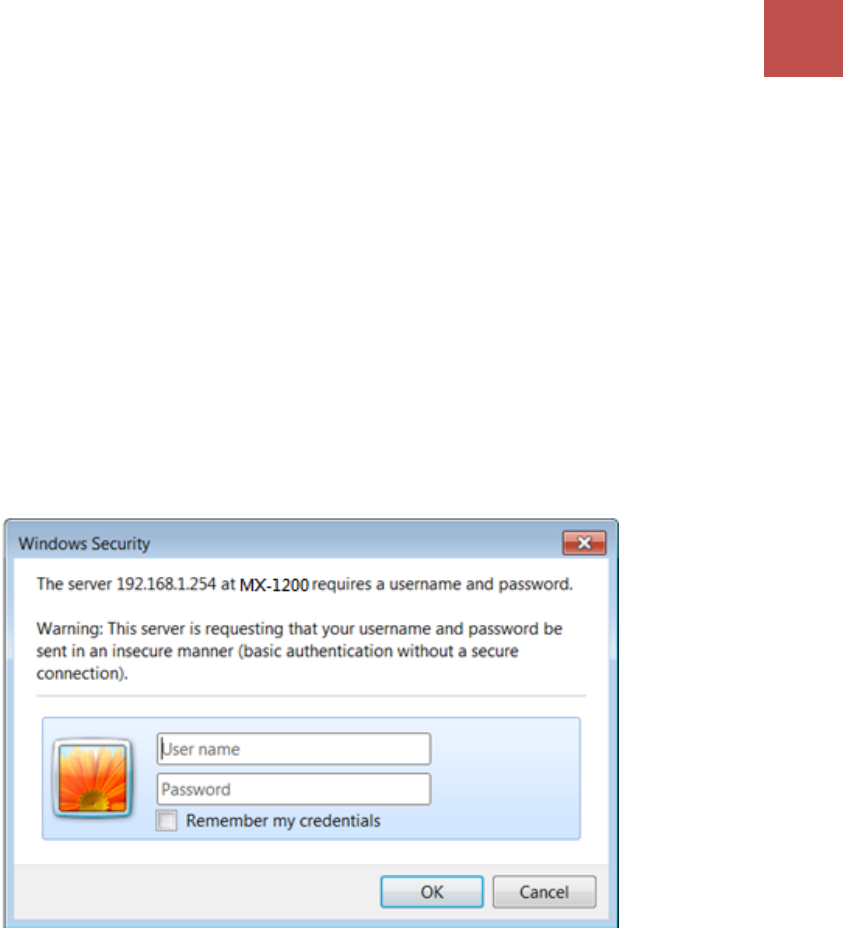
Device Configuration
Login to Your Device
26
BEC MX-1200 Series User Manual
CHAPTER 4: DEVICE CONFIGURATION
Login to your Device
Open your web browser, enter the IP address of your router, which by default is 192.168.1.254, and
click “Go”, a user name and password window prompt appears.
Inset the management GUI username and password.
NOTE: This username / password may vary by different Internet Service Providers.
Congratulations! You have successfully logged on to your MX-1200

Device Configuration
Login to Your Device
27
BEC MX-1200 Series User Manual
Once you have logged on to your MX-1200 via your web browser, you can begin to set it up according
to your requirements. On the configuration homepage, the left navigation pane links you directly to the
setup pages, which includes:
Section
Status
Quick Start
(Wizard Setup)
Configuration
Sub-
Items
Device Info
System Status
System Log
3G/4G-LTE Status
GPS Status
Hardware Monitor
Hotspot Status
Statistics
DHCP Table
Disk Status
ARP Table
VRRP
Interface Setup
- Internet
- LAN
- Wireless
- Wireless MAC Filter
Dual WAN
- General Setting
- Outbound Load Balance
- Protocol Binding
Hotspot
- General Setting
- Built-in User Account
- Authorized of Client
- Walled Garden
- Advertisement
- Session Log
- Customization
Advanced Setup
- Firewall
- Routing
- NAT
- VRRP
- Static DNS
- Time Schedule
- Mail Alert
Access Management
- Device Management
- SNMP
- Syslog
- Universal Plug & Play
- Dynamic DNS
- Access Control
- Packet Filter
- CWMP (TR-069)
- Parental Control
- SAMBA & FTP Server
- BECentral Management
Maintenance
- User Management
- Certificate Management
- Time Zone
- Firmware & Configuration
- System Restart
- Auto Reboot
- Diagnostic Tool
- Ignition Sensing
Please see the relevant sections of this manual for detailed instructions on how to configure your MX-
1200.
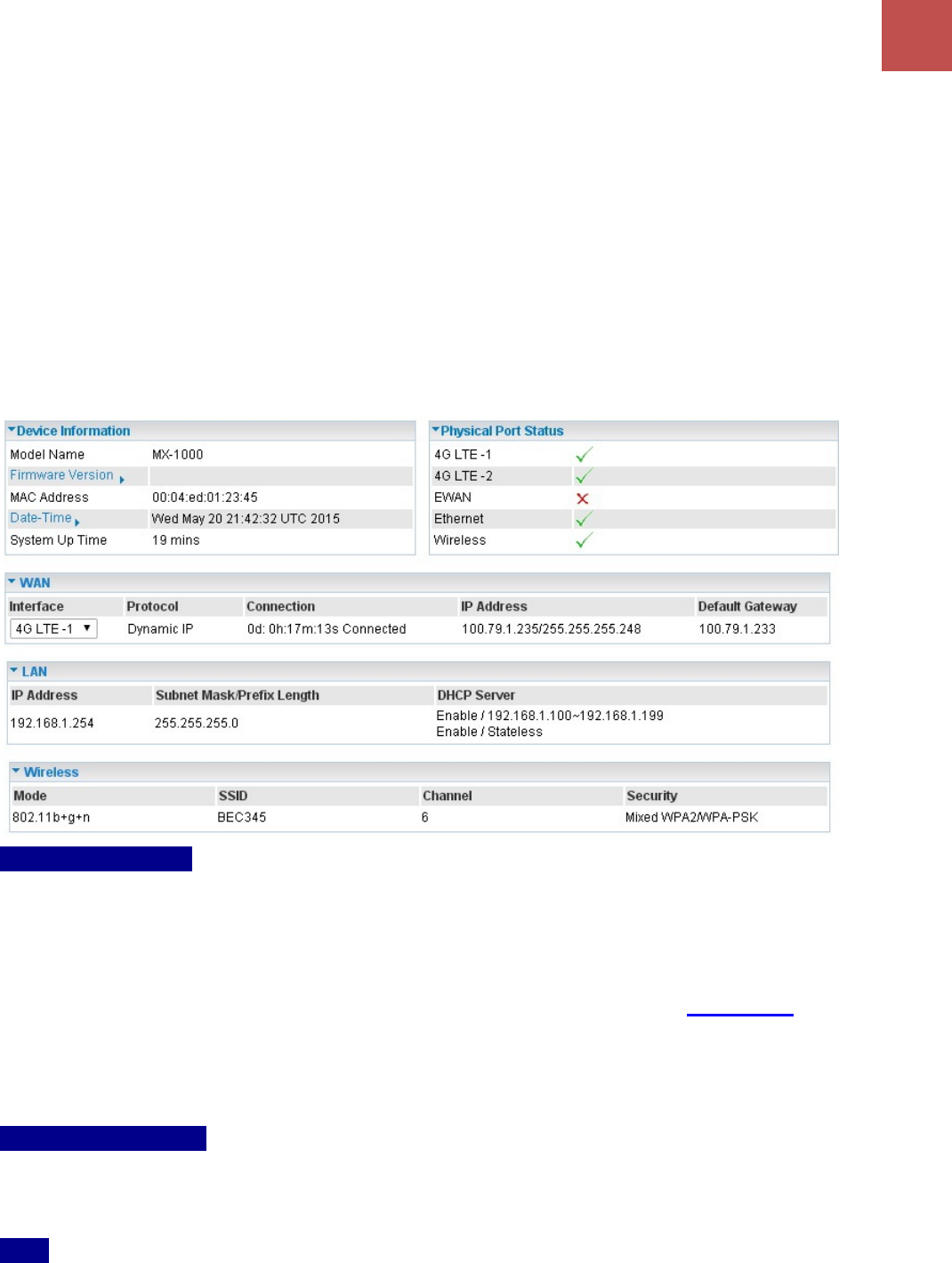
Device Configuration
Status – Device Info
28
BEC MX-1200 Series User Manual
Status
In this section, you can check the router working status, including Device Info, System Status,
System Log, 3G/4G-LTE Status, GPS Status, Hardware Monitor, Hotspot Status, Statistics,
DHCP Table, Disk Status, ARP Table and VRRP.
Device Info
It provides brief status summary of the device.
Device Information
Model Name: Name of the router for identification purpose.
Firmware Version: Software version currently loaded in the router
MAC Address: A unique number that identifies the router
Data Time: Setup correct time on the MX-1200 with your PC. Check on Time Zone section for more
configuration information.
System Uptime: Display how long the MX-1200 has been powered on.
Physical Port Status
Physical Port Status:Display available connection interfaces supported in the MX-1200.
WAN
Interface: List current available WAN connections.
Protocol: Display selected WAN connection protocol
Connection: The current connection status.

Device Configuration
Status – Device Info
29
BEC MX-1200 Series User Manual
IP Address: WAN port IP address.
Default Gateway: The IP address of the default gateway.
LAN
IP Address: LAN port IPv4 address.
Subnet Mask/Prefix Length: Display LAN port IP subnet mask of IPv4 and/or Prefix length of IPv6.
DHCP Server: Display LAN DHCP status of IPv4 and IPv6.
Enable / 192.168.1.100~199: DHCPv4 server status on or off / DHCP IP range
Enable / Stateless: DHCPv6 server status on or off / DHCPv6 server Type
Wireless
Mode: Display selected Wireless mode.
SSID: Display the name of the Wireless AP(s) to use
Channel: Display radio frequency to be used for this wireless link
Security: Display security method to be used for this wireless link
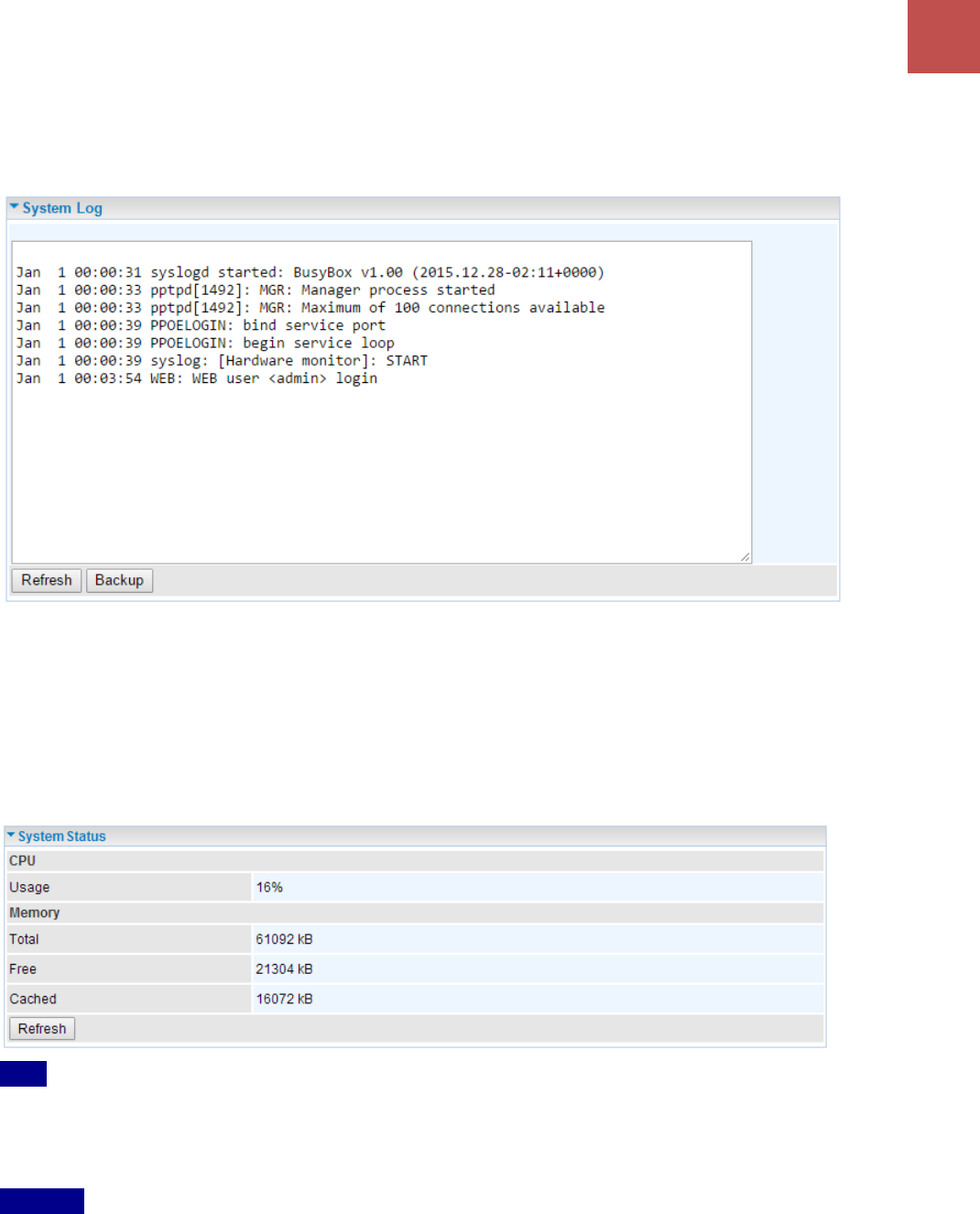
Device Configuration
Status – System Log & System Status
30
BEC MX-1200 Series User Manual
System Log
In system log, you can check the operations status and any glitches to the router.
Refresh: Press this button to refresh the statistics.
Backup: Press to save the System log, log.cfg, to your PC.
System Status
System status displays the current router system (CPU and Memory) usage.
CPU
Usage: Display the amount of CPU’s processing capacity is being used in percentage (%). Higher
the % rate may result in slow Internet loading, experiencing video lags, etc. To reduce high CPU
consumption by resetting the device, power off and on, an easiest way to regain the service.
Memory
Total / Free / Cached (in Kbyte): Display the memory consumptions in kilobytes (kB).
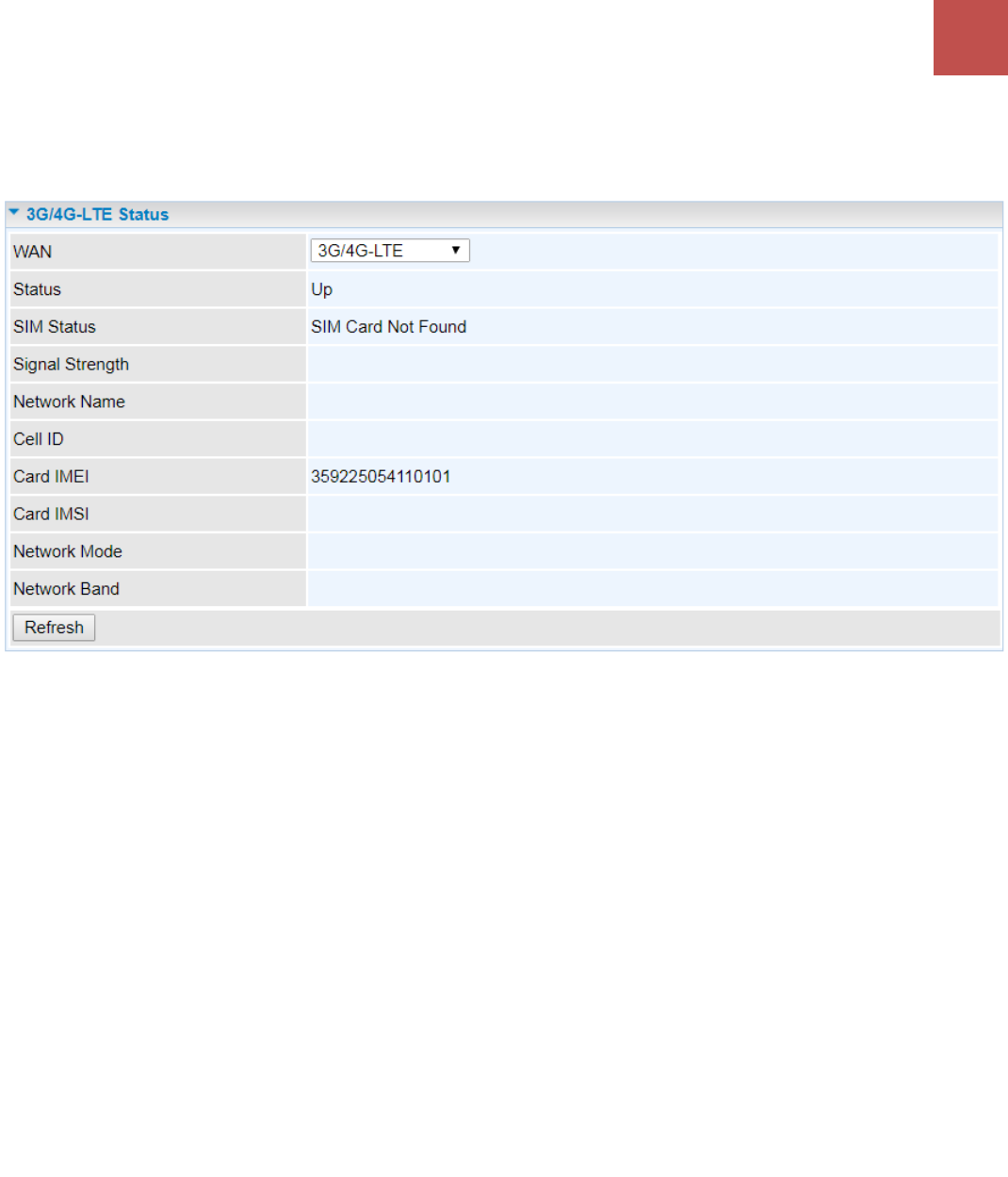
Device Configuration
Status – 3G/4G-LTE
31
BEC MX-1200 Series User Manual
3G/4G-LTE Status
This page contains 3G/4G-LTE connection information.
Status: The current status of the 3G/4G-LTE connection.
SIM Status: Identify current status of the SIM, Activate or SIM Card Not Found.
Signal Strength: The signal strength bar and dBm value indicates the current 3G/4G-LTE signal
strength. The front panel 3G/4G-LTE Signal Strength LED indicates the signal strength as well.
Signal Information: Shows important LTE signal parameters such as RSRP (Reference Signal
Receiving Power), RSRQ (Reference Signal Receiving Quality), SINR (Signal to Interference plus
Noise Ratio).
RSRP (Reference Signal Receiving Power): is the average power of all resource elements
which carry cell-specified reference signals over the entire bandwidth.
RSRQ (Reference Signal Receiving Quality): measures the signal strength and is calculated
based on both RSRP and RSSI.
RSSI (Received Signal Strength Indicator): parameter which provides information about total
received wide-band power (measure in all symbols) including all interference and thermal noise.
SNR (Signal Noise Ratio): is also a measure of signal quality as well. It is widely used by the
operators as it provides a clear relationship between RF conditions and throughput.
Note: Some LTE modules do not provide this information.
Network Name: The name of the LTE network the router is connecting to.
Cell ID: The ID of base station that the device is connected to.
Card IMEI: The unique identification number that is used to identify the 3G/4G-LTE module.
Card IMSI: The international mobile subscriber identity used to uniquely identify the 3G/4G-LTE
module.
Network Mode: Display current network operating mode.
Network Band: Indicated the current radio frequency band used.
Refresh: Click to refresh the statistics.
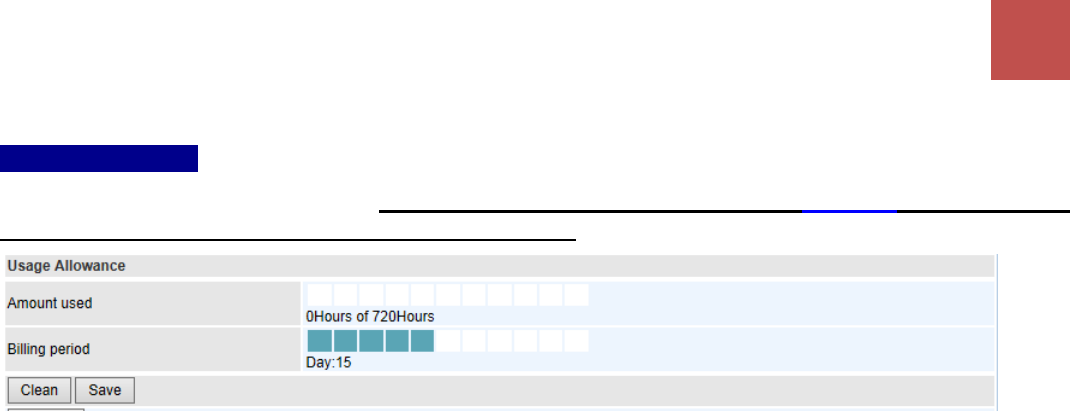
Device Configuration
Status – 3G/4G-LTE
32
BEC MX-1200 Series User Manual
Usage Allowance
To enable this feature, please go to Configuration >> Interface Setup >> Internet >> click “Usage
Allowance” >> enable “Save the statistics to ROM”
Amount Used: Display the amount of mobile data used and remaining in current billing cycle.
Billing Cycle: Display the start date and number of days remaining in current billing cycle
Clean: Reset current saved mobile usage
Save: Click to save current mobile status to ROM
Refresh: Click to refresh the statistics.

Device Configuration
Status – GPS Status & Hardware Monitor
33
BEC MX-1200 Series User Manual
GPS Status
In GPS status, you can check the UTC time, position of the router.
Hardware Monitor
In hardware monitor, you can check the voltage, current and temperature of system.

Device Configuration
Status – Hotspot Status
34
BEC MX-1200 Series User Manual
Hotspot Status
The status table displays a list of connected Wi-Fi clients via the hotspot. .
MAC Address: The MAC of the connected wireless device.
IP Address: The LAN IP address assigned to the wireless device.
Authentication: Identification of the wireless device is being authorized or not.
User Name: The authentication username used to login to the hotspot. Go to Built-in User Account
for detailed login account list.
Duration Time (remaining time / available session time interval): Display remaining interval
available before session expires/timeout.
Idle Time (current idle time / total idle timeout period): Display current idle time of the Wi-Fi device.
If it reaches to total idle timeout period, the Internet connection will get disconnected immediately.
Upload / Download (used / available bandwidth in %): Display current used bandwidths, in
upload and download, out of the maximum allow usage in %.
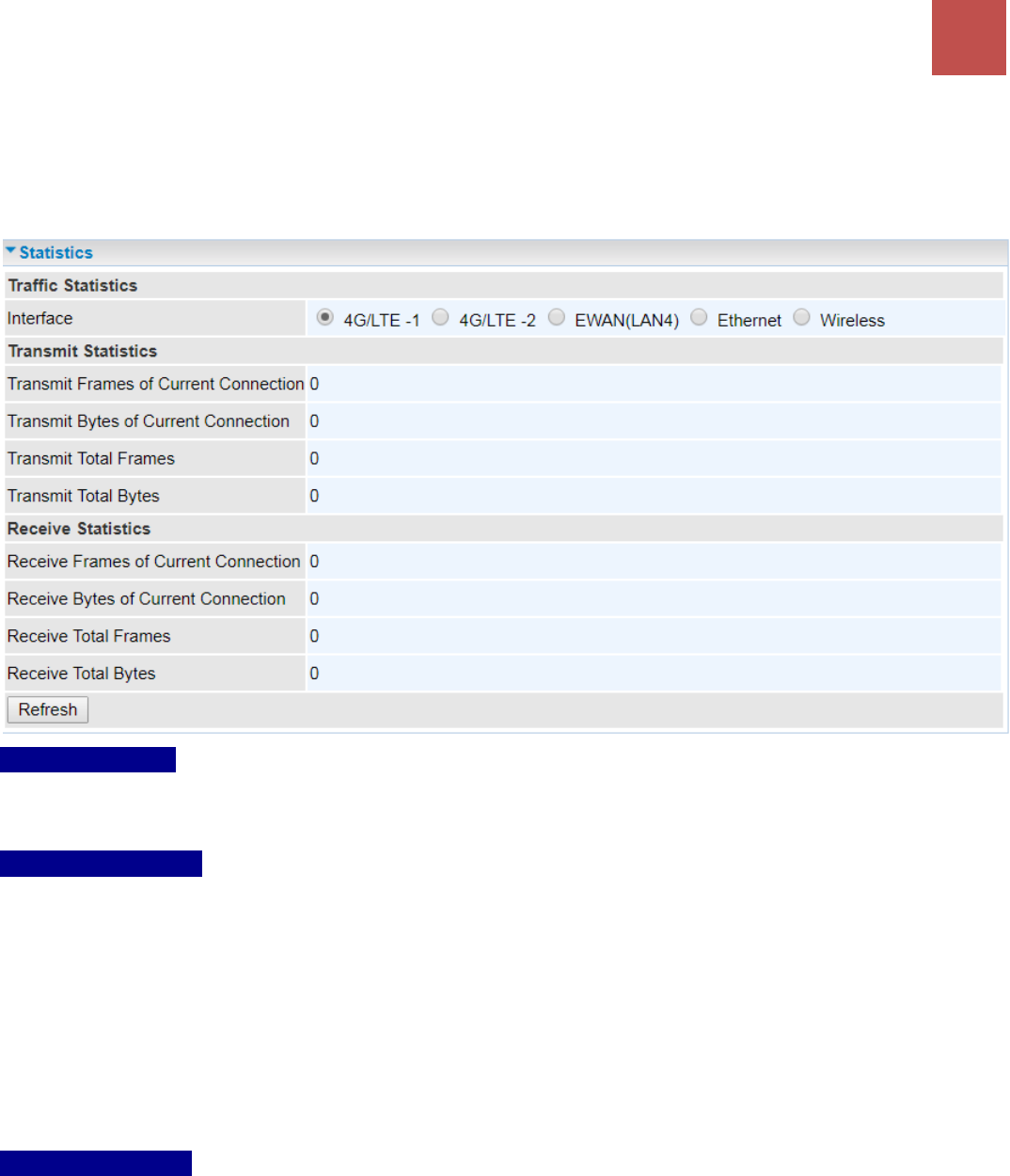
Device Configuration
Status – Statistics (3G/4G-LTE)
35
BEC MX-1200 Series User Manual
Statistics
❖ 3G/4G-LTE
Take 3G/4G-LTE as an example to describe the following connection transmission information.
Traffic Statistics
Interface: List all available network interfaces in the router. You are currently checking on the physical
status of 3G/4G-LTE interface.
Transmit Statistics
Transmit Frames of Current Connection: Display the total number of 3G/4G-LTE frames transmitted
until the latest second for the current connection.
Transmit Bytes of Current Connection: Display the total bytes transmitted till the latest second for
the current connection for the current connection.
Transmit Total Frames: Display the total number of frames transmitted till the latest second since
system is up.
Transmit Total Bytes: Display the total number of bytes transmitted until the latest second since
system is up.
Receive Statistics
Receive Frames of Current Connection: Display the number of frames received until the latest
second for the current connection.
Receive Bytes of Current Connection: Display the total bytes received till the latest second for the
current connection.
Receive Total Frames: Display the total number of frames received until the latest second since
system is up.
Receive Total Bytes: Display the total frames received till the latest second since system is up.
Refresh: Click to refresh this page.
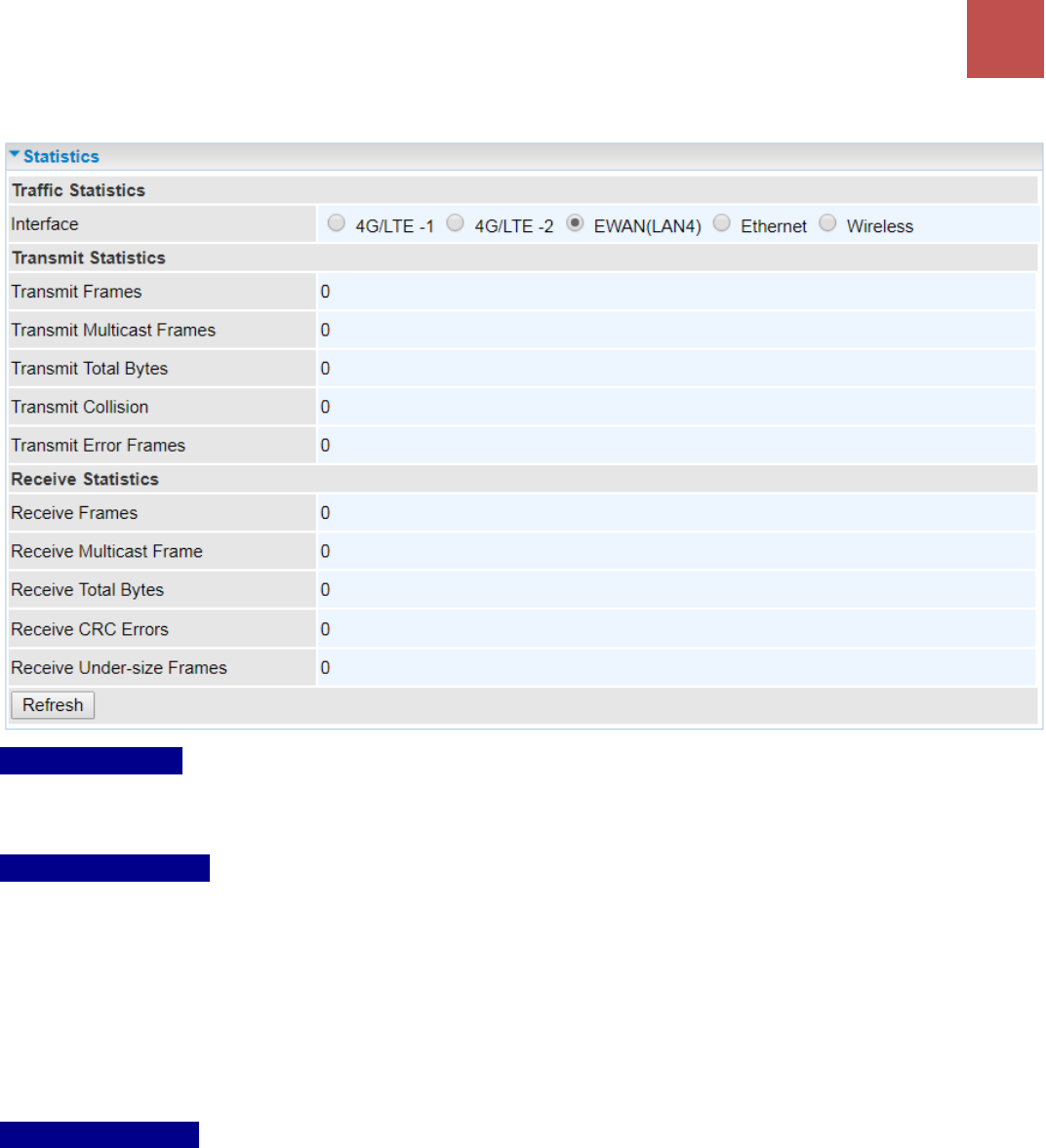
Device Configuration
Status – Statistics (EWAN)
36
BEC MX-1200 Series User Manual
❖ EWAN (LAN Port #4)
Traffic Statistics
Interface: List all available network interfaces in the router. You are currently checking on the physical
status of the EWAN port.
Transmit Statistics
Transmit Frames: Display the total number of frames transmitted until the latest second.
Transmit Multicast Frames: Display the total number of multicast frames transmitted till the latest
second.
Transmit Total Bytes: Display the total number of bytes transmitted until the latest second.
Transmit Collision: Numbers of collisions have occurred on this port.
Transmit Error Frames: Display the number of error packets on this port.
Receive Statistics
Receive Frames: Display the number of frames received until the latest second.
Receive Multicast Frames: Display the number of multicast frames received until the latest second.
Receive Total Bytes: Display the number of bytes received until the latest second.
Receive CRC Errors: Display the number of error packets on this port.
Receive Under-size Frames: Display the number of under-size frames received until the latest
second.
Refresh: Click to refresh this page.
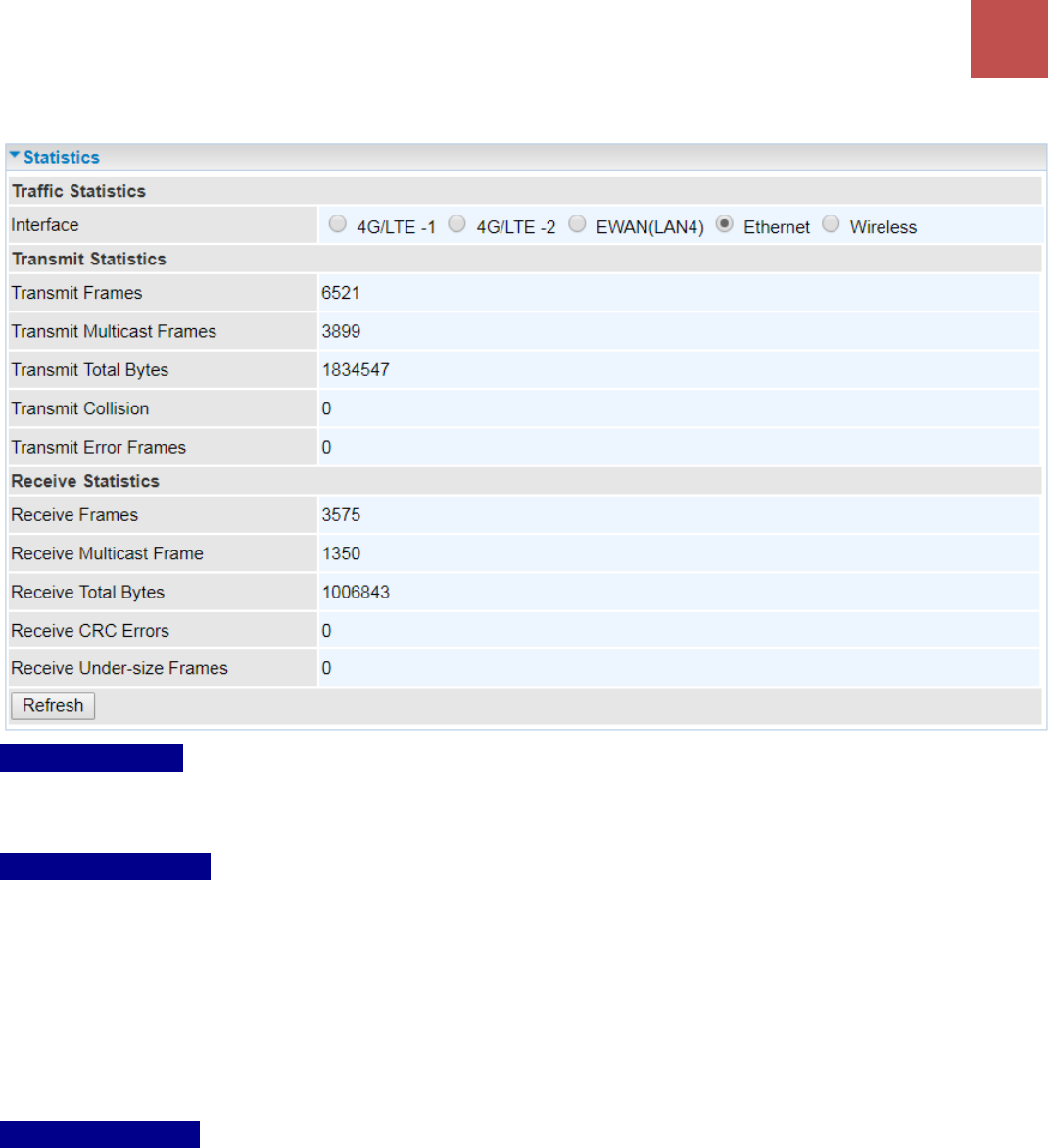
Device Configuration
Status – Statistics (Ethernet)
37
BEC MX-1200 Series User Manual
❖ Ethernet
Traffic Statistics
Interface: List all available network interfaces in the router. You are currently checking on the physical
status of the Ethernet port.
Transmit Statistics
Transmit Frames: Display the number of frames transmitted until the latest second.
Transmit Multicast Frames: Display the number of multicast frames transmitted until the latest
second.
Transmit Total Bytes: Display the number of bytes transmitted until the latest second.
Transmit Collision: Numbers of collisions have occurred on this port.
Transmit Error Frames: Display the number of error packets on this port.
Receive Statistics
Receive Frames: Display the number of frames received until the latest second.
Receive Multicast Frames: Display the number of multicast frames received until the latest second.
Receive Total Bytes: Display s the number of bytes received until the latest second.
Receive CRC Errors: Display the number of error packets on this port.
Receive Under-size Frames: Display the number of under-size frames received until the latest
second.
Refresh: Click to refresh this page.
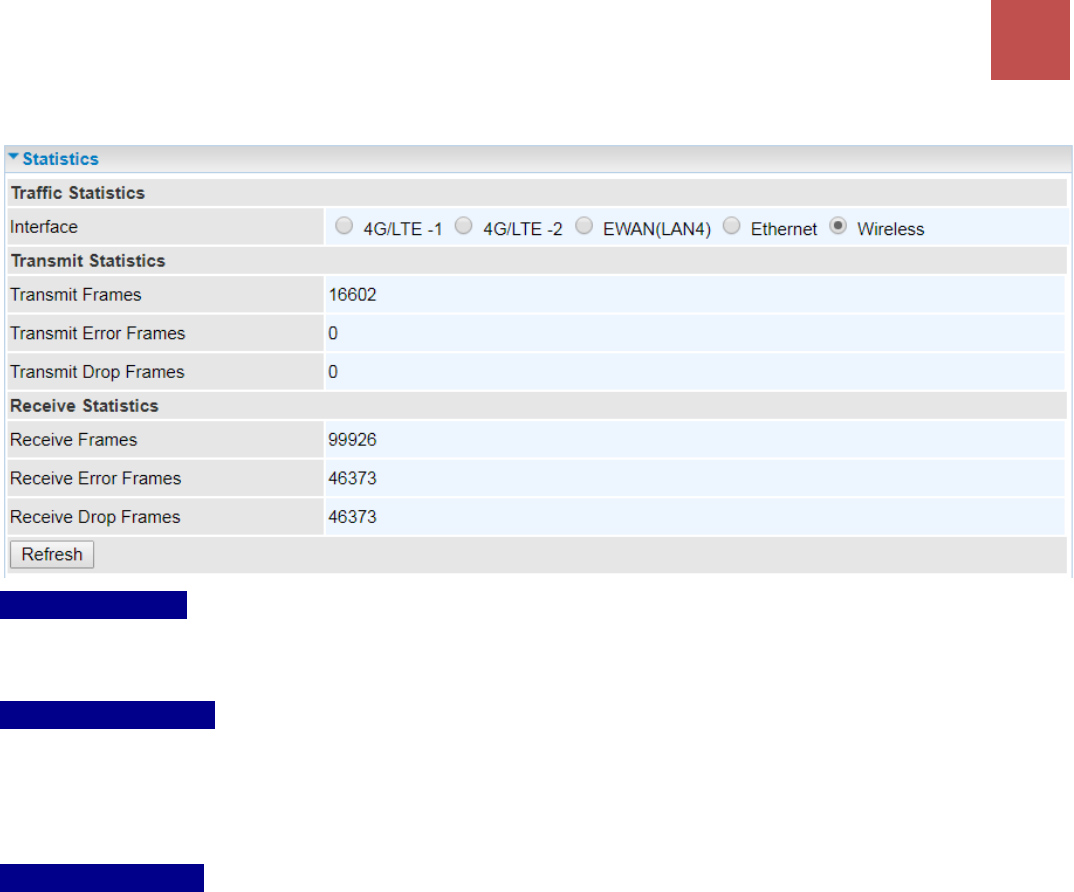
Device Configuration
Status – Statistics (Wireless)
38
BEC MX-1200 Series User Manual
❖ Wireless
Traffic Statistics
Interface: List all available network interfaces in the router. You are currently checking on the physical
status of the Wireless.
Transmit Statistics
Transmit Frames: Display the number of frames transmitted until the latest second.
Transmit Error Frames: Display the number of error frames transmitted until the latest second.
Transmit Drop Frames: Display the number of drop frames transmitted until the latest second.
Receive Statistics
Receive Frames: Display the number of frames received until the latest second.
Receive Error Frames: Display the number of error frames received until the latest second.
Receive Drop Frames: Display the number of drop frames received until the latest second.
Refresh: Click to refresh this page.
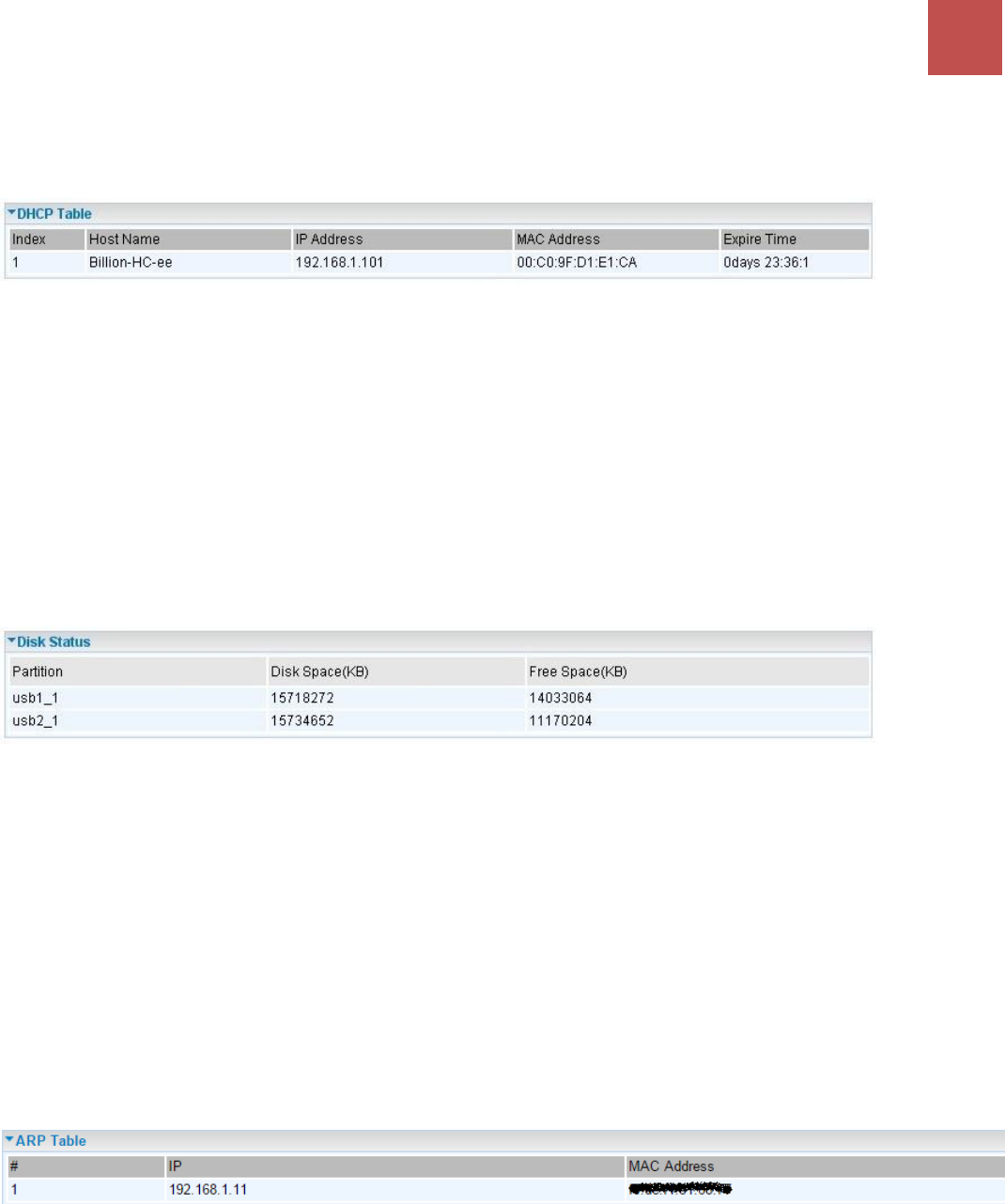
Device Configuration
Status – DHCP Table / Disc Status / ARP Table
39
BEC MX-1200 Series User Manual
DHCP Table
DHCP table displays the devices connected to the router with clear information.
Index #: The numeric indicator for devices using dynamic IP addresses.
Host Name: Show the hostname of the PC.
IP Address: The IP allocated to the device.
MAC Address: The MAC of the connected device.
Expire Time: The total remaining interval since the IP assignment to the PC.
Disk Status
Partition: Display the USB storage partition.
Disk Space (KB): Display the total storage space of the NAS in Kbytes unit.
Free Space (KB): Display the available space in Kbytes unit.
ARP Table
This section displays the router’s ARP (Address Resolution Protocol) Table, which shows the mapping
of Internet (IP) addresses to Ethernet (MAC) addresses. This is useful as a quick way of determining
the MAC address of the network interface of your PCs to use with the router’s Firewall - MAC Address
Filter function. See the Firewall section of this manual for more information on this feature.
Index #: The numeric indicator for the ARP table.
IP Address: It is IP Address of internal host that join this network.
MAC Address: The MAC address of internal host.

Device Configuration
Status – ARP Table
40
BEC MX-1200 Series User Manual
VRRP Status
Current Status: Display current VRRP status, Master or Backup.
Current Master: Display the IP address of the Master.
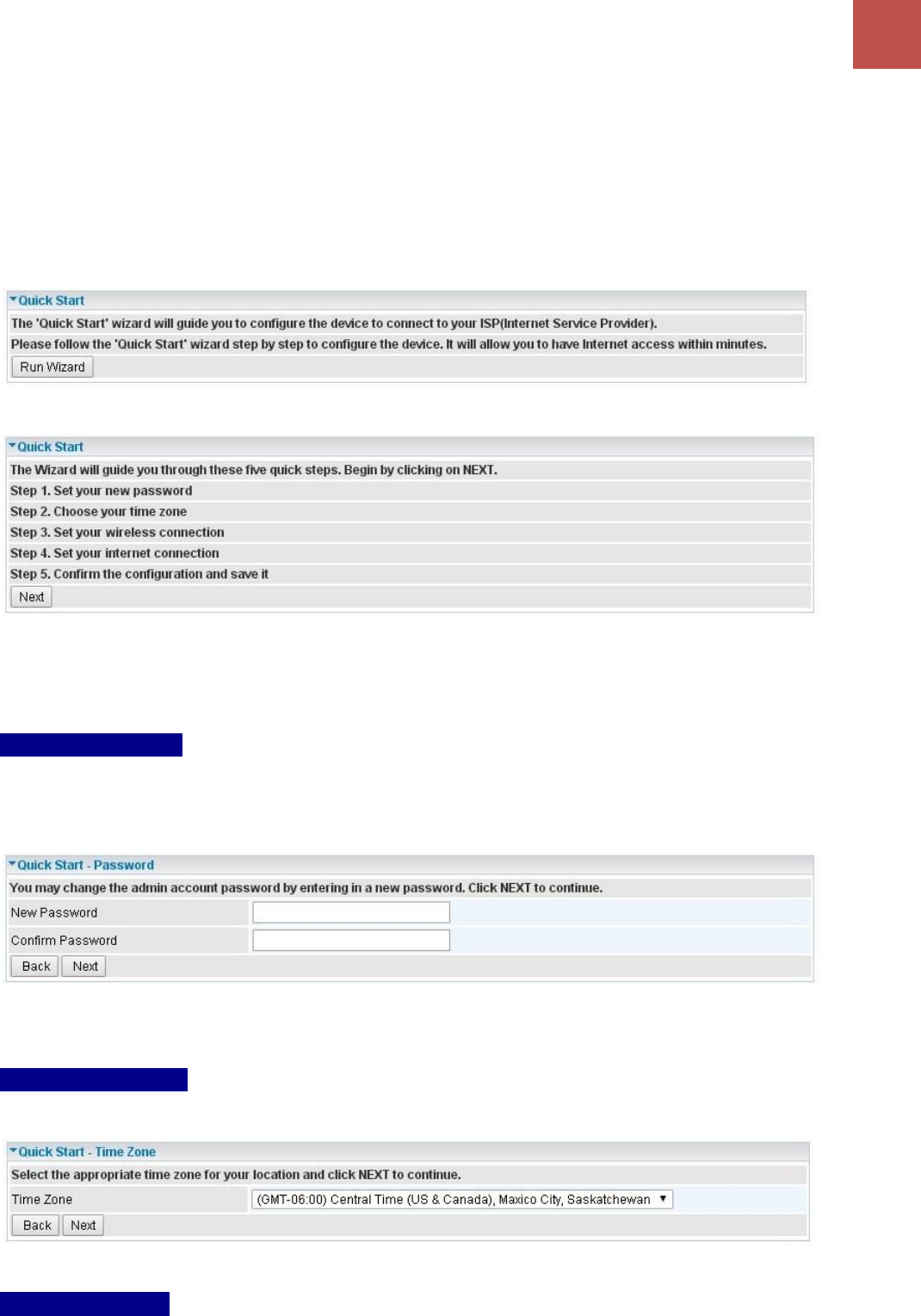
Device Configuration
Quick Start
41
BEC MX-1200 Series User Manual
Quick Start
This is a useful and easy utility to help you to setup the router quickly and to connect to your ISP
(Internet Service Provider) with only a few steps. It will guide you step by step to setup password, time
zone, wireless, and WAN settings of your device. The Quick Start Wizard is a helpful guide for the
first-time users to the device.
For detailed instructions on configuring WAN settings, see refer to the Interface Setup section.
Click NEXT to move on to Step 1.
Step 1 – Password
Set new password of the “admin” account to access for router management. The default is “admin”.
Once changed, please use this new password next time when accessing to the router. Click NEXT to
continue.
Step 2 – Time Zone
Choose your time zone. Click NEXT to continue.
Step 3 – Wireless
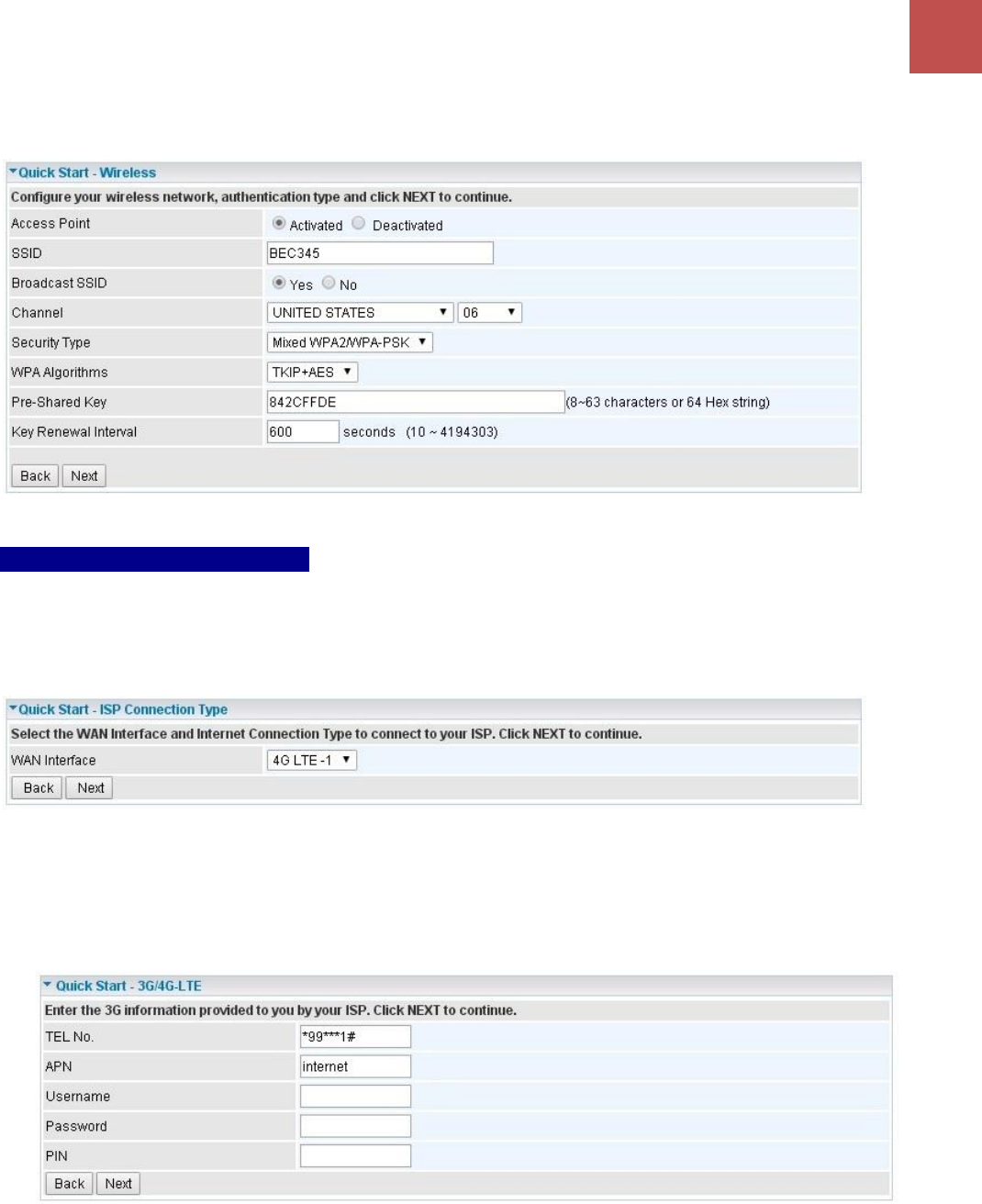
Device Configuration
Quick Start
42
BEC MX-1200 Series User Manual
Set up your wireless connection if you want to connect to the Internet wirelessly on your PCs. Click
NEXT to continue.
Step 4 – ISP Connection Type
Set up your 3G/4G-LTE Internet connection.
4.1 Select an appropriate WAN connection protocol then click NEXT to continue.
4.2(1) If selected 4G LTE-1 or 4G LTE-2
Input all relevant 3G/4G-LTE parameters from your ISP.
Click Next to continue.
4.2(2) If selected EWAN / PPPoE, please enter PPPoE account information provided by your ISP.
Click NEXT to continue.
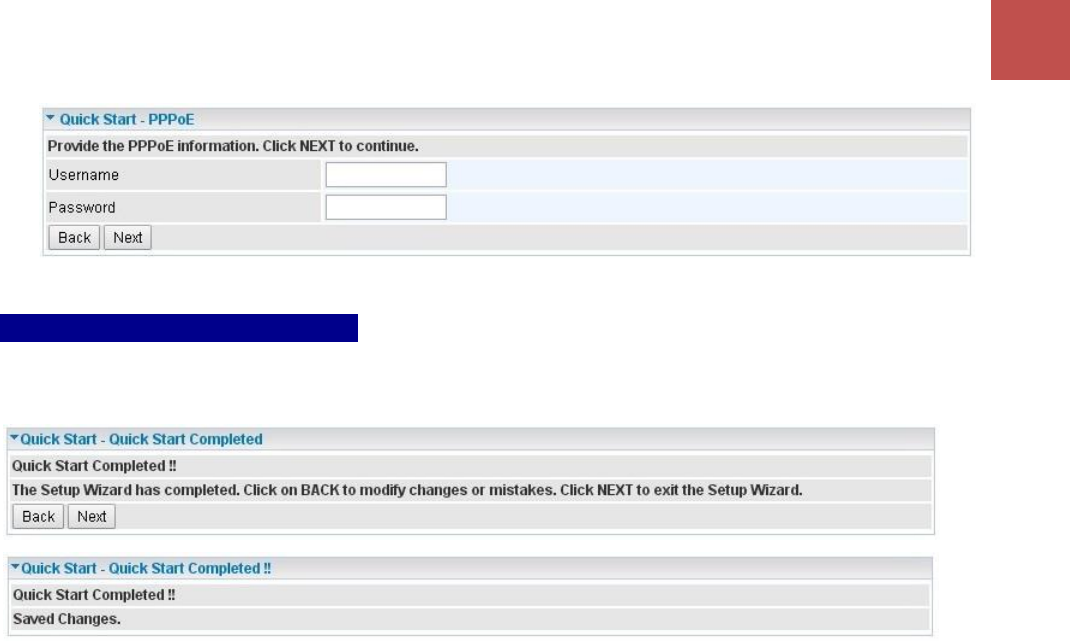
Device Configuration
Quick Start
43
BEC MX-1200 Series User Manual
Step 5 – Quick Start Completed
The Setup Wizard has completed. Click on BACK to make changes or correct mistakes. Click NEXT
to save the current settings and complete the Quick Start setups.
Go back to the Status > Device Info to view the status.
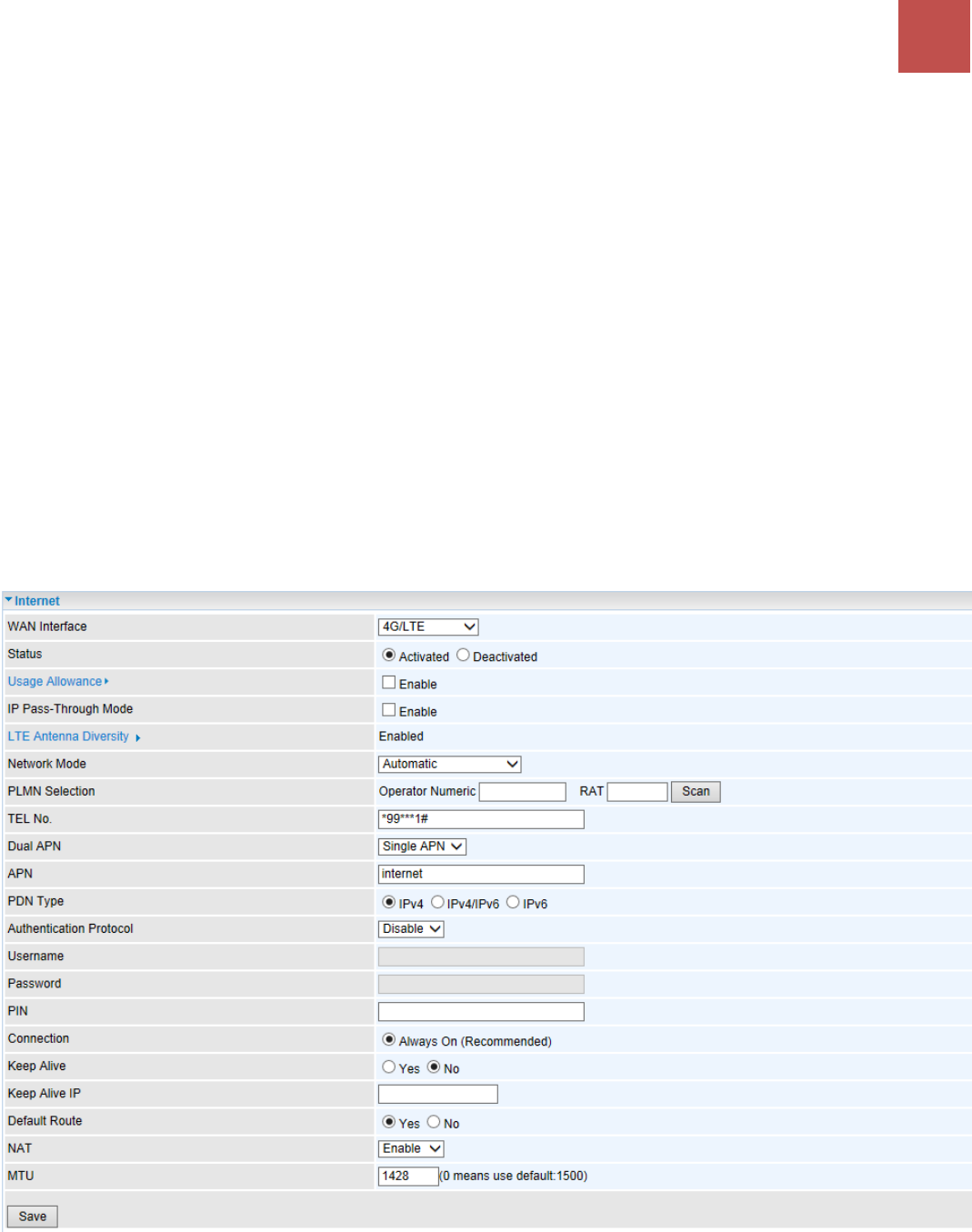
Device Configuration
Interface Setup – Internet (3G/4G-LTE)
44
BEC MX-1200 Series User Manual
Configuration
Click to access and configure the available features in the following: Interface Setup, Dual WAN,
Hotspot, Advanced Setup, Access Management, and Maintenance.
These functions are described in the following sections.
Interface Setup
Here are the features under Interface Setup: Internet, LAN, Wireless, and Wireless MAC Filter
Internet
❖ 3G/4G-LTE
Status: Choose Activated to enable the 3G/4G-LTE connection.
IP Pass-Through Mode: When enabled, MX-1200 is in bridge mode and will not obtain a WAN IP
address, features such as routing capabilities, NAT, firewall, etc., will be disabled by default. However,
the client router behind the MX-1200 can get a WAN IP address instead.
When disabled, MX-1200 is in router mode that it handles a WAN IP address and all routing-related
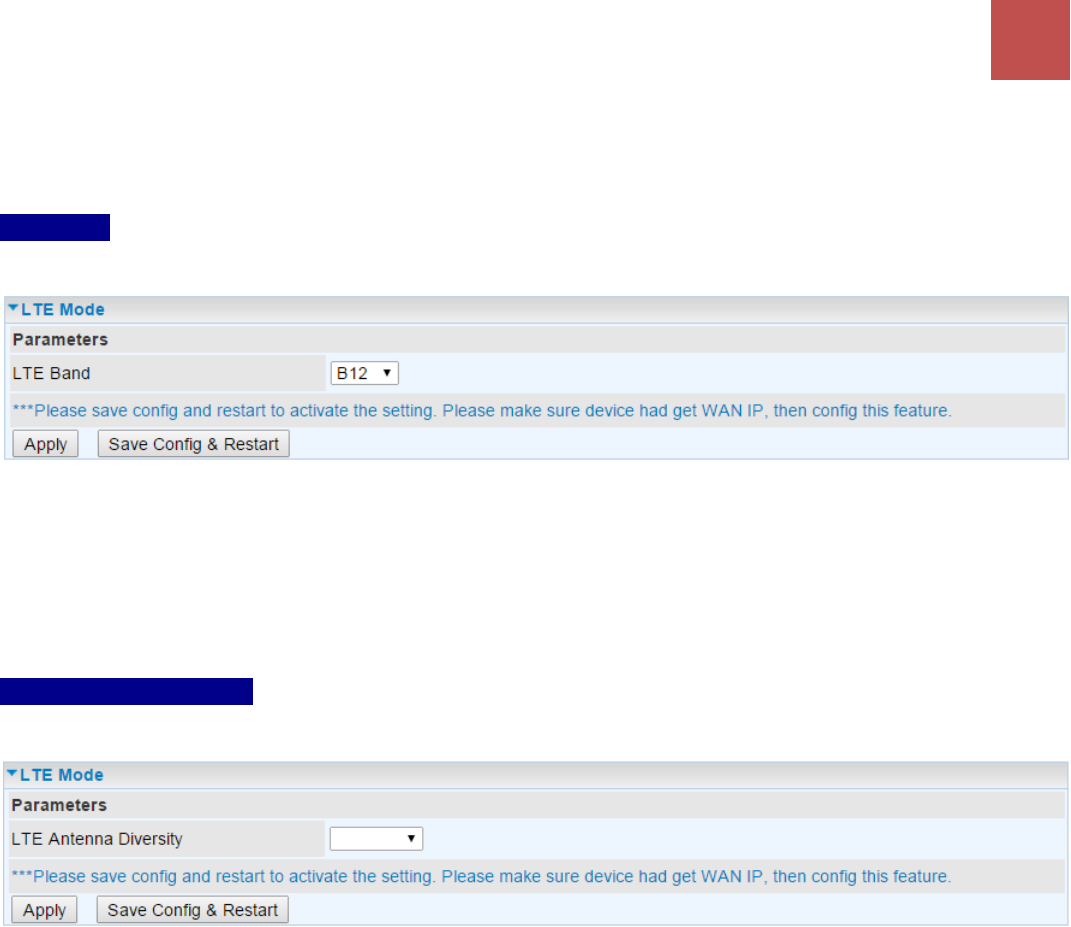
Device Configuration
Interface Setup – Internet (3G/4G-LTE)
45
BEC MX-1200 Series User Manual
features become available.
LTE Mode (This feature is not supported in some LTE modules): Display current selected LTE
frequency band. To change the band, please click “LTE Band” to access to the band selection page.
LTE Band
LTE Band: A list of available LTE bands to choose from.
LTE Antenna Diversity (This feature is not supported in some LTE modules): When enabled, the
auxiliary antenna will be activated. With disabled, only the primary antenna is receiving and
transmitting data.
To change it, please click “LTE Antenna Diversity” to access to the LTE antenna diversity selection
page.
NOTE: When using Yagi antenna, please DISABLE the Antenna Diversity feature for utmost performance.
LTE Antenna Diversity
To enable or disable the LTE antenna diversity feature.
PLMN (Public Land Mobile Network) Selection: Either manually enter the information or click Scan
button to scanning all closest base stations in the area.
TEL No.: The dial string to make a GPRS / 3G/4G-LTE user internetworking call. It may provide by
your mobile service provider.
Dual APN*: MX-1200 can support up to two (2) APNs. Select Single / Dual or a different LTE/3G
APN.
APN (3G): If select LTE/3G with different APN, enter the APN here.
* Feature is available with specific cellular module
APN: An APN is similar to a URL on the WWW, it is what the unit makes a GPRS / UMTS call. The
service provider is able to attach anything to an APN to create a data connection, requirements for
APNs varies between different service providers. Most service providers have an internet portal which
they use to connect to a DHCP Server, thus giving you access to the internet i.e. some 3G operators
use the APN ‘internet’ for their portal. The default value is “internet”.
PDN Type: The IP type for PDN connections. Available types are IPv4, IPv6, and IPv4v6.
Username/Password: Enter the username and password provided by your service provider. The
username and password are case sensitive.
PIN: PIN stands for Personal Identification Number. A PIN code is a numeric value used in certain
systems as a password to gain access, and authenticate. In mobile phones a PIN code locks the SIM

Device Configuration
Interface Setup – Internet (3G/4G-LTE)
46
BEC MX-1200 Series User Manual
card until you enter the correct code. If you enter the PIN code incorrectly into the phone 3 times in a
row, then the SIM card will be blocked and you will require a PUK code from your network/service
provider.
Connection: Default set to Always on to keep an always-on 3G/4G-LTE connection.
Keep Alive: Select Yes to keep the 3G/4G-LTE connection always on.
Keep Alive IP: Enter the IP address that the router can ping the IP to find whether the connection is
on or not, if not, router will recover the connection.
Default Route: Select Yes to use this interface as default route interface.
NAT: Select this option to Disabled/Enable the NAT (Network Address Translation) function. Enable
NAT to grant multiples devices in LAN to access to the Internet through a single WAN IP.
MTU: Enter the maximum packet that can be transmitted. Default MTU 0 means it is set to 1500 bytes.
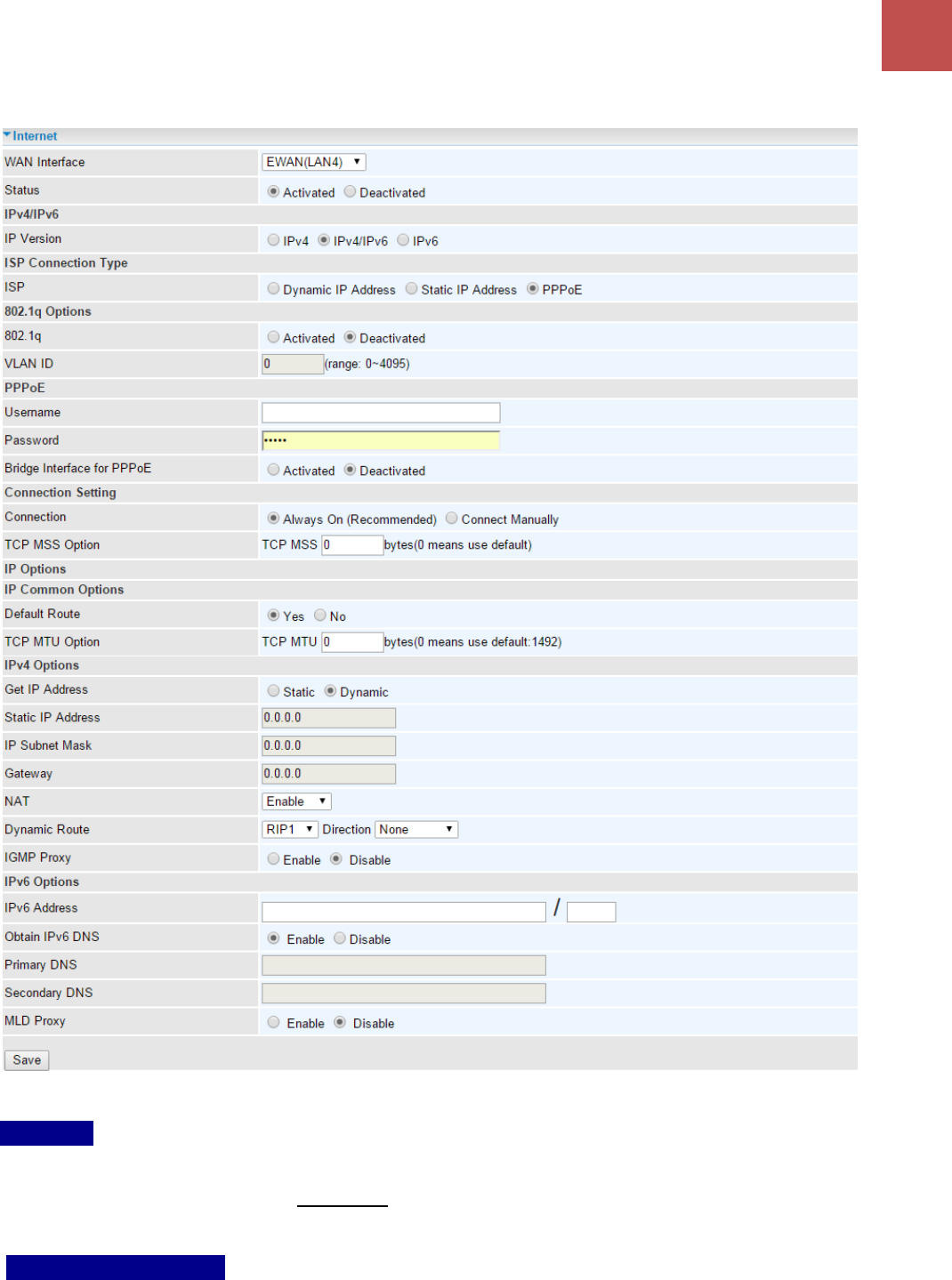
Device Configuration
Interface Setup – Internet (EWAN)
47
BEC MX-1200 Series User Manual
❖ EWAN (LAN # 4)
Status: Select to enable or disable the service.
IPv4/IPv6
IP Version: Choose IPv4, IPv4/IPv6, or IPv6 based on your environment. If you don’t know which one
to choose from, please choose IPv4/IPv6 instead.
ISP Connection Type:
ISP: Select the encapsulation type your ISP uses.
Dynamic IP: Select this option if your ISP provides you an IP address automatically.

Device Configuration
Interface Setup – Internet (EWAN)
48
BEC MX-1200 Series User Manual
Static IP: Select this option to set static IP information. You will need to enter in the Connection
type, IP address, subnet mask, and gateway address, provided to you by your ISP. Each IP
address entered in the fields must be in the appropriate IP form. IP address from by four IP
octets separated by a dot (xx.xx.xx.xx). The Router will not accept the IP address if it is not in
this format.
PPPoE: Select this option if your ISP requires you to use a PPPoE connection.
802.1q Options
802.1q: When activated, please enter a VLAN ID.
VLAN ID: It is a parameter to specify the VLAN which the frame belongs. Enter the VLAN ID
identification, tagged: 0-4095.
PPPoE (If selected PPPoE as WAN Connection Type; otherwise, skip this part)
Username: Enter the user name provided by your ISP.
Password: Enter the password provided by your ISP.
Bridge Interface for PPPoE: When “Activated”, the device will gain WAN IP from your ISP with the
PPPoE account. But if your PC is connected to the router working as a DHCP client, in this mode, the
device acts as a NAT router; while if you dial up with the account within your PC, the device will then
work as a bridge forwarding the PPPoE information to the PPPoE server and send the response to
your PC, thus your PC gets a WAN IP working in the internet.
Connection Setting
Connection:
Always On: Click on Always On to establish a PPPoE session during start up and to
automatically re-establish the PPPoE session when disconnected by the ISP.
Connect Manually: Select Connect Manually when you don't want the connection up all the
time.
TCP MSS Option: Enter the maximum size of the data that TCP can send in a segment. Maximum
Segment Size (MSS).
IP Options – next pages
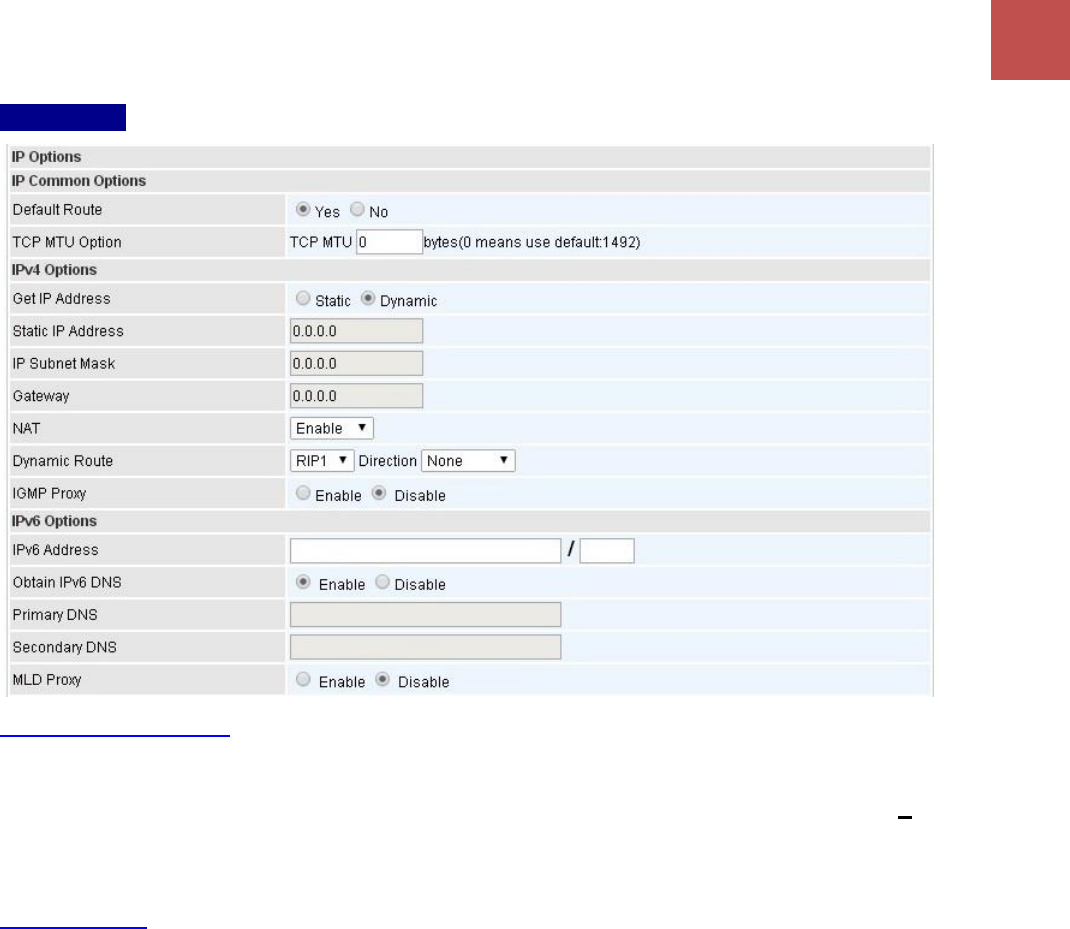
Device Configuration
Interface Setup – Internet (EWAN)
49
BEC MX-1200 Series User Manual
IP Options s
IP Common Options
Default Route: Select Yes to use this interface as default route interface.
TCP MTU Option: Enter the maximum packet that can be transmitted. Default MTU 0 means it is set
to 1492 bytes.
IPv4 Options
Get IP Address: Choose Static or Dynamic
Static IP Address: If Static is selected in the above field, please enter the specific IP address you get
from ISP and the following IP subnet mask and gateway address.
IP Subnet Mask: The default is 0.0.0.0. User can change it to other such as 255.255.255.0.Type the
subnet mask assigned to you by your ISP (if given).
Gateway: Enter the specific gateway IP address you get from ISP.
NAT: Enable to allow MX-1200 to assign private network IPs to all devices in the network for get
Internet access.
Dynamic Route:
RIP Version: (Routing Information protocol) Select this option to specify the RIP version,
including RIP-1, RIP-2.
RIP Direction: Select this option to specify the RIP direction.
- None is for disabling the RIP function.
- Both means the router will periodically send routing information and accept routing
information then incorporate into routing table.
- IN only means the router will only accept but will not send RIP packet.

Device Configuration
Interface Setup – Internet (EWAN)
50
BEC MX-1200 Series User Manual
- OUT only means the router will only send but will not accept RIP packet.
IGMP Proxy: IGMP (Internet Group Multicast Protocol) is a network-layer protocol used to establish
membership in a Multicast group. Choose whether enable IGMP proxy.
IPv6 options (only when choose IPv4/IPv6 or just IPv6 in IP version field above):
IPv6 Address: Type the WAN IPv6 address from your ISP.
Obtain IPv6 DNS: Choose if you want to obtain DNS automatically.
Primary/Secondary: if you choose Disable in the Obtain IPv6 DNS field, please type the exactly
primary and secondary DNS.
MLD Proxy: MLD (Multicast Listener Discovery Protocol) is to IPv6 just as IGMP to IPv4. It is a
Multicast Management protocol for IPv6 multicast packets.
When router’s Internet configuration is finished successfully, you can go to status to get the connection
information.
Click Save to apply the settings.
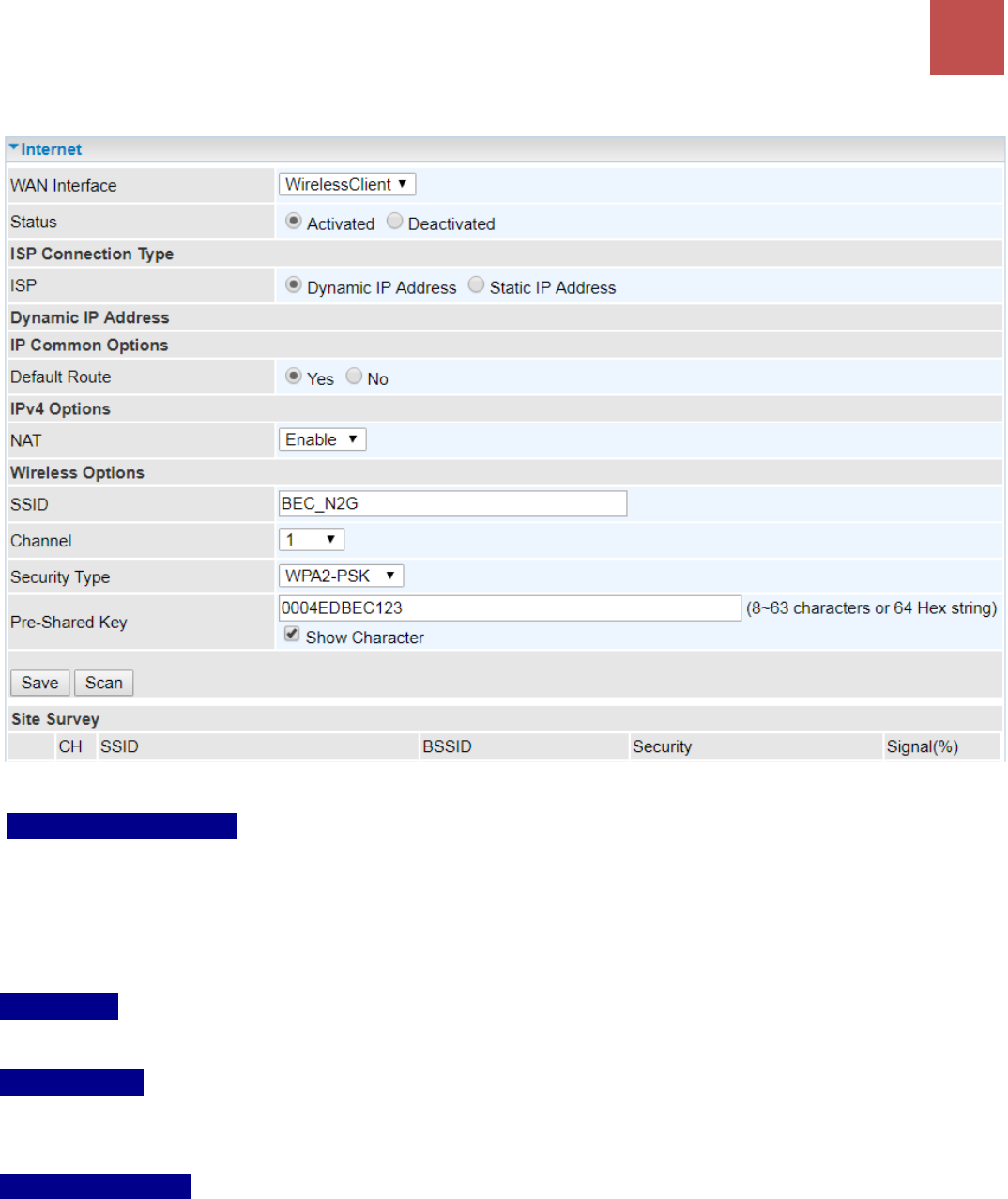
Device Configuration
Interface Setup – Internet (Wireless Client)
51
BEC MX-1200 Series User Manual
❖ Wireless Client
Status: Select to enable or disable the service.
ISP Connection Type:
ISP: Select the encapsulation type your ISP uses.
Dynamic IP: Select this option to get an assigned IP address automatically from a Wi-Fi AP
unit.
Static IP: Select to enter the access IP address manually.
IP Options s
Default Route: Select Yes to use this interface as default route interface.
IPv4 Options s
NAT: Enable to allow MX-1200 to assign private network IPs to all devices in the network for get
Internet access.
Wireless Options s
Enter the basic information of the Wireless base station.
SSID / Channel / Pre-Shared Key: Enter the SSID, Wi-Fi channel, and Pre-shared key of the wireless
station to provide the Internet access.
Scan: Click Scan button to search all available and active wireless stations (AP) around the area, and
then choose the desired AP. The SSID and Channel will be filled automatically
Click Save to apply the settings.
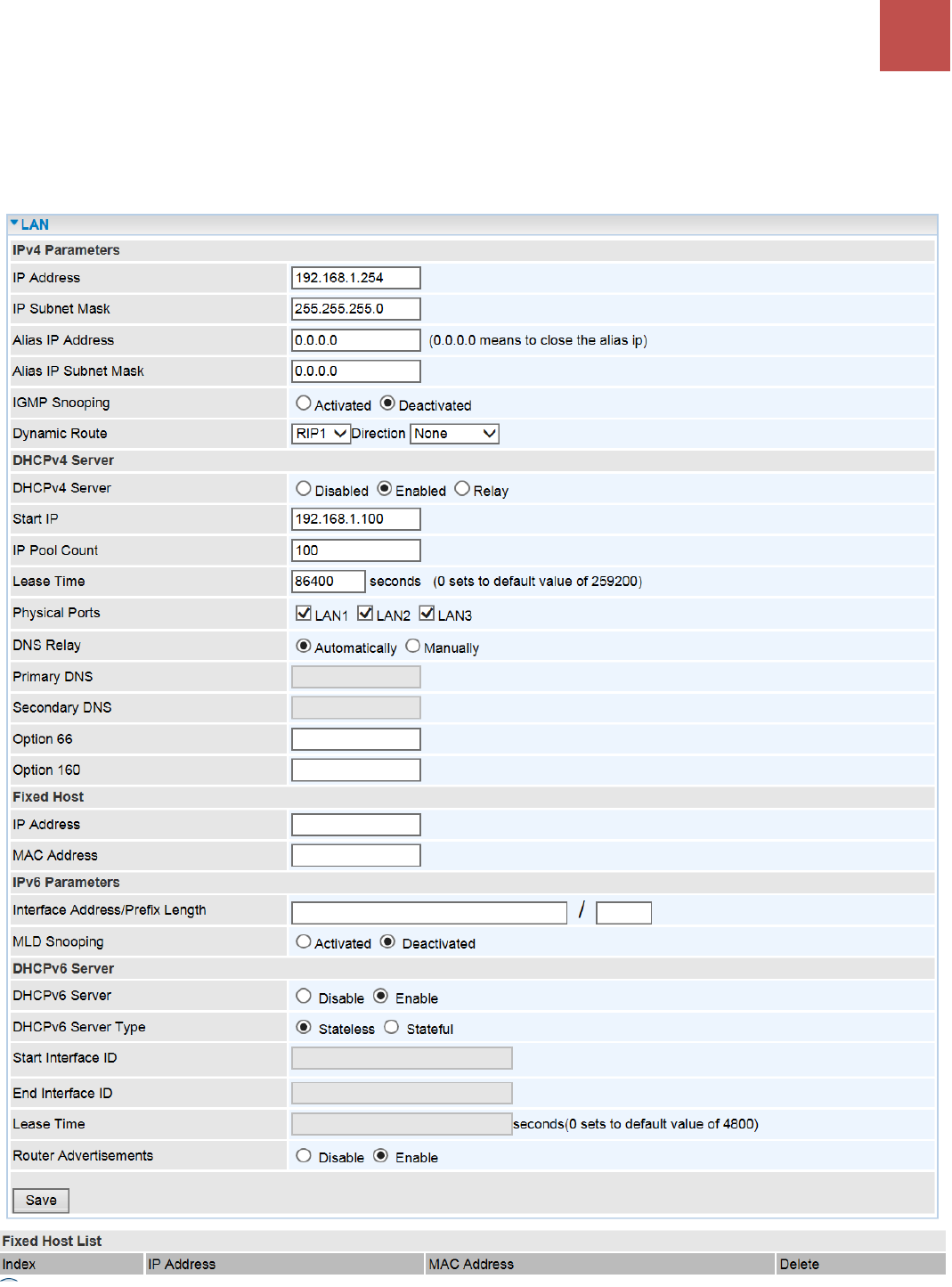
Device Configuration
Interface Setup – LAN
52
BEC MX-1200 Series User Manual
LAN
A Local Area Network (LAN) is a shared communication system to which many computers are attached
and is limited to the immediate area, usually the same building or floor of a building.
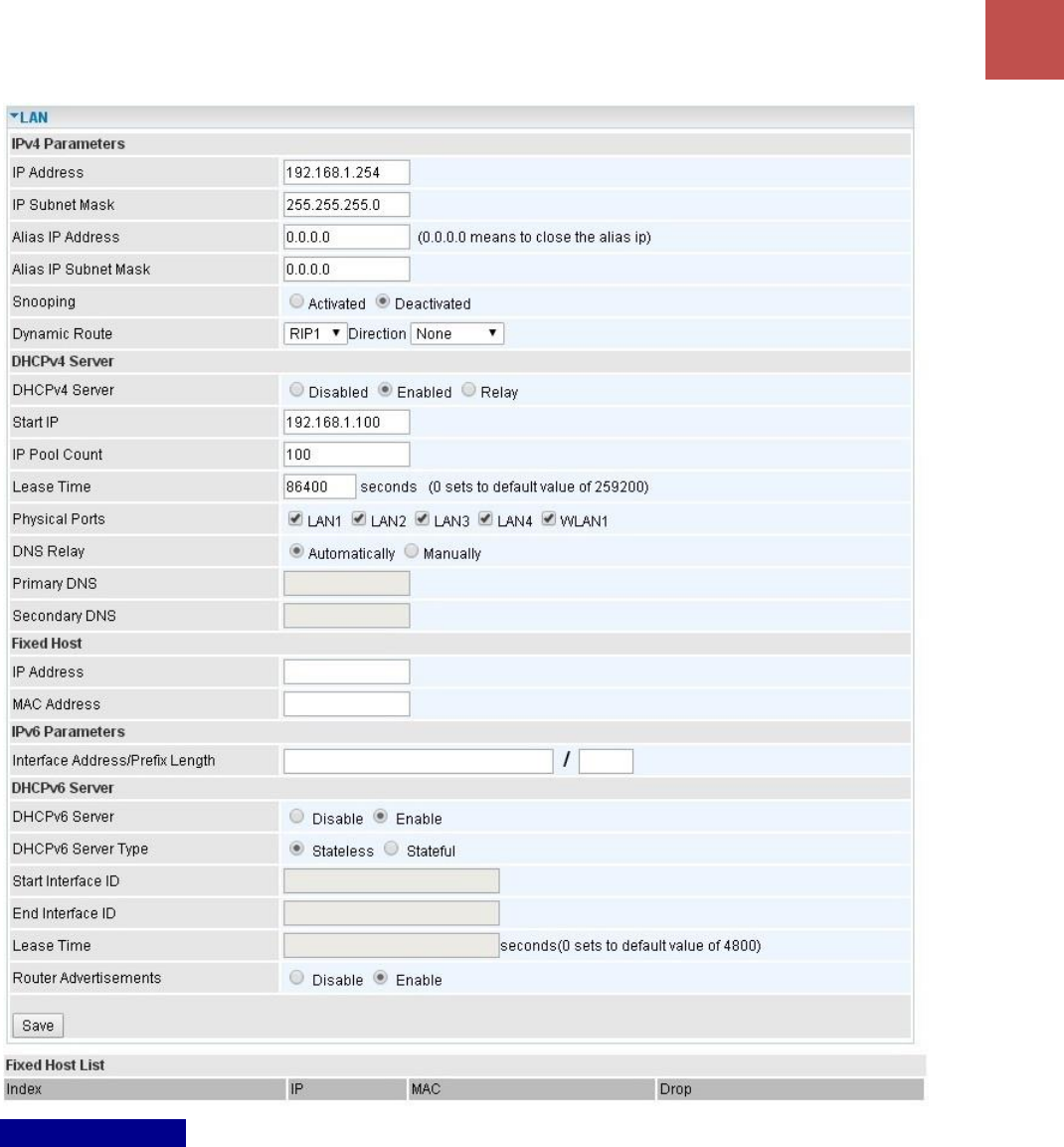
Device Configuration
Interface Setup – LAN
53
BEC MX-1200 Series User Manual
IPv4 Parameters
IP Address: Enter the IP address of Router in dotted decimal notation, for example, 192.168.1.254
(factory default).
IP Subnet Mask: The default is 255.255.255.0. User can change it to other such as 255.255.255.128.
Alias IP Address: This is for local networks virtual IP interface. Specify an IP address on this virtual
interface.
Alias IP Subnet Mask: Specify a subnet mask on this virtual interface.
IGMP Snooping: Select Activated to enable IGMP Snooping function, Without IGMP snooping,
multicast traffic is treated in the same manner as broadcast traffic - that is, it is forwarded to all ports.
With IGMP snooping, multicast traffic of a group is only forwarded to ports that have members of that
group.
Dynamic Route:
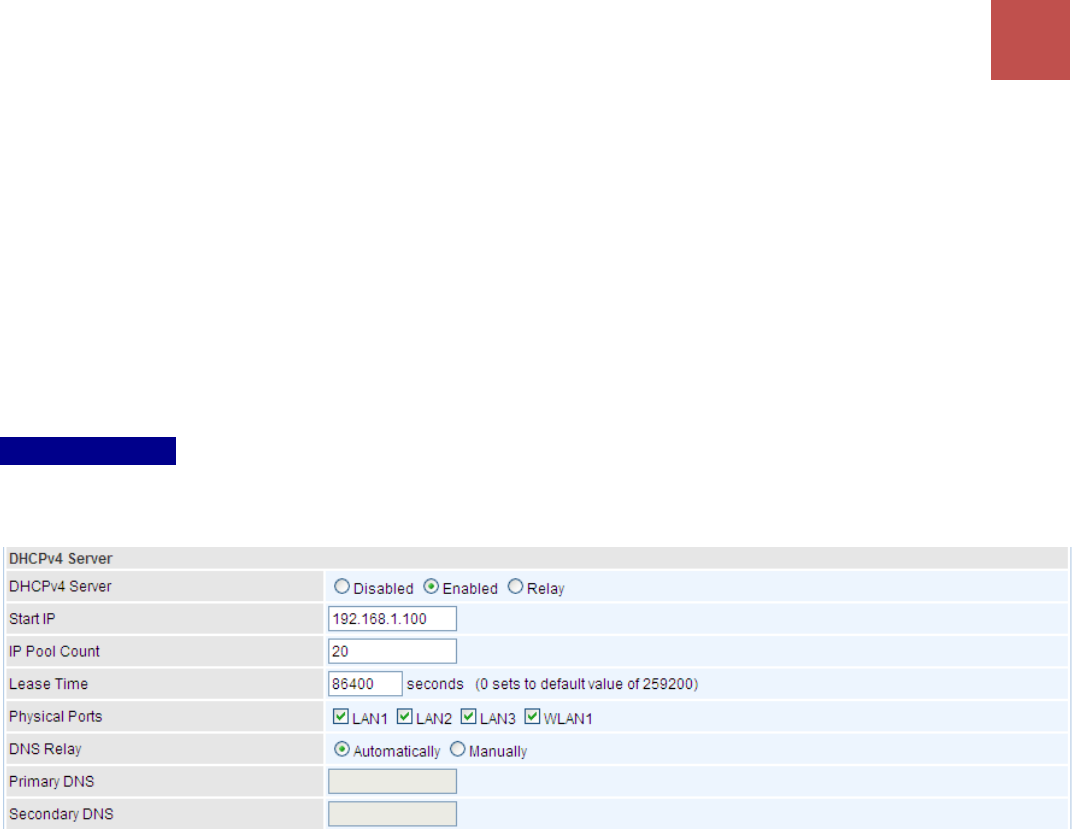
Device Configuration
Interface Setup – LAN
54
BEC MX-1200 Series User Manual
RIP Version: (Routing Information protocol) Select this option to specify the RIP version,
including RIP-1, RIP-2.
RIP Direction: Select this option to specify the RIP direction.
- None is for disabling the RIP function.
- Both means the router will periodically send routing information and accept routing
information then incorporate into routing table.
- IN only means the router will only accept but will not send RIP packet.
- OUT only means the router will only send but will not accept RIP packet.
DHCPv4 Server
DHCP (Dynamic Host Configuration Protocol) allows individual clients to obtain TCP/IP configuration
at start-up from a server.
DHCPv4 Server: If set to Enabled, your MX-1200 can assign IP addresses, default gateway and DNS
servers to the DHCP client.
If set to Disabled, the DHCP server will be disabled.
If set to Relay, the MX-1200 acts as a surrogate DHCP server and relays DHCP requests and
responses between the remote server and the clients. Enter the IP address of the actual, remote
DHCP server in the Remote DHCP Server field in this case.
When DHCP is used, the following items need to be set.
Start IP: This field specifies the first of the contiguous addresses in the IP address pool.
IP Pool Count: This field specifies the count of the IP address pool.
Lease Time: The current lease time of client.
Physical Ports: Select to determine if the DHCPv4 server is applicable to the specific port or ports.
By default, all ports can obtain local IP from DHCPv4 server.
DNS Relay:
Select Automatic detection or
Manually specific Primary and Secondary DNS IP addresses
Primary / Secondary DNS Server: Enter the IP addresses of the DNS servers. The DNS servers are
passed to the DHCP clients along with the IP address and the subnet mask.
Option 66: Set the IP or hostname of the TFTP server for devices, like IPTV Set Box, to get
configuration settings from the TFTP server.
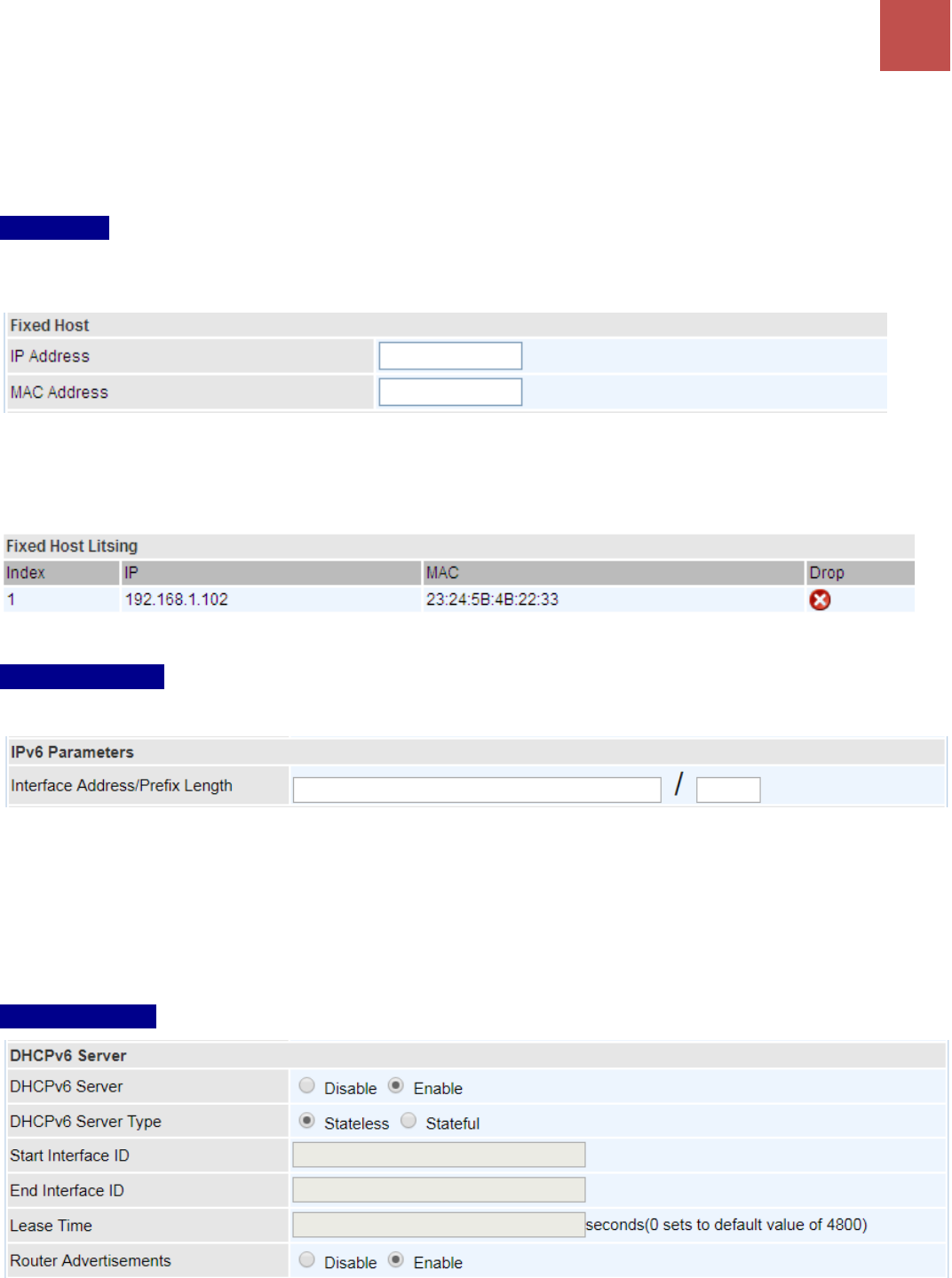
Device Configuration
Interface Setup – LAN
55
BEC MX-1200 Series User Manual
Option 160: Set the IP or hostname of the TFTP server for devices, like IPTV Set Box, to get
configuration settings from the TFTP server. (The option 160 is an extended feature in DHCP option,
similar to option 66, but using http or https protocols.)
Fixed Host
In this field, users can map the specific IP (must in the DHCP IP pool) for some specific MAC, and this
information can be listed in the following table.
IP Address: Enter the specific IP. For example: 192.168.1.110.
MAC Address: Enter the responding MAC. For example: 00:0A:F7:45:6D:ED
When added, you can see the ones listed as showed below:
IPv6 parameters
The IPv6 address composes of two parts, thus, the prefix and the interface ID.
Interface Address / Prefix Length: Enter a static LAN IPv6 address. If you are not sure what to do
with this field, please leave it empty as if contains false information it could result in LAN devices not
being able to access other IPv6 device. Router will take the same WAN’s prefix to LAN side if the field
is empty.
MLD Snooping: Similar to IGMP Snooping, but applicable for IPv6.
DHCPv6 Server
There are two methods to dynamically configure IPv6 address on hosts, Stateless and Stateful.
Stateless auto-configuration requires no manual configuration of hosts, minimal (if any)
configuration of routers, and no additional servers. The stateless mechanism allows a host to generate

Device Configuration
Interface Setup – LAN
56
BEC MX-1200 Series User Manual
its own addresses using a combination of locally available information (MAC address) and information
(prefix) advertised by routers. Routers advertise prefixes that identify the subnet(s) associated with a
link, while hosts generate an "interface identifier" that uniquely identifies an interface on a subnet. An
address is formed by combining the two. When using stateless configuration, you needn’t configure
anything on the client.
Stateful configuration, for example using DHCPv6 (which resembles its counterpart DHCP in IPv4.)
In the stateful auto configuration model, hosts obtain interface addresses and/or configuration
information and parameters from a DHCPv6 server. The Server maintains a database that keeps track
of which addresses have been assigned to which hosts.
DHCPv6 Server: Check whether to enable DHCPv6 server.
DHCPv6 Server Type: Select Stateless or Stateful. When DHCPv6 is enabled, this parameter is
available.
Stateless: If selected, the PCs in LAN are configured through RA mode, thus, the PCs in LAN
are configured through RA mode, to obtain the prefix message and generate an address using
a combination of locally available information (MAC address) and information (prefix) advertised
by routers, but they can obtain such information like DNS from DHCPv6 Server.
Stateful: If selected, the PCs in LAN will be configured like in IPv4 mode, thus obtain addresses
and DNS information from DHCPv6 server.
Start interface ID: enter the start interface ID. The IPv6 address composed of two parts, thus, the
prefix and the interface ID. Interface is like the Host ID compared to IPv4.
End interface ID: enter the end interface ID.
Leased Time (hour): the leased time, similar to leased time in DHCPv4, is a time limit assigned to
clients, when expires, the assigned ID will be recycled and reassigned.
Router Advertisement: Check to Enable or Disable the Issue Router Advertisement feature. This
feature is to send Router Advertisement messages periodically which would multicast the IPv6 Prefix
information (similar to v4 network number 192.168.1.0) to all LAN devices if the field is enabled. We
suggest enabling this field.
Click Save to apply settings.
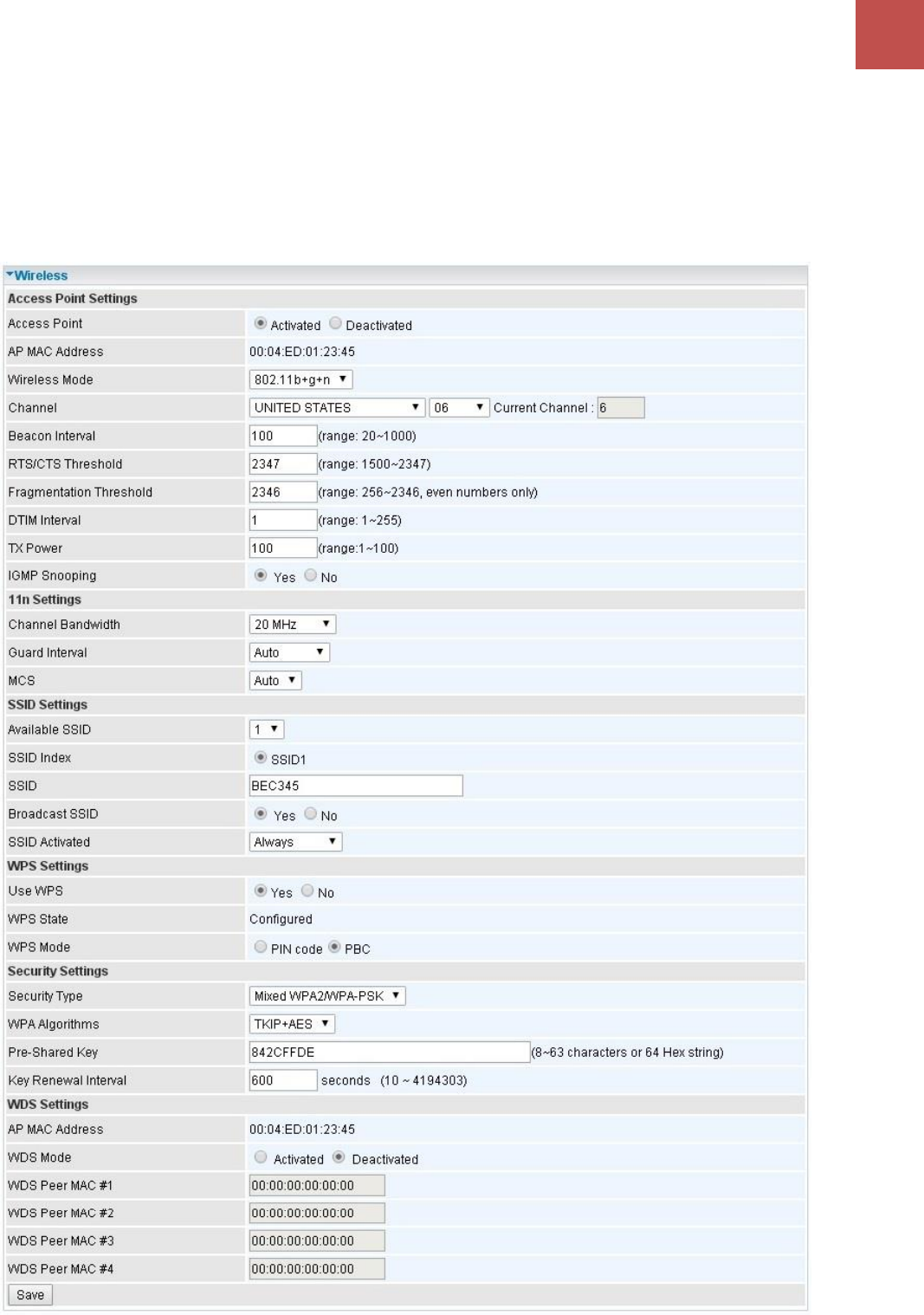
Device Configuration
Interface Setup – Wireless
57
BEC MX-1200 Series User Manual
Wireless
This section introduces the wireless LAN and some basic configurations. Wireless LANs can be as
complex as a number of computers with wireless LAN cards communicating through access points
which bridge network traffic to the wired LAN.
NOTE: WLAN1 / 2 / 3 / 4 Interface refers to as SSID1 / 2 / 3 / 4 Wi-Fi networks.
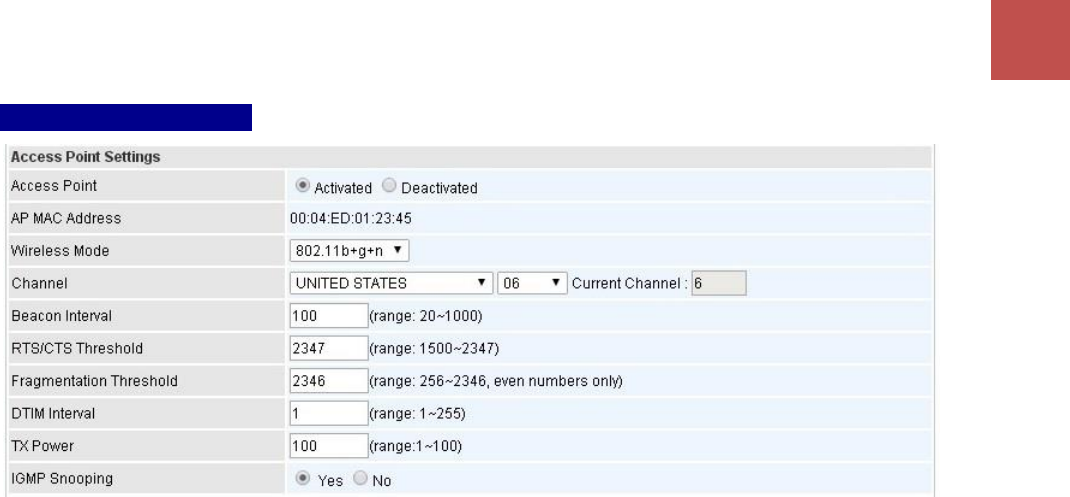
Device Configuration
Interface Setup – Wireless
58
BEC MX-1200 Series User Manual
Access Point Settings
Access Point: Default setting is set to Activated. If you want to close the wireless interface, select
Deactivated.
AP MAC Address: The MAC address of wireless AP.
Wireless Mode: The default setting is 802.11b+g+n (Mixed mode). If you do not know or have both
11g and 11b devices in your network, then keep the default in mixed mode. From the drop-down
manual, you can select 802.11g if you have only 11g card. If you have only 11b card, then select
802.11b and if you only have 802.11n then select 802.11n.
Channel: The range of radio frequencies used by IEEE 802.11b/g/n wireless devices is called a
channel. There are Regulation Domains and Channel ID in this field. The Channel ID will be different
based on Regulation Domains. Select a channel from the drop-down list box.
Beacon interval: The Beacon Interval value indicates the frequency interval of the beacon. Enter a
value between 20 and 1000. A beacon is a packet broadcast by the Router to synchronize the wireless
network.
RTS/CTS Threshold: The RTS (Request To Send) threshold (number of bytes) for enabling RTS/CTS
handshake. Data with its frame size larger than this value will perform the RTS/CTS handshake. Enter
a value between 1500 and 2347.
Fragmentation Threshold: The threshold (number of bytes) for the fragmentation boundary for
directed messages. It is the maximum data fragment size that can be sent. Enter a value between 256
and 2346, even number only.
DTIM Interval: This value, between 1 and 255, indicates the interval of the Delivery Traffic Indication
Message (DTIM).
TX Power: The transmission power of the antennas, ranging from 1-100, the higher the more powerful
of the transmission performance.
IGMP Snooping: Enable or disable the IGMP Snooping function for wireless. Without IGMP snooping,
multicast traffic is treated in the same manner as broadcast traffic - that is, it is forwarded to all ports.
With IGMP snooping, multicast traffic of a group is only forwarded to ports that have members of that
group.”
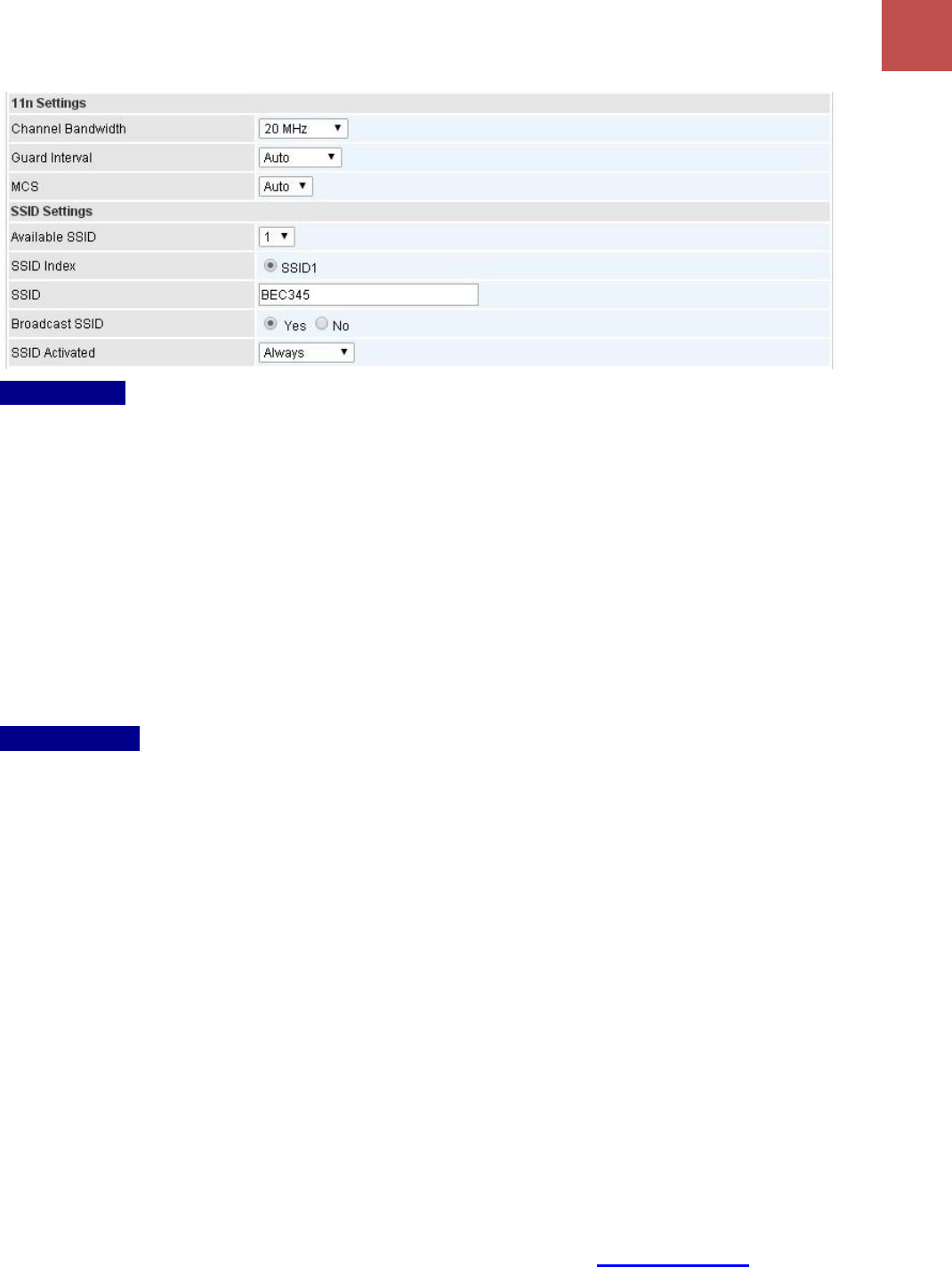
Device Configuration
Interface Setup – Wireless
59
BEC MX-1200 Series User Manual
11n Settings
Channel Bandwidth: Select 20 MHz, 40 MHz, or 20/40 MHz for the channel bandwidth. The wider
the Channel bandwidth the better the performance will be.
Extension Channel: This is for the 20/40MHz clients to use and is predefined to Auto by default.
Guard Interval: Select either 800nsec or Automatic for the guard interval. The guard interval is here
to ensure that data transmission do not interfere with each other. It also prevents propagation delays,
echoing and reflections. The shorter the Guard Interval, the better the performance will be. We
recommend users to select Auto.
MCS (Modulation and Coding Scheme): There are options 0~15 and AUTO to select from. AUTO
is recommended.
SSID Settings
NOTE: SSID1 will reserve for Hotspot when it is enabled.
Available SSID: User can determine how many virtual SSIDs to be used. Default is 1, maximum is 4.
SSID Index: Select the number of SSIDs you want to use; up to 4 SSIDs are available in the list.
SSID1 / Hotspot SSID known as WLAN1 Interface
SSID2 known as WLAN2 Interface
SSID3 known as WLAN4 Interface
SSID4 known as WLAN5 Interface
SSID: The SSID is the unique name of a wireless access point (AP) to be distinguished from another.
For security propose, change the default wlan-ap to a unique ID name to the AP which is already built-
in to the router’s wireless interface. Make sure your wireless clients have exactly the SSID as the
device, in order to get connected to your network.
Broadcast SSID: Select Yes to make the SSID visible so a station can obtain the SSID through
passive scanning. Select No to hide the SSID in so a station cannot obtain the SSID through passive
scanning.
SSID Activated: Select the time period during which the SSID is active. Default is in Always which
means the SSID is active at all time without time control. See Time Schedule to set the timeslot to
flexibly control when the SSID functions.
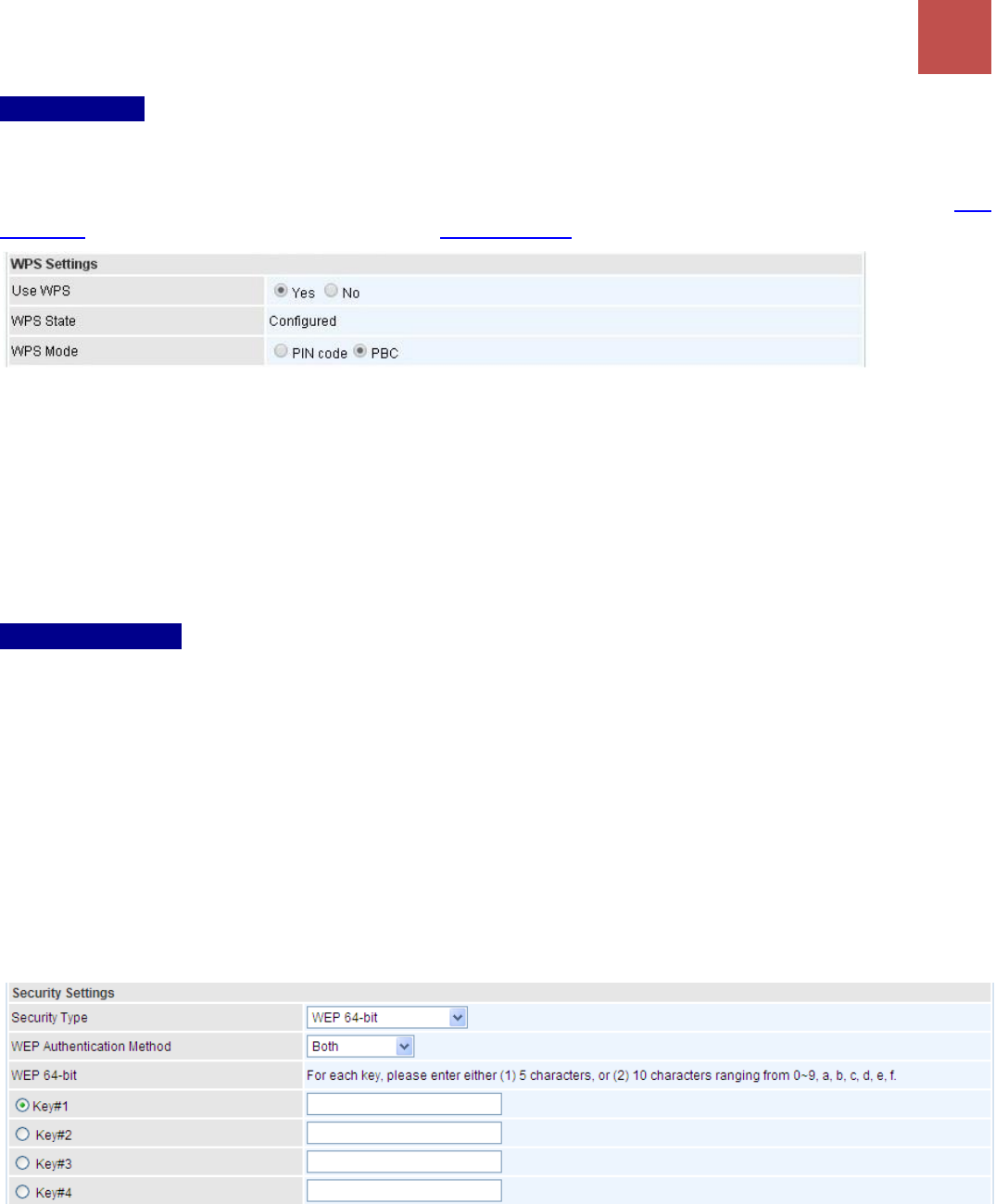
Device Configuration
Interface Setup – Wireless
60
BEC MX-1200 Series User Manual
WPS Settings
WPS (Wi-Fi Protected Setup) feature is a standard protocol created by Wi-Fi Alliance. This feature
greatly simplifies the steps needed to create a Wi-Fi network for a residential or an office setting. WPS
supports 2 types of configuration methods which are commonly known among consumers: PIN
Method (Personal Information Number) & PBC Method (Push Button Configuration).
Use WPS: Enable this feature by choosing “Yes” radio button.
WPS State: Display whether the WPS is configured or unconfigured.
WPS Mode: Select the mode which to start WPS, choose between PIN Code and PBC (Push Button).
Selecting Pin Code mode will require you to know the enrollee PIN code.
To future understand the two modes of configuration; please refer to the example of the Wi-Fi
Protected Setup.
Security Settings
Security Type: You can disable or enable wireless security for protecting wireless network. The default
type of wireless security is OPEN and to allow all wireless stations to communicate with the access
points without any data encryption.
To prevent unauthorized wireless stations from accessing data transmitted over the network, the router
offers secure data encryption, known as WEP and WPA.
There are five alternatives to select from: WEP 64-bit, WEP 128-bit, WPA-PSK, WPA2-PSK, and Mixed
WPA/WPA2-PSK. If you require high security for transmissions, please select WPA-PSK, WPA2-PSK
or WPA/WPA2-PSK.
WEP
WEP Authentication Method: WEP authentication method, there are two methods of authentication
used, Open System authentication (OPENWEB) and Share Key authentication (SHAREDWEB). We
suggest you select OPENWEB.
Key 1 to Key 4: Enter the key to encrypt wireless data. To allow encrypted data transmission, the
WEP Encryption Key values on all wireless stations must be the same as the router. There are four
keys for your selection. The input format is in HEX style, 5 and 13 HEX codes are required for 64-
bitWEP and 128-bitWEP respectively.
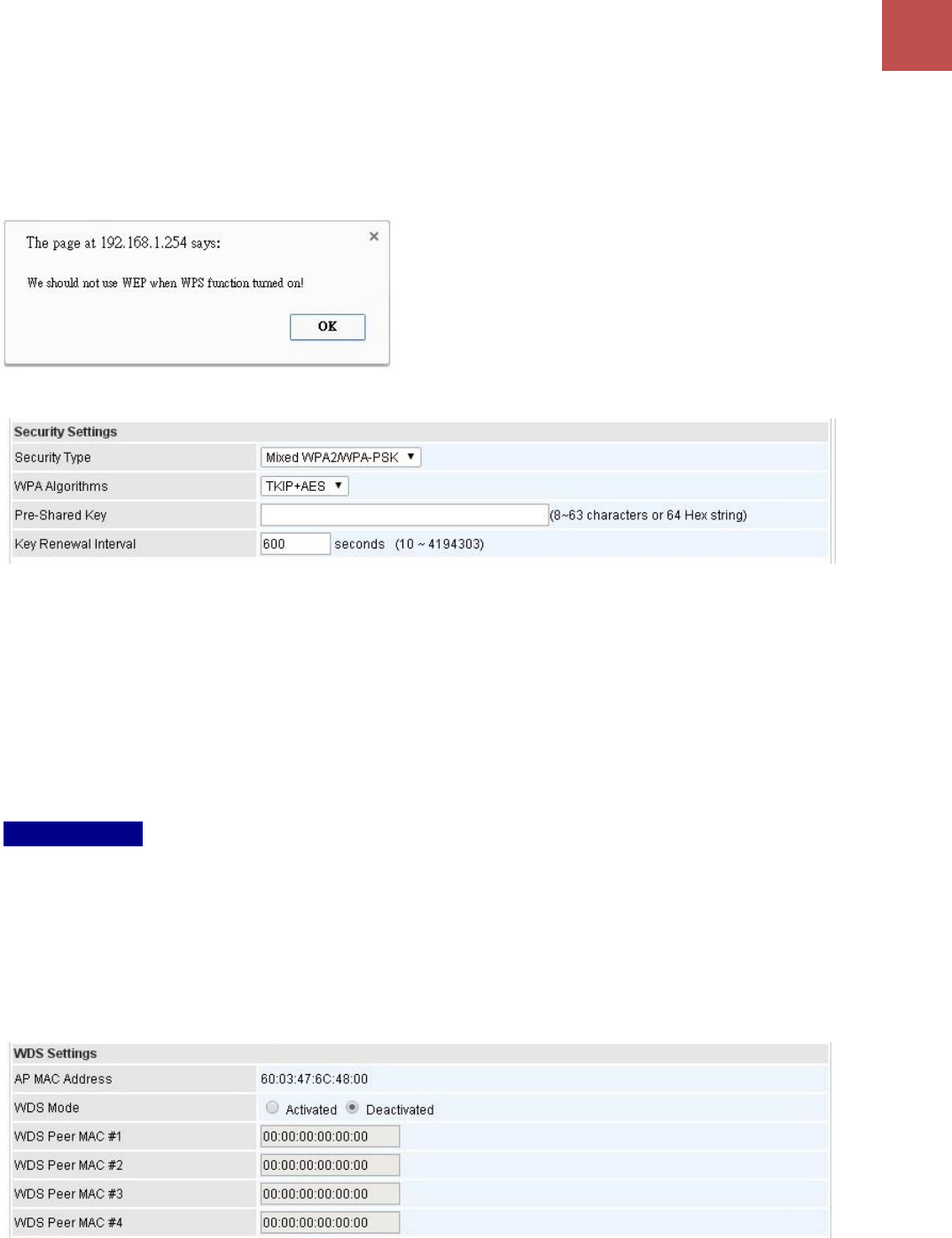
Device Configuration
Interface Setup – Wireless
61
BEC MX-1200 Series User Manual
If chose WEP 64-bit, then enter any 5 ASCII characters or 10 hexadecimal characters ("0-9", "A-F").
If chose WEP 128-bit, then enter 13 ASCII characters or 26 hexadecimal characters ("0-9", "A-F").
You must configure all four keys, but only one key can be activated at any one time. The default key
is key 1.
NOTE: WPS requires a higher level of security than WEP, 64bits
or 128bits. Select WAP / WAP2 security when using WPS.
WPA-PSK / WPA2-PSK / Mixed WPA & WPA2
WPA Algorithms: TKIP (Temporal Key Integrity Protocol) or AES (Advanced Encryption System)
utilizes a stronger encryption method and incorporates Message Integrity Code (MIC) to provide
protection against hackers.
Pre-Shared key: The key for network authentication. The input format should be 8-63 ASKII
characters or 64 hexadecimal characters
Key Renewal Interval: The time interval for changing the security key automatically between wireless
client and AP.
WDS Settings
WDS (Wireless distributed system) is a wireless access point mode that enables wireless link and
communication with other access point. It is easy to be installed, just define the peer’s MAC of the
connected AP.
WDS Mode: select Activated to enable WDS feature and Deactivated to disable this feature.
MAC Address: Enter the AP MAC addresses (in XX:XX:XX:XX:XX:XX format) of the peer connected
AP.
Click Save to apply the settings.
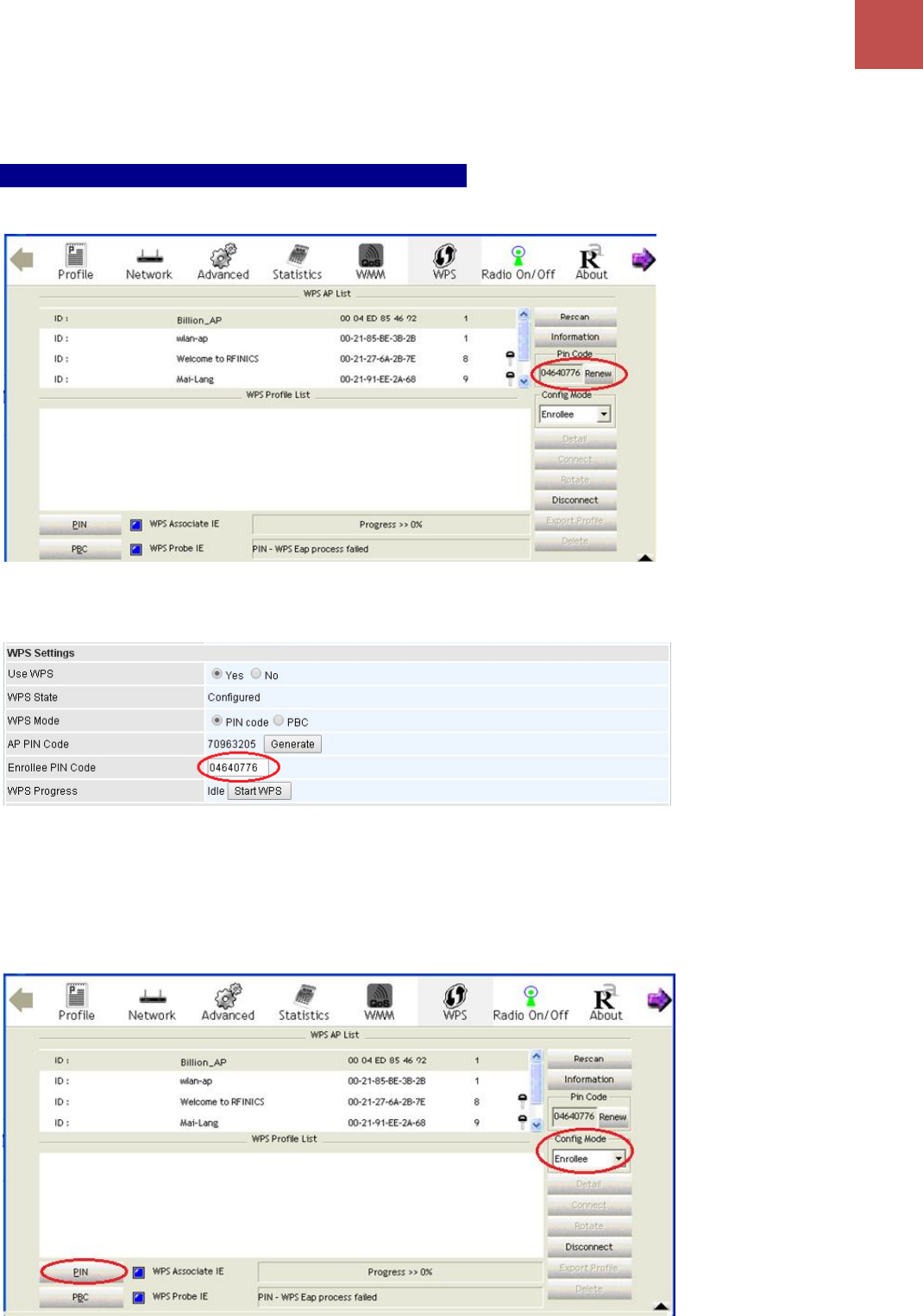
Device Configuration
Interface Setup – Wireless (Example on WPS using PIN)
62
BEC MX-1200 Series User Manual
Example: WPS using PIN Method (Personal Information Number)
PIN Method – Configure MX-1200 as a Registrar
1. Jot down the client’s Pin (e.g. 04640776) from the WPS utility (e.g. Ralink Utility)
2. Enter the Enrollee (Client) PIN code and then press Start WPS.
3. Go back to the wireless client’s WPS utility (e.g. Ralink Utility).
Set the Config Mode as Enrollee, press the WPS button on the top bar, select the AP (e.g. Billion_AP)
from the WPS AP List column. Then press the PIN button located on the middle left of the page to run
the scan.
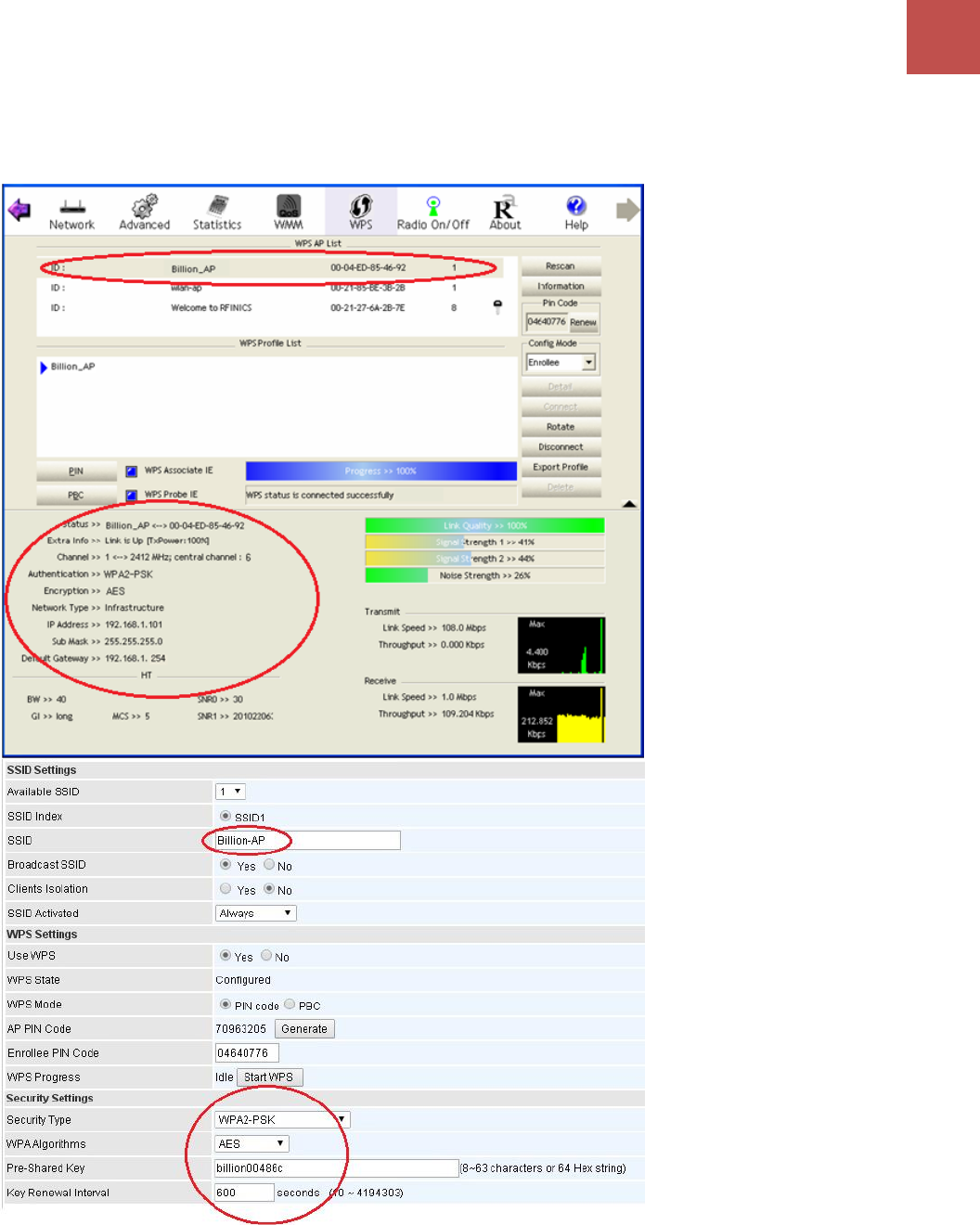
Device Configuration
Interface Setup – Wireless (Example on WPS using PIN)
63
BEC MX-1200 Series User Manual
4. The client’s SSID and security setting will now be configured to match the SSID and security setting
of the registrar, the MX-1200 router.
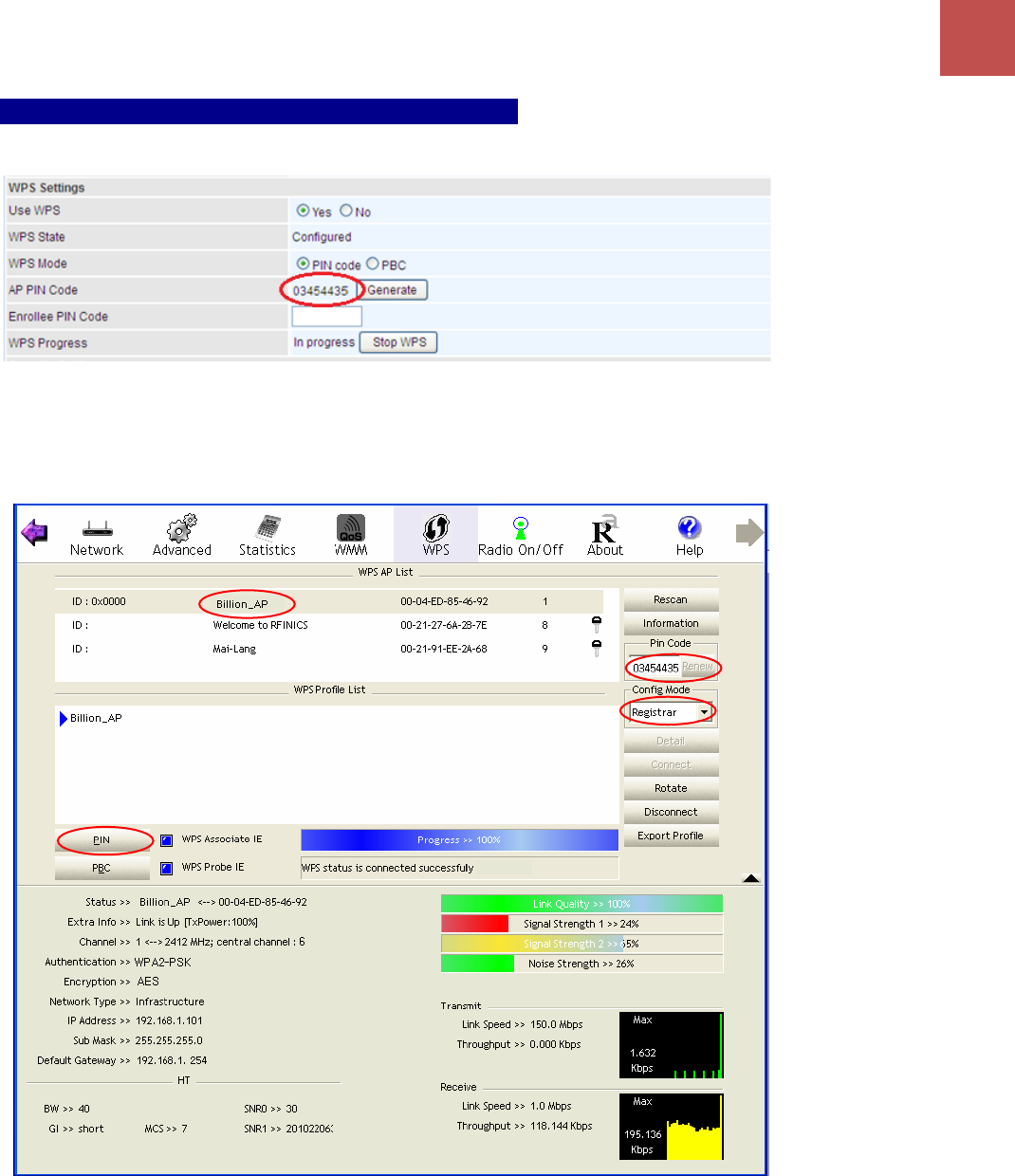
Device Configuration
Interface Setup – Wireless (Example on WPS using PIN)
64
BEC MX-1200 Series User Manual
PIN Method – Configure MX-1200 as an Enrollee
1. Jot down the AP PIN Code (e.g. 03454435) from the MX-1200. Press Start WPS.
2. Launch the wireless client’s WPS utility (e.g. Ralink Utility). Set the Config Mode as Registrar. Enter
the PIN number in the PIN Code (e.g. 03454435) column then choose the correct AP (e.g. Billion_AP)
from the WPS AP List before pressing the PIN button to run the scan.
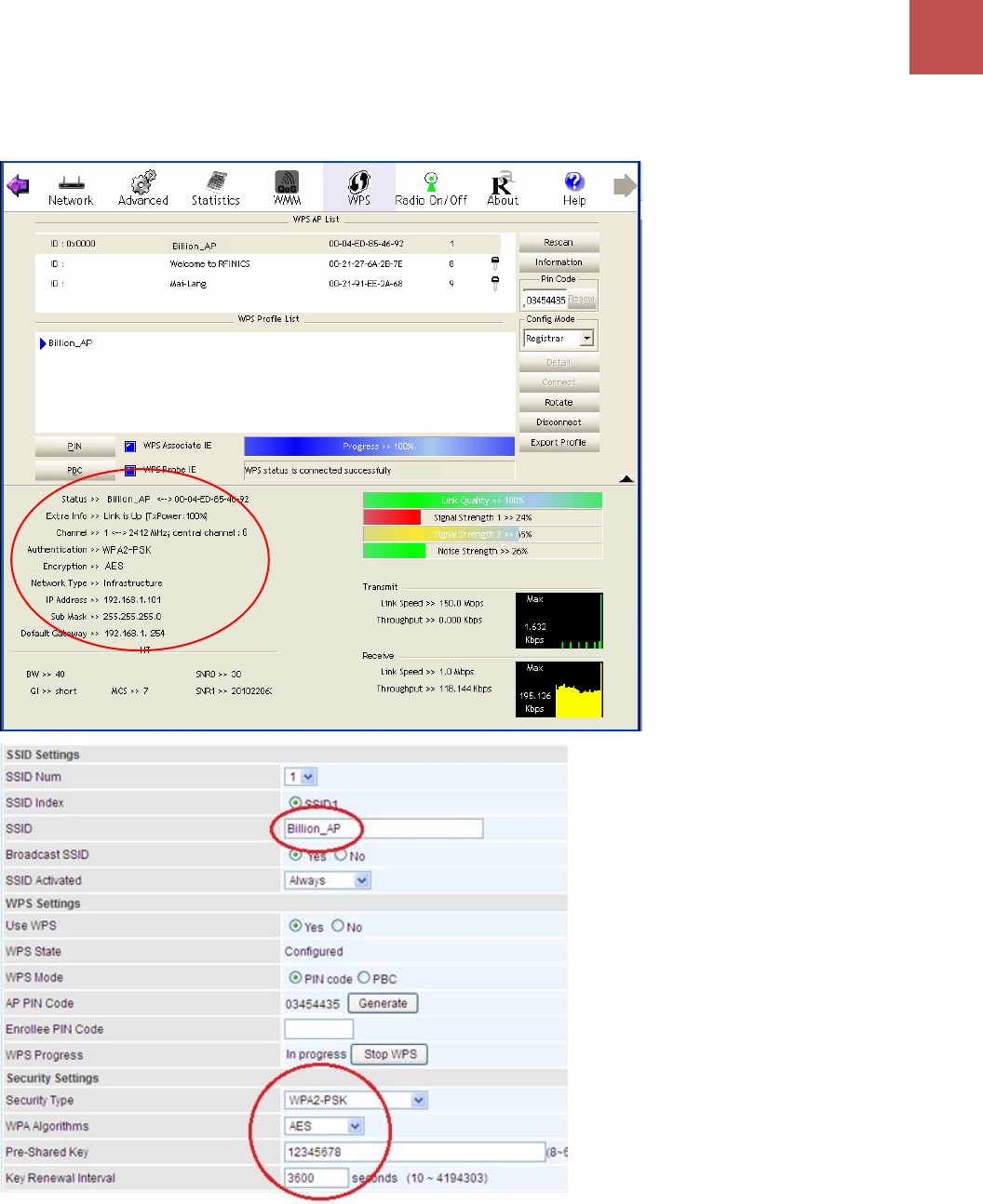
Device Configuration
Interface Setup – Wireless (Example on WPS using PIN)
65
BEC MX-1200 Series User Manual
3. The router’s (AP’s) SSID and security setting will now be configured to match the SSID and security
setting of the registrar (client).
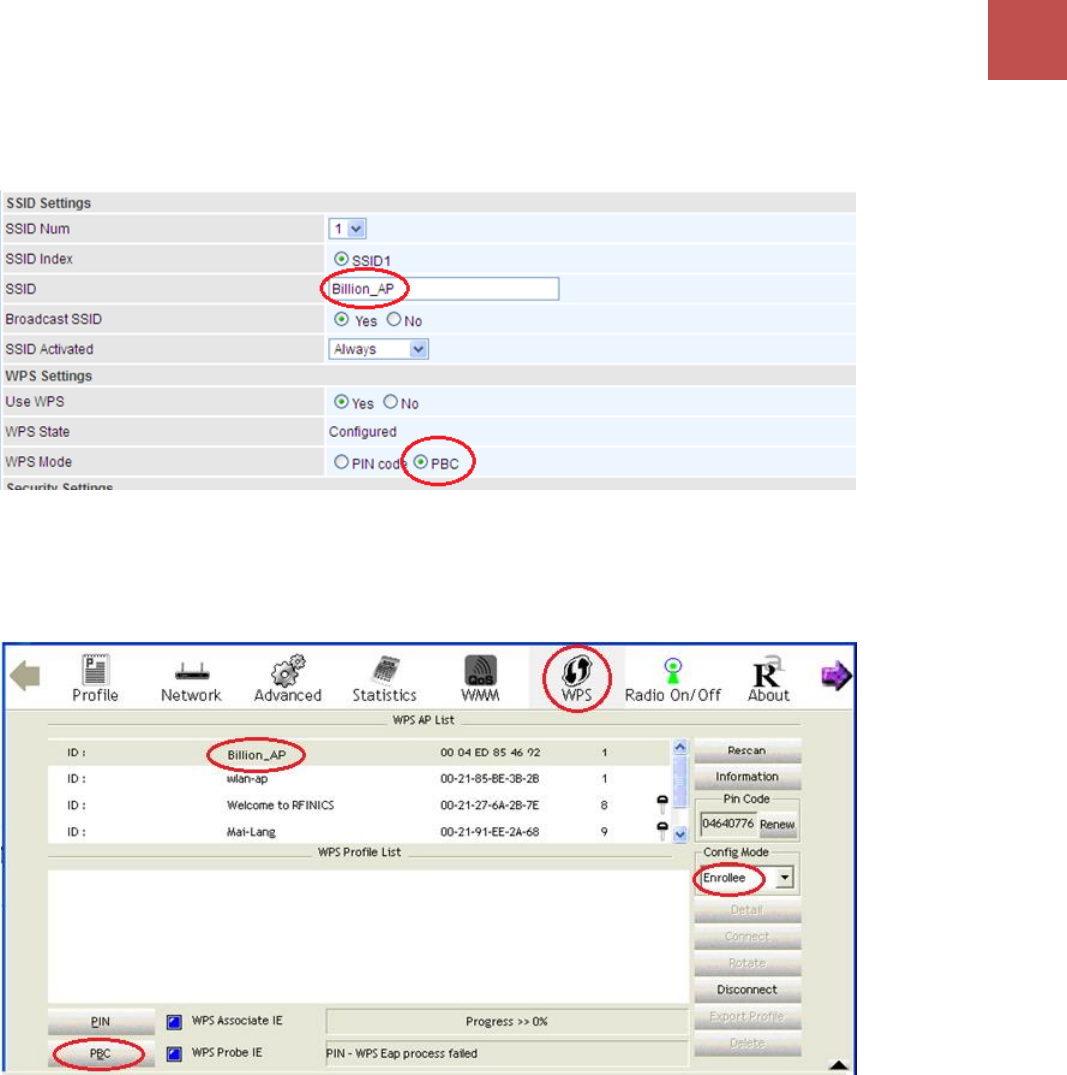
Device Configuration
Interface Setup – Wireless (Example on WPS using PBC)
66
BEC MX-1200 Series User Manual
Example: WPS using PBC Method (Push Button Configuration)
1. Click the PBC radio button and click Save to apply the settings
2. Launch the wireless client’s WPS Utility (e.g. Ralink Utility). Set the Config Mode as Enrollee. Then
press the WPS button and choose the correct AP (e.g. Billion_AP) from the WPS AP List section
before pressing the PBC button to run the scan.
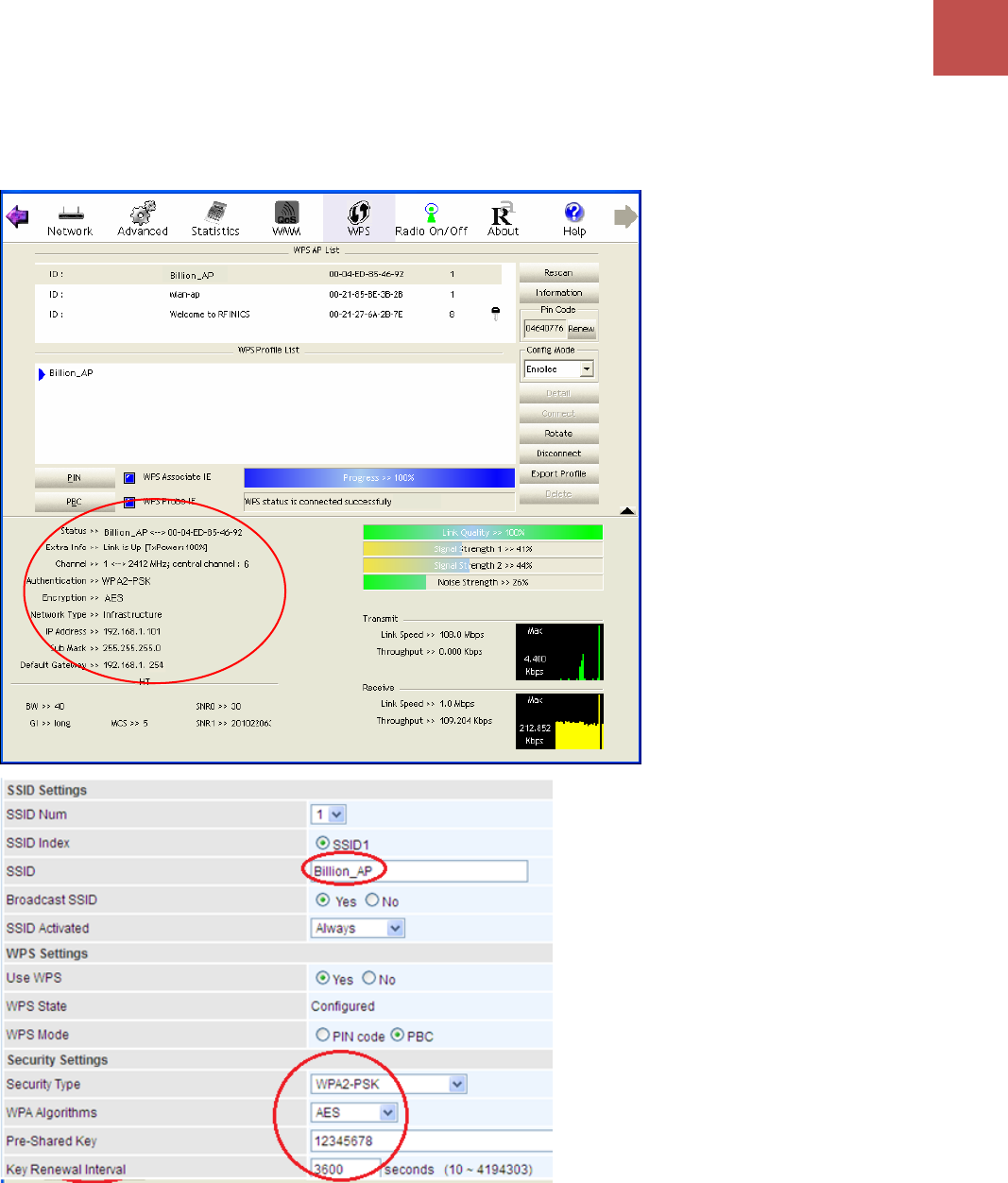
Device Configuration
Interface Setup – Wireless (Example on WPS using PBC)
67
BEC MX-1200 Series User Manual
3. When the PBC button is pushed, a wireless communication will be established between your router
and the PC. The client’s SSID and security setting will now be configured to match the SSID and
security setting of the router.
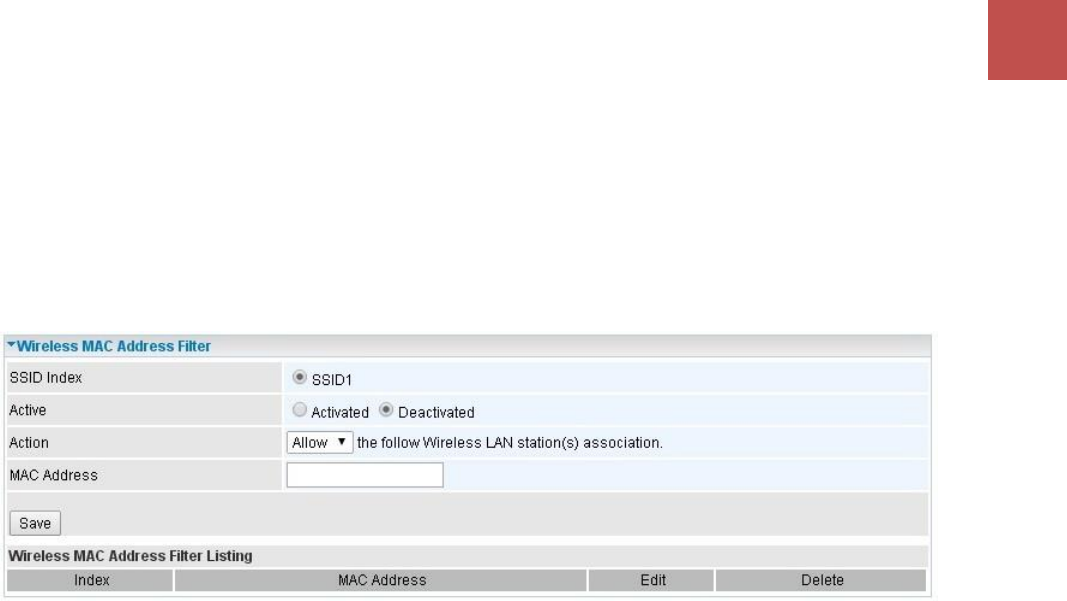
Device Configuration
Interface Setup – Wireless MAC Filter
68
BEC MX-1200 Series User Manual
Wireless MAC Filter
The MAC filter screen allows you to configure the router to give exclusive access to up to 8 devices
(Allow Association) or exclude up to 8 devices from accessing the router (Deny Association). Every
Ethernet device has a unique MAC (Media Access Control) address. The MAC address is assigned at
the factory and consists of six pairs of hexadecimal characters, for example, 00:AA:BB:00:00:02.
You need to know the MAC address of the devices you wish to filter.
SSID Index: Select the targeted SSID you want the MAC filter rules to apply to.
Active: Select Activated to enable MAC address filtering.
Action: Define the filter action for the list of MAC addresses in the MAC address filter table.
Select Deny to block access to the AP, MAC addresses not listed will be allowed to access the
router.
Select Allow to permit access to the router, MAC addresses not listed will be denied access to
the router.
MAC Address: Enter the MAC addresses (in XX:XX:XX:XX:XX:XX format) of the wireless station that
are allowed or denied access to the specified in these address fields.
Click Save to apply the settings.
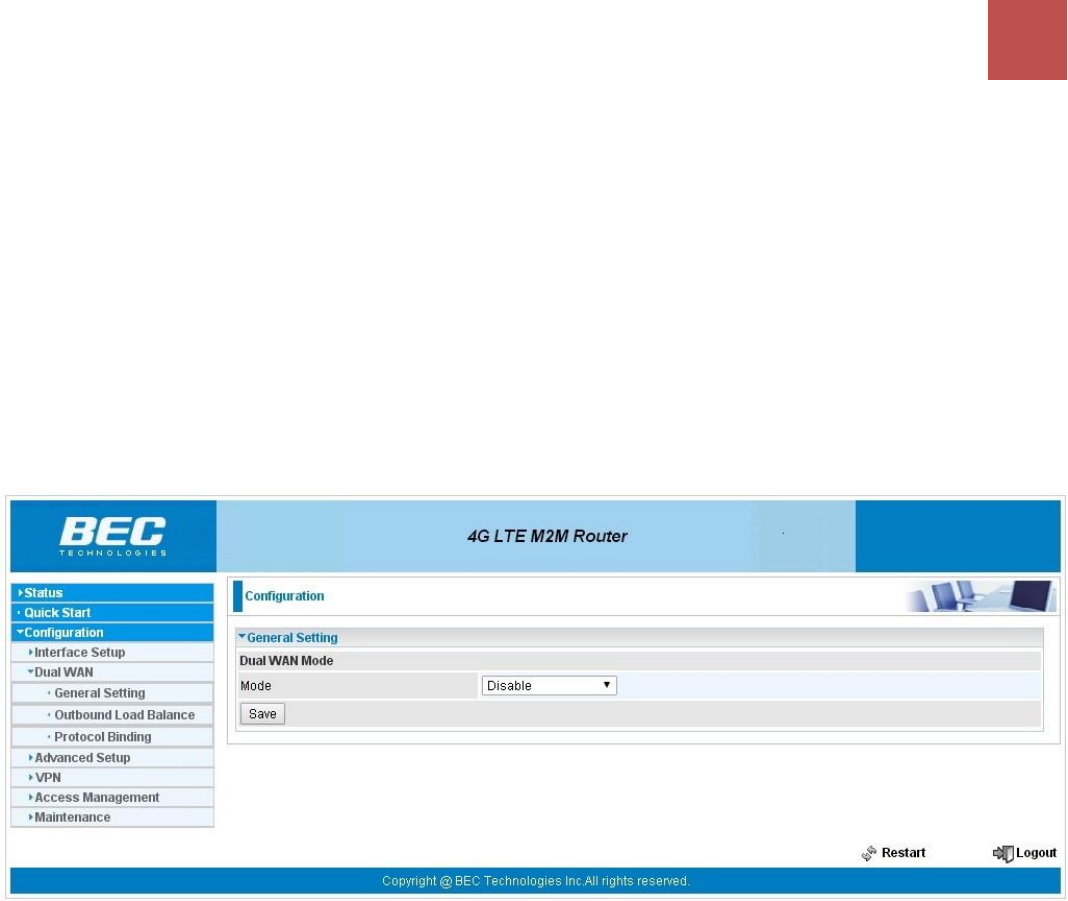
Device Configuration
Dual WAN – General Setting
69
BEC MX-1200 Series User Manual
Dual WAN
Dual WAN, is a feature to have two independent Internet connections connected concurrently, offers
a reliable Internet connectivity and maximize bandwidth utilization for critical applications delivery.
General Setting
Mode: Select a mode. Available modes: Disable, Failover & Failback, Failover Priority, and Load
Balancing
Mode (Disable): For MX-1200U and MX-1200X only. Primary SIM (SIM1) will get activated first.
Click Save to proceed
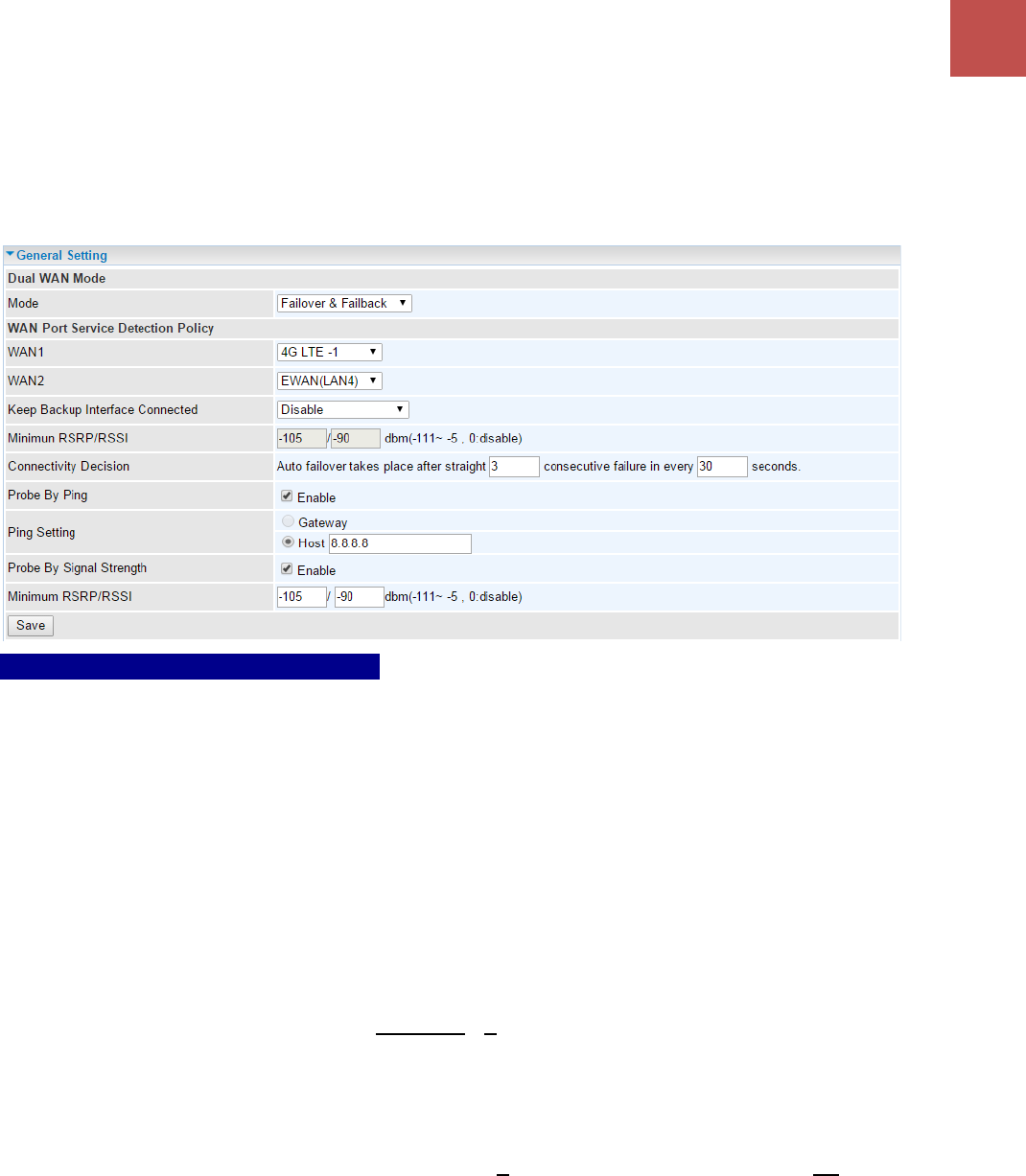
Device Configuration
Dual WAN – General Setting (Failover & Failback)
70
BEC MX-1200 Series User Manual
❖ Failover & Failback
Auto failover/failback ensures always-online network connectivity. When primary WAN link (WAN1)
fails, all traffic will switch over to the backup WAN (WAN2) seamlessly.
Again, when the primary link is restored, traffic will be handled over from WAN2 to WAN1.
WAN Port Service Detection Policy
WAN1 (Primary): Choose a desired WAN as the primary WAN Link from the list.
WAN2 (Backup): Choose a desired WAN as the backup WAN Link from the list.
Keep Backup Interface Connected: Select the following option whether to keep the backup WAN
(WAN2) interface connected to the Internet.
Disable: Inactivate this feature.
Always: Keep the backup WAN (WAN2) interface always connected to the Internet
By Signal Strength: Enable and initiate automatic backup WAN to connect to the Internet at
all time until the RSRP / RSSI of primary WAN is greater than the Minimum RSRP / RSSI.
Minimum RSRP / RSSI: Set a minimum requirement for RSRP and RSSI for the primary
WAN. Value range from -111 ~ -5. 0 means don’t care/no need to check this value.
NOTE: Both the RSRP and RSSI cannot be 0 at the same time.
Connectivity Decision & Probe Cycle: Set a number of times and time in seconds to determine
when to switch to the backup link (WAN2) when primary link (WAN1) fails and vise versa.
Example, Auto failover takes place after straight 3 consecutive failures in every 30 seconds meaning
all traffic will hand over to backup link (WAN2) after primary link fails to response in total of 90 seconds,
30 seconds for 3 consecutive failures.
NOTE: Failover and Failback follow the same Connectivity Decision & Probe Cycle rule to failover from WAN1 to WAN2
or fallback from WAN2 to WAN1.
Failover/Fallback Rule Decisions:
1. Probe by Ping: Enable Ping to the gateway or an IP address
Gateway: Internal system will wait for responses to the pings from the gateway of the WAN.
Host: Internal system will wait for responses to the pings from a fixed IP address.
2. Probe by Signal Strength: Enable to measure the LTE signal strength

Device Configuration
Dual WAN – General Setting (Failover & Failback)
71
BEC MX-1200 Series User Manual
Minimum RSRP / RSSI: Set a minimum requirement for RSRP and RSSI for initiating
automatic WAN failback or failover procedures.
Click Save to apply the settings.
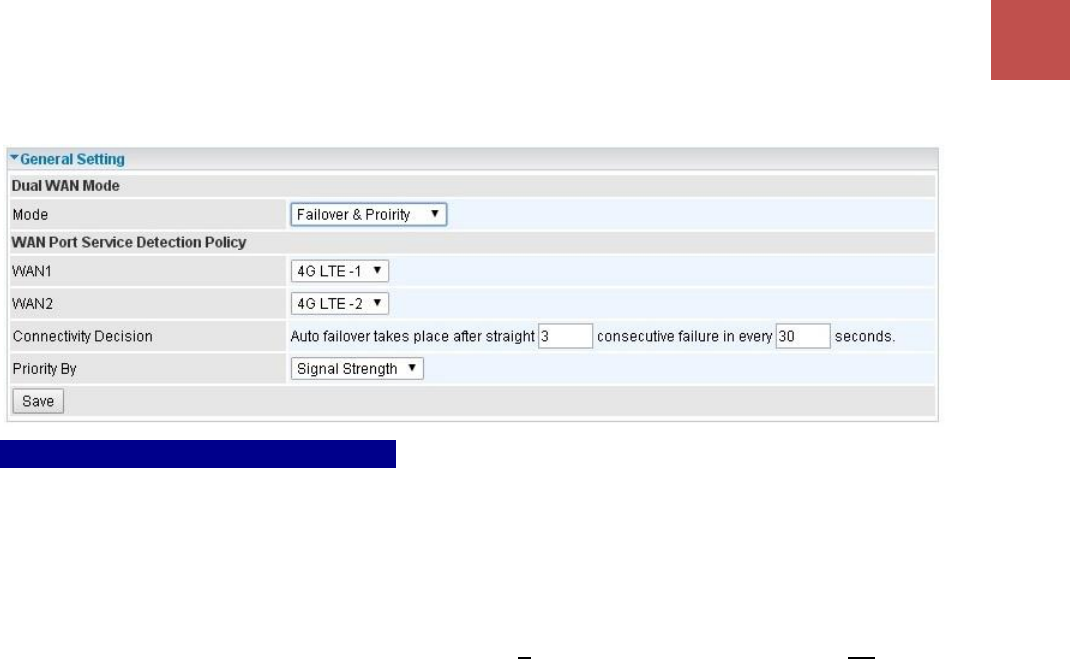
Device Configuration
Dual WAN – General Setting (Failover & Priority)
72
BEC MX-1200 Series User Manual
❖ Failover & Priority
WAN Port Service Detection Policy
WAN1 (Primary): Choose a desired WAN as the primary WAN Link from the list.
WAN2 (Backup): Choose a desired WAN as the backup WAN Link from the list.
Connectivity Decision & Probe Cycle: Set a number of times and time in seconds to determine
when to switch to the backup link (WAN2) when primary link (WAN1) fails and vise versa.
Example, Auto failover takes place after straight 3 consecutive failures in every 30 seconds meaning
all traffic will hand over to backup link (WAN2) after primary link fails to response in total of 90 seconds,
30 seconds for 3 consecutive failures.
NOTE: Failover and Failback follow the same Connectivity Decision & Probe Cycle rule to failover from WAN1 to WAN2
or fallback from WAN2 to WAN1.
Priority by Signal Strength: Use LTE signal strength measurement to initiating automatic WAN
failback or failover procedures.
Click Save to apply the settings
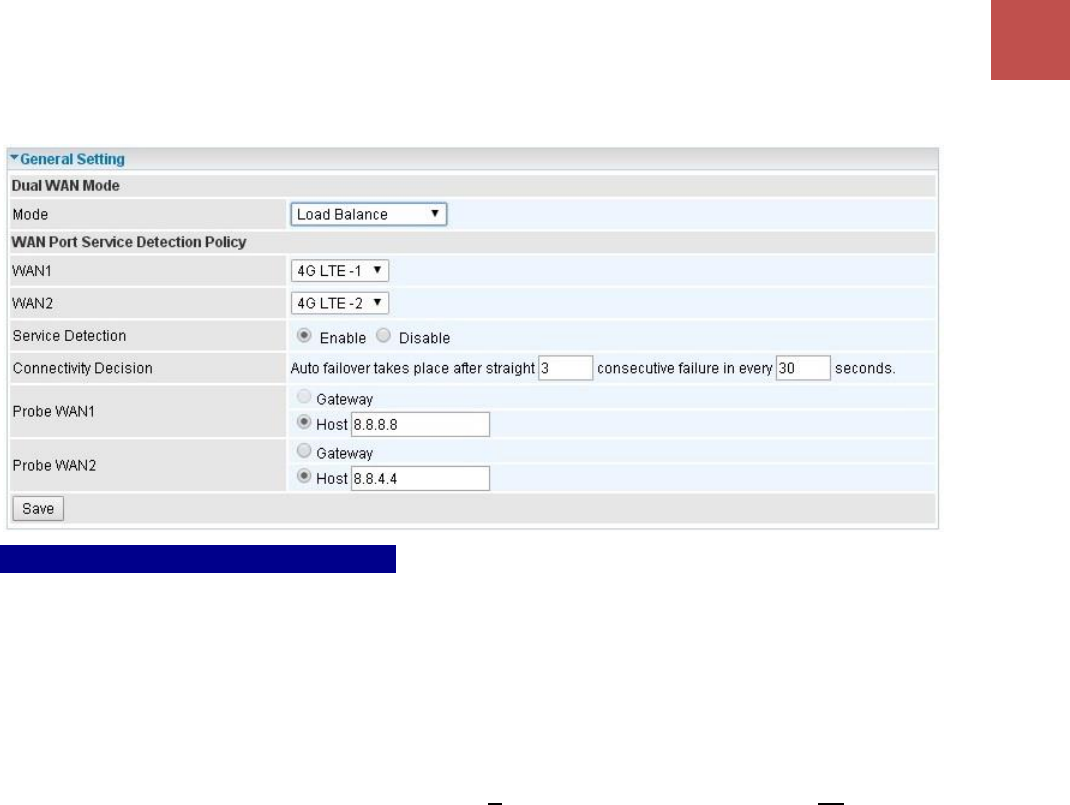
Device Configuration
Dual WAN – General Setting (Load Balance)
73
BEC MX-1200 Series User Manual
❖ Load Balance
WAN Port Service Detection Policy
WAN1 (Primary): Choose a desired WAN as the primary WAN Link from the list.
WAN2 (Backup): Choose a desired WAN as the backup WAN Link from the list.
Service Detection: Enable to detect WAN connectivity automatically.
Connectivity Decision & Probe Cycle: Set a number of times and time in seconds to determine
when to turn-off the Load Balancing service.
Example, Disable Load Balance after straight 3 consecutive failures in every 30 seconds meaning all
traffic will hand over to backup link (WAN2) after primary link fails to response in total of 90 seconds,
30 seconds for 3 consecutive failures.
Deactivate Load Balance Decision:
Probe Ping on WAN 1 / WAN2: Enable Ping to the gateway or an IP address
Gateway: Internal system will wait for responses to the pings from the gateway of the WAN.
Host: Internal system will wait for responses to the pings from a fixed IP address.
Click Save to apply the settings
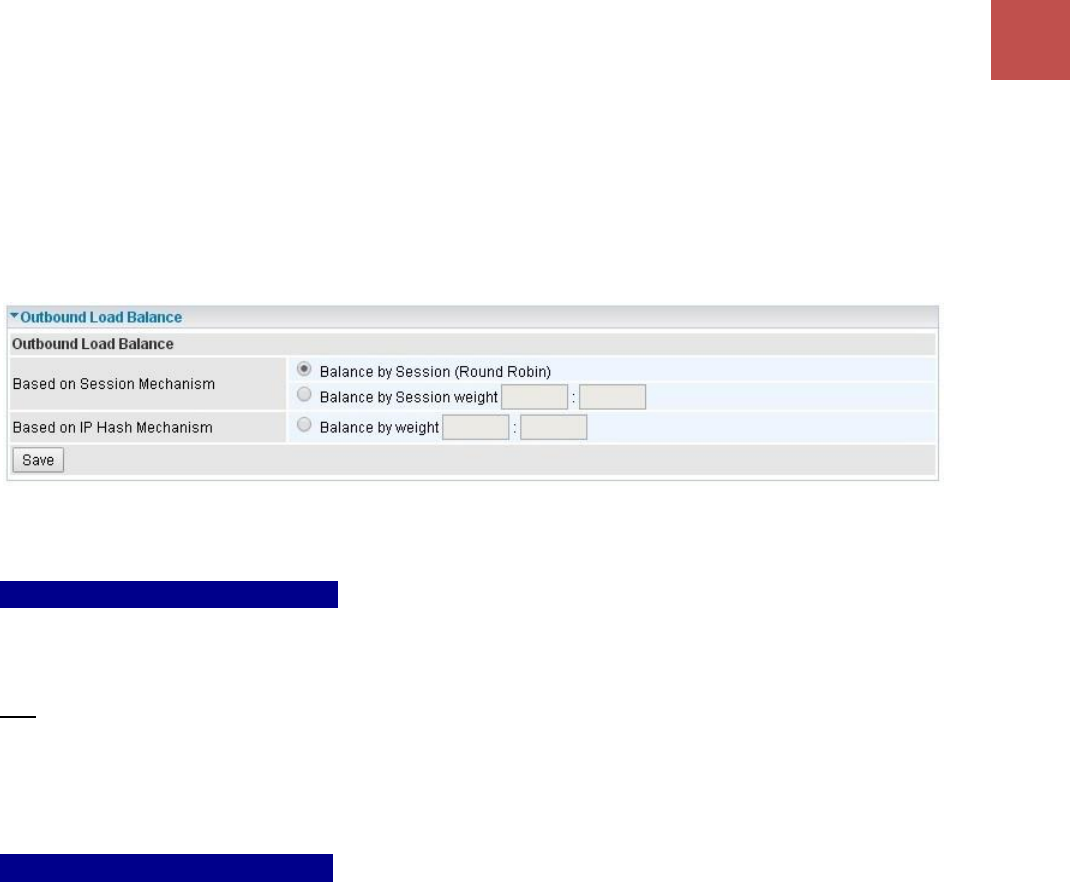
Device Configuration
Dual WAN – Outbound Load Balance
74
BEC MX-1200 Series User Manual
Outbound Load Balance
The connections are distributed over WAN1 and WAN2 so that it can utilize bandwidth of both WAN
ports. With Outbound load balance, traffic may be routed to a faster link when one of the WAN links is
slower or congested so that user gains better throughput and less delay.
In General Setting, select Load Balance mode prior to configure this feature.
User can distribute outbound traffic based on Session Mechanism or IP Hash Mechanism.
Base on Session Mechanism:
Balance by Session (Round Robin): Automatically assign requests/traffics to each WAN interface
based on real-time WAN traffic-handling capacity.
OR
Balance by Session weight: Manually Balance session traffic based on a weight ratio.
Example: Session weight by 3:1 meaning forward 3 requests to WAN1 and 1 request to WAN2.
Base on IP Hash Mechanism:
Balance by weight: Use an IP hash to balance traffic based on a ratio. It is to guarantee requests
from the same IP address get forward to the same WAN interface.
Click Save to apply the settings
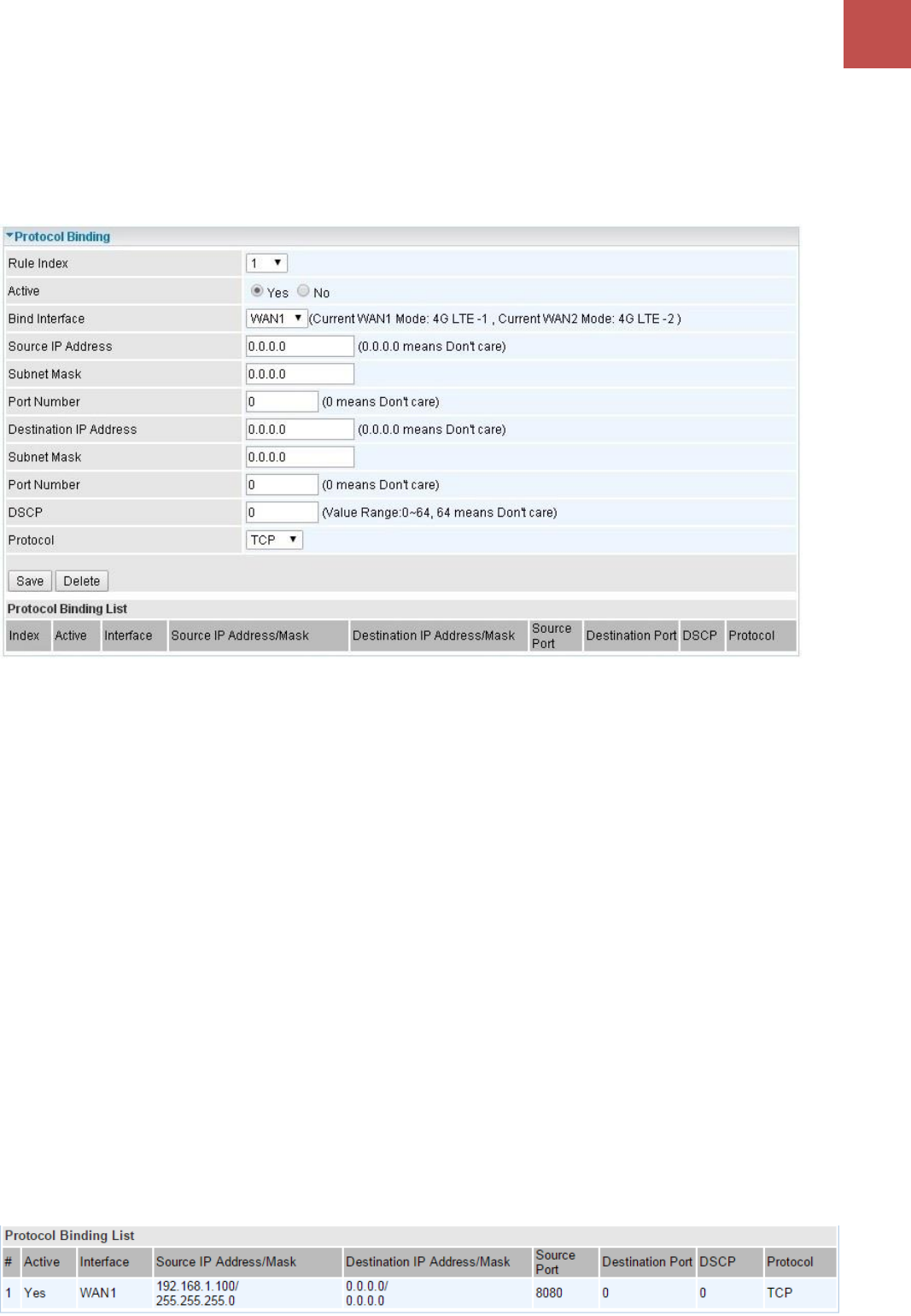
Device Configuration
Dual WAN – Protocol Binding
75
BEC MX-1200 Series User Manual
Protocol Binding
Protocol Binding lets you direct specific traffic to go out from a specific WAN port. Policies determine
how specific types of internet traffic are routed, for example, traffic from a particular IP address(es)
granted access to only one WAN port rather than using both of the WAN ports as with load balancing.
Rule Index: The numeric rule indicator. The maximum entry is up to 16.
Active: Click YES to activate the rule
Bind Interface: The dedicated WAN interface that guarantees to handle this traffic request.
Source IP Address: Enter the source IP address featuring the traffic origin.
Subnet Mask: Enter the subnet of the source network.
Port Number: Enter the port number which defines the application.
Destination IP Address: Enter the destination IP address featuring the traffic destination.
Subnet Mask: Enter the subnet of the designation network.
Port Number: Enter the port number which defines the application.
DSCP: The DSCP value. Value Range from 0~64; 64 means Don't care
Protocol: Select a protocol, TCP, UDP, ICMP, to use for this traffic.
Click Save to apply the settings
Example:
All traffics from IP 192.168.1.100/255.255.255.0 with port 8080 will go through WAN1 interface.
The only time it would go through WAN2 interface is when WAN1 has no Internet connection.
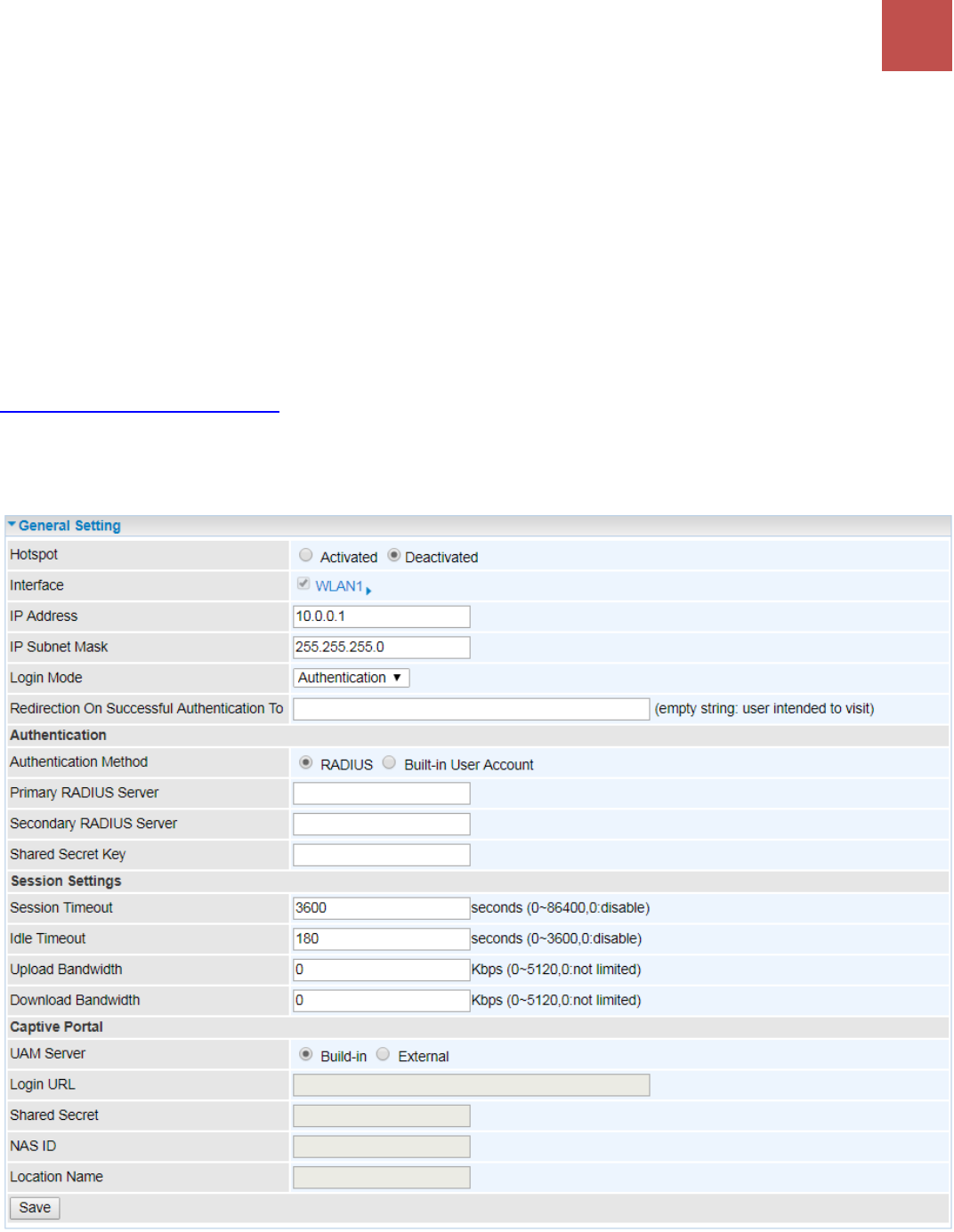
Device Configuration
Hotspot – General Setting
76
BEC MX-1200 Series User Manual
Hotspot
The Wi-Fi hotspot offers Internet access for mobile devices like smart phones, laptops, or smart pad
to connect wirelessly in public locations such as in coffee shops, train station, airport, hotel, and much
more. A captive portal with a login page will prompt on the mobile devices and require all Wi-Fi clients
to accept the term of use before accessing to the Internet.
NOTE 1: Hotspot uses wireless network name, SSID1, to provide public Wi-Fi Internet access.
NOTE 2: To broadcast and see the hotspot ssid (SSID1), your MX-1200 router must be connected to
the Internet first.
NOTE 3: It is ideal to change the Wi-Fi Hotspot (SSID) security type to OPEN (no encryption). Go to
Wireless >> Security Settings
General Setting
Hotspot: Activate to enable the Wi-Fi hotspot feature.
Interface: The dedicated interface, WLAN1 (SSID1 network name) handles the Wi-Fi hotspot traffic
IP Address: The IP address for the Wi-Fi hotspot network.
Subnet Mask: Enter the subnet of the network.
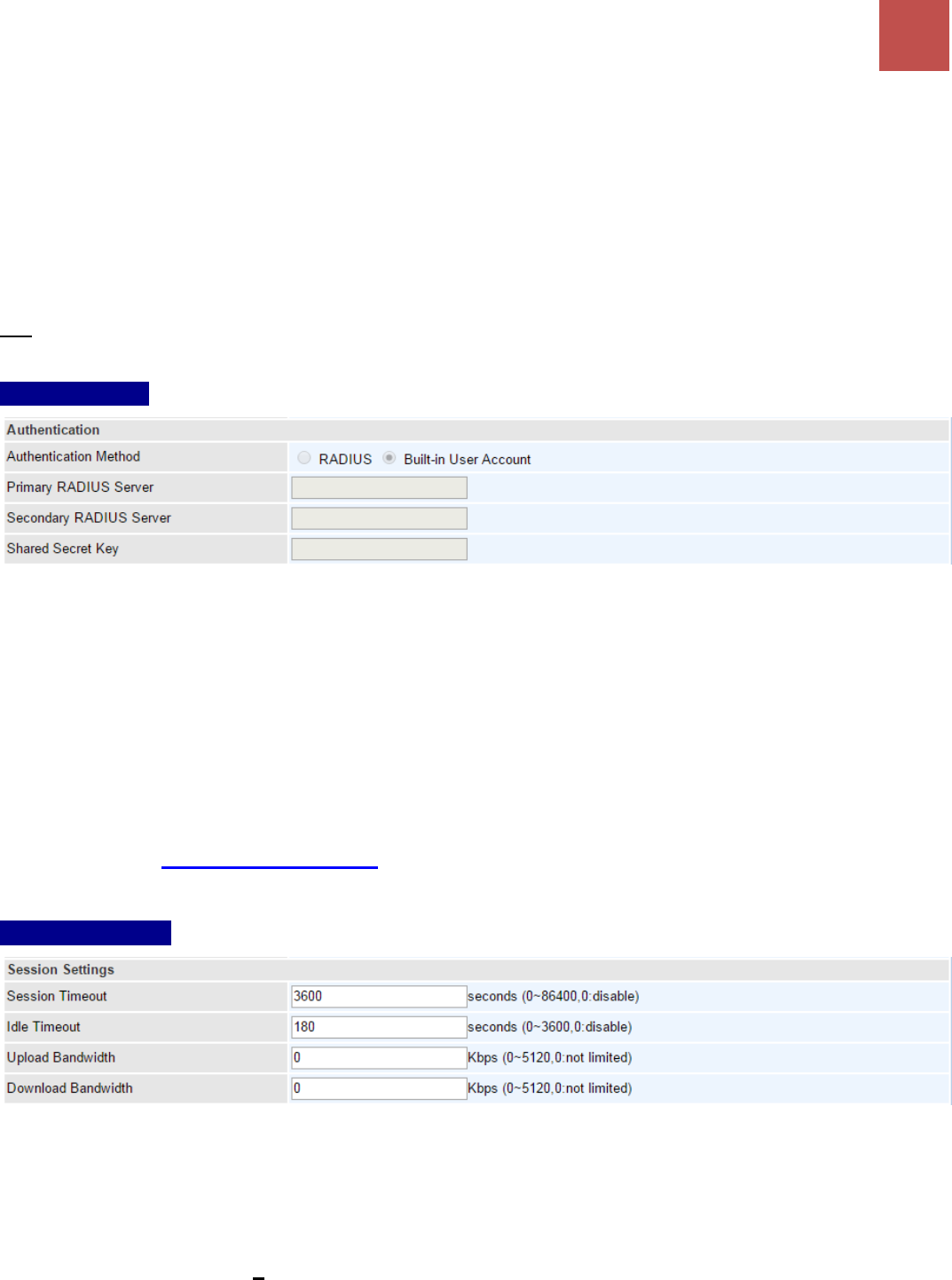
Device Configuration
Hotspot – General Setting
77
BEC MX-1200 Series User Manual
Login Mode: Two (2) types of login modes to join the network.
Authentication: Username and Password (credential) is required to join the hotspot network.
Go down to the Authentication section below and select a method.
Agreement: No Username and Password is required. Automatically login to the hotspot
network after accept and agree to the terms (“Terms”) of use.
Redirect URL after Successful Login: Enter the URL (http:// is not required). After Wi-Fi client is
successful login to the network, the page will get redirected to this URL.
OR leave it blank to stay in current page.
NOTE: This new URL will be added to the Walled Garden automatically.
Authentication
Authentication Methods: Two (2) network authentication methods, local built-in user account or a
remote, external RADIUS server. If the credential matches, the Wi-Fi client is granted access to the
network.
RADIUS (an external authentication server)
Primary RADIUS Server: The main IP address of the server.
Secondary RADIUS Server: The backup IP address of the server, if any.
Shared Secret Key: Enter the shared Secret given by the server
Built-in User Account (local database handled by the MX-1200)
Go to the Built-in User Account to setup account usernames and passwords for the hotspot.
Session Settings
Session Timeout (in seconds): The time period of a Wi-Fi client is allowed to access to the Internet.
After this timeout period, a new authentication is required.
Idle Timeout (in seconds): The allowed inactivity time of a Wi-Fi client. After this timeout period, a
new authentication is required.
Upload / Download Bandwidth (in Kbps): The maximum upload and download link speed, value
range from 0 ~ 5120Kbps; 0 means no speed limitation.

Device Configuration
Hotspot – General Setting
78
BEC MX-1200 Series User Manual
Captive Portal
UAM Server: Choose between Build-in and External. Fill in the blanks to use External UAM server.
Information can be obtained from the UAM server.
Login URL: Enter the login URL offered by the UAM server.
Shared Secret: Set the shared secret password offered.
NAS ID: An assigned string for identification.
Location Name: An assigned string for identification.
Click Save to save settings
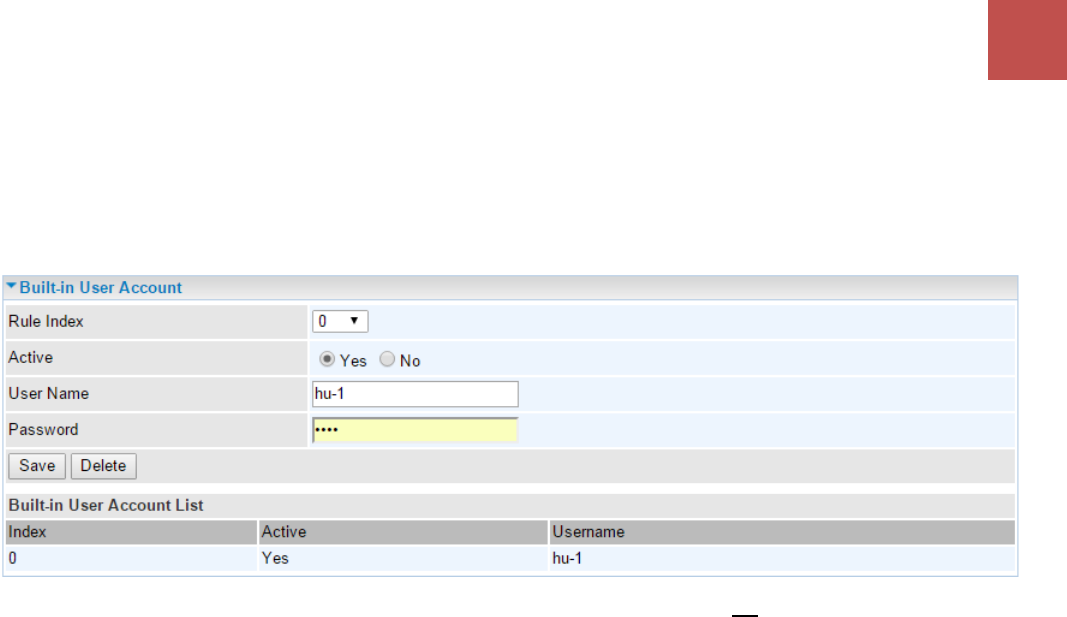
Device Configuration
Hotspot – Built-in User Account
79
BEC MX-1200 Series User Manual
Built-in User Account
It is a local database on the router with pre-defined user accounts authorized by the MX-1200 to grant
and provide Wi-Fi hotspot access for Wi-Fi capable devices/users.
16, maximum, accounts are allowed.
Rule Index: The numeric rule indicator. The maximum entry is up to 16.
Active: Select Yes to enable the rule of the account.
Username / Password: Create a user name and password for this user account.
Save: Click the Save button to apply the settings
Delete: Use the Rule Index to select an unwanted rule then click Delete button to remove it from
the Account list.
Click Save to save settings
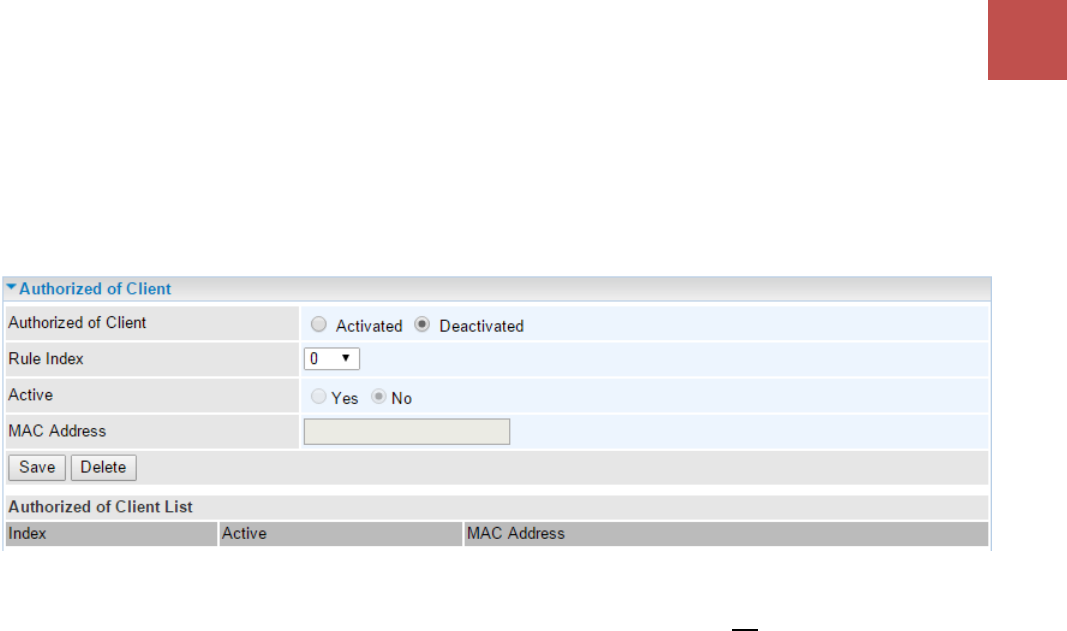
Device Configuration
Hotspot – Authorized of Clien
t
80
BEC MX-1200 Series User Manual
Authorized of Client
Add and predefine a trusted wireless MAC address of a Wi-Fi capable device for an immediate
hotspot/Internet access. Hotspot/Internet access requires no authentication.
16, maximum, accounts are allowed.
Authorized of Client: Select Activated to enable this feature.
Rule Index: The numeric rule indicator. The maximum entry is up to 16.
Active: Select Yes to enable the rule of the client.
MAC Address: Enter the wireless MAC address of the Wi-Fi device.
Save: Click the Save button to apply the settings
Delete: Use the Rule Index to select an unwanted rule then click Delete button to remove it from
the Client list.
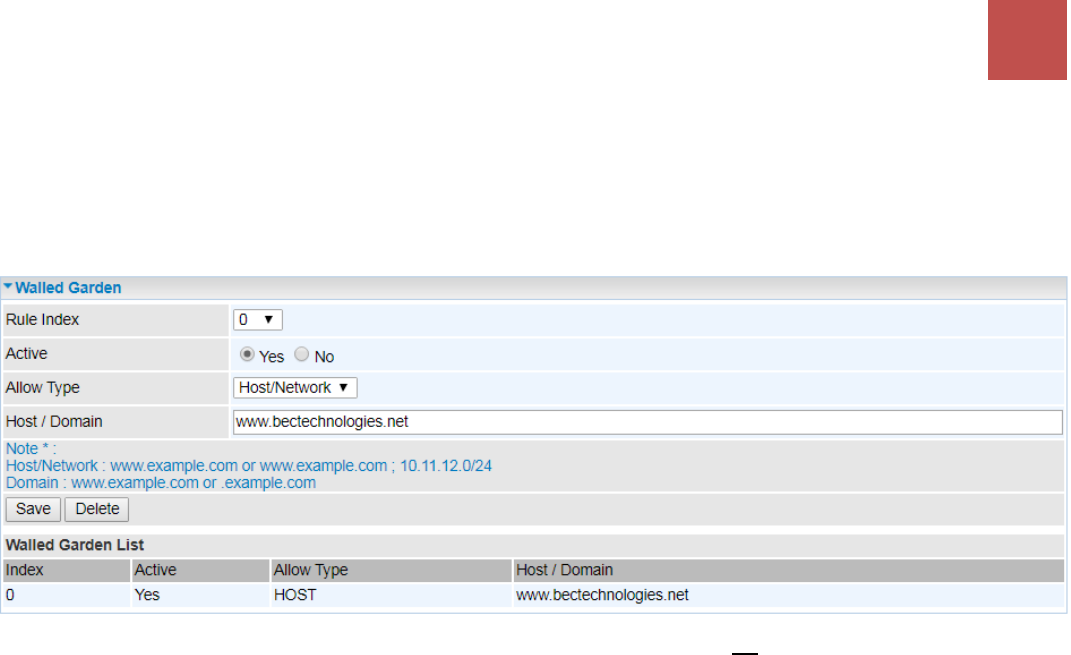
Device Configuration
Hotspot – Walled Garden
81
BEC MX-1200 Series User Manual
Walled Garden
Add and predefine websites (domain names) or web IP address to allow Wi-Fi devices / clients to
access to. Web site access requires no authentication.
16, maximum, websites / domains are allowed.
Rule Index: The numeric rule indicator. The maximum entry is up to 16.
Active: Select Yes to enable the rule of the walled garden.
Allow Type: Either a Host/Network or Domain.
Host / Domain name: Enter a valid domain, network, or website for unauthorized clients to access
to.
Save: Click the Save button to apply the settings
Delete: Use the Rule Index to select an unwanted rule then click Delete button to remove it from
the Walled Garden list.
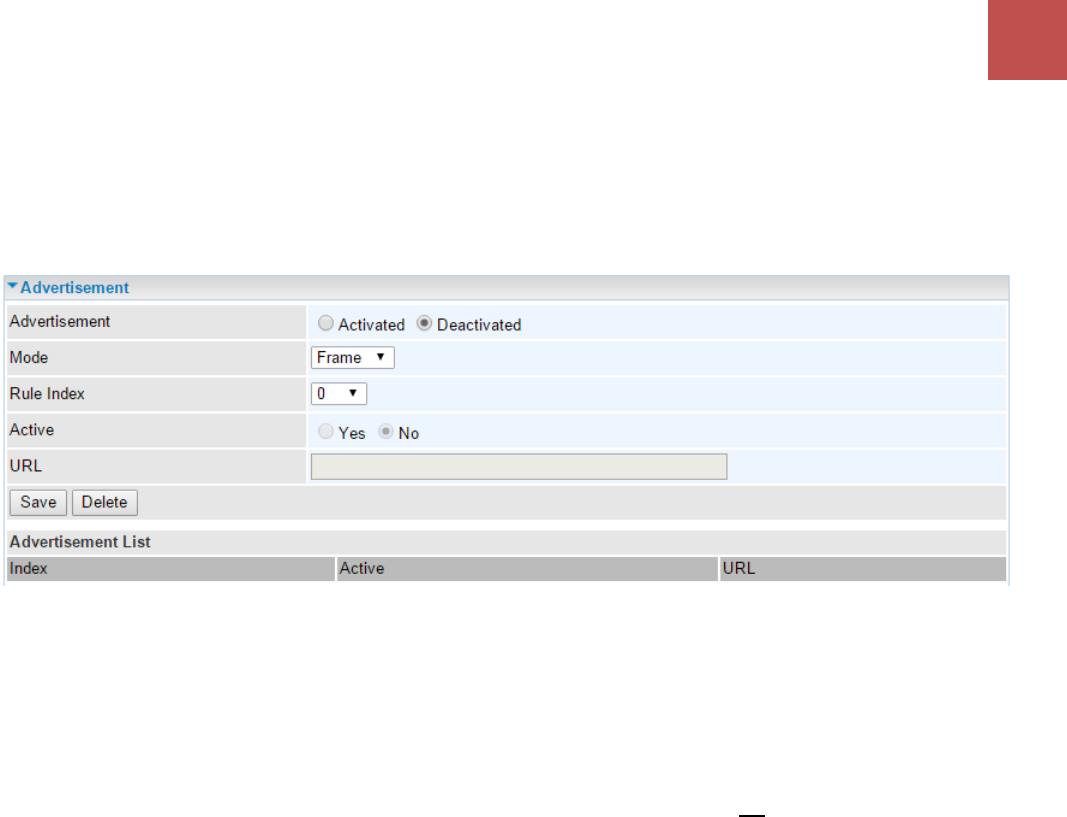
Device Configuration
Hotspot – Advertisemen
t
82
BEC MX-1200 Series User Manual
Advertisement
Add pop-ups ads and redirects to MX-1200 Wi-Fi Hotspot, and only a random ad will be displayed per
a login.
16, maximum, ads are allowed.
Advertisement: Select Activated to enable this feature.
Mode: Two (2) web advertising methods are available.
Frame: Redirect to a random ad site, a full-page ad, before reaching to the login page. This
full-page ad will get redirect to the login page after 5-10 seconds.
Popup: A random pop-up ad display in a separate window after the login page.
Rule Index: The numeric rule indicator. The maximum entry is up to 16.
Active: Select Yes to enable the rule.
URL: Enter a valid
Save: Click the Save button to apply the settings
Delete: Use the Rule Index to select an unwanted rule then click Delete button to remove it from
the Walled Garden list.
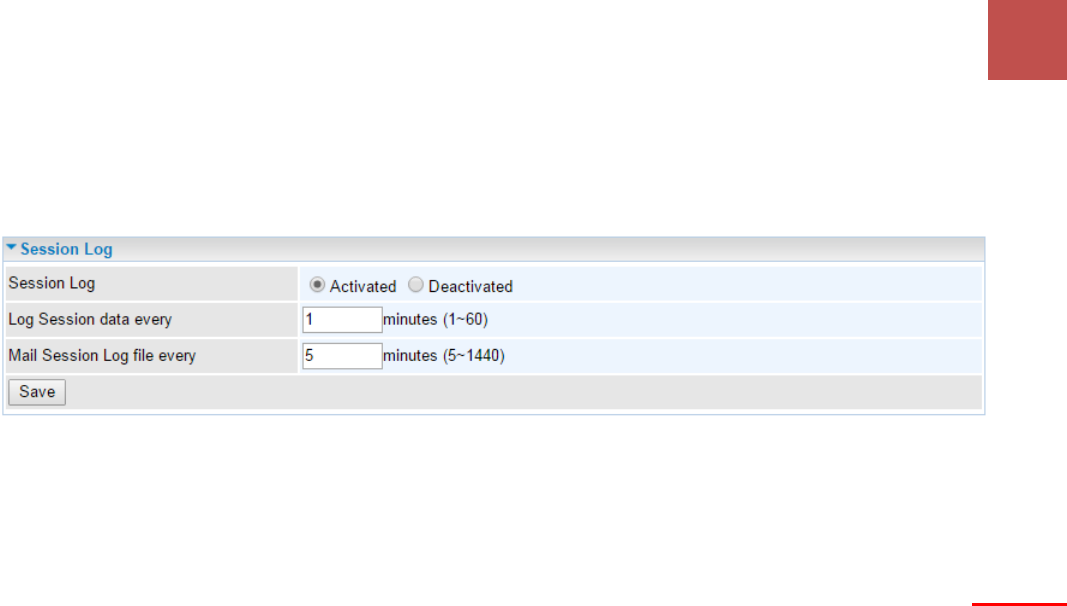
Device Configuration
Hotspot – Session Log
83
BEC MX-1200 Series User Manual
Session Log
Record all hotspot access information and e-mail the statistics report of the hotspot clients in a specific
duration.
Session Log: Select Activated to enable this feature.
Log Session Data in every (minute): Input session log time duration, (min) 1 to (max) 60 minutes.
Mail Session Log File in every (minute): MX-1200 will send all access information, such as access
IP addresses, NAT tables, etc., to the administrator’s mail box in the specific time/minute.
NOTE: Please set up a dedicated or administrator e-mail account to receive Hotspot access information in the Mail Alert.
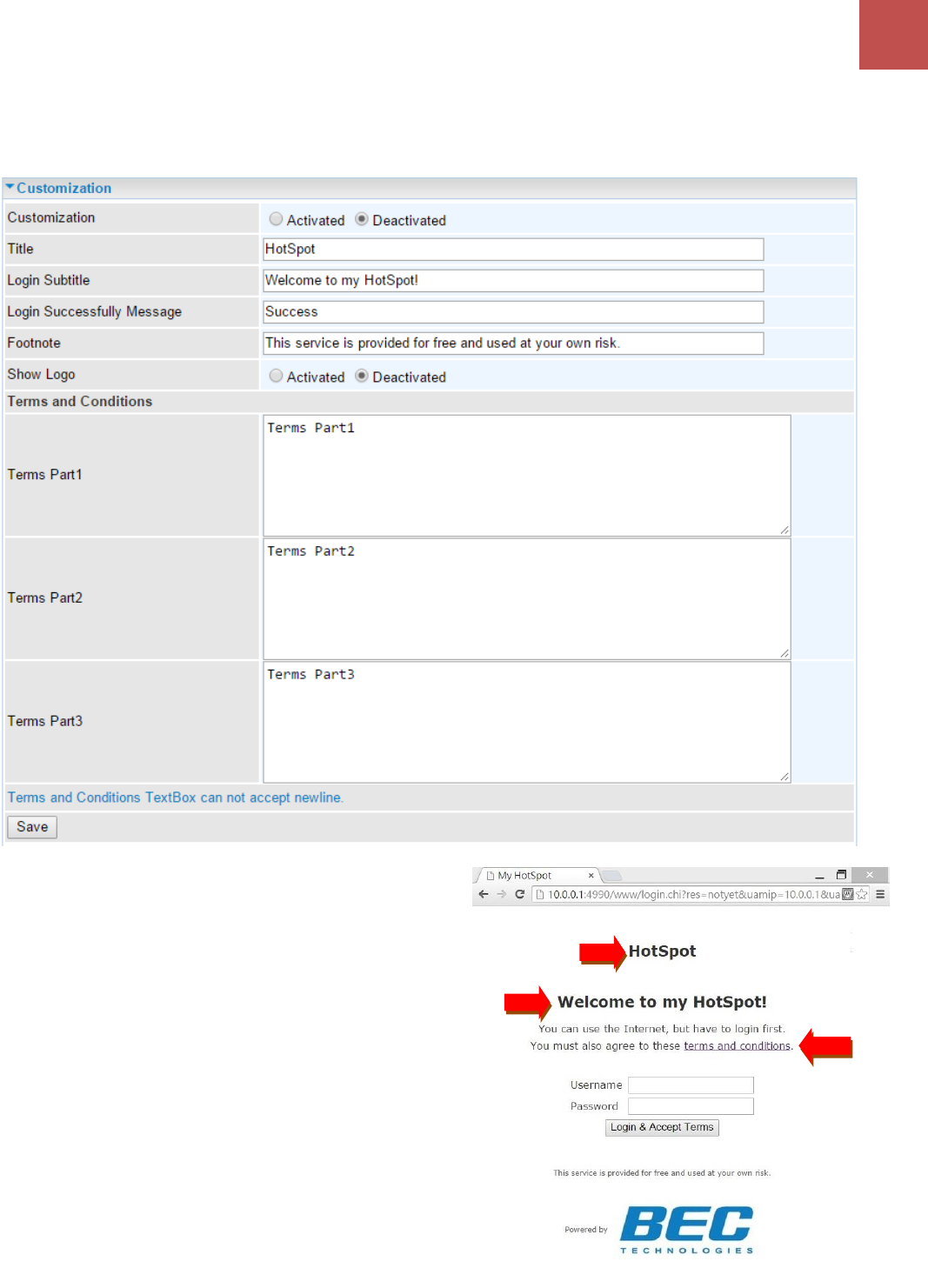
Device Configuration
Hotspot – Customization
84
BEC MX-1200 Series User Manual
Customization
Allow modification to some of the captive portal settings.
Customization: Select Activated to enable this
feature.
Title: The Banner message. Default is “Hotspot”
Login Subtitle: Default is “Welcome to my
Hotspot”
Term Part 1 / 2 / 3: Create your own Terms and
Conditions. To use default, same terms, please
skip this part.
NOTE: No newline is accepted in each text box.
Login Successfully Message: MX-1200 will
send all access information, such as access IP
addresses, NAT tables, etc., to the
administrator’s mail box in the specific
time/minute.
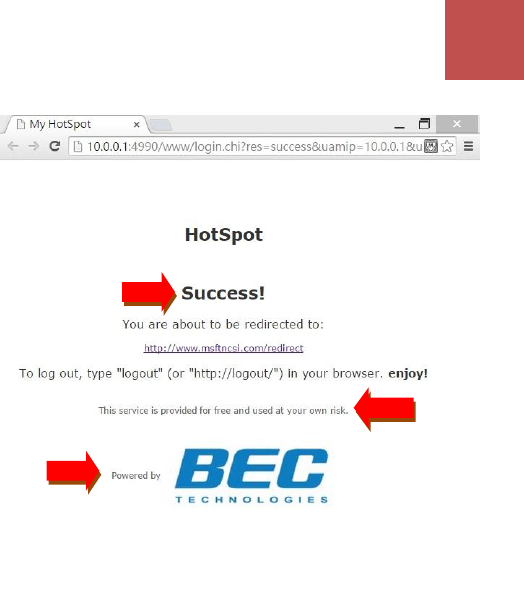
Device Configuration
Hotspot – Customization
85
BEC MX-1200 Series User Manual
Login Successfully Message: A greeting
message after successful login to the Wi-Fi
hotspot. Default is “Success!”
Footnote: Additional information, if needed.
Default is “This service is provided for free and
used at your own risk.”
Show Logo: Select Activated to display
company Logo on the portal.
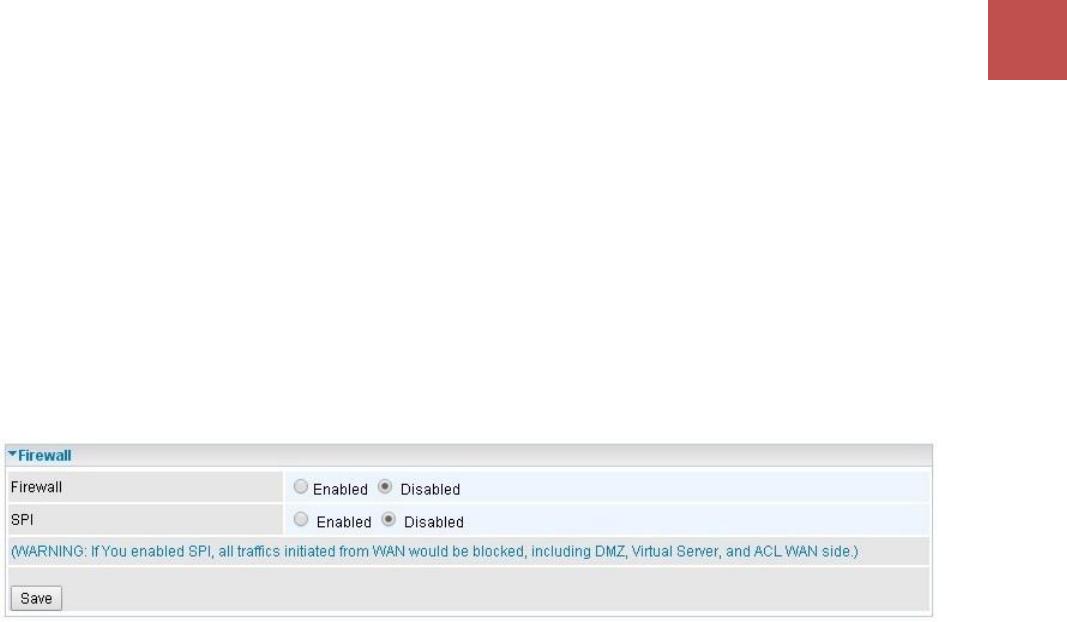
Device Configuration
Advanced Setup – Firewall
86
BEC MX-1200 Series User Manual
Advanced Setup
Advanced Setup provides advanced features including Firewall, Routing, Dynamic Routing, NAT,
VRRP, Static DNS, Time Schedule and Mail Alert for advanced users.
Firewall
Your router includes a firewall for helping to prevent attacks from hackers. In addition to this, when
using NAT (Network Address Translation) the router acts as a “natural” Internet firewall, since all PCs
on your LAN use private IP addresses that cannot be directly accessed from the Internet.
Firewall: To automatically detect and block Denial of Service (DoS) attacks, such as Ping of Death,
SYN Flood, Port Scan and Land Attack.
Enabled: Activate your firewall function.
Disabled: Deactivate the firewall function.
SPI: If you enabled SPI, all traffics initiated from WAN would be blocked, including DMZ, Virtual Server,
and ACL WAN side.
Enabled: Activate your SPI function.
Disabled: Deactivate the SPI function.
Click Save to apply the settings
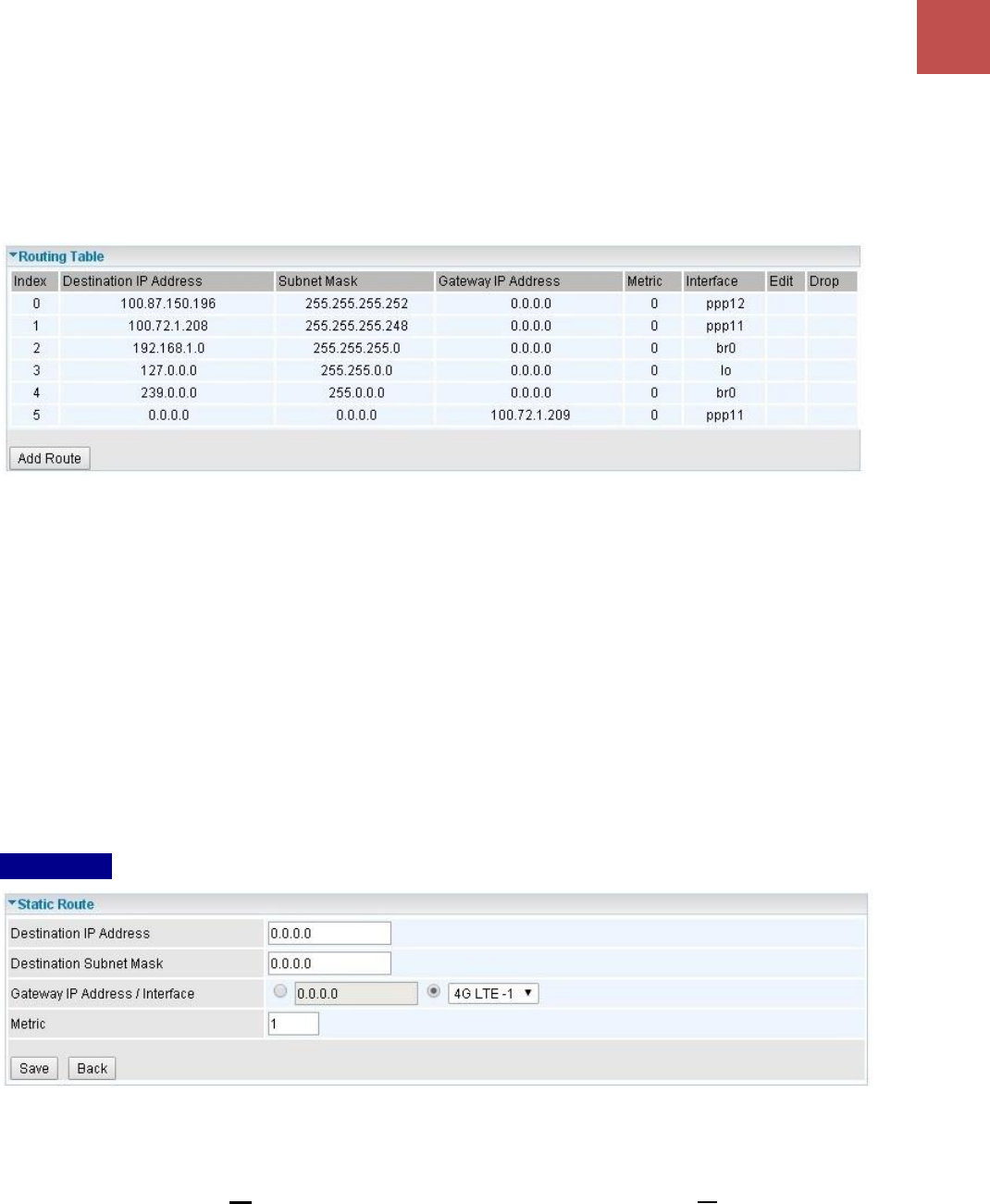
Device Configuration
Advanced Setup – Routing
87
BEC MX-1200 Series User Manual
Routing
This is static route feature. You are equipped with the capability to control the routing of all the traffic
across your network. With each routing rule created, user can specifically assign the destination where
the traffic will be routed to.
Index #: The numeric route indicator.
Destination IP Address: IP address of the destination network
Subnet Mask: The subnet mask of destination network.
Gateway IP Address: IP address of the gateway or existing interface that this route uses.
Metric: It represents the cost of transmission for routing purposes. The number need not be precise,
but it must be between 1 and 15.
Interface: Media/channel selected to append the route.
Edit: Edit the route; this icon is not shown for system default route.
Drop: Drop the route; this icon is not shown for system default route.
Add Route
Destination IP Address: This is the destination subnet IP address.
Destination Subnet Mask: The subnet mask of destination network.
Gateway IP Address or Interface: This is the gateway IP address or existing interface to which
packets are to be forwarded.
Metric: It represents the cost of transmission for routing purposes. The number need not be precise,
but it must be between 1 and 15.
Click Save to add this route
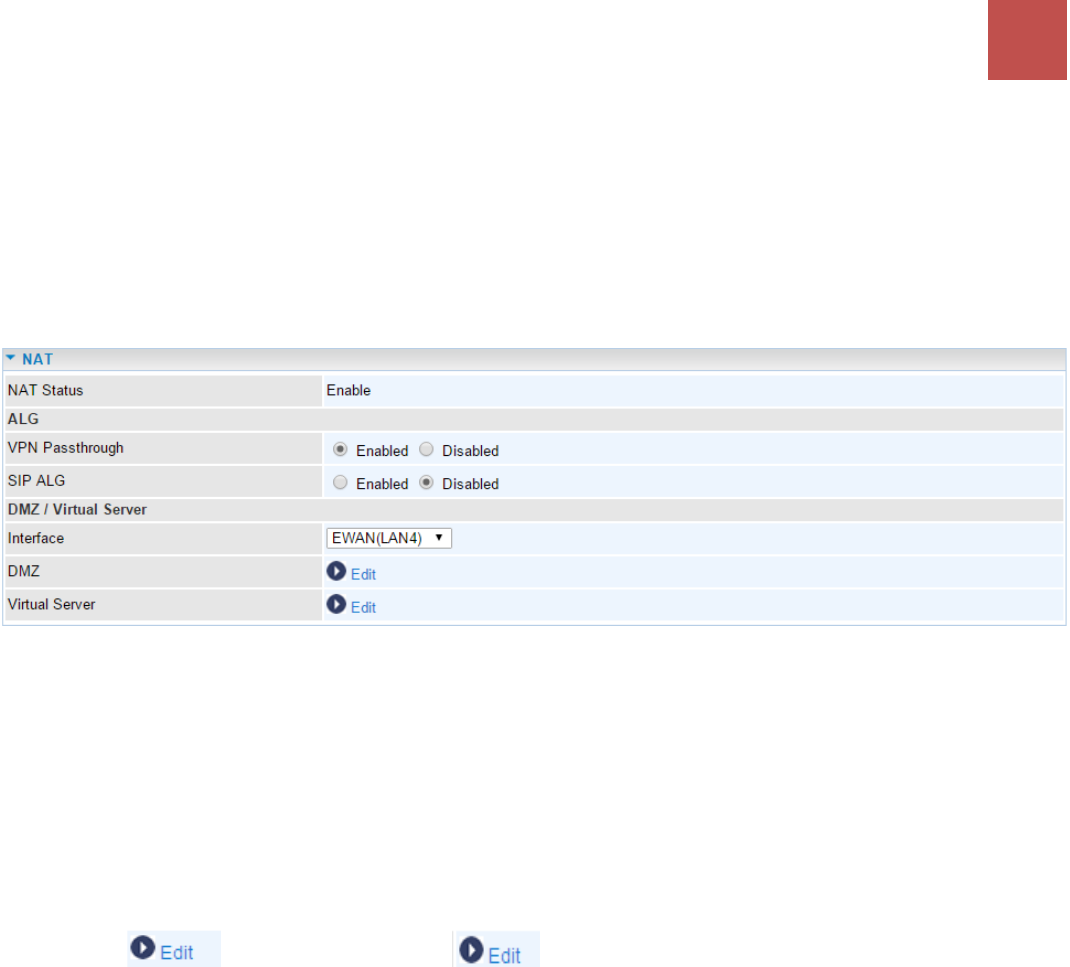
Device Configuration
Advanced Setup – NAT
88
BEC MX-1200 Series User Manual
NAT
The NAT (Network Address Translation) feature transforms a private IP into a public IP, allowing
multiple users to access the internet through a single IP account, sharing the single IP address. NAT
break the originally envisioned model of IP end-to-end connectivity across the internet so NAT can
cause problems where IPSec/ PPTP encryption is applied or some application layer protocols such as
SIP phones are located behind a NAT. And NAT makes it difficult for systems behind a NAT to accept
incoming communications.
NAT Status: Enabled. (Disabled if WAN connection is in BRIDGE mode)
VPN Passthrough: VPN pass-through is a feature of routers which allows VPN client on a private
network to establish outbound VPNs unhindered.
SIP ALG: Enable the SIP ALG when SIP phone needs ALG to pass through the NAT. Disable the SIP
ALG when SIP phone includes NAT-Traversal algorithm.
Interface: Select a WAN interface connection to allow external access to your internal network.
Service Index: Associated to EWAN interface marking each EWAN service (0-7), to select which
EWAN service the DMZ and Virtual server are applied to.
Click DMZ or Virtual Server to move on to set the DMZ or Virtual Server
parameters, which are represented in the following scenario.
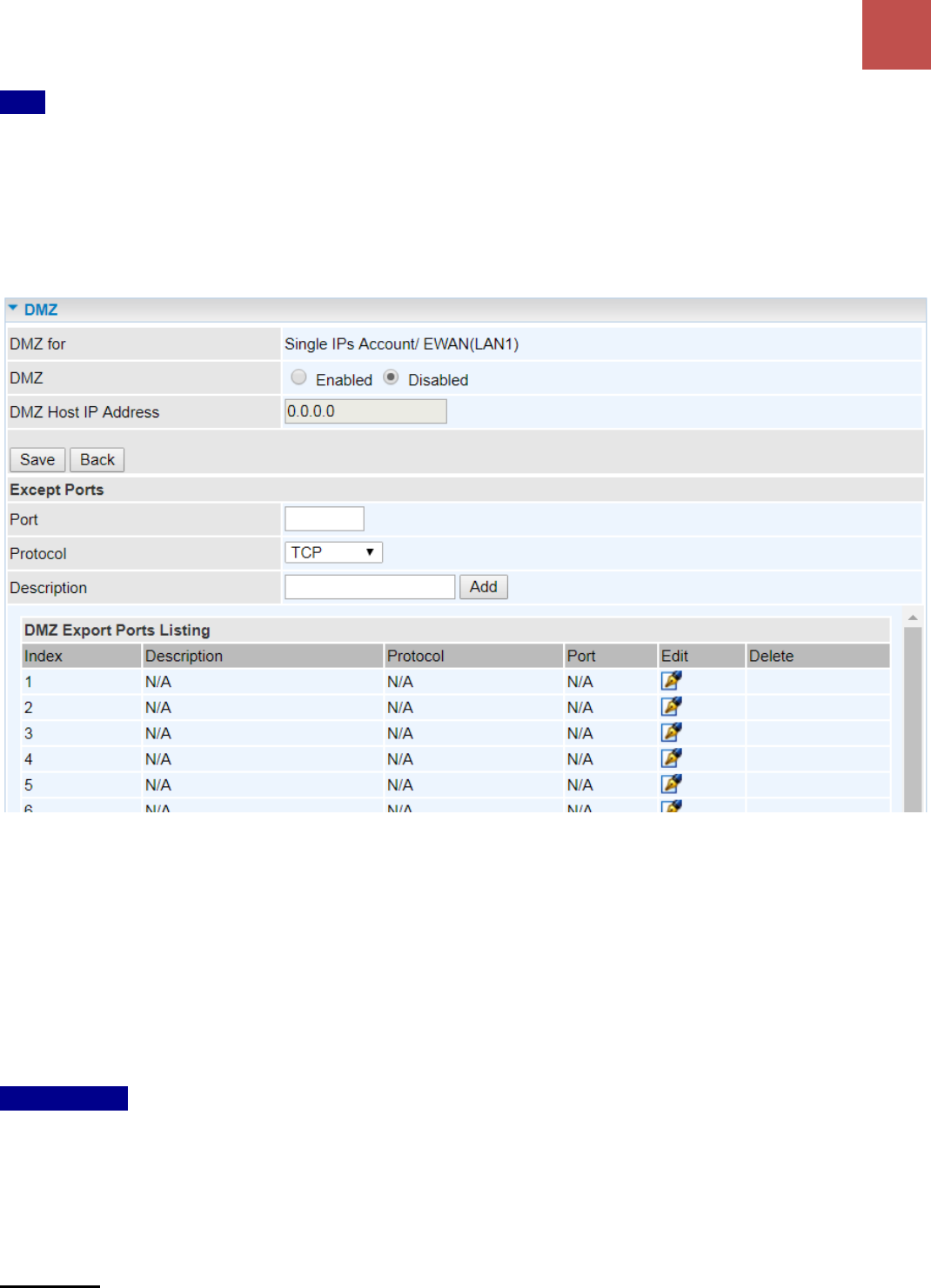
Device Configuration
Advanced Setup – NAT (DMZ)
89
BEC MX-1200 Series User Manual
DMZ
NOTE: This feature disables automatically if WAN connection is in BRIDGE mode or NAT is
being turned OFF.
The DMZ Host is a local computer exposed to the Internet. When setting a particular internal IP
address as the DMZ Host, all incoming packets will be checked by the Firewall and NAT algorithms
then passed to the DMZ host, when a packet received does not use a port number used by any other
Virtual Server entries.
DMZ for (via a WAN Interface): Allows outside network to connect in and communicate with internal
LAN devices via a specific WAN interface.
DMZ:
Enabled: Activate the DMZ function.
Disabled: Deactivate the DMZ function.
DMZ Host IP Address: Give a static IP address to the DMZ Host when Enabled radio button is
checked. Be aware that this IP will be exposed to the WAN/Internet.
Click Save to apply settings
Except Ports
Except Ports: Bypass UDP or/and TCP ports, in the list, being forwarded to the DMZ host.
Port: Enter port to be monitored.
Protocol: Enter the protocol to be monitored.
Description: Enter a description to this rule.
Example: Skip port 80 (UDP/TCP) in the list. All Incoming request to access to port 80 (Web GUI)
will be forwarded to the embedded HTTP server of MX-1200 instead of the DMZ host.
Click Add to add an entry to the Except Listing.
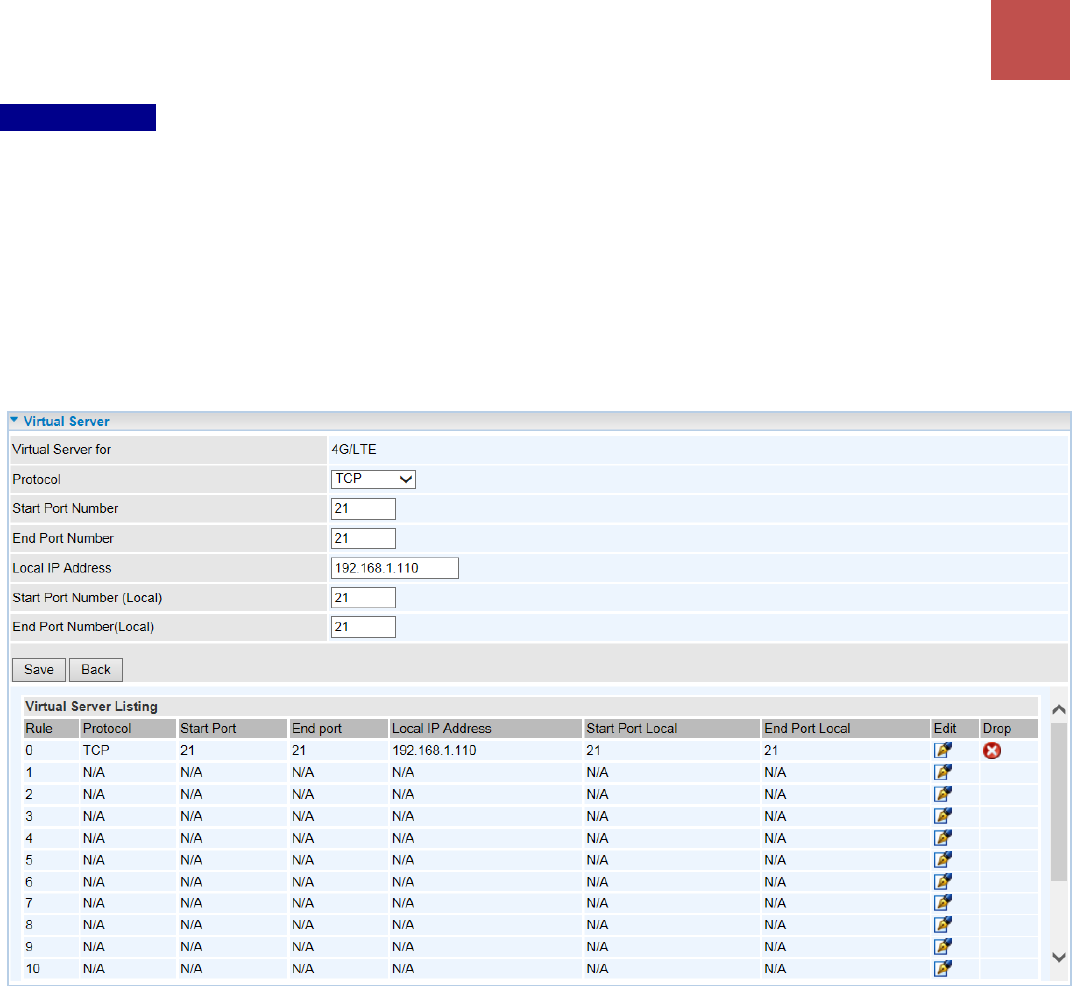
Device Configuration
Advanced Setup – NAT (Virtual Server)
90
BEC MX-1200 Series User Manual
Virtual Server
NOTE: This feature disables automatically if WAN connection is in BRIDGE mode or NAT is
being turned OFF.
Virtual Server is also known as Port Forwarding that allows MX-1200 to direct all incoming traffic to
the servers on the LAN.
Configure a virtual rule in MX-1200 for remote users accessing services such as Web or FTP services
via the public (WAN) IP address that can be automatically redirected to local servers in the LAN
network. Depending on the requested service (TCP/UDP port number), the device redirects the
external service request to the appropriate server within the LAN network.
Virtual Server for: Indicate the related WAN interface to allow outside network to connect in and
communicate with internal LAN devices.
Protocol: Choose the application protocol.
Start / End Port Number: Enter a port or port range you want to forward.
(Example: Start / End: 1000 or Start: 1000, End: 2000).
The starting port must be greater than zero (0). The end port must be greater than or equal to the
start port.
Local IP Address: Enter your server IP address in this field.
Start / End Port Number (Local): Enter the start / end port number of the local application (service).

Device Configuration
Advanced Setup – NAT (Virtual Server)
91
BEC MX-1200 Series User Manual
Examples of well-known and registered port numbers are shown below. For further information, please
see IANA’s website at http://www.iana.org/assignments/port-numbers
Well-known and Registered Ports
Port Number
Protocol
Description
21
TCP
FTP Control
22
TCP & UDP
SSH Remote Login Protocol
23
TCP
Telnet
25
TCP
SMTP (Simple Mail Transfer Protocol)
53
TCP & UDP
DNS (Domain Name Server)
69
UDP
TFTP (Trivial File Transfer Protocol)
80
TCP
World Wide Web HTTP
110
TCP
POP3 (Post Office Protocol Version 3)
443
TCP & UDP
HTTPS
1503
TCP
T.120
1720
TCP
H.323
7070
UDP
RealAudio
Using port forwarding does have security implications, as outside users will
be able to connect to PCs on your network. For this reason you are advised
to use specific Virtual Server entries just for the ports your application
requires, instead of using DMZ. As doing so will result in all connections
from the WAN attempt to access to your public IP of the DMZ PC specified.
If you have disabled the NAT option in the WAN-ISP section, the Virtual
Server function will hence be invalid.
If the DHCP server option is enabled, you have to be very careful in
assigning the IP addresses of the virtual servers in order to avoid conflicts.
The easiest way of configuring Virtual Servers is to manually assign static
IP address to each virtual server PC, with an address that does not fall into
the range of IP addresses that are to be issued by the DHCP server. You
can configure the virtual server IP address manually, but it must still be in
the same subnet as the router.
Attention
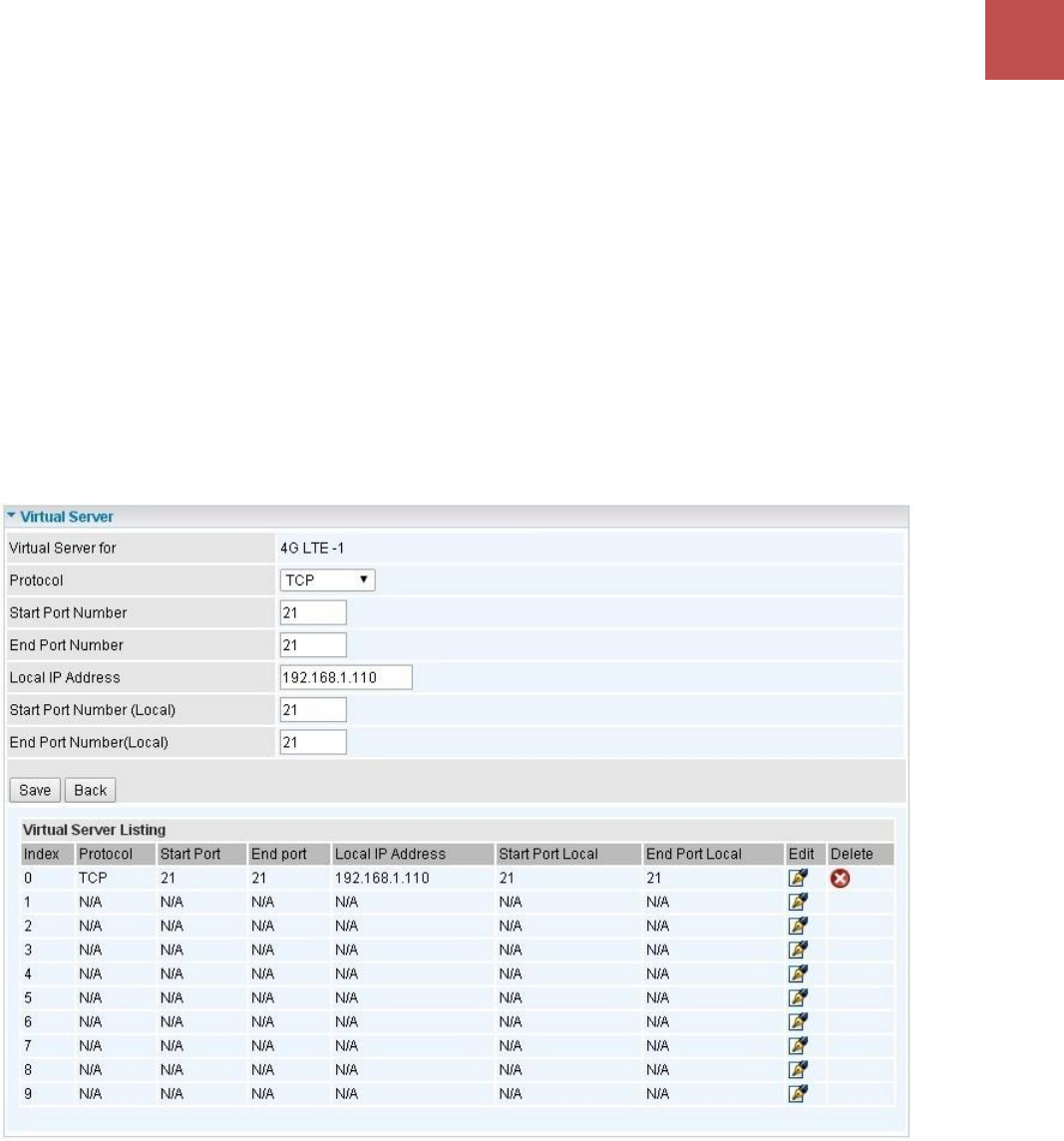
Device Configuration
Advanced Setup – NAT (Example)
92
BEC MX-1200 Series User Manual
Example: How to setup Port Forwarding for port 21 (FTP server)
If you have a FTP server in your LAN network and want others to access it through WAN.
Step 1: Assign a static IP to your local computer that is hosting the FTP server.
Step 2: Login to the Gateway and go to Configuration / Advanced Setup / NAT / Virtual Server.
FTP server uses TCP protocol with port 21.
Enter ”21” to Start and End Port Number. The MX-1200 will accept port 21 requests from WAN side.
Enter the static IP assigned to the local PC that is hosting the FTP server. Ex: 192.168.1.102
Enter "21” to Local Start and End Port number. The MX-1200 will forward port 21 request from WAN
to the specific LAN PC (Example: 192.168.1.102) in the network.
Step 3: Click Save to save settings.
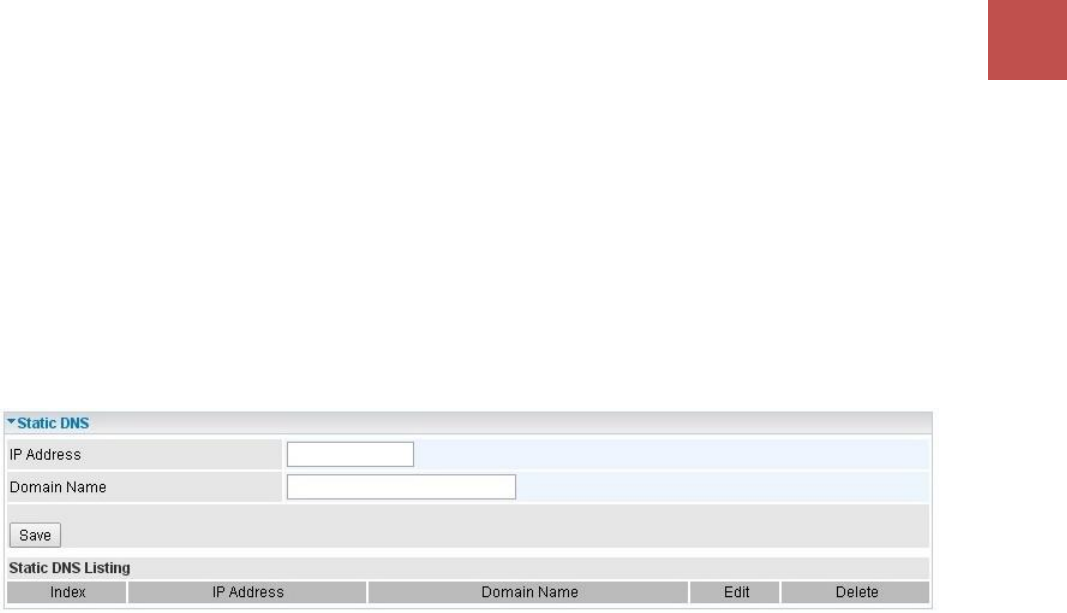
Device Configuration
Advanced Setup – Static DNS
93
BEC MX-1200 Series User Manual
Static DNS
The Domain Name System (DNS) is a hierarchical naming system built on a distributed database for
computers, services, or any resource connected to the Internet or a private network associates various
information with domain names assigned to each of the participating entities. Most importantly, it
translates domain names meaningful to humans into the numerical identifiers associated with
networking equipment for the purpose of locating and addressing these devices worldwide.
An often-used analogy to explain the Domain Name System is that it serves as the phone book for the
Internet by translating human-friendly computer hostnames into IP addresses. For example, the
domain name www.example.com can be translated into the addresses 192.0.32.10 (IPv4).
IP Address: The IP address you are going to give a specific domain name.
Domain Name: The friendly domain name for the IP address.
Click Save to apply your settings.
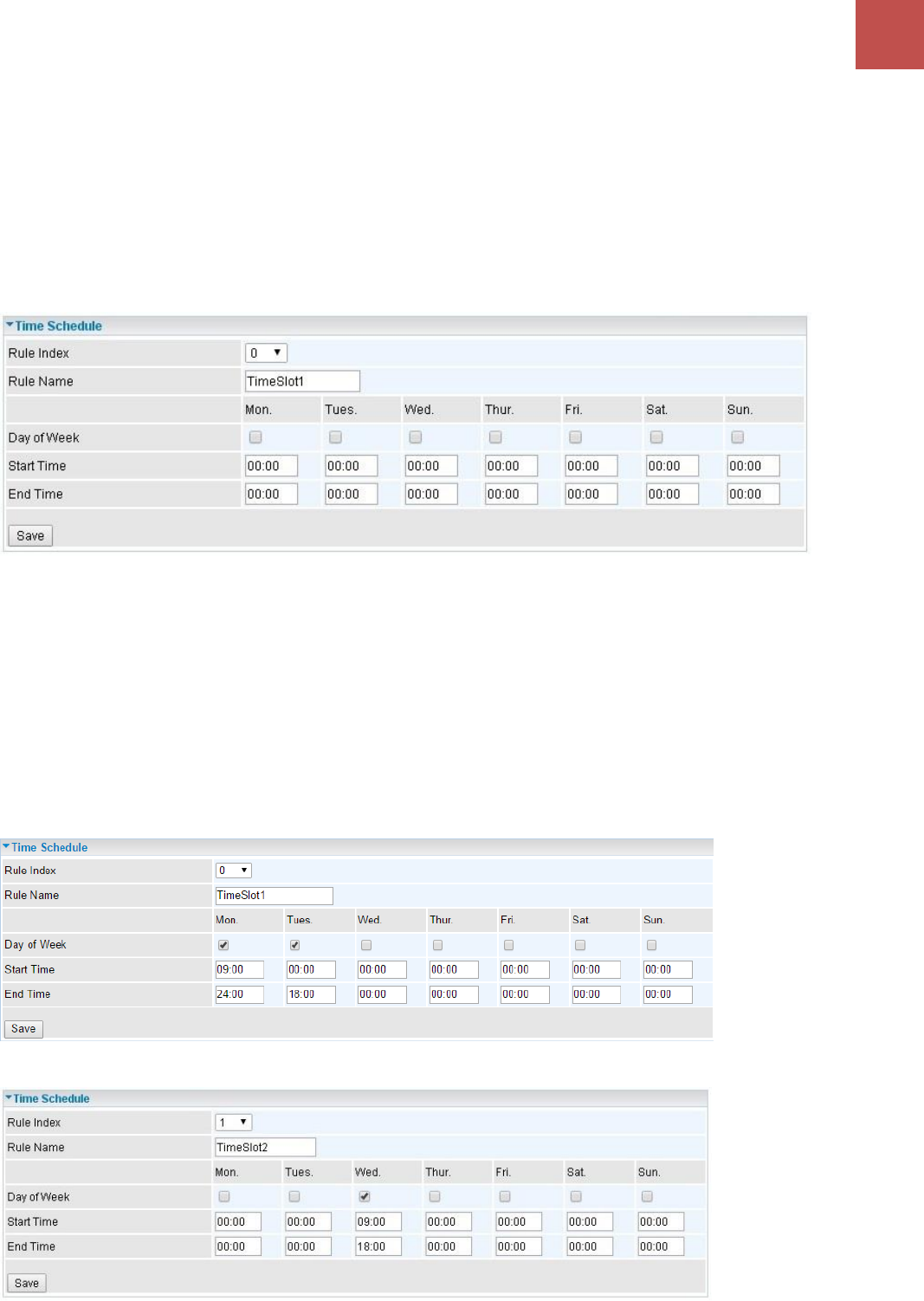
Device Configuration
Advanced Setup – Time Schedule
94
BEC MX-1200 Series User Manual
Time Schedule
The Time Schedule supports up to 16 timeslots which helps you to manage your Internet connection.
In each time profile, you may schedule specific day(s) i.e. Monday through Sunday to restrict or
allowing the usage of the Internet by users or applications.
This Time Schedule correlates closely with router’s time, since router does not have a real time clock
on board; it uses the Simple Network Time Protocol (SNTP) to get the current time from an SNTP
server from the Internet.
Time Index: The rule indicator (0-15) for identifying each timeslot.
Name: User-defined identification for each time period.
Day of Week: Mon. to Sun. Specify the time interval for each timeslot from “Day of Week”.
Start Time: The starting point of the interval for the timeslot, anytime in 00:00 – 24:00.
End Time: The ending point of the interval for the timeslot, anytime in 00:00 – 24:00.
Click Save to apply your settings.
Example, you can add a timeslot named “TimeSlot1” which features a period from 9:00 of Monday to
18:00 of Tuesday.
Another TimeSlot2 spanning from 09:00 to 18:00 of Wednesday
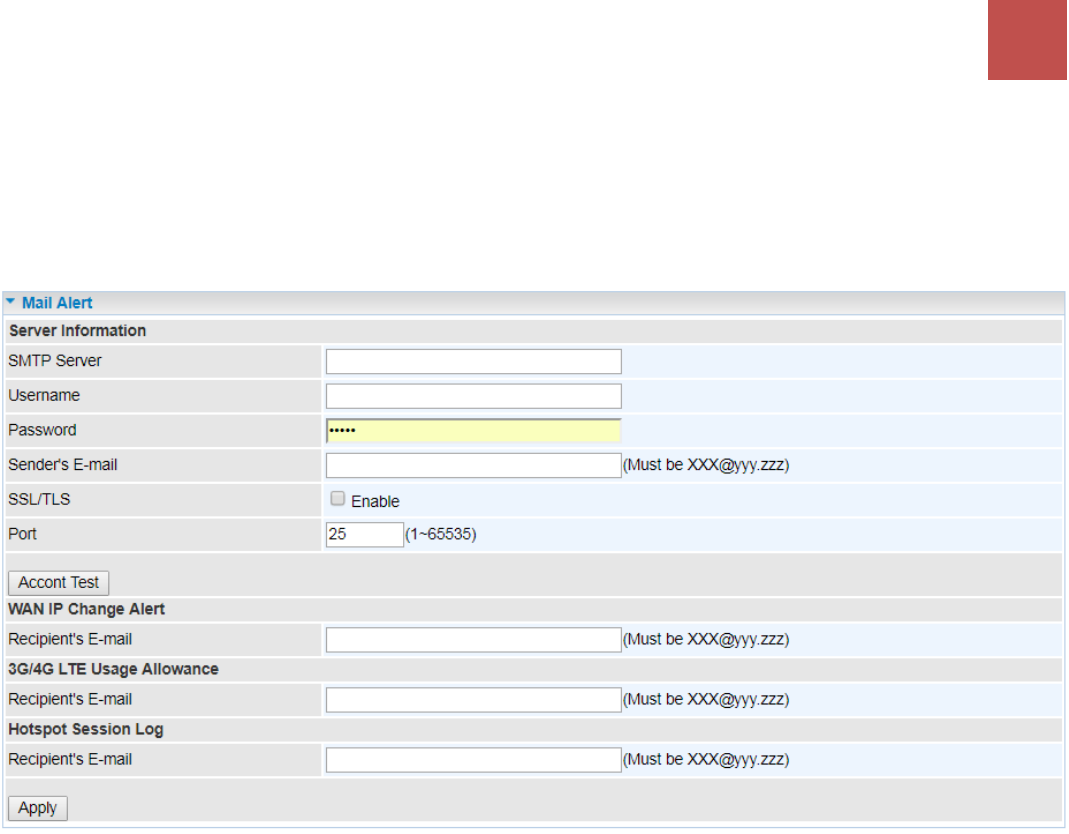
Device Configuration
Advanced Setup – Mail Alert
95
BEC MX-1200 Series User Manual
Mail Alert
Mail alert is designed to keep system administrator or other relevant personnel alerted of any
unexpected events that might have occurred to the network computers or server for monitoring
efficiency. With this alert system, appropriate solutions may be tackled to fix problems that may have
arisen so that the server can be properly maintained.
SMTP Server: Enter the SMTP server that you would like to use for sending emails.
Username: Enter the username of your email account to be used by the SMTP server.
Password: Enter the password of your email account.
Sender’s Email: Enter your email address.
SSL/TLS: Check to whether to enable SSL encryption feature.
Port: the port, default is 25.
Account Test: Click the button to test the connectivity and feasibility to your sender’s e-mail.
Recipient’s Email (WAN IP Change Alert): Enter a valid e-mail address to receive an alert message
when WAN IP change has been detected.
Recipient’s Email (3G/4G-LTE Usage Allowance): Enter a valid e-mail address to receive an alert
message when the 3G over Usage Allowance occurs.
Hotspot Session Log: Enter a valid e-mail address to receive hotspot access information.
Click Apply to save settings
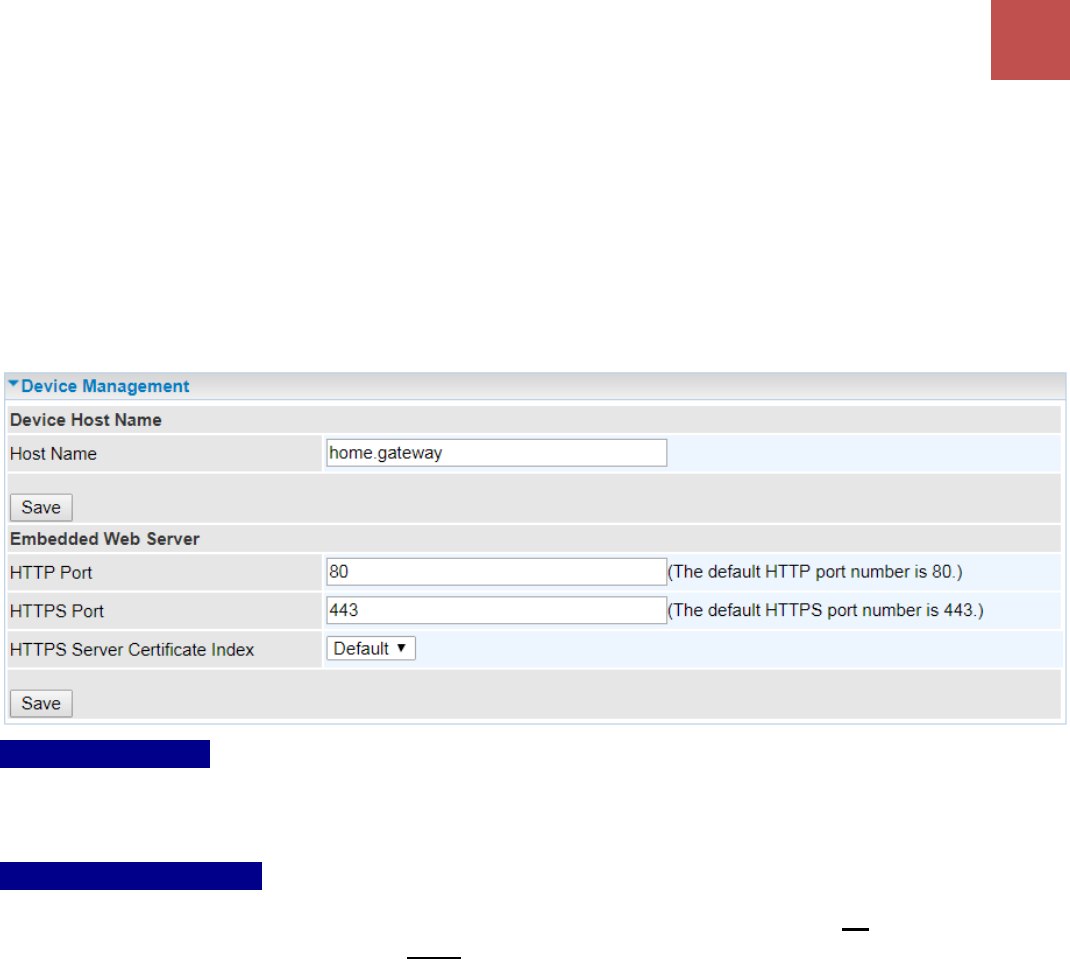
Device Configuration
Access Management – Device Management
96
BEC MX-1200 Series User Manual
Access Management
Features including Device Management, SNMP, Syslog, Universal Plug & Play, Dynamic DNS,
Access Control, Packet Filter, CWMP (TR-069), Parental Control, SAMBA & FTP Server, and
BECentral Management.
Device Management
Device Host Name
Host Name: Enter the host name of the router. Default is home.gateway
Embedded Web Server
HTTP Port: It is the embedded web server (Web GUI) accessing port, default is 80. It can be changed
other port other than port 80, e.g. port 8080.
HTTPS Port: Similar to HTTP which is an unencrypted communication using port 80. HTTPS is
encrypted by SSL using port 443 instead.
HTTPS Server Certificate Index: HTTPS known as HTTP-over-SSL tunnel protocol. Select a
certificate to identify the system web server. When accessing to the web server (Web GUI), the
browser will issue a warning page.
To import certificates, go to Maintenance >> Certificate Management to upload files. Otherwise,
select Default certificate and CA.
Click Save to apply settings.
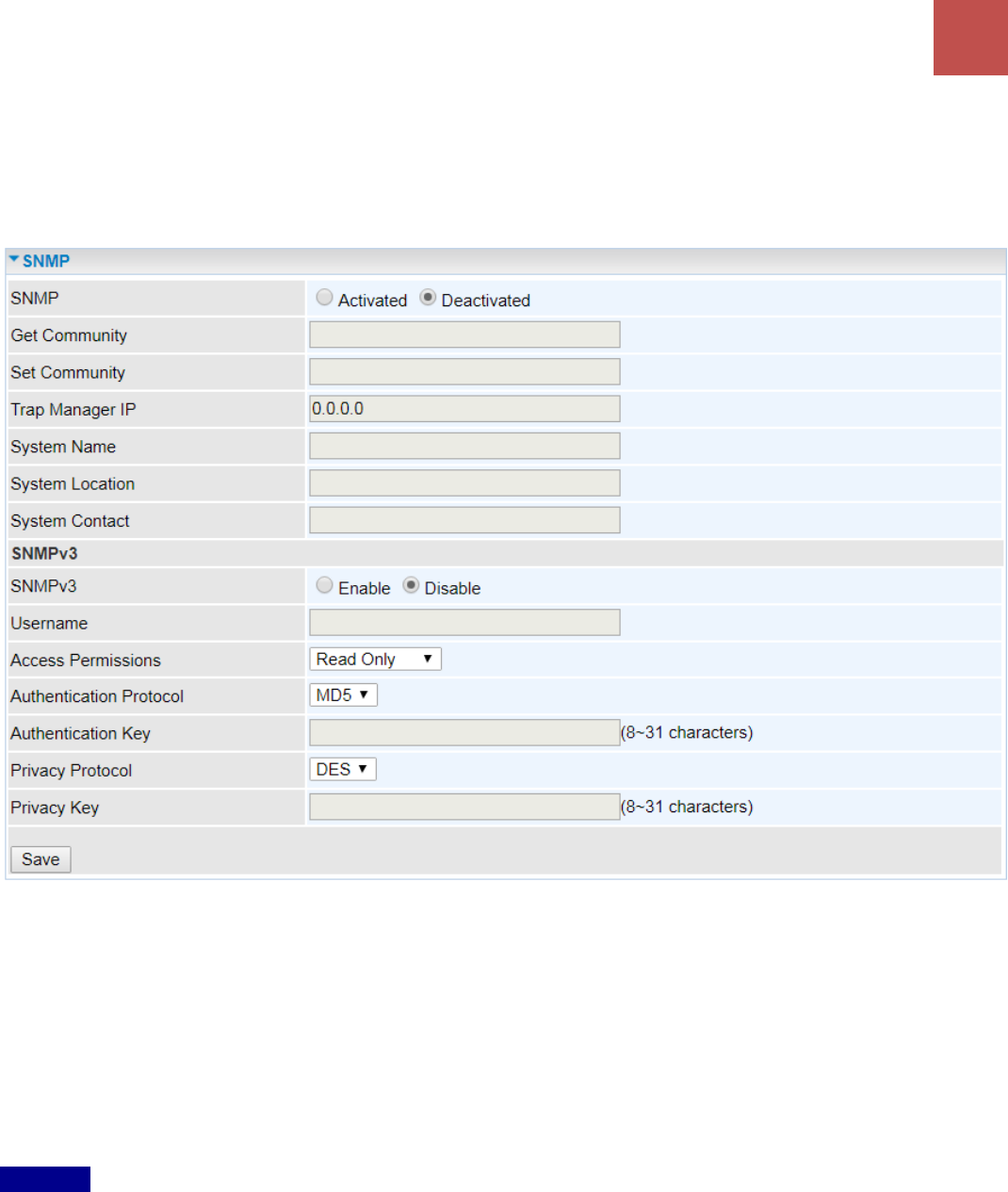
Device Configuration
Access Management – SNMP
97
BEC MX-1200 Series User Manual
SNMP
Simple Network Management Protocol (SNMP) is a protocol used for exchanging management
information between network devices. The MX-1200 serves as a SNMP agent that allows a manager
station to manage and monitor the router through the network.
SNMP: Activate to enable SNMP.
Get Community: Type the Get Community, which is the password for the incoming Get-and-GetNext
requests from the management station.
Set Community: Type the Set Community, which is the password for incoming Set requests from the
management station.
Trap Manager IP: Enter the IP of the server receiving the trap message (when some exception occurs)
sent by this SNMP agent.
System Name / Location / Contact: String descriptions of the SNMP agent.
SNMPv3
SNMPv3: Enable to activate the SNMPv3.
User Name: Enter the name allowed to access the SNMP agent.
Access Permissions: Set the access permissions for the user; RO--read only and RW--read and
writer.
Authentication Protocol: Select the authentication protocol, MD5 and SHA. SNMP agent can
communicate with the manager station through authentication and encryption to secure the message
exchange. Set the authentication and encryption information here and below.
Authentication Key: Set the authentication key, 8-31 characters.

Device Configuration
Access Management – SNMP
98
BEC MX-1200 Series User Manual
Privacy Protocol: Select the privacy mode, DES and AES.
Privacy Key: Set the privacy key, 8-31 characters.
Click Save to apply settings.
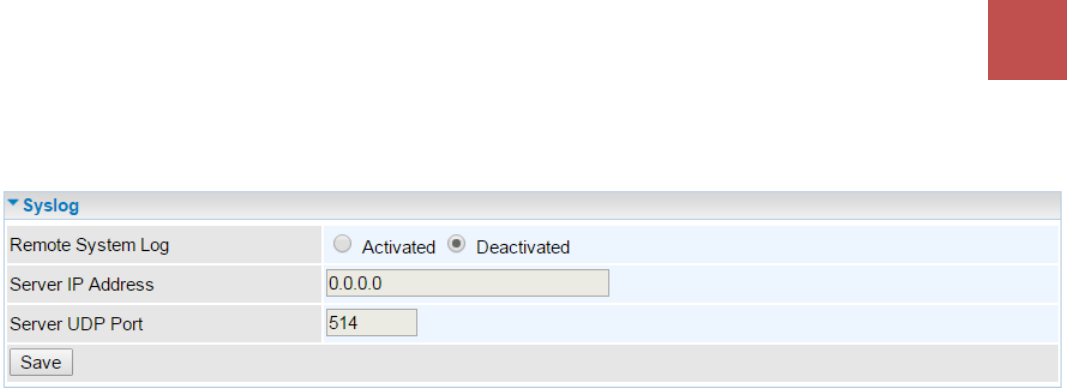
Device Configuration
Access Management – Syslog
99
BEC MX-1200 Series User Manual
Syslog
Use the Syslog to collect system event information to a remote log server.
Remote System Log: Select Activated to enable this feature
Server IP Address: Assign the remote log server IP address.
Server UDP Port: Assign the remote log server port, 514 is commonly used.
Click Save to apply settings.
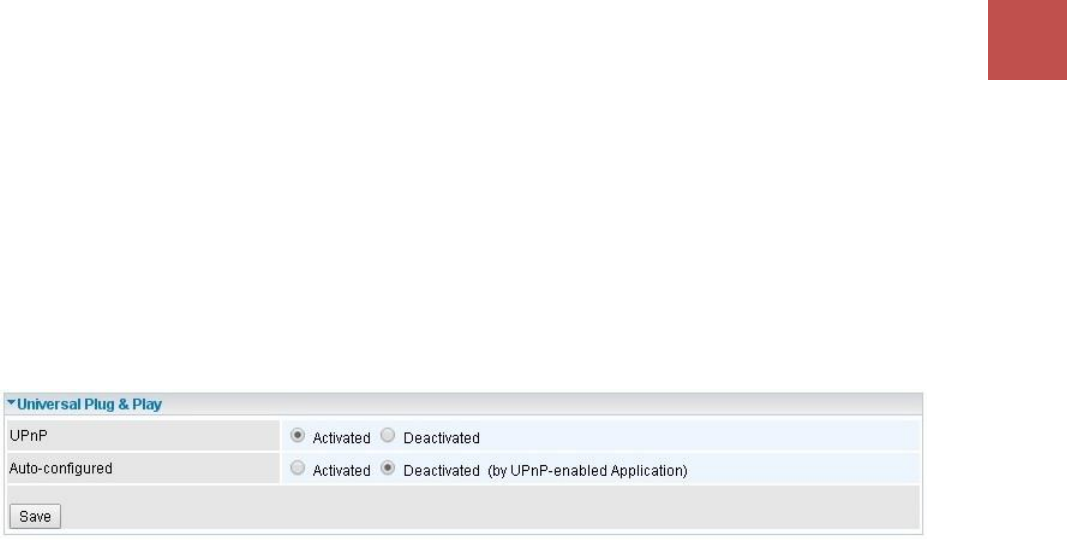
Device Configuration
Access Management – UPnP
100
BEC MX-1200 Series User Manual
Universal Plug & Play
UPnP offers peer-to-peer network connectivity for PCs and other network devices, along with control
and data transfer between devices. UPnP offers many advantages for users running NAT routers
through UPnP NAT Traversal, and on supported systems makes tasks such as port forwarding much
easier by letting the application control the required settings, removing the need for the user to control
advanced configuration of their device.
Both the user’s Operating System and the relevant application must support UPnP in addition to the
router.
UPnP: Select this checkbox to activate UPnP. Be aware that anyone could use an UPnP application
to open the web configuration’s login screen without entering the MX-1200's IP address
Auto-configured: Select this check box to allow UPnP-enabled applications to automatically
configure the MX-1200 so that they can communicate through the MX-1200, for example by using NAT
traversal, UPnP applications automatically reserve a NAT forwarding port in order to communicate
with another UPnP enabled device; this eliminates the need to manually configure port forwarding for
the UPnP enabled application.
Click Save to apply the settings.
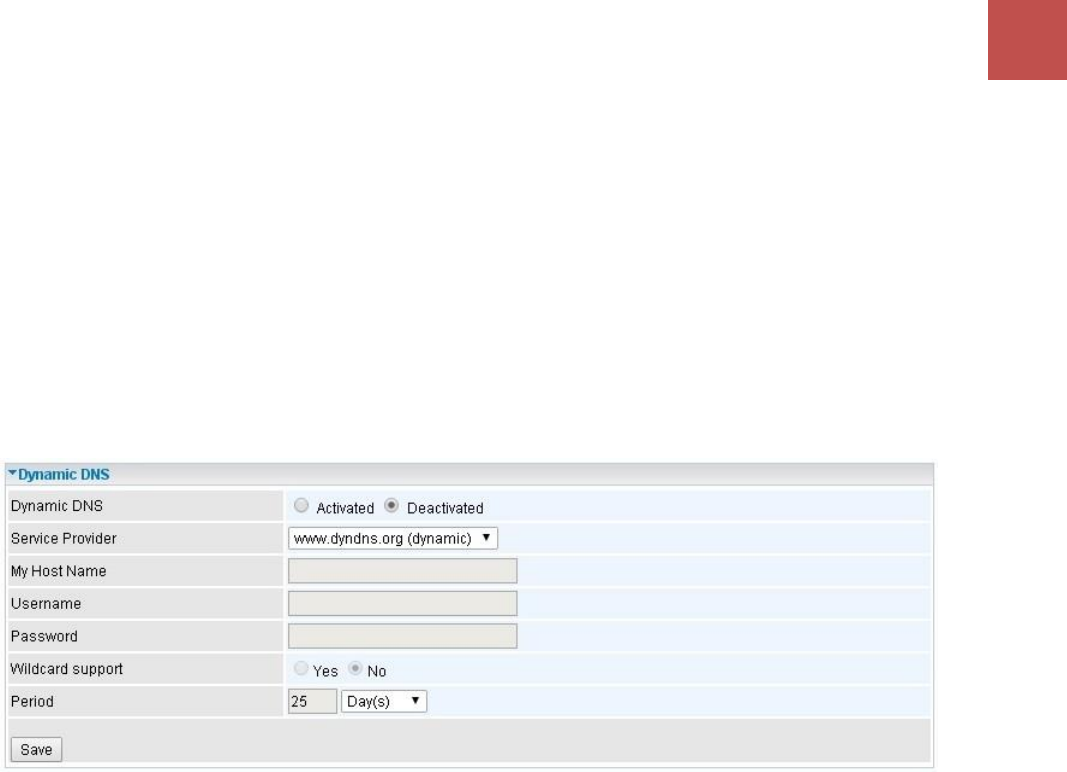
Device Configuration
Access Management – DDNS
101
BEC MX-1200 Series User Manual
Dynamic DNS (DDNS)
The Dynamic DNS function allows you to alias a dynamic IP address to a static hostname, allowing
users whose ISP does not assign them a static IP address to use a domain name. This is especially
useful for hosting servers via your internet connection, so that anyone wishing to connect to you may
use your domain name, rather than having to use your dynamic IP address, which changes from time
to time. This dynamic IP address is the WAN IP address of the router, which is assigned to you by your
ISP.
Here users can register different WAN interfaces with different DNS Providers.
If you do not have a DDNS account, please choose a DDNS Service Provider from the list then go to
their website to create an account first.
Dynamic DNS: Select this check box to activate Dynamic DNS.
Service Provider: Select from drop-down menu for the appropriate service provider, for example:
www.dyndns.org.
My Host Name: Type the domain name assigned to your MX-1200 by your Dynamic DNS provider.
Username / Password: Enter the user name and password of the account you created with this
service provider.
Wildcard support: Select this check box to enable DYNDNS Wildcard.
Period: Set the time period on how often the MX-1200 will update the DDNS server with your current
external IP address.
Click Save to apply the settings.
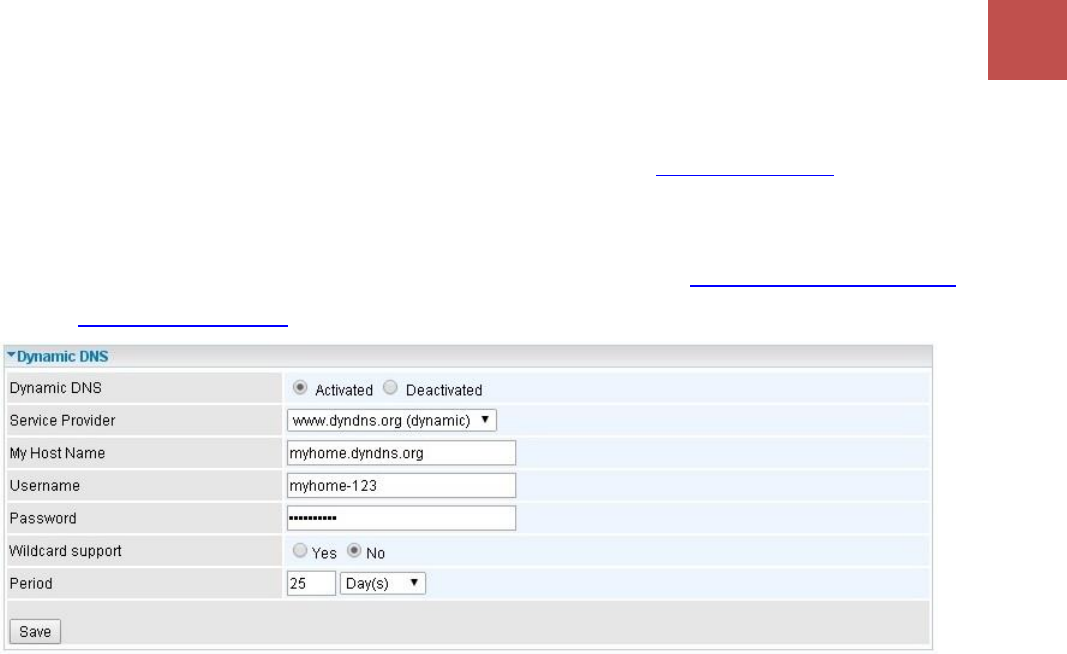
Device Configuration
Access Management – DDNS (Example)
102
BEC MX-1200 Series User Manual
Example: How to register a DDNS account
If you do not have an account with Dynamic DNS, please go to www.dyndns.org to register an account
first.
User test1 register a Dynamic Domain Names in DDNS provider http://www.dyndns.org/ .
DDNS: www.hometest.com using username/password test/test
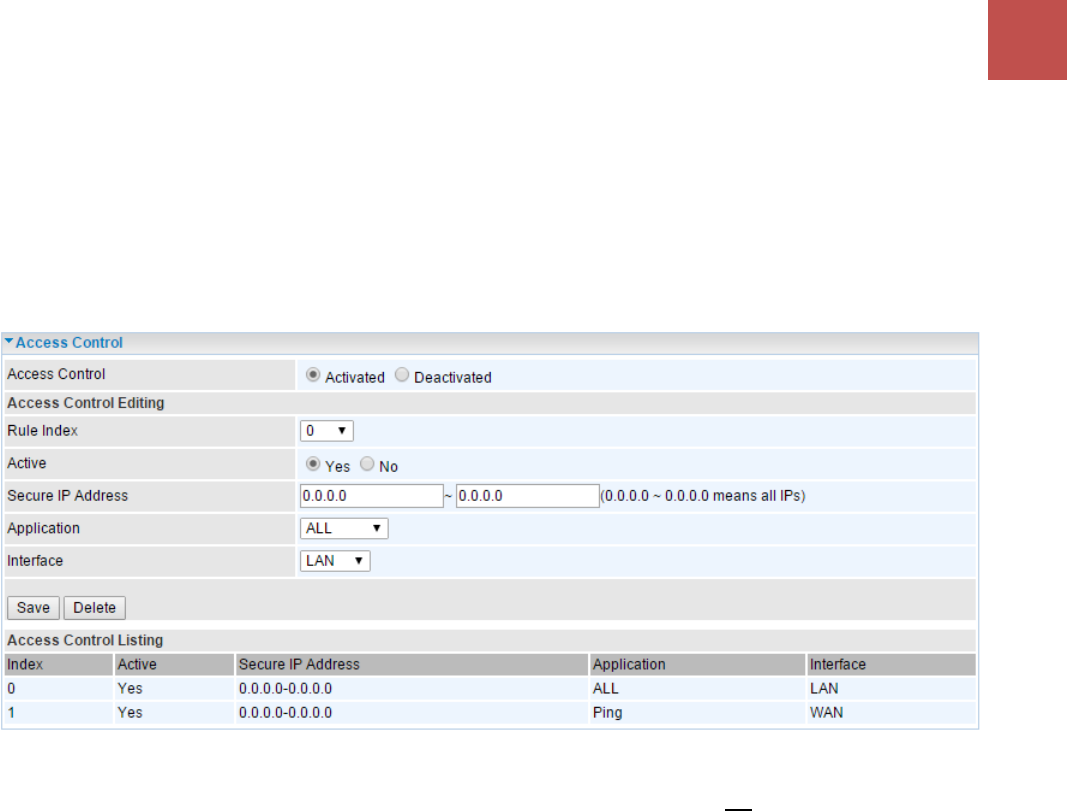
Device Configuration
Access Management – Access Contro
l
103
BEC MX-1200 Series User Manual
Access Control
Access Control Listing allows you to determine which services/protocols can access the MX-1200
interface from which computers. It is a management tool aimed to allow IPs (set in secure IP address)
to access specified embedded applications (Web, FTP, etc., user can set) through some specified
interface (LAN, WAN or both). User can have an elaborate understanding in the examples below.
The maximum number of entry is 16.
Access Control: Select whether to make Access Control function available.
Rule Index: The numeric rule indicator. The maximum entry is up to 16, ranging from 0 to 15.
Active: Yes to activate the rule.
Secure IP Address: The default 0.0.0.0 allows any client to use this service to manage the MX-1200.
Type an IP address range to restrict access to the client(s) without a matching IP address.
Application: Choose a service that you want to all access to all the secure IP clients. The drop-down
menu lists all the common used applications.
Interface: Select the access interface. Choices are LAN, WAN and Both.
Click Save to apply the settings.
By default, the “Access Control” has two default rules.
Default Rule 1: (Index 1), a rule to allow only clients from LAN to have access to all embedded
applications (Web, FTP, etc). Under this situation, clients from WAN cannot access the router even
from Ping.
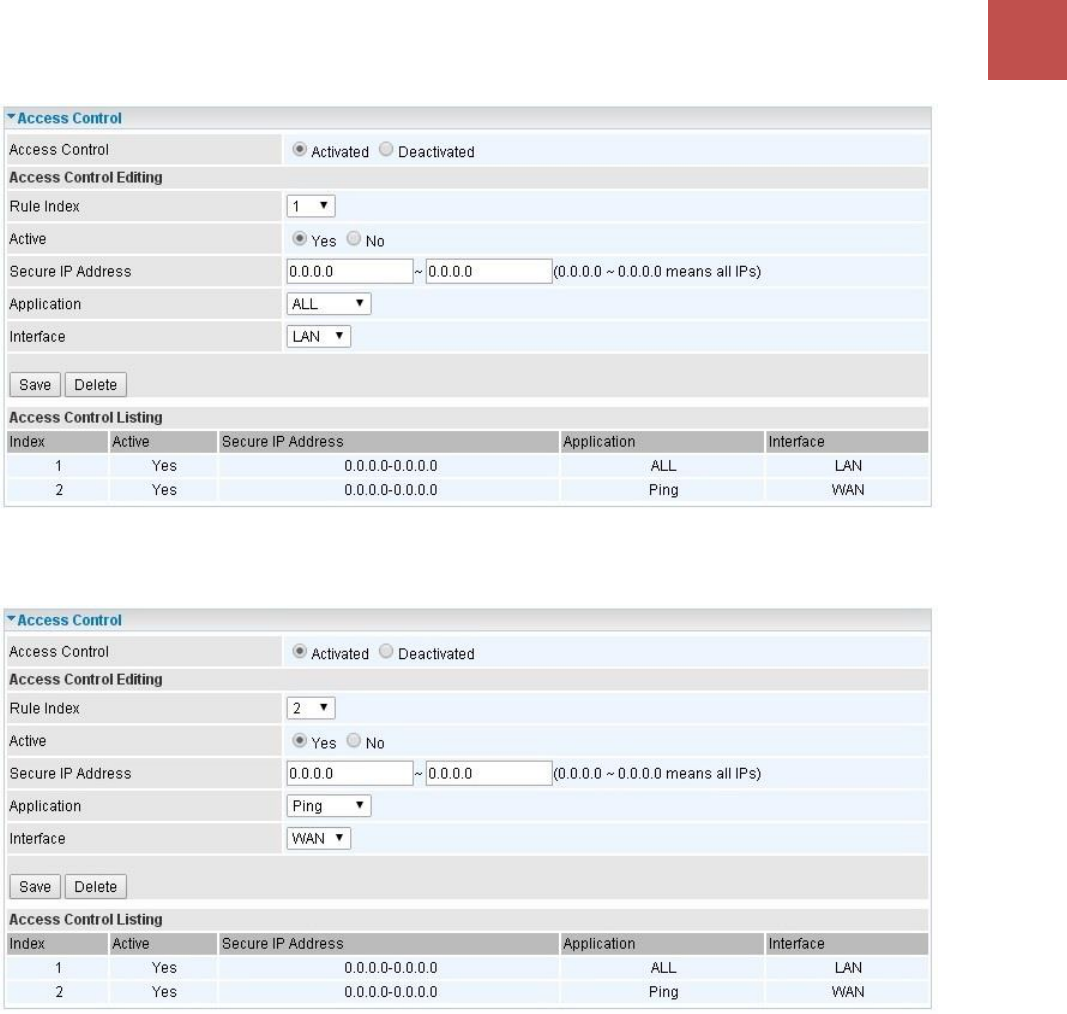
Device Configuration
Access Management – Access Contro
l
104
BEC MX-1200 Series User Manual
Default Rule 2: (Index 2), an ACL rule to open Ping to WAN side.
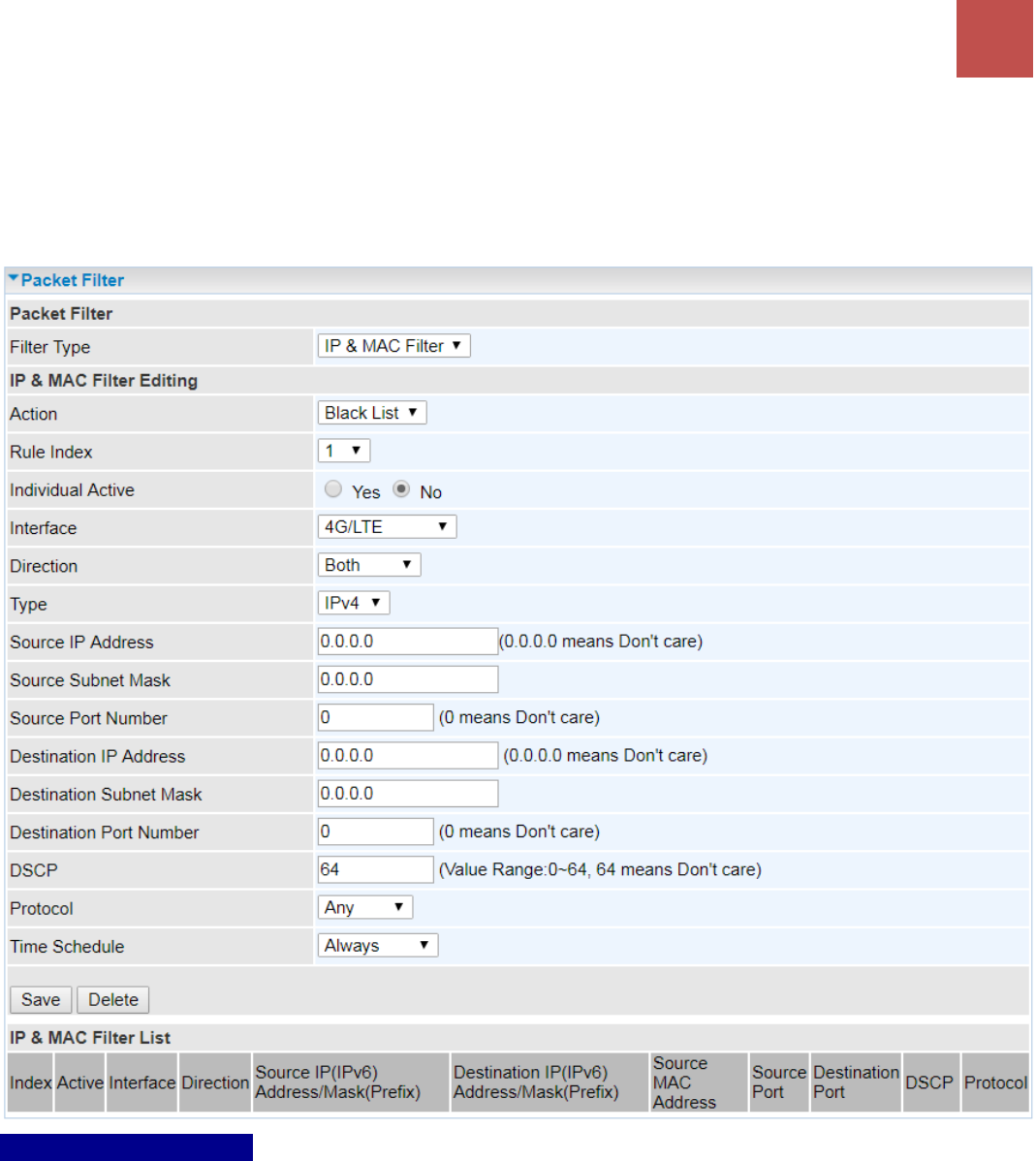
Device Configuration
Access Management – Packet Filter (IP & MAC Filter)
105
BEC MX-1200 Series User Manual
Packet Filter
You can filter the packages by MAC address, IP address, Protocol, Port number and Application or
URL.
❖ Filter Type - IP & MAC Filter
IP & MAC Filter Editing
Rule Index: The numeric rule indicator.
Individual Active: Yes to enable the rule.
Action: This is how to deal with the packets matching the rule. Allow please select White List or Black
selecting Black List.
Interface: Select to determine which interface the rule will be applied to.
Direction: Select to determine whether the rule applies to outgoing packets, incoming packets or
packets of both directions.
Type: Choose type of field you want to specify to monitor. Select “IPv4” for IPv4 address, port number
and protocol. Select “IPv6” for IPv6 address, port number and protocol. Select “MAC” for MAC address.
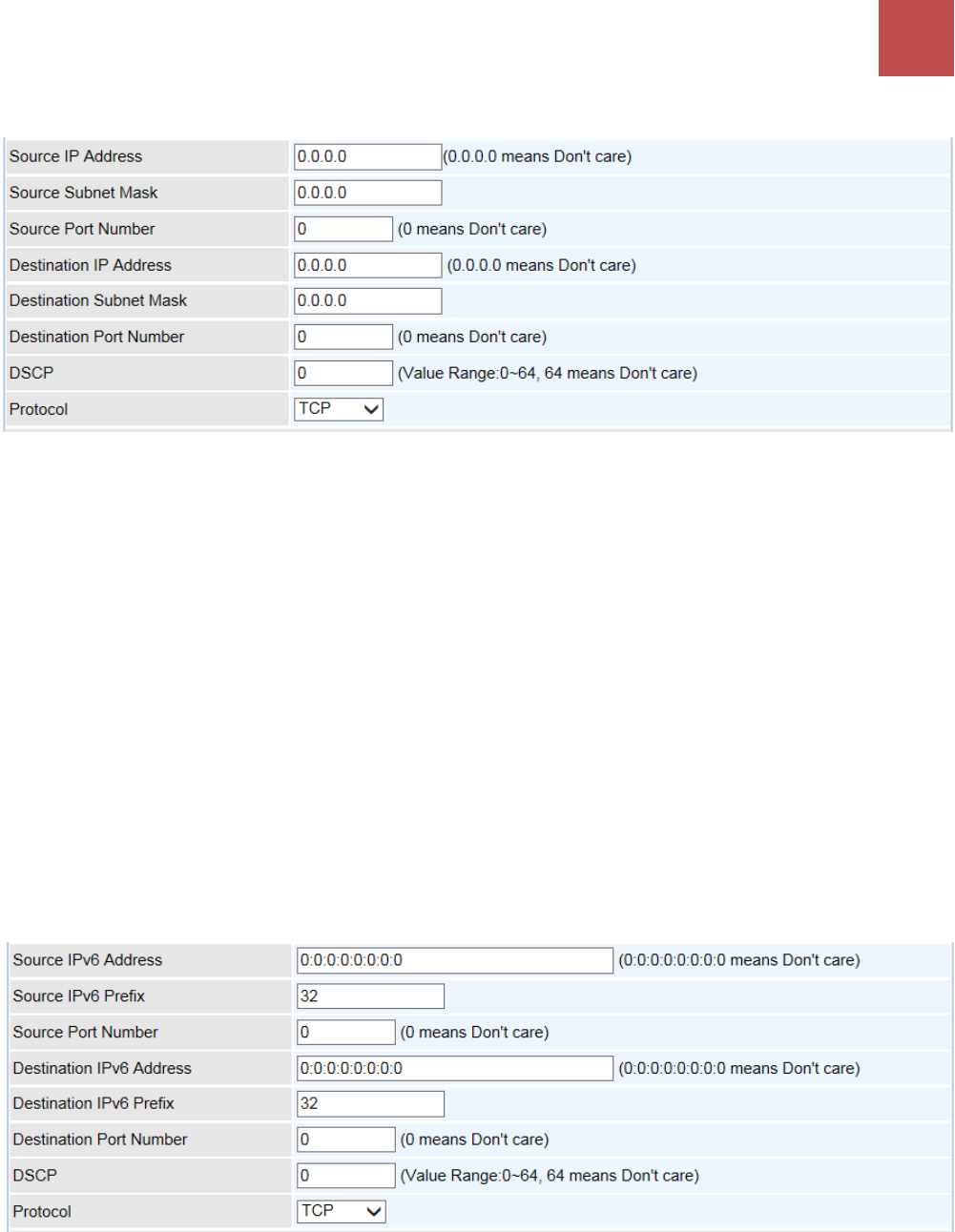
Device Configuration
Access Management – Packet Filter (IP & MAC Filter)
106
BEC MX-1200 Series User Manual
IPv4
Source IP Address: The source IP address of packets to be monitored. 0.0.0.0 means “Don’t
care”.
Source Subnet Mask: Enter the subnet mask of the source network.
Source Port Number: The source port number of packets to be monitored. 0 means “Don’t
care”.
Destination IP Address: The destination IP address of packets to be monitored. 0.0.0.0
means “Don’t care”.
Destination Subnet Mask: Enter the subnet mask of the destination network.
Destination Port Number: This is the Port that defines the application. (E.g. HTTP is port 80.)
DSCP: DSCP: Differentiated Services Code Point, it is recommended that this option be
configured by an advanced user or keep 0. (0 means Don’t care.)
Protocol: Specify the packet type (TCP, UDP, ICMP, and ICMPv6) that the rule applies to.
IPv6
Source IP (IPv6) Address/ Prefix: The source IP address or range of packets to be monitored.
Source Port Number: The source port number of packets to be monitored.
Destination IP (IPv6) Address/ Prefix: The destination subnet IP address.
Destination Port Number: This is the Port or Port Ranges that defines the application.
DSCP: show the set DSCP.
Protocol: It is the packet protocol type used by the application. Select either TCP or UDP or

Device Configuration
Access Management – Packet Filter (IP & MAC Filter)
107
BEC MX-1200 Series User Manual
ICMP or ICMPv6
MAC
Source MAC Address: show the MAC address of the rule applied.
Click Save to apply settings.
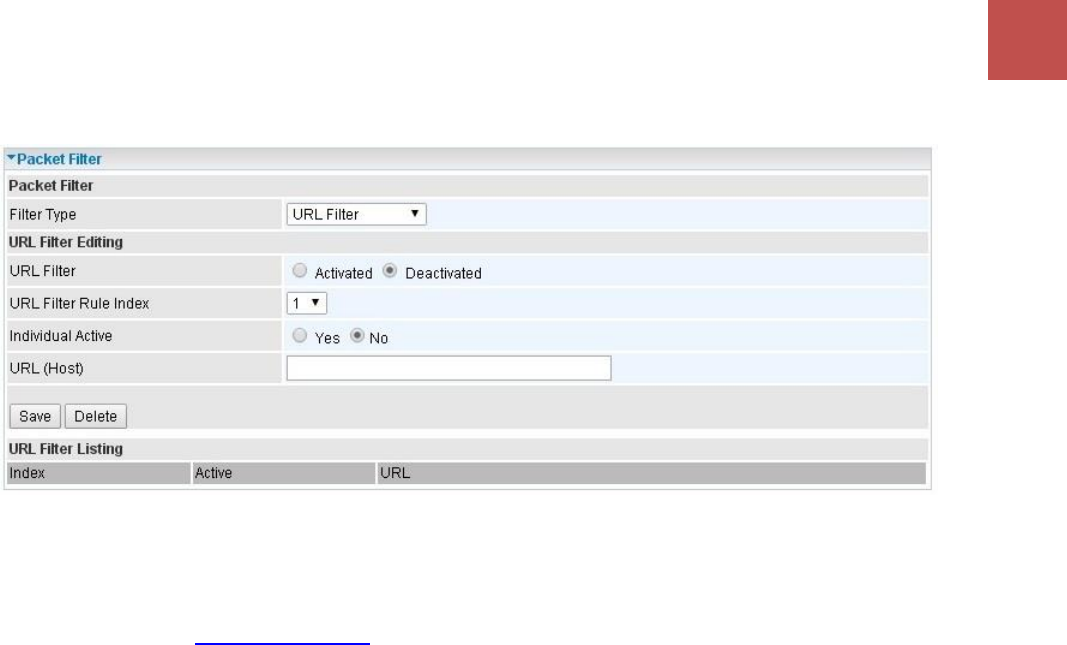
Device Configuration
Access Management – Packet Filter (URL Filter)
108
BEC MX-1200 Series User Manual
❖ Filter Type- URL Filter
URL Filter: Select Activated to enable URL Filter.
URL Filter Rule Index: The numeric rule indicator.
Individual Active: To give control to the specific URL access individually, for example, you want to
prohibit access to www.yahoo.com, please first press Activated in “URL Filter” field, and also Yes in
“Individual Active” field; if some time you want to allow access to this URL, you simply select No in
individual active field. In a word, the command serves as a switch to the access of some specific URL
with the filter on.
URL (Host): Specified URL which is prohibited from accessing.
Click Save to apply settings.
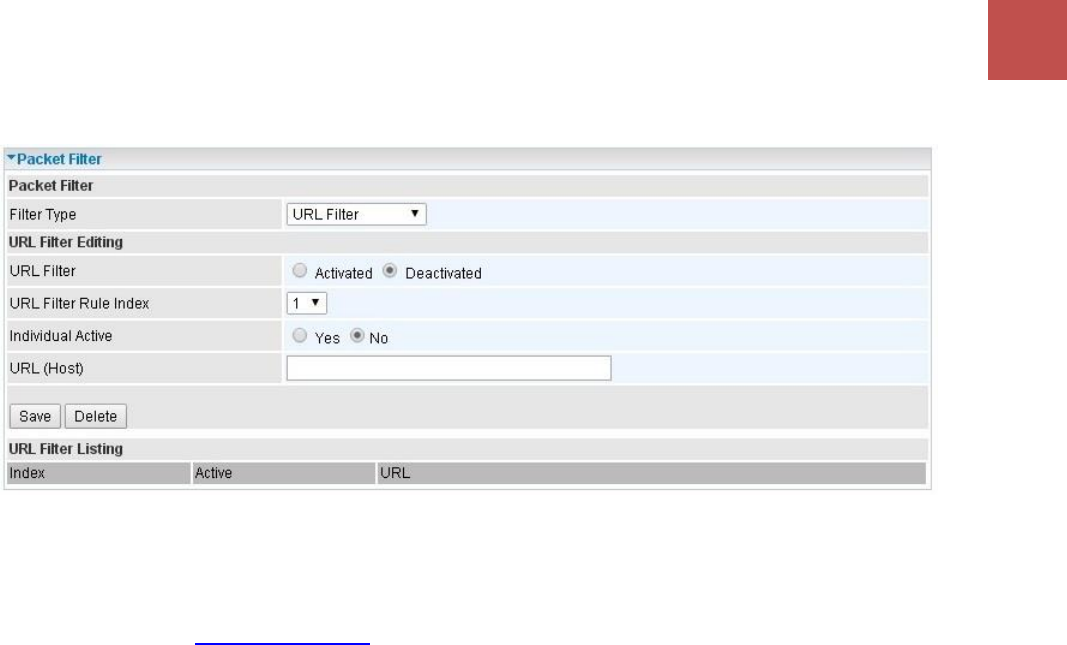
Device Configuration
Access Management – Packet Filter (URL Filter)
109
BEC MX-1200 Series User Manual
❖ Filter Type- URL Filter
URL Filter: Select Activated to enable URL Filter.
URL Filter Rule Index: The numeric rule indicator.
Individual Active: To give control to the specific URL access individually, for example, you want to
prohibit access to www.yahoo.com, please first press Activated in “URL Filter” field, and also Yes in
“Individual Active” field; if some time you want to allow access to this URL, you simply select No in
individual active field. In a word, the command serves as a switch to the access of some specific URL
with the filter on.
URL (Host): Specified URL which is prohibited from accessing.
Click Save to apply the settings.
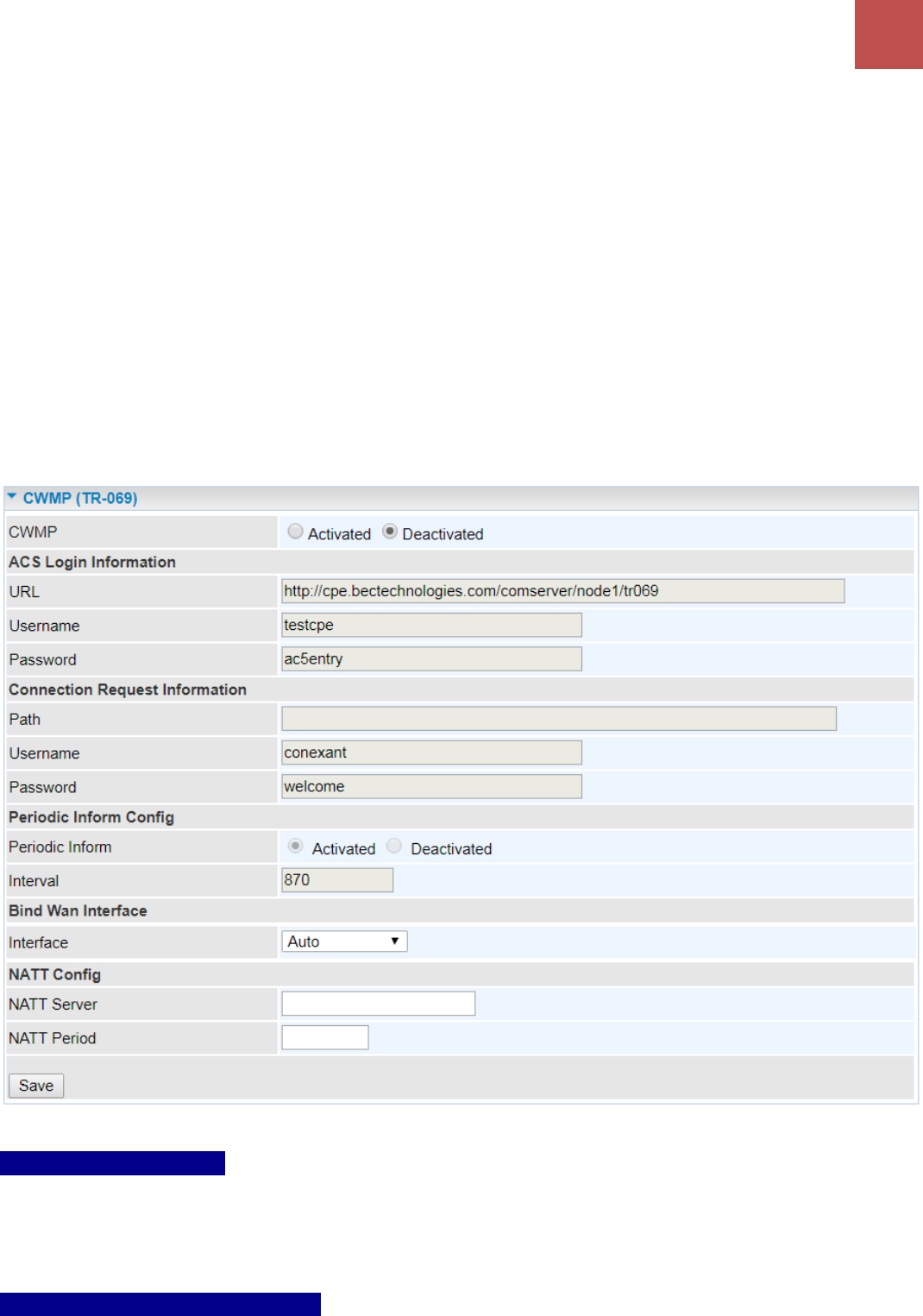
Device Configuration
Access Management – CWMP (TR-069)
110
BEC MX-1200 Series User Manual
CWMP (TR-069)
CWMP, short for CPE WAN Management Protocol, also called TR069 is a Broadband Forum technical
specification entitled CPE WAN Management Protocol (CWMP). It defines an application layer
protocol for remote management of end-user devices. It defines an application layer protocol for
remote management of end-user devices.
As a bidirectional SOAP/HTTP based protocol it can provides the communication between customer
premises equipment (CPE) and Auto Configuration Server (ACS). It includes both a safe configuration
and the control of other CPE management functions within an integrated framework. In the course of
the booming broadband market, the number of different internet access possibilities grew as well (e.g.
modems, routers, gateways, set-top box, VoIP-phones).At the same time the configuration of this
equipment became more complicated –too complicated for end-users. For this reason, TR-069 was
developed. It provides the possibility of auto configuration of the access types. Using TR-069 the
terminals can get in contact with the Auto Configuration Servers (ACS) and establish the configuration
automatically and let ACS configure CPE automatically.
CWMP: Select activated to enable CWMP.
ACS Login Information
URL: Enter the ACS server login URL.
User Name: Specify the ACS User Name for ACS authentication to the connection from CPE.
Password: Enter the ACS server login password.
Connection Request Information
Path: Local path in HTTP URL for an ACS to make a Connection Request notification to the CPE.

Device Configuration
Access Management – CWMP (TR-069)
111
BEC MX-1200 Series User Manual
Username: Username used to authenticate an ACS making a Connection Request to the CPE.
Password: Password used to authenticate an ACS making a Connection Request to the CPE.
Periodic Inform Config
Periodic Inform: Select Activated to authorize the router to send an Inform message to the ACS
automatically.
Interval(s): Specify the inform interval time (sec) which CPE used to periodically send inform message
to automatically connect to ACS. When the inform interval time arrives, the CPE will send inform
message to automatically connect to ACS.
Bind WAN Interface
Interface: Specify any available or a single WAN interface to handle TR-069 requests.
NATT Config - This is a proprietary feature provided by BEC. May leave them in blank, no
configuration is required.
NATT Server: By BEC administrator only.
NATT Period: By BEC administrator only.
Click Save to apply settings.
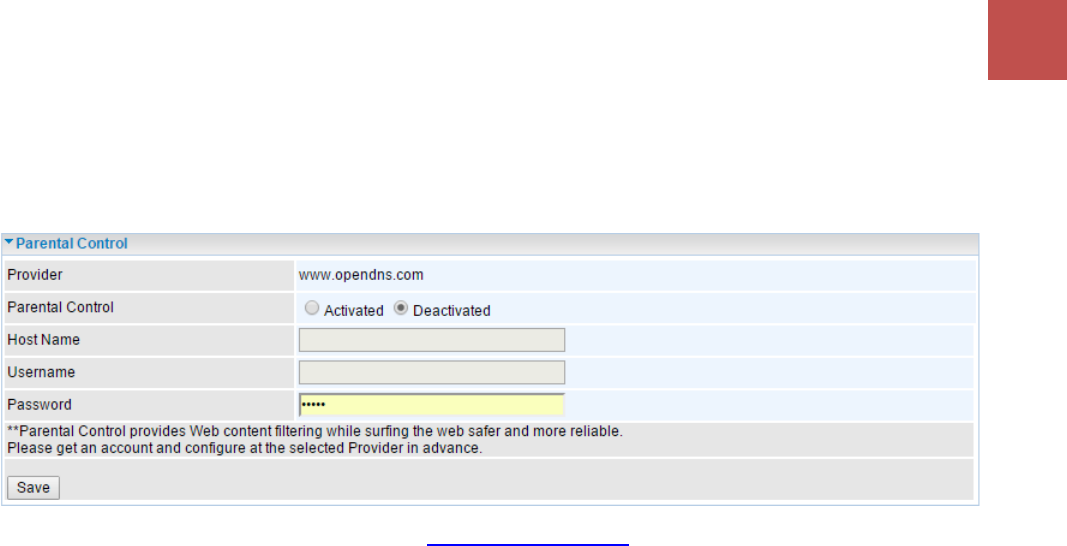
Device Configuration
Access Management – Parental Contorl
112
BEC MX-1200 Series User Manual
Parental Control
This feature provides Web content filtering offering safer and more reliable web surfing for users
especially for parents to protect network security and control the contents for children at home.
To activate this feature, please log on to www.opendns.com to get an OpenDNS account first.
Parent Control Provider: Hosted by www.opendns.com
Parent Control: Enable the feature by clicking the Activated
Host Name: It is the domain name of your OpenDNS. If you don’t have one, please leave it blink.
Username / Password: Put down your OpenDNS account username and password
Click Save to apply the settings.
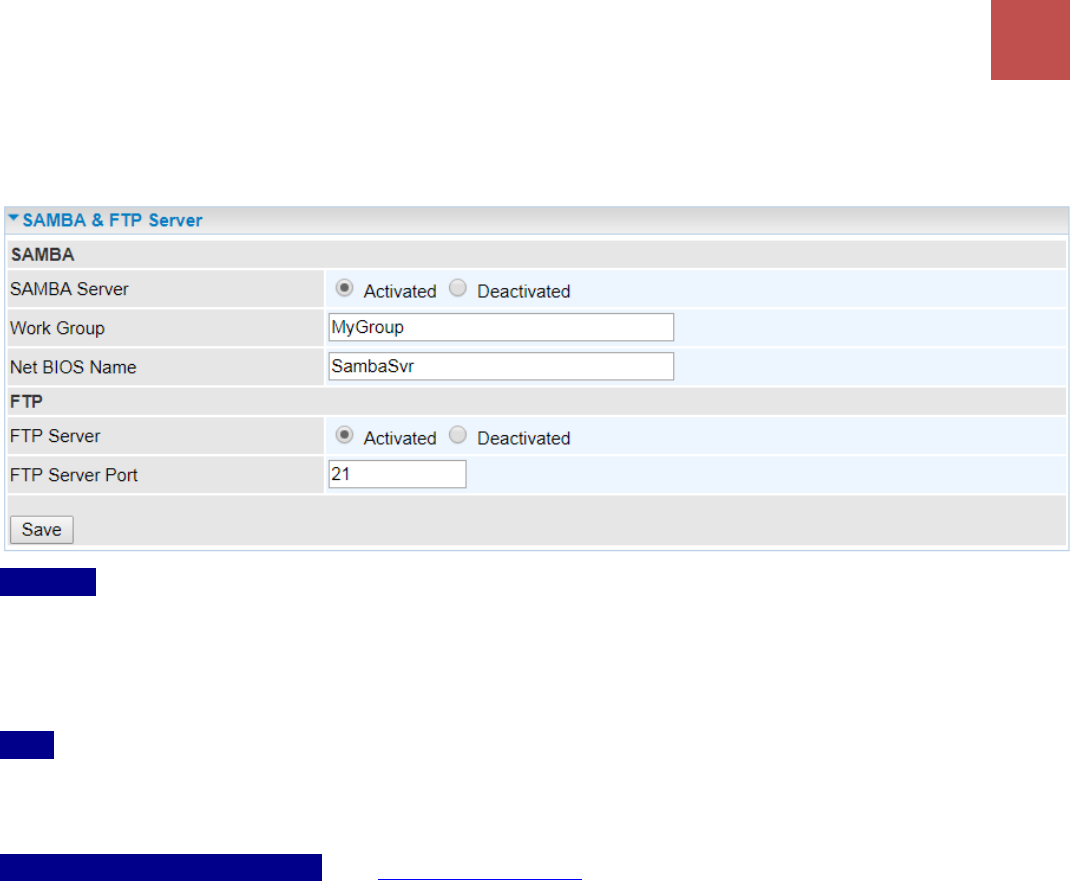
Device Configuration
Access Management – Samba & FTP Server
113
BEC MX-1200 Series User Manual
SAMBA & FTP Server
Samba and FTP are served as network sharing.
SAMBA:
SAMBA Server: Activated to enable SAMBA sharing.
Work Group: The same mechanism like in Microsoft work group, please set the Work Group name.
NetBIOS Name: The sharing NetBIOS name.
FTP:
FTP Server: Activated to enable FTP sharing.
FTP Server Port: Set the working port. Well-known one is 21. User can change it.
SAMBA/FTP Login Account: See User Management for more information.
Default user: admin/admin, it is the administrative user and a super user; it has the full authority
of SAMBA /FTP access and operation permission of objects in SAMBA and FTP server.
New user: users can create new user(s) to grant it (them) access and permission to the SAMBA
& FTP server.
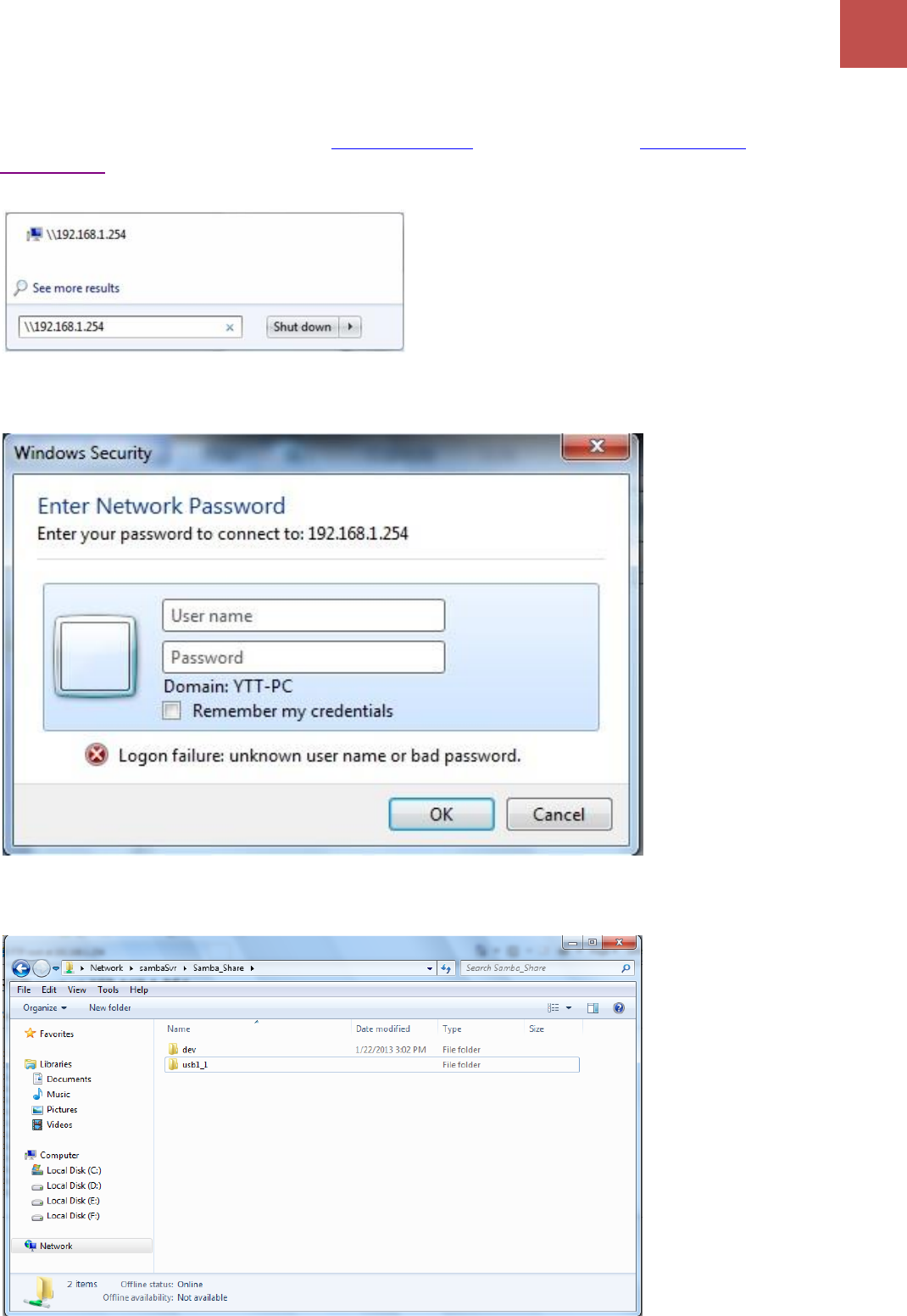
Device Configuration
Access Management – Setup Samba (Example)
114
BEC MX-1200 Series User Manual
Example: How to setup Samba
1. Go directly to Start > Run (enter \\192,168,1,254 (from LAN side), \\SambaSvr , but if you enter
\\SambaSvr, please be sure your working PC is in the same workgroup as set in the samba server set
above.)
2. Enter the Username and password.
3. Users can browse and access USB storage.
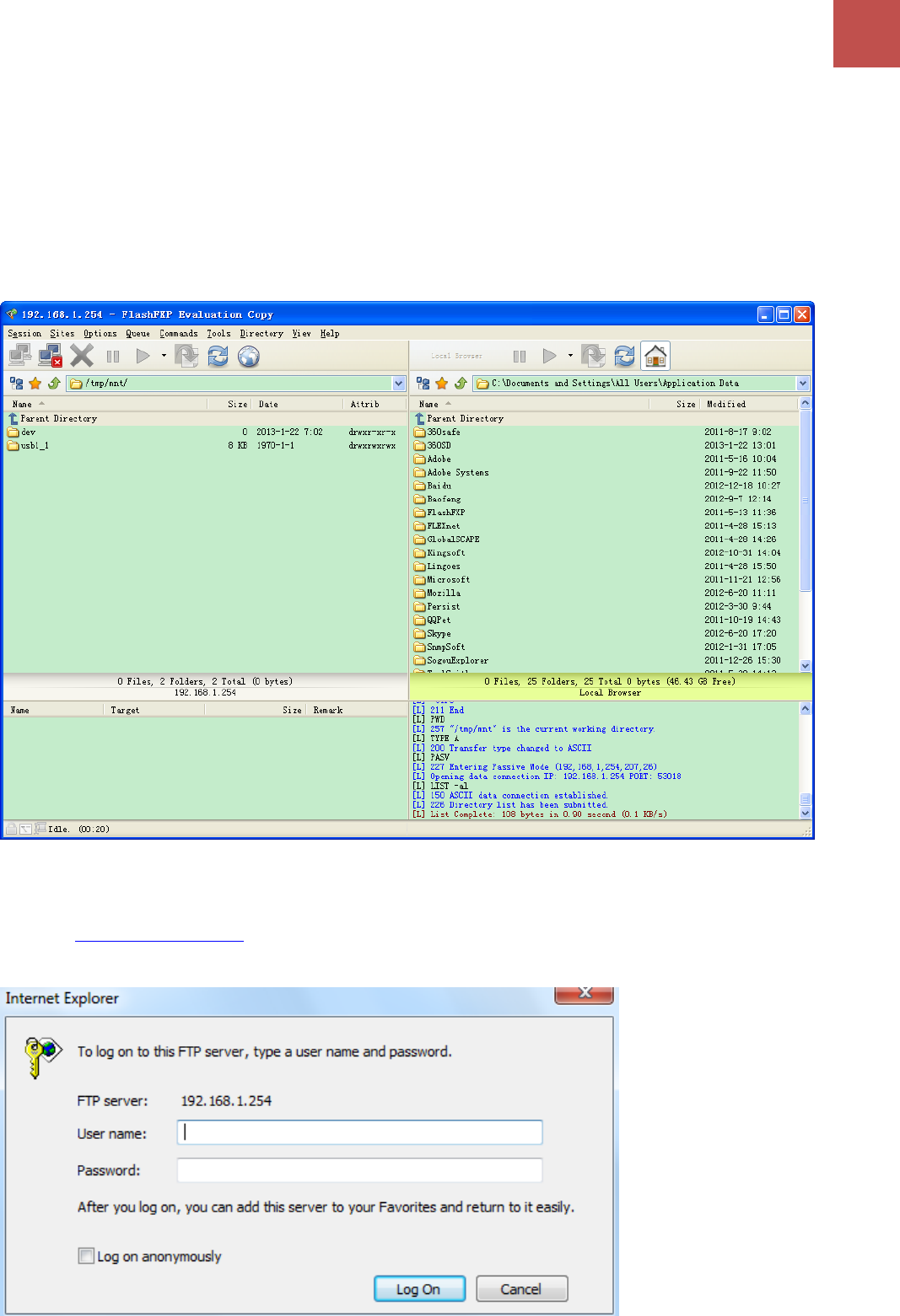
Device Configuration
Access Management – Setup FTP (Example)
115
BEC MX-1200 Series User Manual
Example: How to setup FTP:
1. Access via FTP tools
Take popular FTP tool of FlashFXP for example:
1) Open FlashFXP
2) Create ftp sites (LAN IP / WAN IP, 192.168.1.254, and set the account, port).
3) Connect to the ftp site.
2. Web FTP access
1) Enter ftp://192.168.1.254 at the address bar of the web page.
2) Enter the account's username and password.
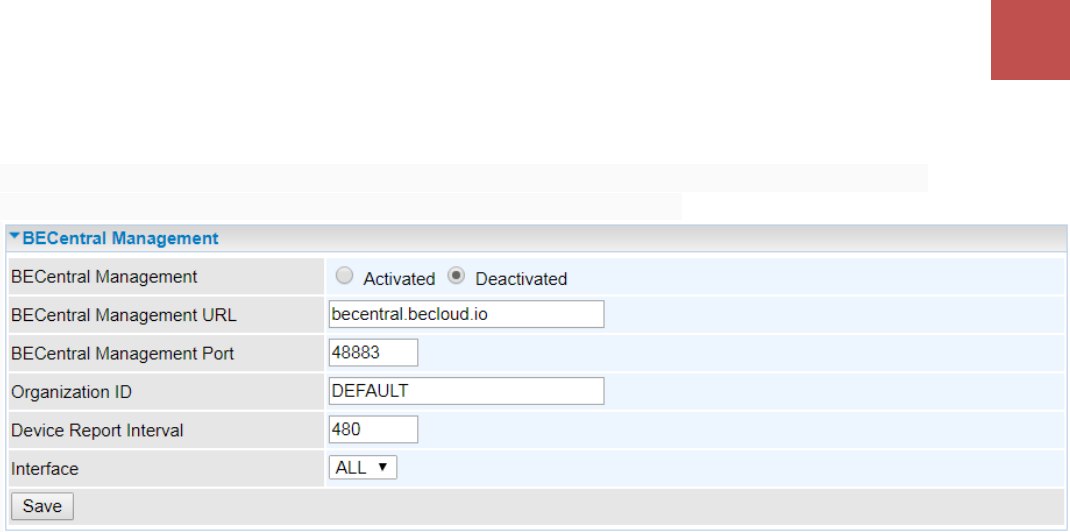
Device Configuration
Access Management – BECentral Management
116
BEC MX-1200 Series User Manual
BECentral Management
BECentral is a cloud based device management platform that provides operators with a
comprehensive suite of services to manage devices in real-time.
BECentral Management: Activate to enable the feature.
BECentral Management URL: Access path to the BECentral.
BECentral Management Port: Port listened by the BECentral.
Organization ID: Customer ID
Device Report Interval: Enter the interval time in seconds to send inform message periodically to the
BECentral.
Interface: Specify any available or a single WAN interface to handle BECentral requests.
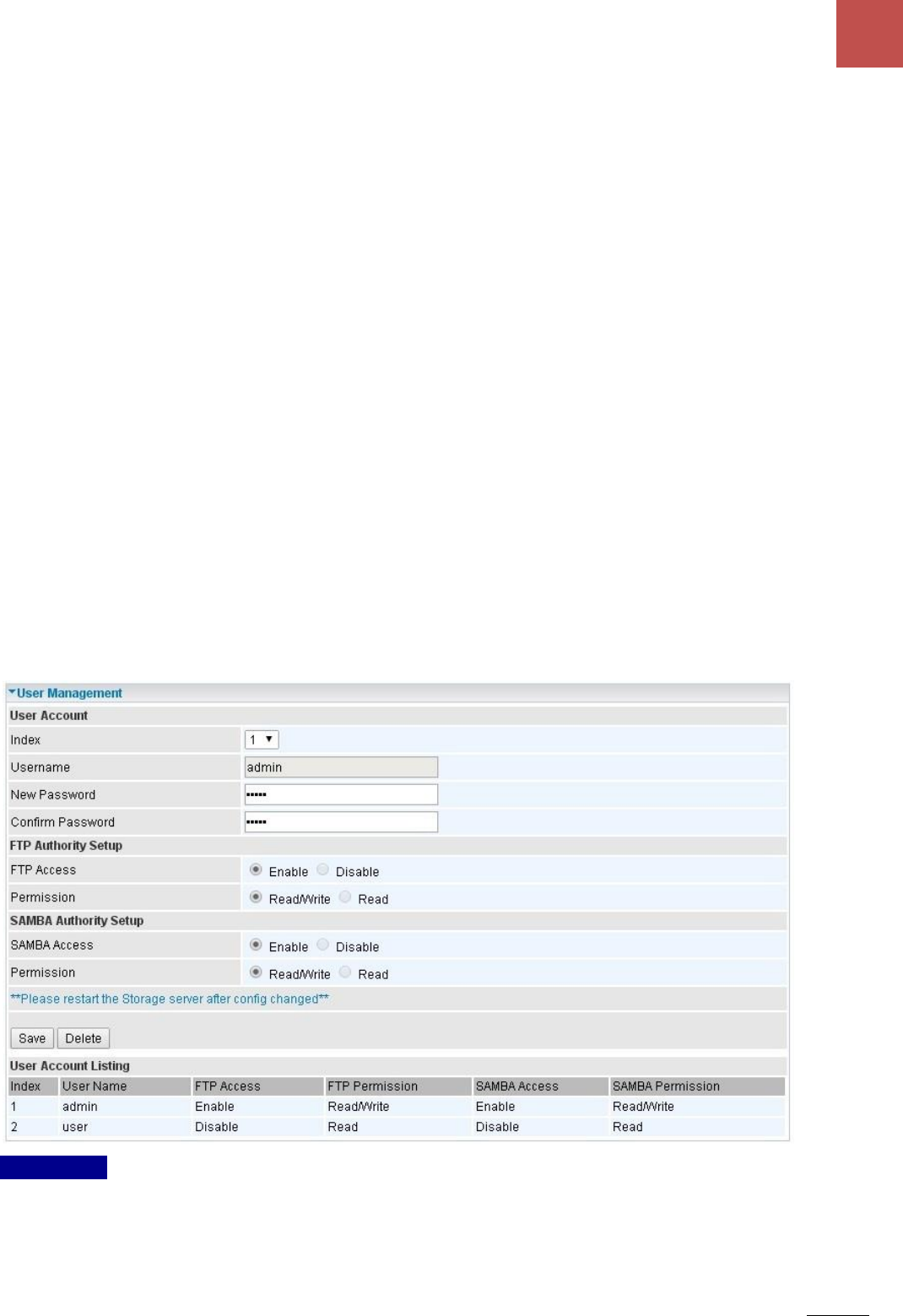
Device Configuration
Maintenance – User Management
117
BEC MX-1200 Series User Manual
Maintenance
Maintenance equipment the users with the ability of maintaining the device as well as examining the
connectivity of the WAN connections, including User Management, Certificate Management, Time
Zone, Firmware & Configuration, System Restart, Auto Reboot, Diagnostic Tool and Ignition
Sensing.
User Management
User Management provides the Administrator with the ability to grant access control and manage GUI
login credentials for each user.
There are two access management levels, Administrator and User.
The default root account, Administrator (admin), has full access to all the features listed and ability to
create other accounts with features to allow other users to access to. The User account is with limited
access (specified by advanced users with admin account) to the GUI.
Total of 8 accounts can be created to grant access to manage the MX-1200 via the web page.
❖ Administrator Account
admin/admin is the root/default account username and password.
NOTE: This username / password may vary by different Internet Service Providers.
User Setup
Index: The numeric account indicator. The maximum entry is up to 8 accounts.
User Name: Create account(s) user name for GUI management.
New Password: Enter a new password for this user account.
Confirmed Password: Re-enter the new password again; you must enter the password exactly the

Device Configuration
Maintenance – User Management
118
BEC MX-1200 Series User Manual
same as in the previous field
FTP Authority Setup
FTP Access: Enable to grant the user access to the FTP server.
Permission: Set the operation permission for the user, Read/Write or Read.
SAMBA Authority
SAMBA Access: Enable to grant the user access to the SAMBA server.
Permission: Set the operation permission for the user, Read/Write or Read.
Web GUI Permission
Login using the Administrator account, you will have the full accessibility to manage & control your
gateway device and can also create user accounts for others to control some of the open configuration
settings.
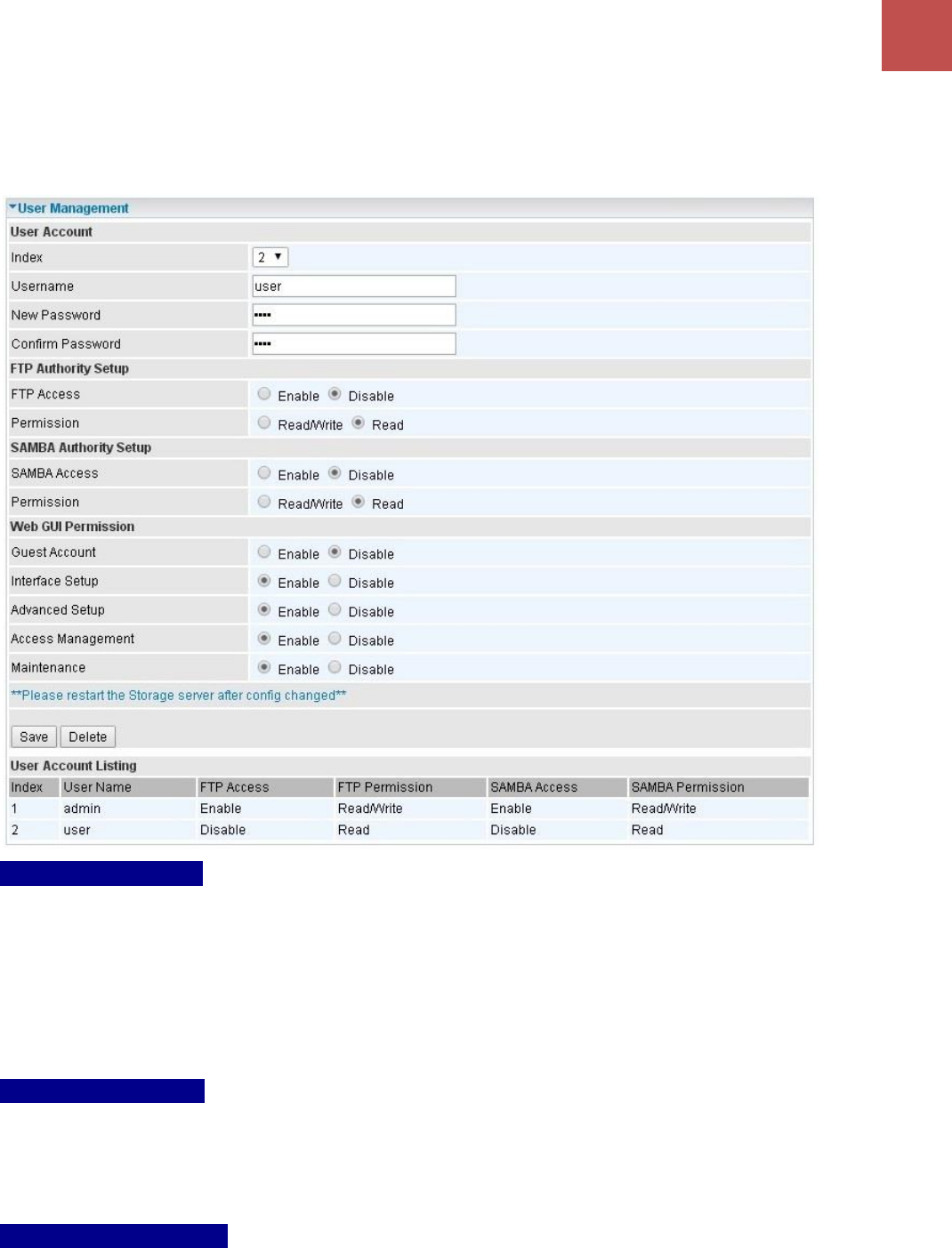
Device Configuration
Maintenance – User Management (User Account)
119
BEC MX-1200 Series User Manual
❖ User Account
user/user is the default user account username and password
NOTE: This username / password may vary by different Internet Service Providers.
User Account Setup
Index #: The numeric account indicator. The maximum entry is up to 8.
User Name: Users can create account(s) to give it (them) access to SAMBA and FTP.
New Password: Password for the user account.
Confirm Password: Re-enter the password.
FTP Authority Setup
FTP Access: Enable to grant the user access to the FTP server.
Permission: Set the operation permission for the user, Read/Write or Read.
SAMA Authority Setup
SAMBA Access: Enable to grant the user access to the SAMBA server.
Permission: Set the operation permission for the user, Read/Write or Read.

Device Configuration
Maintenance – User Management (User Account)
120
BEC MX-1200 Series User Manual
Web GUI Permission
Guest Account: Enable to create this new guest account.
Interface Setup / Advanced Setup / Access Management Setup / Maintenances: Enable to grant
this user access to these features.
When someone accesses to the MX-1200 using this “user” account, he/she can only manage and
configure the features that is pre-selected in Web GUI Permission for this account.
Click Save to apply the settings.
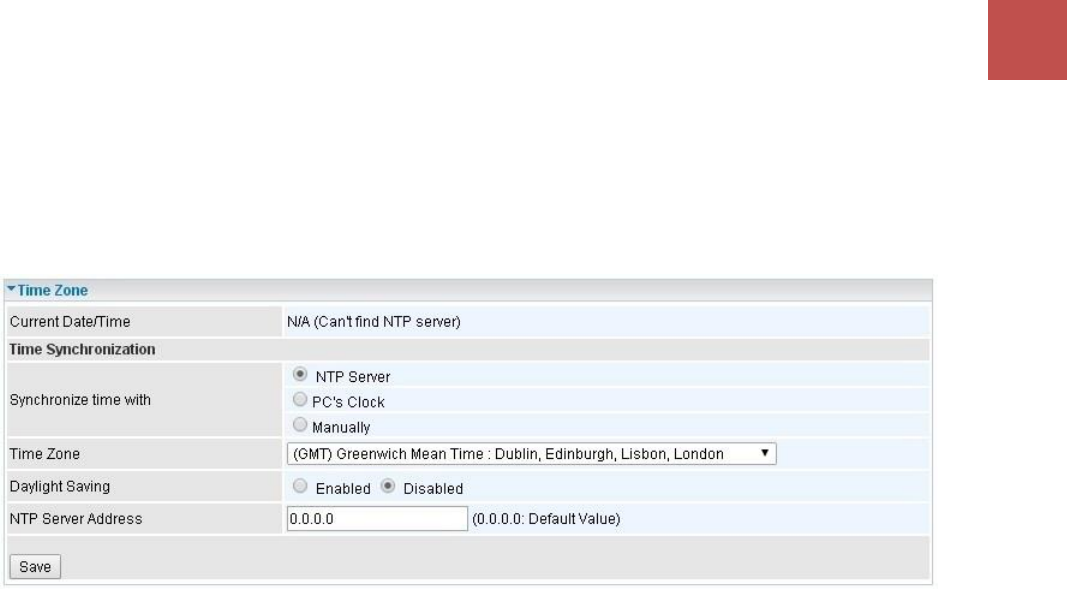
Device Configuration
Maintenance – Time Zone
121
BEC MX-1200 Series User Manual
Time Zone
With default, MX-1200 does not contain the correct local time and date.
There are several options to setup, maintain, and configure current local time/date on the MX-1200.
If you plan to use Time Schedule feature, it is extremely important you set up the Time Zone correctly.
Synchronize time with: Select the methods to synchronize the time.
NTP Server automatically: To synchronize time with the SNTP servers to get the current time
from an SNTP server outside your network then choose your local time zone. After a successful
connection to the Internet, MX-1200 will retrieve the correct local time from the SNTP server
this is specified.
PC’s Clock: To synchronize time with the PC’s clock.
Manually: Enter the Date and Time manually.
Date: Month / Date / Year. Month – 1 ~ 12 (January ~ December).
Time: Hour: Minute: Second
Time Zone: Choose the time zone of your location. This will set the time difference between your time
zone and Greenwich Mean Time (GMT).
Daylight Saving: Select this option if you use daylight savings time.
NTP Server Address: Enter the IP address of your time server. Check with your ISP/network
administrator if you are unsure of this information.
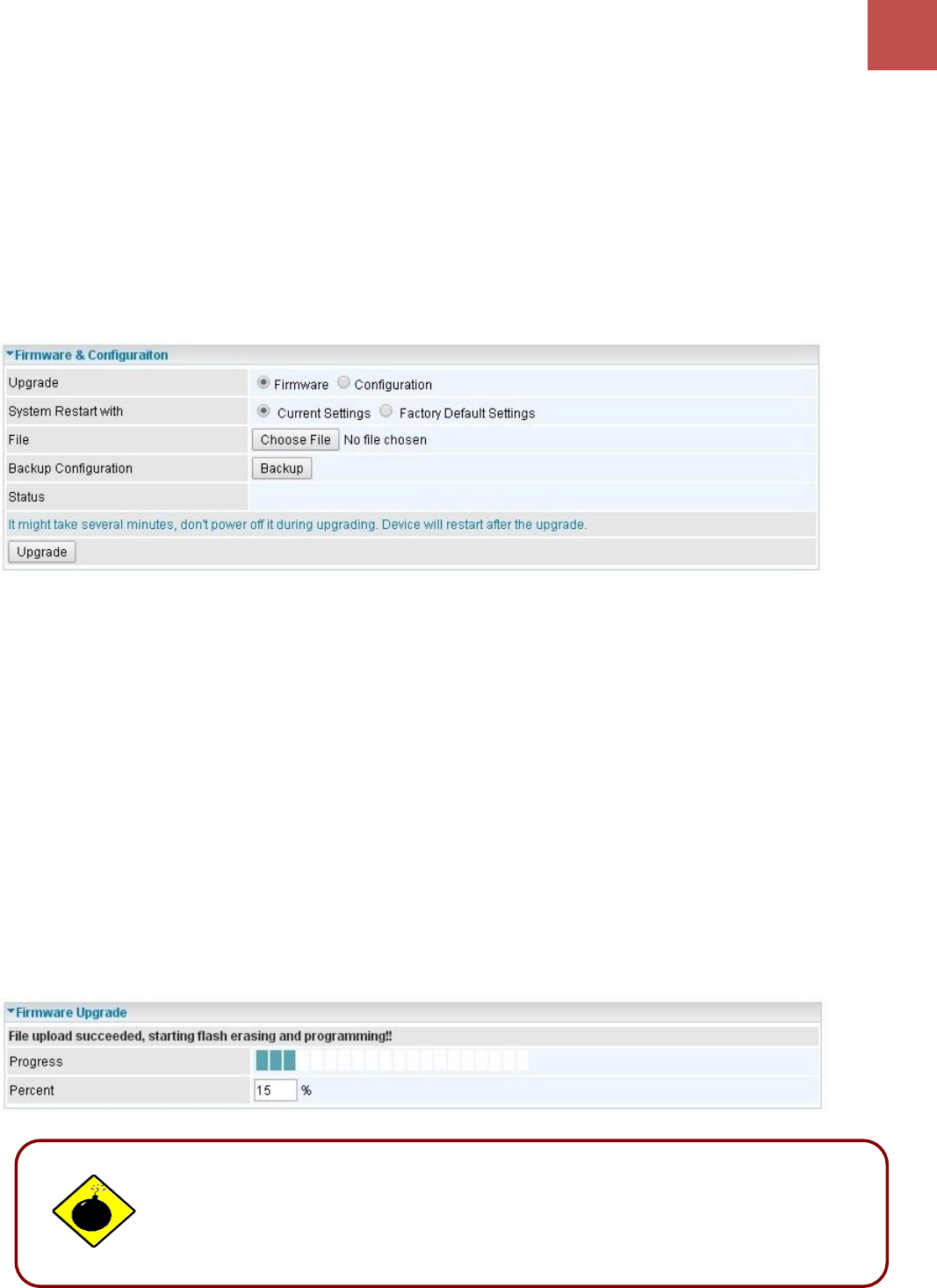
Device Configuration
Maintenance – Firmware & Configuration
122
BEC MX-1200 Series User Manual
Firmware & Configuration
Firmware is the software that controls the hardware and provides all functionalities which are available
in the GUI. This software may be improved and/or modified; your MX-1200 provides an easy way to
update the code to take advantage of the changes.
To upgrade the firmware of the MX-1200, you should download or copy the firmware to your local
environment first. Click “Choose File” to specify the path of the firmware file. Then, click “Upgrade”
to start upgrading process. After completing the firmware upgrade, the MX-1200 will automatically
restart and run the new firmware.
Upgrade: Choose Firmware or Configuration you want to update.
System Restart with:
Current Settings: Restart the device with the current settings automatically when finishing
upgrading.
Factory Default Settings: Restart the device with factory default settings automatically when
finishing upgrading.
File: Type in the location of the file you want to upload in this field or click Browse to find it.
Choose File: Click “Choose File” to find the configuration file or firmware file you want to upload.
Remember that you must extract / decompress / unzip the .zip files before you can upload them.
Backup Configuration: Click Backup button to back up the current running configuration file and
save it to your computer in the event that you need this configuration file to be restored back to your
MX-1200 device when making false configurations and want to restore to the original settings.
Upgrade: Click “Upgrade” to begin the upload process. This process may take up to two minutes.
DO NOT turn off or power cycle the device while firmware upgrading is still
in process.
Improper operation could damage your MX-1200.

Device Configuration
Maintenance – System Restart
123
BEC MX-1200 Series User Manual
System Restart
Click System Restart with option Current Settings to reboot your router.
If you wish to restart the router using the factory default settings (for example, after a firmware upgrade
or if you have saved an incorrect configuration), select Factory Default Settings to restore to factory
default settings.
You may also restore your router to factory settings by holding the small Reset pinhole button on the
back of your router in about more than 6s seconds whilst the router is turned on.
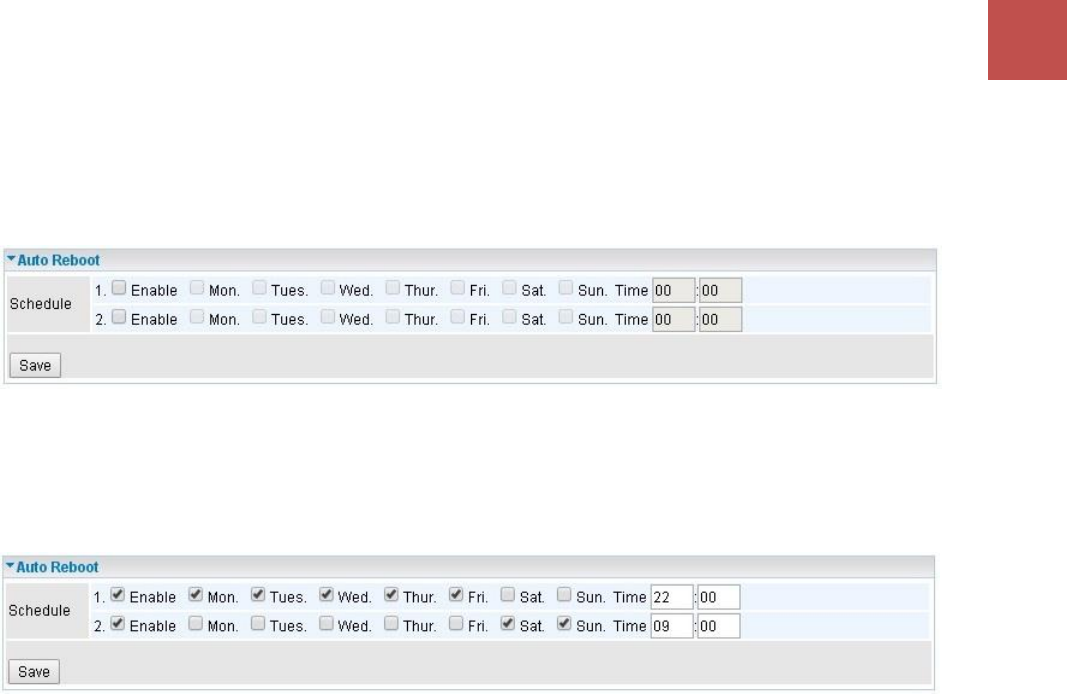
Device Configuration
Maintenance – Auto Reboo
t
124
BEC MX-1200 Series User Manual
Auto Reboot
Schedule an automatic reboot for your MX-1200 to ensure proper operation and best performance.
This reboot will only reboot with current configuration settings and not overwrite any existing settings.
Click Save to apply the settings
Example: Schedule MX-1200 to reboot at 10:00pm (22:00) every weekday (Monday thru Friday)
and reboot at 9:00am on Saturday and Sunday.
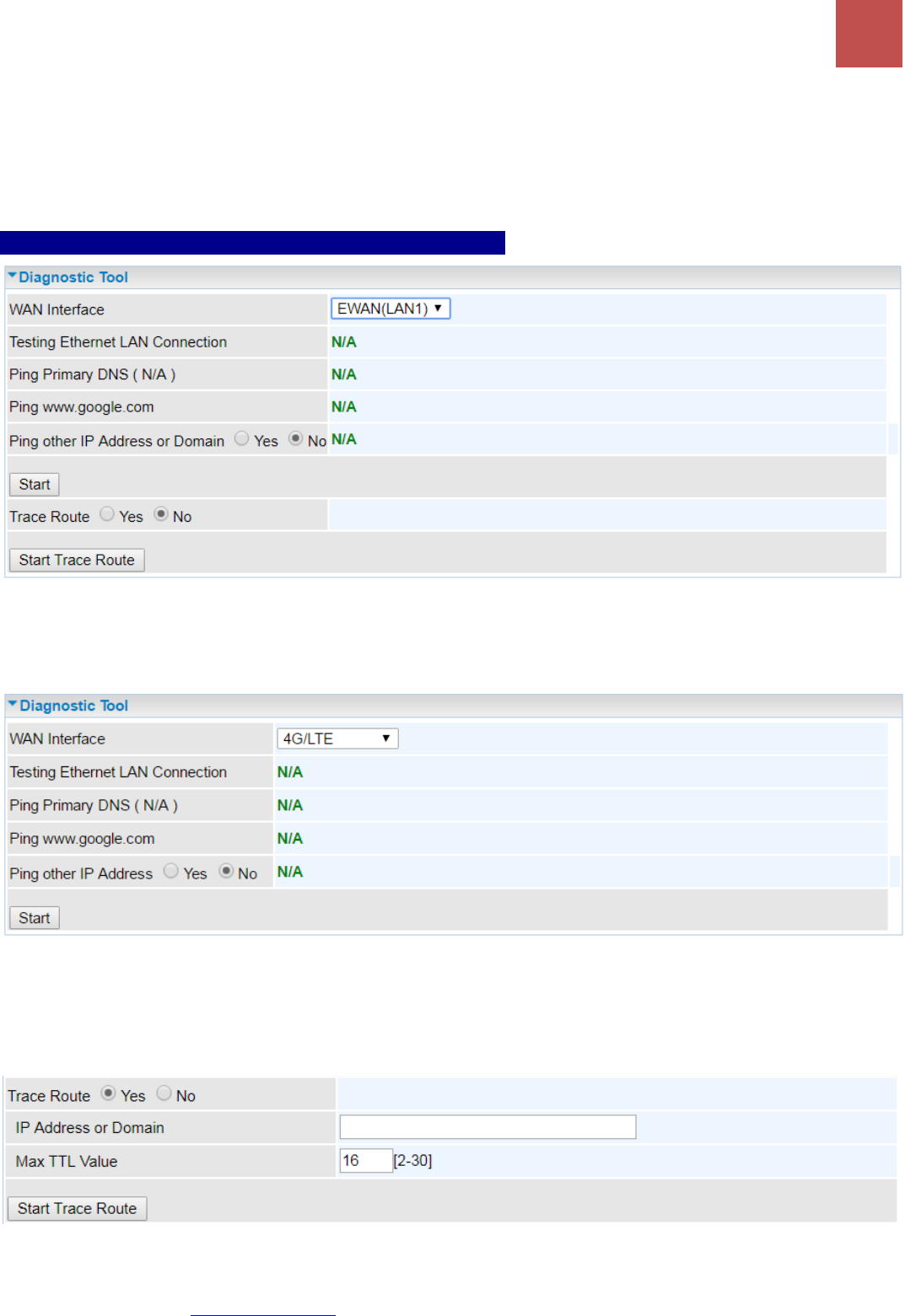
Device Configuration
Maintenance – Diagnostic Tool
125
BEC MX-1200 Series User Manual
Diagnostics Tool
The Diagnostic Test page shows the test results for the connectivity of the physical layer and protocol
layer for both LAN and WAN sides.
3G/4G-LTE / 3G/4G-LTE USB / EWAN / WirelessClient
Ping other IP Address: Click Yes if you wish to ping other IP address rather than google.com
Click START to begin to diagnose the connection.
Trace Route is to display how many hops (also view the exact hops) the packet of data has to take to
get to the destination.
Click Yes, enter the IP address or domain then Start Trace Route.
IP Address or Domain: Set the destination host (IP, domain name) to be traced.
Max TTL value: Set the max Time to live (TTL) value.
Shown as we “trace” www.billion.com below.
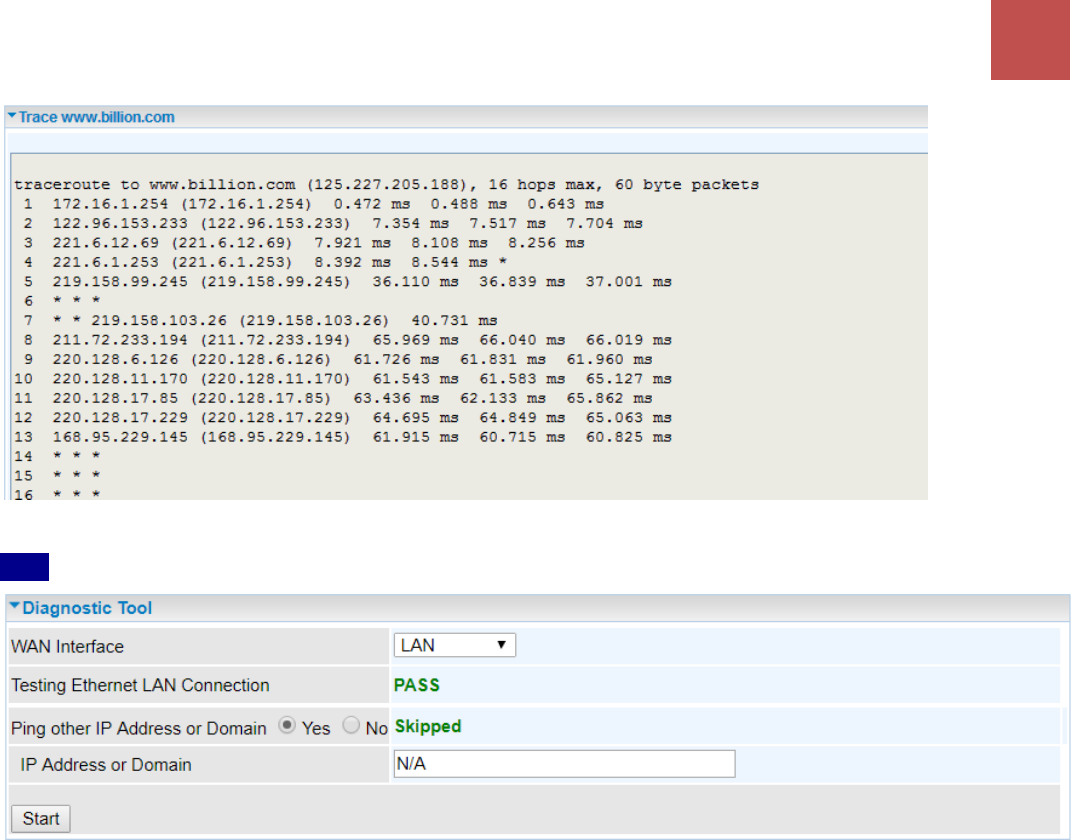
Device Configuration
Maintenance – Diagnostic Tool
126
BEC MX-1200 Series User Manual
LAN
Ping other IP Address: Click Yes to ping any desired IP address or a domain.
Click START to begin to diagnose the connection.
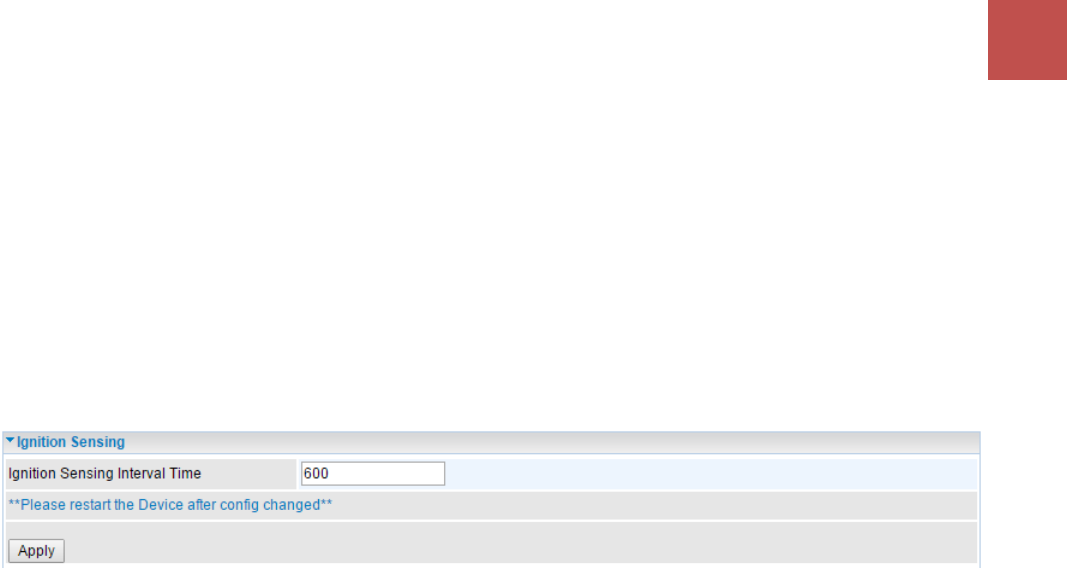
Device Configuration
Maintenance – Ignition Sensing
127
BEC MX-1200 Series User Manual
Ignition Sensing
With On/Off delay timer (ignition sensing interval time) enables the MX-1200 to get powered on with
ignition key turns to ACC/ON automatically and powered off after ignition key to VCC/OFF for a specific
time delay.
A good example of using the ignition sensing is after delivery truck or school bus drivers arrive at the
destination, they can turn off the vehicles and still be able to access to the Internet over 4G/LTE and
don’t have to worry about losing the GPS data. The MX-1200 remains on until the delay timer is up
and automatically powers off so it doesn't drain the vehicle battery.
NOTE: Restart the router is required.
Ignition Sensing Interval Time (seconds): It is the off delay timer. Default value is in 10 minutes
(600 seconds). MX-1200 will get power off in 10 minutes after the vehicle engine is turned off.
Click Apply to change the setting.

Troubleshooting
128
BEC MX-1200 Series User Manual
Chapter 5: Troubleshooting
If your MX-1200 is not functioning properly, you can refer to this chapter for simple troubleshooting
before contacting your service provider support. This can save you time and effort but if symptoms
persist, consult your service provider.
Problems with the Router
Problem
Suggested Action
None of the LEDs is on when you
turn on the router
Check the connection between the router and the
adapter. If the problem persists, most likely it is due
to the malfunction of your hardware. Please contact
your service provider or BEC for technical support.
You have forgotten your login
username or password
Try the default username "admin" and password
"admin". If this fails, you can restore your router to
its factory settings by pressing the reset button on
the device rear side.
Problem with LAN Interface
Problem
Suggested Action
Cannot PING any PC on LAN
Check the Ethernet LEDs on the front panel.
The LED should be on for the port that has a PC
connected. If it does not lit, check to see if the cable
between your router and the PC is properly
connected. Make sure you have first uninstalled your
firewall program before troubleshooting.
Verify that the IP address and the subnet mask are
consistent for both the router and the workstations.

Troubleshooting
129
BEC MX-1200 Series User Manual
Recovery Procedures
Problem
Suggested Action
- The front LEDs display incorrectly
- Still cannot access to the router
management interface after pressing the
RESET button.
- Software / Firmware upgrade failure
Before starting recovery process, please configure
the IP address of the PC as 192.168.1.100 and
proceed with the following step-by-step guide.
1. Power the router off.
2. Press reset button and power on the router, once
the Power lights Red, keeping press reset button
over 6 seconds.
3. Internet LED flashes Green, router entering
recovery procedure and router's IP will reset to
Emergency IP address (Say 192.168.1.1).
4. Open browser and access http://192.168.1.1 to
upload the firmware.
5. Internet LED lit Red, and router starts to write
firmware into flash. Please DO NOT power off the
router at this step.
6. Internet LED lit Green when successfully upgrade
firmware.
7. Power cycle off/on the MX-1200

Appendix
130
BEC MX-1200 Series User Manual
APPENDIX: PRODUCT SUPPORT & CONTACT
If you come across any problems please contact the dealer from where you have purchased the
product.
Contact BEC @ http://www.bectechnologies.net
MAC OS is a registered Trademark of Apple Computer, Inc. Windows 10/8/7, Windows XP, and Windows Vista
are registered Trademarks of Microsoft Corporation.

Appendix
131
BEC MX-1200 Series User Manual
This page is intentionally left blank
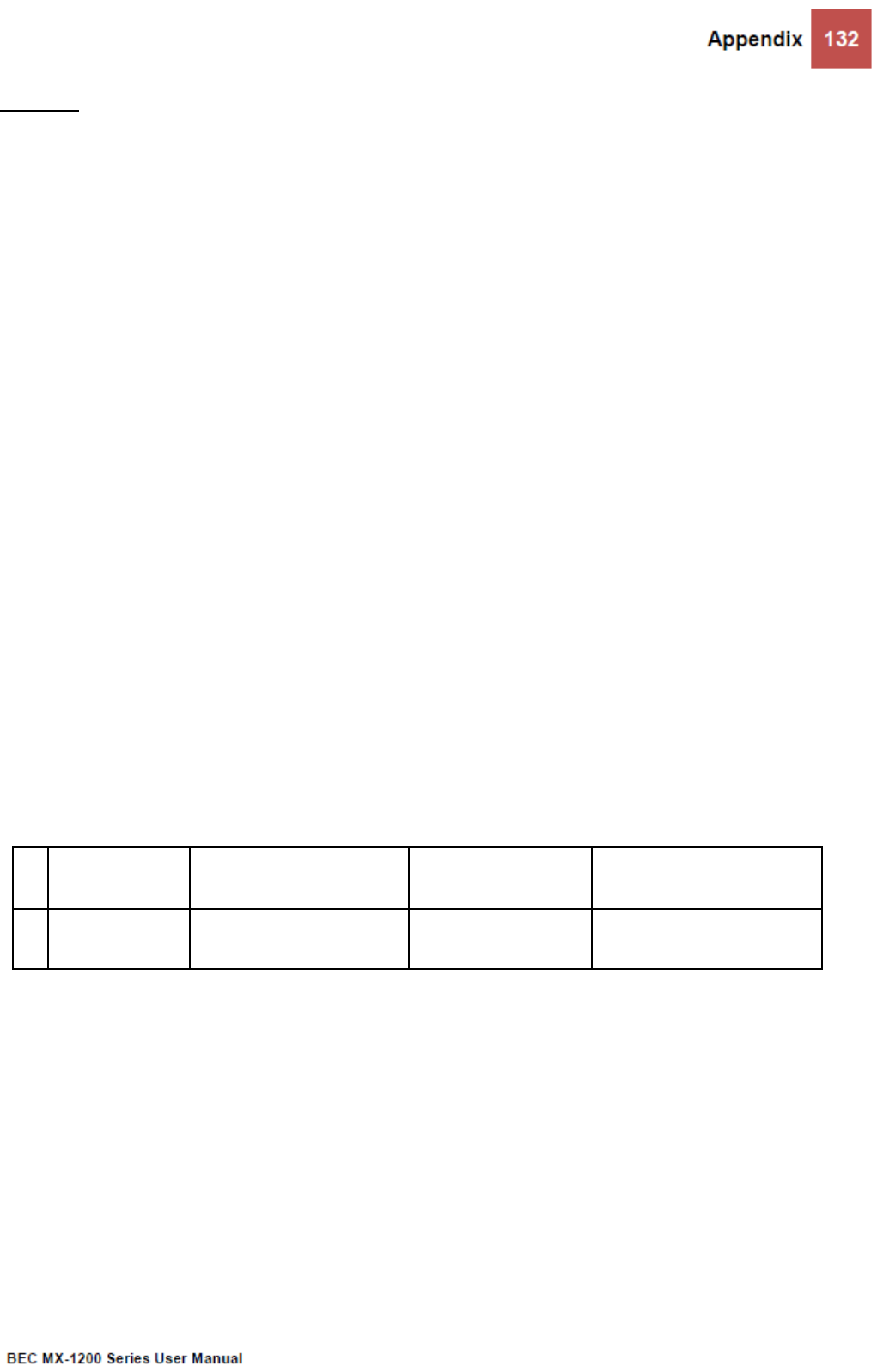
Class B:
(Section 15.105)
FEDERAL COMMUNICATIONS COMMISSION INTERFERENCE STATEMENT
This equipment has been tested and found to comply with the limits for a Class B digital device, pursuant to part
15 of the FCC Rules. These limits are designed to provide reasonable protection against harmful interference in a
residential installation. This equipment generates, uses and can radiate radio frequency energy and, if not
installed and used in accordance with the instructions, may cause harmful interference to radio communications.
However, there is no guarantee that interference will not occur in a particular installation. If this equipment does
cause harmful interference to radio or television reception, which can be determined by turning the equipment
off and on, the user is encouraged to try to correct the interference by one or more of the following measures:
-Reorient or relocate the receiving antenna.
-Increase the separation between the equipment and receiver.
-Connect the equipment into an outlet on a circuit different from that to which the receiver is connected.
-Consult the dealer or an experienced radio/ TV technician for help.
(Section 15.21)
CAUTION:
Any changes or modifications not expressly approved by the grantee of this device could void the user's authority
to operate the equipment.
RF exposure warning
This equipment must be installed and operated in accordance with provided instructions and the antenna(s) used
for this transmitter must be installed to provide a separation distance of at least 20 cm from all persons and must
not be co-located or operating in conjunction with any other antenna or transmitter. End-users and installers
must be provide with antenna installation instructions and transmitter operating conditions for satisfying RF
exposure compliance.
This radio transmitter FCCID: QI3BIL-MX1200 has been approved by FCC to operate with the antenna
types listed below with the maximum permissible gain and required antenna impedance for each
antenna type indicated. Antenna types not included in this list, having a gain greater than the maximum
gain indicated for that type, are strictly prohibited for use with this device.
Antenna List
No.
Manufacturer
Part No. Antenna Type Peak Gain
1
BILLION AAZAND2S2942510000 Dipole Antenna 1.8dBi for 2.4GHz
2
BILLION AAZAND5S5510090A00 Dipole Antenna 5dBi For 5.15~5.25GHz
5dBi For 5.725~5.825GHz
Note: 1. The antenna connector is Reverse SMA type.
2. When using IEEE 802.11a wireless LAN, this product is restricted to indoor use due to its
operation in the 5.15- to 5.25 GHz frequency range.